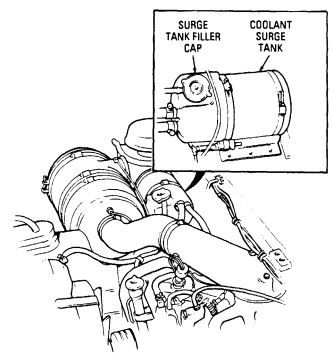hmmwv-manuals
Chapter 2 Service And Troubleshooting Instructions
| Task | Description |
|---|---|
| 2-1 | Common Tools And Equipment |
| 2-2 | SPECIAL TOOLS, TMDE, AND SUPPORT EQUIPMENT |
| 2-3 | REPAIR PARTS |
| 2-4 | General |
| 2-5 | General Inspection And Servicing Instructions |
| 2-6 | Specific Inspection And Servicing Instructions |
| 2-7 | G E N E R A L |
| 2-8 | I N T E Rva L S |
| 2-9 | R E P O Rting Repa I R S |
| 2-10 | . General Service And Inspection Procedures |
| 2-11 | Specific Pmcs Procedures |
| 2-12 | General |
| 2-13 | . Electrical/Mechanical Systems Troubleshooting Electrical/Mechanical Troubleshooting |
| 2-14 | How To Use This Troubleshooting Guide |
| 2-15 | Glossary Of Abbreviations And Commonly Used Terms |
| 2-16 | Electric Circuit Description |
| 2-17 | Startability Tests |
| 2-18 | Engine Running Tests |
| 2-19 | Cooling System Tests |
| 2-20 | Lubrication System Tests |
| 2-21 | Electrical Tests |
| 2-22 | Fuel System Tests |
| 2-23 | Air Intake/Exhaust Tests |
| 2-24 | Compression/Mechanical Tests |
| 2-25 | Engine Cooling Tests |
| 2-26 | Engine Lubrication Tests I |
| 2-27 | Alternator Tests |
| 2-28 | Protective Control Box/Distribution Box Tests |
| 2-29 | Battery Circuit Test 1 |
| 2-30 | Starter Circuit Tests |
| 2-31 | Glowplugs Circuit Tests (Protective Control Box) |
| 2-31 | 1. Glowplugs Circuit Tests (Distribution Box) |
| 2-32 | Instrument Tests |
| 2-33 | Light Tests |
| 2-34 | Transmission System Tests (3L80) |
| 2-35 | Transmission System Tests (4L80-E) |
| 2-36 | Brake System Tests |
| 2-37 | Steering System Tests |
| 2-38 | Drivetrain Tests |
| 2-39 | Ambulance Electrical System Tests |
| 2-40 | Ambulance Mechanical System Tests |
| 2-41 | Winch System Tests |
| 2-42 | Dca Troubleshooting |
| 2-43 | Ste/Ice-R Test Procedures |
| 2-44 | Vehicle Testing |
Section I. REPAIR PARTS, SPECIAL TOOLS, TEST, MEASUREMENT
DIAGNOSTIC EQUIPMENT (TMDE), AND SUPPORT EQUIPMENT
2-1. Common Tools And Equipment
For authorized common tools and equipment, refer to the Modified Table of Organization and Equipment (MTOE) applicable to your unit.
2-2. SPECIAL TOOLS, TMDE, AND SUPPORT EQUIPMENT
Special Tools, Test, Measurement, Diagnostic Equipment (TMDE), and Support Equipment used to maintain the vehicles covered in this manual can be found in TM 9-2320-280-24P.
2-3. REPAIR PARTS
Repair parts are listed and illustrated in TM 9-2320-280-24P.
Section II. Service Upon Receipt
2-4. General
a. Upon receipt of a new, used, or reconditioned vehicle, you must determine if the vehicle has been properly prepared for service. The following steps should be followed: 1. Inspect all assemblies, subassemblies, and accessories to be sure they are in proper working order. 2. Secure, clean, lubricate, or adjust as needed. 3. Check all Basic Issue Items (TM 9-2320-280-10) to be sure every item is present, in good condition, and properly mounted, or stowed. 4. Follow general procedures for all services and inspections given in TM 9-2320-280-10. b. The operator will assist when performing service upon receipt inspections. c. See TM 9-2320-280-10 when checking equipment for proper operation. d. Refer to TM 9-2320-280-10 for information concerning brake-in procedures.
2-5. General Inspection And Servicing Instructions
The following steps should be taken while performing general inspection and services: NOTE Cooler fin and engine protective covers can be used to prevent damage to the vehicle components during maintenance. Refer to Appendix D for fabrication instructions.
(1) Use TM 9-2320-280-10 as well as other sections of this manual, when servicing and inspecting equipment.
Warning
Drycleaning solvent is flammable and will not be used near an open flame. A fire extinguisher will be kept nearby when the solvent is used. Use only in well-ventilated places. Failure to do this may result in injury to personnel and/or damage to equipment.
(2) Clean all exterior surfaces coated with rust-preventive compounds. Use drycleaning solvent (Appendix C, Item 18).
(3) Clean fittings before lubrication. Clean parts with drycleaning solvent (SD), type II, or equivalent.
Dry before lubricating. Relubricate all items found contaminated after fording.
.Warning.
Compressed air used for cleaning purposes will not exceed 30 psi (207 kPa). Use only with effective chip guarding and personal protective equipment such as goggles or shield, gloves, etc.
Note
Use compressed air to dry electrical components. Use sealing compound (Appendix C, Item 40) before reconnecting plugs.
(4) Inspect electrical connectors for corrosion and/or damage (i.e., bent pins). Clean and repair damage. Clean electrical components with clean cloth dampened with drycleaning solvent. Care must be taken not to damage protective insulation.
(5) Read "Processing and Deprocessing Record of Shipping, Storage, and Issue of Vehicles and Spare Engines," tag (DD Form 1397) and follow all precautions listed. This tag should be attached to steering wheel, steering column, or rotary switch.
2-6. Specific Inspection And Servicing Instructions
The following steps should be taken while performing specific inspections and services: (1) Do the Semiannual (S) preventive maintenance checks and services listed in Section III in this chapter.
(2) Lubricate the vehicle. Do not lubricate gear cases and engine unless processing tag states that the oil is unsuitable for 500 mi (805 km) operation. If oil is suitable, just check level.
(3) Schedule semiannual service on DD Form 314 (Preventive Maintenance Schedule and Record Card). (4) If vehicle is delivered with a dry charged battery, activate it according to TM 9-6140-200-14. (5) Check vehicle coolant level and determine if solution is proper for climate (refer to TB 750-651 for preparation of antifreeze solutions).
(6) Remove towing brackets from their stowed position behind the bumper and install them in their proper location (para. 9-2, 9-3, or 9-4).
(7) Remove front lifting shackles from stowed position under passenger seat and install on towing brackets (para. 9-13).
Section Iii. Preventive Maintenance Checks And Serv I C E S
2-7 . G E N E R A L
The best way to maintain vehicles covered by this manual is to inspect them on a regular basis so minor faults can be discovered and corrected before they result in serious damage, failure, or injury. All intervals are based on normal operation. Hard time intervals may be shortened if your lubricants are contaminated or if you are operating the equipment under adverse conditions, including longer-than-usual operating hours. Hard time intervals may be extended during periods of low activity, though adequate preservation precautions must be taken. This section contains systematic instructions of inspection, adjustment, lubrication, and correction of vehicle components to avoid costly repairs or major breakdowns. This is Preventive Maintenance Checks and Services (PMCS).
2-8 . I N T E Rva L S
a. Unit maintenance, assisted by operator/crew, will perform checks and services contained in Table 2-1 at the following intervals: (1) Semiannually (S). Every 6 months or 3,000 miles (4,800 km), whichever comes first. (2) Annually (A). Every 12 months or 6,000 miles (9,654 km), whichever comes first. (3) Biennially (B). Every 24 months or 12,000 miles (19,308 km), whichever comes first.
b. Refer to following steps when performing lubrication checks and services: (1) Intervals. Lubrication services coincide with the vehicle's Semiannual (S) Preventive Maintenance Service. For this propose, a 10% tolerance (variation) in specified lubrication point mileage is permissible. Those vehicles not accumulating 1,000 mi (1,609 km) in a 6-month period will be lubricated at the time of (S) Preventive Maintenance Service.
(2) Army Oil Analysis Program (AOAP). HMMWV engines and transmissions are enrolled in the Army Oil Analysis Program (AOAP). The sampling interval for the engine is every six months or 3,000 miles, or 100 hours (if hour meter is installed) of operation. For the transmission, the sampling interval is every 12 months or 6,000 miles, or 300 hours (if hour meter is installed) of operation.
(3) For Operation of Equipment in Protracted Cold Temperatures Below -15°F. (-26°C).
Remove lubricants prescribed in lubrication table for temperatures above -15°F (-26°C). Relubricate with lubricants specified in lubrication table for temperatures below -15°F (-26°C). If OEA lubricant is required, see the temperature ranges prescribed in the lubrication table. OEA lubricant is to be used in place of OE/HDO 10 lubricant for all temperature ranges where OE/HDO 10 is specified in the lubrication table.
c. Perform all (S) inspections in addition to (A) inspections at the time of the annual inspection. Perform all (A) and (S) inspections in addition to (B) inspections at the time of the biennial inspection.
2-9 . R E P O Rting Repa I R S
All vehicle shortcomings will be reported on DA Form 2404 Equipment Inspection and Maintenance Worksheet or DA Form 5988-E (automated) (DA Pam 738-750) immediately after the PMCS, and before taking corrective action. All vehicle deficiencies will be reported in the equipment record.
2-10 . General Service And Inspection Procedures
a. While performing specific PMCS procedures, make sure items are correctly assembled, secure, not worn, serviceable, not leaking, and adequately lubricated as defined below.
(1) An item is CORRECTLY ASSEMBLED when it is in proper position and all parts are present. (2) When wires, nuts, washers, hoses, or attaching hardware cannot be moved by hand, or wrench, they are SECURE.
(3) An item is WORN if there is too much play between joining parts or when marking data, warning, and caution plates are not readable.
(4) An item is UNSERVICEABLE if it is worn beyond repair and is likely to fail before the next scheduled inspection.
(5) LEAKS. TM 9-2320-280-10 contains definitions of Class I, II, and III leaks and their effect on vehicle operation.
(6) If an item meets the specified lubrication requirements, then it is ADEQUATELY LUBRICATED.
b. Where the instruction "tighten" appears in a procedure, you must tighten with a wrench to the given torque value even when the item appears to be secure.
.Warning.
Drycleaning solvent is flammable and will not be used near an open flame. A fire extinguisher will be kept nearby when the solvent is used. Use only in well-ventilated places. Failure to do this may result in injury to personnel, and/or damage to equipment.
c. Where the instruction "clean" appears in a procedure, you must use drycleaning solvent (Appendix C, Item 18) to clean grease or oil from metal parts. After the item is cleaned, rinsed, and dried, apply a light grade of oil to unprotected surfaces to prevent rusting.
d. Clean rubber and plastic materials with soap and water. Refer to TM 9-2320-280-10 for general vehicle cleaning instructions.
2-11. Specific Pmcs Procedures
a. The preventive maintenance for which you are responsible is provided in Table 2-1. The checks and services listed are arranged in logical order requiring minimal time and effort on your part.
b. The following columns read across on the PMCS schedule: (1) Item Number. Provides logical order of PMCS performance and is used as a source number for DA Form 2404, on which your PMCS results will be recorded.
(2) Intervals. Shows the interval next to each item number to indicate when that check is to be performed. The interval will be repeated when consecutive item numbers are to be inspected during the same interval. Interval columns include: (a) Semiannual (six month) checks; (b) Annual (yearly) checks; and (c) Biennial (every two years) checks.
(3) Item To Be Inspected. Lists the system, common name, or location of the item to be inspected. (4) Procedures. Provides instructions for servicing, inspection, lubrication, replacement, or adjustment, and in some cases, having item repaired at a higher level.
Note
Always do your preventive maintenance checks and services in the order prepared. Once it gets to be a habit, you will be able to spot anything wrong in a hurry.
(5) Not Fully Mission Capable. If vehicle meets criteria in this column, vehicle is not mission capable (NMC).
Table 2-1. Unit Level Preventive Maintenance Checks and Services HMMWV
| ( C o n t ' d ) |
|---|
| ITEM | INTERVAL | ITEM TO BE | PROCEDURES | NOT FULLY MISSION |
|---|---|---|---|---|
| NO. | INSPECTED | CAPABLE IF: | ||
| 1 | Semi- Annual | Pre-Service Checks | h. Bring vehicle to full stop. Engage parking brake while transmission is | h. Parking brake doesn't hold vehicle |
| (Cont'd) | still in "D" (drive) or "(D)" (overdrive) | stationary. | ||
| for A2 series vehicles. Vehicle should | ||||
| remain stationary. | ||||
| i. Observe vehicle response to road | ||||
| shock. Side sway or continuous bouncing | ||||
| indicates a malfunction. | ||||
| AFTER ROAD LEST | ||||
| 2 | Semi- | Body | a. Make sure the vehicle has been | |
| Annual | cleaned of mud, gravel, etc., from the | |||
| underbody, outside, and crew com- partment area. | ||||
| b. Thoroughly wash all underbody | ||||
| sheet metal panels and corners. | ||||
| NOTE | ||||
| Lubricate vehicle in accordance with | ||||
| Lubrication Table. | ||||
| c. Inspect for loose rivets, cracks, loose or | c. Any body damage that | |||
| missing bolts and general body damage. | would hinder vehicle | |||
| operation. | ||||
| 3 | Semi- | Fuel | a. Inspect fuel filter/water separator | a. Any class III fuel |
| Annual | System | assembly for dents and cracks that | leak. | |
| could cause leaks. | ||||
| b. Inspect fuel injection pump, | b. Any class III leak. | |||
| nozzle lines, and fittings for leaks and | Any nozzle loose or | |||
| damage. | damaged. | |||
| c. Inspect rear fuel injector nozzle | c. Rubber cap missing | |||
| rubber cap for presence and | or damaged. | |||
| condition. | ||||
| FUEL/WATER | ||||
| SEPARATOR |
Table 2-1. Unit Level Preventive Maintenance Checks and Semites HMMWV (Cont'd)
| Table 1-1. Differences Between Models | ||||||||||||
|---|---|---|---|---|---|---|---|---|---|---|---|---|
| Equipment/ | Function | |||||||||||
| Personnel/Cargo | x | x | x | Operations | ||||||||
| TOW Launcher | x | x | x | x | Mounting | |||||||
| Armament Mounting | x | x | x | x | ||||||||
| S250 Shelter | x | x | x | Configuration | ||||||||
| Ambulance: | ||||||||||||
| Two Litter Patients | x | x | ||||||||||
| Four Litter Patients | x | |||||||||||
| Eight Ambulatory | x | Patients | ||||||||||
| Six Ambulatory | x | Patients | ||||||||||
| Two Litter and Four | x | Ambulatory Patients | ||||||||||
| One Litter and | x | Three Ambulatory | ||||||||||
| Patients | ||||||||||||
| Vehicle Winch | x | x | x | x | x | x | ||||||
| Communications: | ||||||||||||
| AN/GRC-160 | x | x | x | x | x | x | x | x | x | x | x | x |
| AN/VRC-12 Series | x | x | ||||||||||
| Collective NBC Protection | x | x | ||||||||||
| Basic Armor | x | x | x | x | x | x | ||||||
| Supplemental Armor | x | x | x | x | ||||||||
| Howitzer Prime Mover | x |
Table 2-1. Unit Level Preventive Maintenance Checks and Services HMMWV (Cont'd)
| Vehicle performance data for the M998 series vehicles is listed in table 1-2. This information includes only | |
|---|---|
| that data applicable to unit maintenance. Information not covered can be found in TM-9-2320-280-10. | |
| Table 1-2. Tabulated Data | |
| NOTE | |
| Standard and metric measurements will be used in this table. | |
| A list of their abbreviations is provided below. | |
| TABULATED DATA ABBREVIATIONS | |
| MEASUREMENT ABBREVIATION MEASUREMENT ABBREVIATION | |
| Pint pt Fahrenheit F | |
| Quart qt Celsius C | |
| Gallon gal. Liters L | |
| Inch in. Centimeter cm | |
| Miles Per Hour mph Kilometers Per Hour kph | |
| Miles Per Gallon mpg KiloPascal kPa | |
| Pounds Per Square Inch psi Maximum max | |
| Revolutions Per Minute rpm Minimum min | |
| Kilometers Per Liter km/L Kilogram kg | |
| Pound-Feet lb-ft Newton-Meter N•m | |
| Gallon Per Minute gpm Millimeter mm | |
| Volt V Ampere A | |
| Horsepower hp KiloWatt kW | |
| Liters Per Minute l/m | |
| STANDARD METRIC | |
| 1. PAYLOAD | |
| 1,135 kg | M998, M998A1, M1038, and M1038A1 2,50 0 lb |
| M1097, M1123, "A1" and "A2" Series 4,40 0 lb 1,998 kg | |
| 2. CAPACITIES* | |
| Cooling System 26 qt 24.6 L | |
| Engine | |
| Crankcase Only 7 qt 6.6 L | |
| Crankcase and Filter 8 qt 7.6 L | |
| Fuel Tank 25 gal. 94.6 L | |
| Differential (each) 2 qt 1.9 L | |
| Transmission (3L80): | |
| Drain and Refill 6 qt 5.7 L | |
| W/Dry Converter 11 qt 13.2 L | |
| Transmission (4L80-E): | |
| Drain and Refill 7.7 qt 7.3 L | |
| W/Dry Converter 13.5 qt 12.8 L | |
| Transfer Case (model 218) 3.5 qt 3.3 L | |
| Transfer Case (model 242) 3.35 qt 3.17 L | |
| Geared Hub 1 pt 0.47 L | |
| Steering Hydraulic System 1 qt 0.95 L | |
| Steering Hydraulic System with Steering Cooler 1.25 qt 1.18 L | |
| Brake Hydraulic System (All except M1097, M1123, "A1" and "A2" series). . 1.2 pt 0.57 L | |
| Brake Hydraulic System (M1097, M1123, "A1" and "A2" series) 1.63 pt 0.77 L | |
| Brake Master Cylinder (All except M1097, M1123, "A1" and "A2 series). . . 0.69 pt 0.33 L | |
| Brake Master Cylinder (M1097, M1123, "A1" and "A2" series) 1.12 pt 0.53 L | |
| Windshield Washer Reservoir 1 qt 0.95 L | |
| *ALL HYDRAULIC SYSTEMS AND ALL FUEL CAPACITIES | |
| ARE CALCULATED APPROXIMATIONS |
Table 2-1. Unit Level Preventive Maintenance Checks and Services HMMWV (Cont'd)
| 3. | ENGINE | |
|---|---|---|
| Model DDA 6.2 L | ||
| Type Diesel, Naturally Aspirated Liquid-Cooled, V8 | ||
| Brake Horsepower 150 hp @ 3,600 rpm | 111.9 kW @ 3,600 rpm | |
| Idle Speed 650 ± 25 rpm | ||
| Operating Speed 1,500-2,300 rpm | ||
| Oil Pressure: @ Idle 10 psi | 69 kPa | |
| @ Operating Speed 40-50 psi | 276-345 kPa | |
| 4. | ENGINE | |
| Model DDA 6.5 L and 6.5 L Detuned | ||
| Type Diesel, Naturally Aspirated, Liquid-Cooled, V8 | ||
| Brake Horsepower 160 hp @ 3,400 rpm | 119.4 kW @ 3,400 rpm | |
| Idle Speed 700 ± 25 rpm | ||
| Operating Speed 1,500-2,300 rpm | ||
| Oil Pressure | ||
| @ Idle 10 psi | 69 kPa | |
| @ Operating Speed 40-50 psi | 276-345 kPa | |
| 5. | FUEL SYSTEM | |
| Fuel Pump (Mechanical): | ||
| Type Cam-Driven Diaphragm | ||
| Fuel Filter | ||
| Type Fuel/Water Separator | ||
| Air Cleaner: | ||
| Type Dry Element | ||
| Glowplug: | ||
| Type Fast Start | ||
| 6. | COOLING SYSTEM | |
| Surge Tank Cap Pressure 15 psi | 103 kPa | |
| Thermostat: | ||
| Starts to Open 190°F | 88°C | |
| Fully Open 212°F | 100°C | |
| Radiator: | ||
| Type Downflow | ||
| Fan: | ||
| Type Ten Blade | ||
| Diameter 19 in. | 48.26 cm | |
| 7. | ELECTRICAL SYSTEM | |
| Alternator: | ||
| 60 Ampere 60 A @ 28 V | ||
| 100 Ampere 100 A @ 28 V | ||
| 200 Ampere 200 A @ 28 V | ||
| 400 Ampere 400 A @ 28 V | ||
| Starter: | ||
| Voltage 14 V | ||
| Batteries (2): | ||
| Voltage 12 V |
Table 2-1. Unit Level Preventive Maintenance Checks and Services HMMWV (Cont'd)
| STANDARD | METRIC | ||
|---|---|---|---|
| 8. | TRANSMISSION | ||
| Model | 3L80 | ||
| Type | 3-Speed, Automatic | ||
| Oil Type | Dexron® II | ||
| Oil Pressure | 55-160 psi | 379-1,103 kPa | |
| 9. | TRANSMISSION | ||
| Model | 4L80-E | ||
| Type | 4-speed, Automatic Torque Converter Stall Ratio and | ||
| Direct Drive w/Lock Up Clutch | |||
| Gear Ratios | |||
| First 2.48:1 | |||
| Second | 1.45:1 | ||
| Third | 1.00:1 | ||
| Fourth | 0.75:1 | ||
| Reverse 2.08:1 | |||
| Oil Type | Dexron® III | ||
| Oil Pressure | 35-324 psi | 241-2,234 kPa | |
| 10. | TRANSFER CASE | ||
| Model | NPG 218 w/Cooler | ||
| NPG 242 w/Cooler | |||
| Type 2-speed | |||
| Oil Type | Dexron® II | ||
| 11. | SERVICE BRAKE CALIPER (FRONT) | ||
| Manufacturer Kelsey-Hayes | |||
| Piston Diameter 2.6 in. | 66 mm | ||
| 12. | SERVICE/PARKING BRAKE CALIPER (REAR) | ||
| Manufacturer Kelsey-Hayes | |||
| Piston diameter | 2.6 in. | 66 mm | |
| 13. | SERVICE BRAKE ROTOR (FRONT) | ||
| Manufacturer Kelsey-Hayes | |||
| A2 Manufacturer | Kelsey-Hayes | ||
| Diameter | 10.5 in. | 267 mm | |
| A2 Diameter | 12 in. | 305 mm | |
| Thickness | 0.87 in. | 22.1 mm | |
| A2 Thickness | 1.02 in. | 26 mm | |
| 14. | SERVICE/PARKING BRAKE ROTOR (REAR) | ||
| Manufacturer Kelsey-Hayes | |||
| A2 Manufacturer | Kelsey-Hayes | ||
| Diameter | 10.5 in. | 267 mm | |
| A2 Diameter | 12 in. | 305 mm | |
| Thickness | 0.87 in. | 22.1 mm | |
| A2 Thickness | 1.02 in. | 26 mm |
Table 2-1. Unit Level Preventive Maintenance Checks and Services HMMWV (Cont'd)
| 15. | PARKING BRAKE (VEHICLES SERIAL NUMBERS 1 THROUGH 44824) | ||
|---|---|---|---|
| Type Rod and Cable Actuated, Caliper | |||
| Rotor Diameter 8 in. | 203 mm | ||
| Brake Pad: | |||
| Type Bonded Minimum thickness 0.125 in. | |||
| Lever Type Over-Center | 3.2 mm | ||
| 16. | WHEELS AND TIRES | ||
| Tire size (Bias ply) 36 in. x 12.5 in. x 16.5 in. | 91.4 cm x 31.75 cm | ||
| x 41.9 cm | |||
| Tire size (Radial) 37 in. x 12.5 in. x 16.5 in. | 93.98 cm x 31.75 cm | ||
| x 41.9 cm | |||
| Wheels: | |||
| Type Offset Disc | |||
| Runflat Insert: | |||
| Type 2-Piece Magnesium | |||
| 17. | STEERING SYSTEM | ||
| Steering Gear: | |||
| Manufacturer Saginaw | |||
| Type Variable Ratio | |||
| Ratio 13/16:1 | |||
| Power Steering Pump: | |||
| Model Saginaw 125 | |||
| Output Pressure (max) 1,450 psi | 9,998 kPa | ||
| Flow Rate (max) 3.5 gpm | 13.2 l/m | ||
| Tow-In (Front/Rear @ curb weight): | |||
| M998, M998A1, M1025, M1025A1, M1025A2, M1026, M1026A1, | |||
| M1035, M1035A1, M1035A2, M1038, M1038A1, M1043, M1043A1, | |||
| M1043A2, M1044, M1044A1, M1097, M1097A1, | |||
| M1097A2, and M1123 0.438 in. ± 0.125 in. | 11 mm ± 3.2 mm | ||
| M966, M966A1, M996, M996A1, M997, M997A1, M997A2, | |||
| M1036, M1037, M1042, M1045, M1045A1, M1045A2, M1046, M1121, | |||
| and M1046A1 0.312 in. ± 0.125 in. | 8 mm ± 3.2 mm | ||
| 18. | WINCH | ||
| Model W6000D25 | |||
| Type | Electric Drive, Thermal Cutoff Switch | ||
| Capacity 6,000 lb | 2,724 kg | ||
| 19. | WINCH | ||
| Model MIL-9000 | |||
| Type Electric Drive, Thermal Cutoff Switch | |||
| Capacity 9,000 lb | 4,086 kg | ||
| 19.1.WINCH | |||
| Model 983-75-50050 | |||
| Type | Hydraulic | ||
| Capacity 10,500 lb | 4,767 kg | ||
| 20. | AIR-CONDITIONING COMPRESSOR | ||
| Manufacturer Sanden |
Table 2-1. Unit Level Preventive Maintenance Checks and Services HMMWV (Cont'd)

| ITEM | INTERVAL | ITEM TO BE | PROCEDURES | NOT FULLY WISSION |
|---|---|---|---|---|
| NO. | INSPECTED | CAPABLE IF: | ||
| 10 | Semi- | Suspension | g. Inspect power steering pump. | g. Any class III leak |
| Annual | and Steering | power steering gear, hydraulic | Any component damaged. | |
| System | control valve, hoses, lines, and | |||
| (Cont'd) | fittings for leaks or damage. | |||
| 11 | Semi- | Brake | a. Inspect master cylinder, | a. Any leak. Plugged. |
| Annual | System | hydro-boost, lines, and fittings for | broken, or damaged | |
| leaks and damage. | lines and fittings. | |||
| MASTER CYLINDER | MASTER CYLINDER | |||
| HYDRO-BOOST | ||||
| NEW CONFIGURATION | ||||
| CAUTION | ||||
| · Use MIL-B-46176, Silicone Brake | ||||
| Fluid (BFS), for filling master brake cylinder. Failure to use BFS will | ||||
| cause damage to brake cylinder. | ||||
| · Throughly clean exterior of master | ||||
| cylinder cover before removing cover | ||||
| (table 2-1). Dirt, water, or grease will | ||||
| contaminate brake fluid causing | ||||
| brake system damage. | ||||
| · Do not use screwdriver to remove | ||||
| cover. Damage to bail wire will result. | ||||
| · To prevent excessive fluid spillage, | ||||
| ensure that rubber diaphragm is | ||||
| completely seated before installing cover to master cylinder. | ||||
| NOTE | ||||
| Remove cover from brake master | ||||
| cylinder by moving bail wire using | ||||
| thumb pressure only. | ||||
| b. Check master brake cylinder fluid | b. Level below 1/8 inch | |||
| level. Level should be 1/8 inch | (3.2 mm) from top of | |||
| (3.2 mm) from top of master cylinder | master cylinder reservoir. | |||
| reservoirs. Fill with BFS as necessary. |
Table 2-1. Unit Level Preventive Maintenance Checks and Services HMMWV (Cont'd)
| G E N E R A L | ||
|---|---|---|
| This section explains how components of the M998 series vehicles work together. The systems (functional | ||
| groups) covered are listed in the Principles of Operation Reference Index, paragraph 1-17. | ||
| PRINCIPLES OF OPERATION REFERENCE INDEX | ||
| S Y S T E M | P A G E | |
| P A R A . | N O . | |
| Drivetrain Operation | 1-36 | |
| Fuel System Operation | 1-37 | |
| Cooling System Operation | 1-38 | |
| Starting System Operation | 1-40 | |
| Generating System Operation | 1-41 | |
| Generating System Operation (200 Ampere Alternator) | 1-42 | |
| 1-23.1. | Generating System Operation (100 Ampere Dual Voltage | |
| Alternator) | 1-42.1 | |
| Generating System Operation (200 Ampere Dual Voltage | ||
| Alternator) | 1-42.2 | |
| Generating System Operation (400 Ampere Dual Voltage | ||
| Alternator) | 1-42.3 | |
| Battery System Operation | 1-43 | |
| Windshield Wiper/Washer System Operation | 1-44 | |
| Parking Brake System Operation | 1-45 | |
| Service/Parking Brake System Operation | 1-46 | |
| Service Brake System Operation | 1-47 | |
| Steering Control System Operation | 1-49 | |
| Suspension System Operation | 1-51 | |
| Ambulance Patient Compartment Fuel Burning Heater | 1-53 | |
| System Operation | ||
| M997, M997A1, and M997A2 Ambulance Air-Conditioning | 1-54 | |
| System Operation | ||
| Stowage Racks and Tiedown Straps | 1-55 | |
| 200 Ampere Umbilical Power Cable | 1-58 | |
| 1 - 1 6 . 1 - 1 7 . R E F . 1-18. 1-19. 1-20. 1-21. 1-22. 1-23. 1-23.2. 1-23.3. 1-24. 1-25. 1-26. 1-27. 1-28. 1-29. 1-30. 1-31. 1-32. 1-33. 1-34. |
Table 2-1. Unit Level Preventive Maintenance Checks and Services HMMWV (Cont'd)
| I T E M | I N T E RVA L | ITEM TO BE | P R O C E D U R E S | NOT FULLY MISSION |
|---|---|---|---|---|
| N O . | I N S P E C T E D | C A PABLE IF: | ||
| PRIOR TO ROAD TEST | ||||
| Ensure Operator/Crew has | ||||
| performed PMCS listed in TM 9- | ||||
| 2320-280-10. | ||||
| ROAD TEST | ||||
| Maintenance personnel will be with | ||||
| vehicle operator to assist in perform | ||||
| ing PMCS checks and verify pre | ||||
| service checks. | ||||
| 1 | Semi- | Pre-Service | a. Notice if starter engages smoothly | a. Starter inoperative or |
| Annual | Checks | and turns the engine at normal | makes excessive grinding | |
| cranking speed. | sound. | |||
| b. Listen for unusual noise at idle, | b. Engine knocks, rattles, | |||
| at operating speed, and under | or smokes excessively. | |||
| acceleration. Be alert for excessive | ||||
| vibration and the smell of oil, fuel, | ||||
| and exhaust. | ||||
| c. Check for transmission response to | c. Transmission shifts | |||
| shifting and for smoothness of | improperly, does not shift, | |||
| operation in all gear ranges. Be alert | or makes excessive noises. | |||
| for unusual noises and difficulty in | ||||
| shifting in any speed range. | ||||
| NOTE | ||||
| If desired range cannot be selected, | ||||
| turn engine off, select range, and re | ||||
| start engine. | ||||
| d. Check for transfer response to | d. Lever inoperable or | |||
| shifting and for smoothness of | does not engage in all | |||
| operation in all gear ranges. Be | ranges with engine not | |||
| alert for unusual noises and difficulty | running. | |||
| in shifting in any gear range. | ||||
| e. Test for response to accelerator | e. Pedal sticking or | |||
| feed. Observe for sticking pedal. | binding. | |||
| f. With vehicle speed approximately 5 | f. Steering binds, grabs, | |||
| mph (8 kph) turn steering wheel to | wanders, or has excessive | |||
| left, then right, to detect hard steering, | freeplay. | |||
| steering backlash, or shimmy. Vehicle | ||||
| should respond instantly. With vehicle | ||||
| moving on straight, level terrain, lightly | ||||
| hold steering wheel to check for pull | ||||
| and wandering. | ||||
| g. Apply brake pedal with steady force. | g. Brakes chatter, pull | |||
| Vehicle should slow and stop without | to one side, or inoperative. | |||
| pulling to one side or jerking. Release | Brakes will not release. | |||
| brake pedal. The brakes should release | ||||
| immediately and without difficulty. |
Table 2-1. Unit Level Preventive Maintenance Checks and Services HMMWV (Cont'd)
| Table 2-1. Unit Level Preventive Maintenance Checks and Semites HMMWV (Cont'd) |
|---|
| NOTE |
Table 2-1. Unit Level Preventive Maintenance Checks and Services HMMWV (Cont'd)
| I T E M | I N T E RVA L | ITEM TO BE | P R O C E D U R E S | NOT FULLY MISSION |
|---|---|---|---|---|
| N O . | I N S P E C T E D | C A PABLE IF: | ||
| 3 | Semi- | Fuel | d. Inspect all fuel lines for loose con- | d. Any class III leak. |
| Annual | System | nections, splits, cracks, and bends that | ||
| (Cont'd) | could leak. | |||
| e. Disconnect leads from each | e. Continuity is not | |||
| glow plug (paragraph 3-38) and check | present. | |||
| for resistance between glow plug ter | ||||
| minal and ground. Continuity should | ||||
| be present. | ||||
| f. Check each glow plug for looseness | f. Glow plugs are loose | |||
| and damage. Tighten each plug to | or damaged. | |||
| 8-12 lb-ft (11-16 N•m). | ||||
| g. Check locknut on body mounts. | g. Body mounts loose. | |||
| Proper torque 90 lb-ft (122 N•m). | ||||
| h. Check the fuel tank for propeller | h. Any class III fuel leak | |||
| shaft rub marks and damage. Ensure | or tank strap improperly | |||
| straps are properly installed in fuel | installed or loose. | |||
| tank slots. Tighten strap locknuts | ||||
| to 23-27 lb-in. (2.6 - 3 N•m). | ||||
| 4 | Semi- | Engine | a. Check for missing, broken, cracked, | a. Any drivebelt is miss |
| Annual | Accessory | and frayed drivebelts. Ensure | ing, broken, frayed, or | |
| Drive and | serpentine drivebelt has not moved | dry-rotted. Belt fiber has | ||
| B e l t | Serpentine | out of place on pulley. | more than one crack 1/8 in. (3.2 mm) in depth or 50% of | |
| belt thickness) or has frays | ||||
| more than 2 in. (51 mm) | ||||
| long. Serpentine belt has | ||||
| moved out of place on | ||||
| p u l l e y s . | ||||
| b. (All models except M1123 and "A2" | b. Tension below 70 lbs | |||
| vehicles). Check all drivebelts tension | (311 N), or greater than | |||
| using belt tension gauge. Belt tension | 110 lbs (489 N) new belt | |||
| should be 70 lbs (311 N) minimum. If | and 95 lbs (422 N) | |||
| belt tension is not at least 70 lbs (311 N), | old belts. | |||
| adjust drivebelts (paragraph 3-82). Te n s i o n | ||||
| should not be greater than 110 lbs (489 N) | ||||
| for new belts; old belts 95 lbs (422 N). | ||||
| 5 | Semi- | Protective | a. Inspect four nuts for security of | a. Mounting not secure, |
| Annual | Control Box | mounting. | four nuts loose. | |
| b. Ensure cannon plugs are securely | ||||
| connected to box. |
Table 2-1. Unit Level Preventive Maintenance Checks and Services HMMWV (Cont'd)
| Table 2-1. Unit Level Preventive Maintenance Checks and Services HMMWV (Cont'd) | |||||||
|---|---|---|---|---|---|---|---|
| INTERVAL | ITEM TO BE | NOT FULLY MISSION | ITEM | PROCEDURES | INSPECTED | NO. | CAPABLE IF: |
| Cooling | 6 | Semi- | WARNING | Annual | System | If vehicle has been operating, use | |
| extreme care to avoid being burned | when removing cooling system | ||||||
| radiator cap. Use heavy rags or gloves | to protect hands. Turn radiator cap | ||||||
| only one-half turn counterclockwise | and allow pressure to be released | ||||||
| before fully removing cap. | |||||||
| NOTE | Ž Coolant level is correct when coolant | ||||||
| recovery tank is full TM 9-2320-280-10). | Ž Use MIL-A-46153 in temperatures | ||||||
| above 0°F (-18°C) and MIL-A-11755 in | temperature below 0°F (-18°C). | ||||||
| a. Check coolant condition. Test coolant | a. Coolant condition/ | testing shows draining | to see if draining is necessary | ||||
| is required. | (TB 750-651). | ||||||
| b. Any class III water | b. Inspect surge tank, radiator shroud, | power steering cooler, oil cooler, all | leak. Hoses cracked | ||||
| hoses, quick disconnects and fittings for | or dry rotted. | security of mounting, leaks, and | |||||
| deterioration. Inspect and clean as | necessary the radiator and oil cooler cores. |
Table 2-1. Unit Level Preventive Maintenance Checks and Services HMMWV (Cont'd)
| Table 2-1. Unit Level Preventive Maintenance Checks and Services HMMWV (Cont'd) | |||||||
|---|---|---|---|---|---|---|---|
| NOT FULLY MISSION | ITEM TO BE | INTERVAL | ITEM | PROCEDURES | CAPABLE IF: | INSPECTED | NO. |
| WARNING | If NBC exposure is suspected, all air | ||||||
| filter media should be handled by | protective | personnel | wearing | ||||
| equipment. Consult your unit NBC | officer or NBC NCO for appropriate | ||||||
| handling or disposal instructions. | |||||||
| Air-Intake | a. Inspect and clean air cleaner | Semi- | 7 | element and housing | Annual | System | |
| (para. 3-13). | |||||||
| b. CDR fails water | b. Check CDR valve oil saturation. | manometer vacuum test. | Disconnect CDR valve oil fill tube hose | ||||
| from CDR valve and inspect. Some oil | accumulation in the CDR valve is | ||||||
| acceptable. Correct CDR function is | determined by checking vacuum with a | ||||||
| water manometer. (para. 3-9a). | |||||||
| CAUTION | Do not clean CDR valve with solvent. | ||||||
| This will damage the diaphragm in | side the CDR valve. Wiping with a rag | ||||||
| is the only authorized method of | cleaning. | ||||||
| c. Remove and wipe off the CDR valve | and hoses with a rag. |
Table 2-1. Unit Level Preventive Maintenance Checks and Services HMMWV (Cont'd)

| ITEM TO BE | NOT FULLY MISSION | I T E M | P R O C E D U R E S | I N T E RVA L | I N S P E C T E D | C A PABLE IF: | N O . | ||
|---|---|---|---|---|---|---|---|---|---|
| 8 | Semi- | 60, 100, and | a. | Inspect alternator and voltage | a. Mounting bolts | Annual | 200 Amp | regulator (200 amp only) for condition, | missing or alternator |
| Alternators | proper installation, and security of | damaged. | mounting. | ||||||
| b. | Inspect electrical wiring for | b. | Wiring frayed, broken, | broken strands, frayed, cracked or worn | or loose connections. | ||||
| insulation, and loose connections. | |||||||||
| c. | Deleted | ||||||||
| d. | Check alternator mounting bolts | d. | Any alternator | for security of mounting. Tighten | mounting bolt is loose. | ||||
| bolts to 40 lb-ft (54 N•m). | |||||||||
| 9 | Semi- | Accelerator | Inspect for bends, excessive play, cracks, | Linkage damaged, bent, | Annual | Linkage | and damage that could cause failure. | or cracked. | |
| 10 | Semi- | Suspension | NOTE | Annual | and | If access to locknut is a problem, | |||
| Steering | remove geared hub from control arm | System | (para. 6-11 ) . | ||||||
| a. | Remove wheel and tire assembly | a. | Capscrews or locknuts | (para. 8-3). Check front and rear | are finger or hand | ||||
| lower ball joint mounting. For M996, | turnable. | M997, M1042, M1037, M1097, M1123, | |||||||
| and "A1" and "A2" series vehicles, | tighten rear lower ball joint to lower | ||||||||
| control arm locknuts to 60 lb-ft (81 N•m) | and front to 35 lb-ft (48 N•m). All other | ||||||||
| models, tighten front and rear lower | ball joint to lower control arm locknuts | ||||||||
| to 35 lb-ft (48 N•m) and ensure cotter | pin is present. Tighten ball joint slotted | ||||||||
| nut to 73 lb-ft (99 N•m) and ensure | cotter pin is present. | ||||||||
| b. | Check front and rear upper ball joint | b. | Capscrews or locknuts | mounting. Tighten upper ball joint to | are finger or hand | ||||
| upper control arm locknuts to 21 lb-ft | turnable. | 29 (N•m). Tighten upper control arm to | |||||||
| control arm bracket locknuts to 260 lb-ft | (353 N•m) . Tighten ball joint slotted | ||||||||
| nut to 65 lb-ft (88 N•m) and ensure cotter | pin is present. | NOTE | |||||||
| Do not over lubricate ball joints, one | or two shots is adequate. | ||||||||
| c. | Lubricate front and rear upper | ball joints with GAA. |
Table 2-1. Unit Level Preventive Maintenance Checks and Services HMMWV (Cont'd)
| ITEM | INTERVAL | ITEM TO BE | PROCEDURES | NOT FULLY WISSION |
|---|---|---|---|---|
| NO. | INSPECTED | CAPABLE IF: | ||
| । ਰੇ | Semi- Annual | Tires (Cont'd) | b. Inspect tires for uneven wear and | b. Tires exhibit excessive |
| balance (paragraph 8-9). For normal wear, rotate tires as shown in rotation | or uneven wear or balance. | |||
| diagram. The vehicle's wheel alignment is optimumly designed for GVW | ||||
| operation. Operating the vehicle without | ||||
| a load can cause excessive wear on the | ||||
| outer edge of the tread pattern. If this | ||||
| pattern develops, turn tires around | ||||
| on the rim (para. 8-4). | ||||
| c. Rotate tires as diagram shows. | ||||
| ROTATION DIAGRAM | ||||
| d. Tighten wheel lug nuts to 90-110 lb-ft (122-149 N·m) in | d. Any broken studs, loose or missing lug nuts. | |||
| tightening sequence shown. | ||||
| TIGHTENING SEQUENCE | ||||
| -9 | ||||
| গু 0 | ||||
| 0 0 | ||||
| 0 ਉ | ||||
| ତି |
Table 2-1. Unit Level Preventive Maintenance Checks and Services HMMWV (Cont'd)
| ITEM TO BE | NOT FULLY MISSION | I T E M | P R O C E D U R E S | I N T E RVA L | I N S P E C T E D | C A PABLE IF: | N O . |
|---|---|---|---|---|---|---|---|
| NOTE | Do not lubricate shock absorber | ||||||
| bushings, radius rod bushings, | stabilizer bar bushing, or suspension | ||||||
| arm pivot bushing. | 10 | Semi- | Suspension | d. | Inspect control arms, control arm | d. | Control arm bent, |
| Annual | and Steering | bushings, springs, shock absorbers, | bushing worn or obvious | System | and bracket for damage. | damage that would | |
| (Cont'd) | hinder operation. | ||||||
| e. | Inspect steering column U-joints, | e . | U-joints, tie rods, | tie rods or radius rods, pitman arm, | pitman arm or idler arm | ||
| center link, and idler arm for breaks, | are worn or cracked. | cracks, and wear. | |||||
| e.1. | Inspect steering column for | e.1. | Steering column | security of mounting hardware. | is not secure. | ||
| f. | Inspect steering gear for mounting | f. | Any mounting bolt | security. Tighten mounting bolts to | missing or unserviceable. | ||
| 60 lb-ft (81 N•m). |
Table 2-1. Unit Level Preventive Maintenance Checks and Services HMMWV (Cont'd) Table 2-1. Unit Level Preventive Maintenance Checks and Services HMMWV (Cont'd)
| Table 2-1. Unit Level Preventive Maintenance Checks and Services HMMWV (Cont'd) | |
|---|---|
| CAUTION | MIL-B-46176 |
| table 2-1 | |
| NOTE |
Table 2-1. Unit Level Preventive Maintenance Checks and Services HMMWV (Cont'd)
| ITEM | INTERVAL | ITEM TO BE | PROCEDURES | NOT FULLY MISSION |
|---|---|---|---|---|
| NO. | INSPECTED | CAPABLE IF: | ||
| 11 | Semi- | Brake | c. Inspect service brake pads and | c. Service brake pads less |
| Annual | System (Cont'd) | rotor disks for wear (para. 7-11). | than 1/8 inch (3.2 mm). | |
| d. Inspect parking brake pads and | d. Parking brake pads | |||
| rotor disk for wear (para. 7-3). | less than 1/8 inch (3.2 mm). | |||
| d.1. Inspect brake calipers and mounting | d.1. Brake calipers are | |||
| hardware for damage or loose hardware. | damaged or mounting | |||
| bolts are loose. | ||||
| e. Inspect dual service/park brake | e. Brake pads less than | |||
| pads and rotor for wear (para. 7-21). | 1/8 inch (3.2 mm). |
| ITEM TO BE | NOT FULLY MISSION | I T E M | P R O C E D U R E S | I N T E RVA L | I N S P E C T E D | C A PABLE IF: | N O . | |||
|---|---|---|---|---|---|---|---|---|---|---|
| 11 | Semi- | Brake | f. | Inspect parking brake cable, cable | f. | Parking brake binding | Annual | System | clip, lever, spring, and pushrod/guide | or cable frayed or broken. |
| (Cont'd) | pin for binding and loose components. | Spring or cable clip | missing. | |||||||
| g. | On vehicles equipped with a single | parking brake assembly mounted | ||||||||
| between the rear prop shaft and rear | differential, lubricate parking brake | |||||||||
| lever, parking brake cam, parking | brake push pins, and parking brake | |||||||||
| guide pins with WTR. On vehicles | equipped with a left and right parking/ | |||||||||
| service brake assembly mounted between | the rear axle half-shafts and rear | |||||||||
| differential, lubricate the parking brake | lever with WTR. The parking/service | |||||||||
| brake assembly needs no lubrication. | ||||||||||
| h. | Inspect rear parking brake cables for | h. | Parking brake binding | damage and/or chaffing in the area of | or cable frayed or broken. | |||||
| the control arm. If cables are damaged, | replace cables (paragraph 7-23 or 7-24). | |||||||||
| i. | Inspect for presence of, or damage to, | parking brake cable clamps. | ||||||||
| 12 | Semi- | Engine and | a. | Inspect engine mounts and insu- | a. Engine mounts or | Annual | Transmis- | lators for loose, worn, and damaged | insulators cracked, | |
| sion Mounts | condition. | damaged, loose, or worn. | ||||||||
| b. | Check for loose or missing engine | b. | Capscrews or locknuts, | mount capscrews and locknuts. If | loose or missing. | |||||
| engine mount capscrews or locknuts are | loose or missing, notify DS maintenance. |
Table 2-1. Unit Level Preventive Maintenance Checks and Services HMMWV (Cont'd) Table 2-1. Unit Level Preventive Maintenance Checks and Services HMMWV (Cont'd)
| ITEM TO BE | NOT FULLY MISSION | I T E M | P R O C E D U R E S | I N T E RVA L | I N S P E C T E D | C A PABLE IF: | N O . | |||
|---|---|---|---|---|---|---|---|---|---|---|
| 12 | Semi- | Engine and | c. | Using 3/4 inch torque adapter | c. | Transmission mount | Annual | Trans- | (reefer to Appendix B, Item 145), | loose, cracked, or |
| mission | tighten two capscrews securing | damaged. | Mount | transmission mount to adapter to | ||||||
| (Cont'd) | 65 lb-ft (88 N•m). Tighten two locknuts | securing transmission mount to | ||||||||
| crossmember to 28 lb-ft (38 N•m). | ||||||||||
| 13 | Semi- | Starter | CAUTION | Annual | Disconnect negative cable. | |||||
| a. | Inspect starter for mounting | a. | Mounting bolt | security. Tighten mounting bolts to | missing or will not | |||||
| 40 lb-ft (54 N•m). | torque. | |||||||||
| b. | Inspect cables and studs for loose | b. | Stud nut loose. | nuts and damage. | ||||||
| 13.1 | Semi- | Neutral | WARNING | Annual | Start Safety | Ensure vehicle parking brake is set, | ||||
| Switch | wheels are chocked, and rotary | switch is in the ENG STOP position. | ||||||||
| Failure to comply may result in | injury to personnel and/or damage to | |||||||||
| e q u i p m e n t . | ||||||||||
| a. | Disconnect wires 14A and 14B from | Neutral start safety | wires 14 at neutral start safety | switch is malfunctioning. | ||||||
| switch. | ||||||||||
| b. | Check for continuity of neutral | start safety switch. | ||||||||
| (1) | With transmission shift lever in | N (neutral), or P (park) (for M1123, | ||||||||
| A2 series, and up-armor models only), | continuity should be present between | |||||||||
| wires 14 at neutral start safety | switch. |
| ITEM TO BE | NOT FULLY MISSION | I T E M | P R O C E D U R E S | I N T E RVA L | I N S P E C T E D | C A PABLE IF: | N O . | |||
|---|---|---|---|---|---|---|---|---|---|---|
| 13.1 | Semi- | Neutral | (2) | Place transmission shift lever in | Annual | Start Safety | D (drive). There should be no | |||
| Switch | continuity present between wires 14. | (Cont'd) | If continuity is present, replace | |||||||
| neutral start safety switch (para. 5-6). | ||||||||||
| c. | Connect wires 14A and 14B to | wires 14 at neutral start safety | ||||||||
| switch. | ||||||||||
| 14 | Semi- | Trans- | a. | Inspect vent lines and connectors | a. | Vent line cracked, | Annual | mission | for security, cracks, and deterioration. | plugged, or missing. |
| b. | Inspect transmission shift linkage | b. | Shift linkage is | for bends, excessive play, cracks, and | unserviceable. | |||||
| damage that could cause failure. | ||||||||||
| 15 | Semi- | Transfer | a. | Inspect transfer case vent lines and | a. | Vent line cracked, | Annual | connectors for security, cracks, and | plugged or missing. | |
| deterioration. | Shift linkage is unserv | iceable. | ||||||||
| b. | Inspect transfer case shift linkage | for bends, excessive play, cracks, and | ||||||||
| damage that could cause failure. | ||||||||||
| CAUTION | Use Dexron® II | for filling transfer case. | ||||||||
| Failure to use Dexron® II | will cause | damage to transfer case. | ||||||||
| c. | Check transfer case fluid level every | 3,000 (4,800 km) or semiannually, | ||||||||
| whichever occurs first. Remove fill plug | and gasket. Level should be within 1/2 in. | |||||||||
| (12.7 mm) of fill plug opening when vehicle | is on level ground. Install fill plug and | |||||||||
| gasket, and tighten to 35 lb-ft (47 N•m ) . |
Table 2-1. Unit Level Preventive Maintenance Checks and Services HMMWV (Cont'd)
| I T E M | I N T E RVA L | ITEM TO BE | P R O C E D U R E S | NOT FULLY MISSION |
|---|---|---|---|---|
| N O . | I N S P E C T E D | C A PABLE IF: | ||
| 15 | Semi- | Transfer | NOTE | |
| Annual | (Cont'd) | Do not overtorque retaining nuts. | ||
| d . Inspect oil cooler lines for leaks or | d . Any class III oil | |||
| damage. Check for loose oil cooler line | leak or damage to | |||
| nuts and damage to the spiral wrap on | spiral wrap. | |||
| the cooler line. If oil cooler line nuts are l o o s e, hold end of oil cooler stationary, and | ||||
| tighten line nuts to 194-212 lb-in. | ||||
| ( 2 2-24 N•m ) | ||||
| 16 | Semi- Annual | Driveline Compo- | a. Inspect geared hub vent lines and connectors for security, cracks, and | a. Hub vent lines cracked, plugged, or |
| nents | deterioration. | missing. | ||
| b. Inspect geared hub for leaking | b. Class III leaks or | |||
| seals and damage. | damage. | |||
| CAUTION | ||||
| Change geared hub and differential | ||||
| lubricants when required by mainte | ||||
| nance repair action, contaminated by | ||||
| water or foreign material, or if | ||||
| lubricant appears by smell, feel, or | ||||
| visual indication to be overheated. | ||||
| NOTE | ||||
| •Fill each axle differential with 2 | ||||
| quarts (1.9 L) of GO. | ||||
| •Fill each geared hub with 1 pint | ||||
| (0.5 L) of GO. | ||||
| c. Adjust spindle bearing | c. Bearing damaged. | |||
| (paragraph 6-14). | ||||
| d. Inspect differential vent lines and | d. Differential vent line | |||
| connectors for security, cracks, and | has hole, plugged, or | |||
| deterioration. | cracked. | |||
| e. Inspect differentials for leaking | e. Class III leak. | |||
| seals and cracks. |
Table 2-1. Unit Level Preventive Maintenance Checks and Services HMMWV (Cont'd)
| ITEM TO BE | NOT FULLY MISSION | ITEM | INTERVAL | PROCEDURES | INSPECTED | CAPABLE IF: | NO. | |
|---|---|---|---|---|---|---|---|---|
| 16 | Semi- | Driveline | f. M998, M998A1, and M1121 series | f. Lube level not within | Annual | Compo- | vehicles - Check differential lubricant | 1/4 inch (6.4 mm) of fill |
| nents | level semiannually or every (3,000 miles) | plug opening when cold | (Cont'd) | (4,830 km). M998A2 and M1123 series | or to plug level when hot. | |||
| vehicles - Change differential lubricant | semiannually or every 3,000 miles | |||||||
| (4,830 km). Differential level should be | within 1/4 inch (6.4 mm) of fill plug | |||||||
| opening when lubricant is cold or to plug | level when hot. |
SEMI-ANNUAL (3,000 MILE) PMCS PARTS LIST
| g. Inspect U-joints for damage, free play, and missing or unserviceable | g. U-joint is damaged, unserviceable, or missing | |
|---|---|---|
| lubrication fittings. | lubrication fitting. | |
| h. Tighten front prop shaft mounting | h. Loose, missing, or | |
| capscrews to 13-18 lb-ft (18-24 N•m) | broken capscrews. | |
| and center support capscrews to 60 lb-ft | ||
| (81 N•m). Tighten rear prop shaft | ||
| capscrews to 13-18 lb-ft (18-24 N•m) | ||
| and tighten U-bolt nuts to 21 lb-ft | ||
| (29 N•m). | ||
| i. Inspect rubber block and center | i. Rubber block or center | |
| support bearing for wear and wobble in | support bearing is worn or | |
| propeller shaft. | propeller shaft wobbles. | |
| CENTER | ||
| SUPPORT | ||
| BEARING |
ANNUAL (6,000 MILE) PMCS PARTS LIST
| ITEM | INTERVAL | ITEM TO BE | PROCEDURES | NOT FULLY MISSION |
|---|---|---|---|---|
| NO. | INSPECTED | CAPABLE IF: | ||
| 16 | Semi- | Driveline | j. Tighten halfshaft mounting bolts to | j. Loose, missing, or |
| Annual | Compo- | 48 lb-ft (65 N•m). | broken bolts. | |
| nents (Cont'd) | ||||
| 17 | Semi- | Exhaust | Inspect for cracked and loose pipes, | Cracked, loose, or holes in |
| Annual | Compo- | muffler, and hangers. Check for ex- | pipes or muffler. | |
| nents | haust leaks. | Exhaust leak. | ||
| 18 | Semi- | Frame and | a. Inspect frame side rails for cracks, | a. Any loose or missing |
| Annual | Cross- | breaks, bends, wear, deterioration, | fasteners, cracks, bends, | |
| members | and missing or loose fasteners. | or breaks in frame. | ||
| b. Inspect crossmembers for cracks, | b. Any loose or missing | |||
| breaks, bends, deterioration, and | fasteners. Cracks, bends | |||
| loose or missing fasteners. | (bends are defined as a | |||
| condition that would | ||||
| affect vehicle operation) | ||||
| or breaks in cross members. | ||||
| c. Inspect for missing, broken, bent, or loose bumper supports before | c. Any missing, broken, bent, or loose bumper | |||
| towing a trailer. | supports. | |||
| 19 | Semi- | Tires | WARNING | |
| Annual | - Changing tire pressures or wheel | |||
| alignment, out of the | ||||
| recommended specification, may | ||||
| adversely affect the vehicle's | ||||
| handling characteristics. Loss of vehicle control may result in | ||||
| serious injury or death and | ||||
| damage to equipment. | ||||
| - Radial and bias ply tires should not be mixed on the same vehicle. | ||||
| Injury to personnel and damage to | ||||
| equipment may result. | ||||
| NOTE | ||||
| Vehicle must be up on jack stands for | ||||
| the following checks. | ||||
| a. Check tread depth of tires with tire | a. Tread depth is less | |||
| gauge. If tread depth is less than 1/16 in. (1.59 mm), replace tire in approx | than 1/16 in. (1.59 mm). | |||
| imately 400 miles (644 km), bias tires | ||||
| will wear 1/32 in. (0.79 mm), radial tires | ||||
| will take approximately 1,300 miles | ||||
| (2092 km) to wear 1/32 in. (0.79 mm). If | ||||
| mission will require the vehicle to travel this distance within a month, replace tire | ||||
| if it measures 3/32 in. (2.38 mm). |
BIENNIALLY (12,000 MILE) PMCS PARTS LIST
OE/HDO 15/40 (Grade 15W-40) lubricant may be used when expected temperatures are above +5°F (-15°C). If OEA lubricant is required to meet the temperature ranges prescribed in the table, then the OEA lubricant is to be used in place of OE/HDO 10 lubricant for all temperature ranges. If operating conditions are severe or abnormal, service chassis lubrication points at 1,000 miles (1,600 kilometers).
| Table 2-1. Unit Level Preventive Maintenance Checks and Services HMMWV (Cont'd) |
|---|
| paragraph 8-9 |
| para. 8-4 |
Section IV. Electrical/Mechanical Systems Troubleshooting
2-12. General
a. This section provides information to diagnose and correct malfunctions of the electrical/mechanical system.
b. Principles of operation showing system operation can be found in chapter 1. It should be used as a reference when performing electrical/mechanical troubleshooting.
c. Each malfunction symptom given for an individual component or system is followed by step(s) you should take to determine the cause and corrective action you must take to remedy the problem.
d. Before taking any action to correct a possible malfunction, the following rules should be followed: (1) Question operator to obtain any information that might help you determine the cause of the problem. (2) Never over look the chance that the problem could be of simple origin. The problem could be corrected with minor adjustment. (3) Use all senses to observe and locate troubles. (4) Use test instruments or gauges to help you determine and isolate problem. (5) Always isolate the system where the malfunction occurs and then locate the defective component. (6) Use standard automotive theories and principles when troubleshooting the vehicles covered in this manual.
e. The STE/ICE-R is an integral part of these troubleshooting procedures. It should be used whenever possible, although other options are given, when available. The Vehicle Identification Number (VIN) assigned to the M998 series vehicles is 21 (14 is the temporary VIN). On page 2-753, you will find information on STE/ICE-R description and operation. Use this information to become familiar with STE/ICE-R operation and the equipment contained in the test set. On page 2-763 you will find STE/ICE- R setup and internal checks. These must be performed prior to performing tests.
2-13 . Electrical/Mechanical Systems Troubleshooting Electrical/Mechanical Troubleshooting
2-14. How To Use This Troubleshooting Guide
Note To The Recipient Of This Manual
There are 16 foldouts that are supplied with this manual. Take the foldouts and place them after the last page of diagnostics at the end of the paragraph. That way, the foldout will be with diagnostics for that system.
Use the cross-reference information listed below to guide you in the placement of the foldouts.
| If AOAP is not | b. Perform AOAP sample. |
|---|---|
| available, change oil and oil filter at | |
| 3,000 miles (4,800 km), or 100 hours (if | |
| hour meter is installed), or every six | |
| m o n t h s . | |
2-14. How To Use This Troubleshooting Guide (Cont'D)
2-14. How To Use This Troubleshooting Guide (Cont'D)
PAGE LAYOUT All diagnostic logic and flowcharts are on the left hand page, with supporting information, help, test, instructions and vehicle operation on the right.
Question number, so you know
 where you are and where to go when entering or leaving a test chain.
where you are and where to go when entering or leaving a test chain.
Notes, warnings and cautions about a particular question. Instructions for how to perform a test or make a measurement, usually in a box.
Known info and possible problems with the system.
Reason for question; This is to help by telling you why it's being asked. This is especially helpful when something's just a little bit bad' and you're not sure if it passed or failed.
Test options; Mutible choice of methods you can use to obtain the answer to the question.
DIAGNOSTIC REFERENCE FLOWCHART INFORMATION
How To Troubleshoot
PICK THE TESTS: Select either a top level or a system level test. DIAGNOSTIC PROCEDURE Just answer the questions on the left hand page and follow the YES or NO path. Helpful information about the question is also on the right hand page. If you aren't sure about a question or procedure, look on the right page for notes, instructions and help.
2-14. How To Use This Troubleshooting Guide (Cont'D)
Page Layqut
Diagnostic logic is on the left hand page.
Related and helpful information is on the right hand page.
Diagnostic Procedure
Just answer the questions on the left hand page. Follow the YES or NO path to the next step.
Everything else on both pages is information to support the question. As a rule, the most important information (warnings, cautions, etc) is closest to the question, less important information is farther away.
Is the symbol for a WARNING
 statement. If you see this symbol above a question, look on the right hand page for the text of the message. The WARNING message on the right hand page will also have the symbol above it.
statement. If you see this symbol above a question, look on the right hand page for the text of the message. The WARNING message on the right hand page will also have the symbol above it.
Is the symbol for a CAUTION

statement. If you see this symbol above a question, look on the right hand page for the text of the message. The CAUTION message on the right hand page will also have the symbol above it.
2-14. How To Use This Troubleshooting Guide (Cont'D)
Information About The Question Test Options:
This box lists at least one way of getting the answer to the question. When there is more than one way to get the answer, the different options will be given. Usually the easiest or best option is first.

REASON FOR QUESTION


Reason For Question:
If you know why the question is being asked, it should be easier to understand the diagnostic logic and easier to answer the question. This is especially helpful when a measurement is 'just a little bad'. Knowing why the question is being asked should help you decide if the answer should be 'YES' or 'NO'.
Information About The Diagnostic Logic Known Info
This box indicates what is known about the vehicle's condition.
As you follow a test chain, parts will be listed here after they have checked ok. Sometimes this box will indicate a fault that you know exists, such as a shorted or open circuit, or a component that doesn't work. DO NOT USE THIS BOX TO PICK A 'JUMP-IN' POINT. ALWAYS RUN A COMPLETE CHAIN WHEN INSTRUCTED TO DO SO.
Possible Problems
This box is the opposite of 'KNOWN INFO'. Possible causes of the problem are listed here until tested and shown to be ok.

2-14. How To Use This Troubleshooting Guide (Cont'D)
Information About The Question
All warnings and cautions are given next to (or as close as possible to) the arrow pointing to the particular question. Look for the symbol that is in the box for the question in order to locate the particular note. Helpful notes, test procedures, or other information related to the question are provided here. These notes are provided as supporting information only, you don't usually need them to answer the question.
The more skilled you become, the less you'll have to read these.
Any cross references to other manuals will be located in this area.
NOTES. WARNINGS AND

CAUTIONS ARE IN BOLD FACE TYPE.
Additional information, notes and/or suggestions are in normal type so as not to draw too much attention.
Test Procedures
These are special notes about how to make measurements with the test equipment. Ocassionally, if space is limited on a page, the easiest procedure will be listed with a page reference for the other procedures if you would rather use them. The procedures presume a basic working knowledge of the equipment to be used, but references are included for the less experienced operator.
Type Of Measurement Type Of Equipment
Procedure for performing the measurement using the type of equipment listed above.
Pictures
The pictures are supposed to make it easier to find what you're looking for, such as a pin in a connector or a particular wire or component.
PICTURES ARE PROVIDED WHEREVER POSSIBLE.
2-15. Glossary Of Abbreviations And Commonly Used Terms
-
PCB - Protective Control Box, located on the firewall above the brake pedal.
-
STE/ICE-R - Simplified Test Equipment for Internal Combustion Engines - Reprogrammable, a testing system used for performing tests and measurements on the vehicle. In addition to acting as a conventional digital multimeter to measure voltage, current and resistance, it is also capable of measuring pressure, speed, compression unbalance, engine power, and some specialized battery and starter evaluations. It is powered from the vehicle batteries. The complete system includes a vehicle test meter (VTM), a transducer kit (TK), cables, transit case and technical publications.
-
DCA - Diagnostic Connector Assembly, an electrical harness on the vehicle which allows the STE/ICE-R to be powered and to make measurements of key vehicle signals from a single connection. In addition to many basic electrical signals such as starter voltage and current, it includes engine speed and fuel supply pressure. The STE/ICE-R can make TK measurements at the same time that it is connected to the DCA.
-
VTM - Vehicle Test Meter, a box which performs the measurement and analysis functions of the STE/ICE-R systems.
-
TK (and TK mode) - Transducer Kit, a collection of transducers, adapters and fittings which permit the STE/ICE-R to be used as a general purpose measurement system for any application. This allows the STE/lCE-R to be used anywhere that you want to measure voltage, current, resistance, pressure, or speed. TK mode of operation is what you are doing when you use this kit (as opposed to DCA mode where you are using the vehicle's built-in sensors to make measurements).
-
Compression unbalance - A STE/ICE-R test that gives an indication of any engine cylinders that have lower compression then the average. It does this by monitoring the battery voltage during cranking. As each cylinder goes into compression, the extra load on the starter shows up as a drop in voltage. This works well for finding one or more cylinders that have a compression problem, but don't forget that it doesn't give the average compression. If all cylinders are low by the same amount, this test doesn't find it.
-
Troubleshooting - the process of making measurements and observing the operation of the vehicle to find out if anything is wrong with it and then to locate any problem that exists.
-
Diagnostics - Troubleshooting by following an exact procedure.
-
Test Chain - a series of tests to be followed in a particular order or sequence. It is referred to as a "chain" of tests because they are all connected one after another like the links of a chain.
-
System - a collection of devices which are all related to each other because they depend on each other to do some function or job. For instance, the function of the fuel system is to inject fuel into the cylinders at the correct time in the correct amount and with the correct quality. The collection of devices that are required to do this include the fuel pump, fuel lines, lift pump, fuel filter, injection pump, and injectors.
-
Functional flow schematic - a diagram which is much like a normal electrical circuit diagram, except that its purpose is to show the flow of information through the system (or the flow of a signal or the flow of some material such as the fuel). This kind of diagram shows how each component or device depends on the others. It is called functional flow because it shows the function (purpose of each component) and how the output of one component "flows" into the next. For troubleshooting, the functional flow schematic is better than the usual circuit diagram because it allows you to quickly see how the system works and what to expect when you make measurements on a system that has faults. You can't expect the output of a device to be good when it has a bad input.
2-16. Electric Circuit Description
An electrical circuit is a collection of electrical devices which are connected in a loop from a positive voltage source (the battery positive) to a negative source ( the battery negative). It must be continuous, with no breaks (no opening in the loop) so that electrical current can flow from the positive to the negative. You can think of it like the plumbing in your house. There must be a source of water under pressure or nothing will flow through the pipes. Water pressure is like the positive voltage of the battery. There may be branches (tees) in the pipes going to several different places, but if you don't connect the pipes, you don't get water. The same thing is true with the electrical circuit. If the wires aren't connected, no electricity will flow through them.
In the plumbing of a house, all of the water must go to the drain (you won't permit it to be spilled on the floor). With the vehicle electrical circuit, the drain is the negative terminal of the battery. With the water pipes, the water always flows from high pressure to low pressure (another way of saying that water always flows downhill). The electrical current is the same as the water flow - it always goes from positive to negative voltage. Voltage is to electricity what pressure is to water. Just like the pressure in the water pipe, the greater the voltage, the more electricity will flow through the wires.
Unlike the water pipes that will spill the water if they break, you can't "spill" the electricity. The closest thing to this in an electrical circuit is when two wires touch that aren't supposed to and the current flows to some place that it shouldn't (this is called a "short circuit" or a "short"). Shorts often happen where the wire touches the vehicle body (the body is connected to the negative terminal of the battery). Since the current always flows through the easiest path to negative, it will bypass the rest of the circuit where it was supposed to go, and go through the short directly to the battery. Because this new path to the battery negative is shorter the malfunction is called a "short circuit" or a "short".
If you put a valve in a water pipe, you can control how much water flows by closing the valve. What you are doing is pinching off the pipe with the valve which restricts the flow. If you shut it off completely, you can stop all water from flowing. In the electrical circuit, a resistor acts like a valve. If you make the resistor extremely large, you can stop the current from flowing. The resistance is measured in "ohms".
2-16. ELECTRIC CIRCUIT DESCRIPTION (CONT'D) When there is no electrical connection, such as when a wire is disconnected, the resistance is infinite (too large to be measured). No current will flow through the wires, because the circuit is no longer continuously connected. This is referred to as an "open circuit" or simply an "open". Remember that an electrical circuit is formed by continuous loops of devices connected together. When you are troubleshooting you are often asked to check for "continuity", which simply means that you need to find out if there is a continuous path from one place in the circuit to another. Since you are trying to see if the path is continuous, you must check wires and switches rather than any special or active devices. You will usually just measure the resistance between two points. If the resistance is zero (or the value of any resistance that is supposed to be there), then there is continuity. In the case of looking for a short, this may mean that you have found the short. If the resistance is off-scale on the meter (infinite resistance) then there is no connection and you have found an open. A continuity test is the same whether you are looking for an open or a short, the only difference being what resistance values you are looking for and where you make the measurements. You are familiar with the typical light switch which allows you to turn a light on and off. A switch of any kind in an electrical circuit is simply a way of opening the loop so that no current will flow through it.
Something to remember while troubleshooting is that everything on the positive side of the switch still has full battery voltage while everything from the switch on through the rest of the circuit is (or should be) connected to the battery negative terminal and you will measure zero volts. This is easy to remember if you think of the faucet on a sink. If you shut off the faucet, there is no water flowing into the sink, but the water in the pipe is still under pressure.
Sometimes a switch is turned on and off automatically. An example is a "circuit breaker" which is a device that measures how much current is flowing through it. If the current goes too high (possibly damaging equipment or melting the wires) then it opens an internal switch to stop the current flow. A "relay" is another form of switch that is turned on and off under remote control using a signal in another wire. When a device which requires a very large amount of current (such as the starter motor), must be turned on and off, a "power relay" is used. The idea is to use a small switch to turn on a larger switch.
Thus, you don't have very large wires going all over the vehicle or large switches on the instrument panel.
In the case of the starter's power relay, it is also called a "solenoid". A solenoid is any device that changes the electrical current into a forward and backward motion. It is something like an electrical motor except that instead of continuously going around in the same direction, it goes in or out. For the starter, the solenoid is used to "push" a very large switch into the "on" position.
When testing a circuit, you will need to know how much current is flowing. Current is easilly measured with the STE/lCE-R. A device called a "shunt" is connected to the negative terminal of the battery. A shunt is a very precise resistor designed so that for every 1000 amps of current that flow through it there is a drop of .1 volts from one side of it to the other (different shunts may have different values). By measuring the voltage across the shunt you know how much current is flowing through the circuit. The shunt is placed on the negative side because it is safer (less chance of accidents which may short out the batteries). Since all of the current eventually goes through the negative battery terminal anyway, the shunt gives the same measurement as if it were connected to the positive terminal. You can think of the shunt as doing the same thing as the water meter in your house. As you turn devices such as lights on or off, you can use the shunt to measure how much current they are using.
2-17. Startability Tests
This is a top level test for problems with an engine that doesn't start, or starts but immediately stops, or is very hard to start. If the engine starts but doesn't run well after starting. trv the "STARTABILITY" tests first.
FOR THE ENGINE TO START, ALL OF THE BASIC SYSTEMS SHOWN BELOW MUST BE WORKING. THESE STARTABILITY TESTS WILL HELP YOU TO VERIFY THE CONDITION OF EACH OF THESE SYSTEMS.

A functional flow schematic is not applicable to this section.
However, so that you may refer to sections as you need them, a quick index to the systems required for starting is given here.
| PARAGRAPH | PAGE |
|---|---|
| BATTERY CIRCUIT | 2-251 |
| GLOWPLUGS CIRCUIT | 2-303 |
| STARTER CIRCUIT | 2-261 |
| FUEL SYSTEM | 2-95 |
| INTAKE AIR/EXHAUST | 2-137 |
| COMPRESSION/MECHANICAL | 2-143 |

STARTABILITY Make sure all of the vehicle's fluids are at the proper level.
You could still have battery or starter problems with a cranking speed over 100 RPM, but that shouldn't stop the engine from starting.
Tests for the battery and starter can be run separately, if you want to run them.
| ENGINE RPM |
|---|
| STEACE-R TEST 10 |
| 2. Crank or start the engine. Displayed |
|---|
| roading in DDM Cranking DDM choo |
- Start Test 10, Engine RPM.
reading is RPM. Cranking RPM should be approximately 100-200. Idle RPM should be 625 - 675.

STARTABILITY

A HOT ENGINE MAY CAUSE SERIOUS BURNS. Always use caution when approaching a hot engine.
NOTE When using the vehicle's temperature gage to determine engine temperature, don't forget to turn the rotary switch to "RUN". The gages don't work when power is off.
The colder the engine (and air temperature).
the more you need the glowplugs for starting.
There are some times when you don't need to run the glowplugs test. If the engine is warm and the problem is there on a hot day, then the problem is probably NOT the glowplugs or cold start advance, and these tests may be bypassed. If it's colder than 50°F, run the glowplugs test, because just a few bad glowplugs can make a minor starting problem much worse.
If the vehicle passes the STE/ICE-R compression unbalance test, it may still have a compression problem, but it would mean that every cylinder has low compression. This is possible, but not too likely. If you're confident that everything else is working properly, notify DS maintenance.


Compression Unbalance Steace-R Test 14
- Run tests 72,73 and 74 to verify that the batteries are OK.
CAUTION THE GLOWPLUGS CONTROLLER AND THE CONTROL VALVE ELECTRICAL CONNECTOR MUST BE DISCONNECTED PRIOR TO RUNNING THIS TEST.
-
Disconnect wire 54A at injection pump to prevent starting.
-
Disconnect glowplugs controller and control valve electrical connector. (to keep waveform clean).
-
Start Test 14, compression unbalance.
-
Wait for the GO message. Crank the engine.
-
Release the rotary switch when the VTM displays OFF. A number less than 25% is passing.
2-18. Engine Running Tests
This is a top level test for problems with an engine that starts but doesn't run well after starting. This includes an engine that starts but doesn't stay running for very long. If the engine doesn't start, or starts but immediately stops, or is very hard to start, try the "STARTABILITY" tests first.
A functional flow schematic is not applicable to this section.
However, so that you may refer to sections as you need them, a quick index to the systems relating to engine running is given here.
| PARAGRAPH | PAGE |
|---|---|
| FUEL SYSTEM | 2-95 |
| INTAKE AIRVEXHAUST | 2-137 |
| COMPRESSION/MECHANICAL | 2-143 |

REFERENCE INFORMATION ENGINE RUNNING This is a check for all of those problems which

can cause the engine to stop when it shouldn't.
This includes fuel, air, and electrical problems. If the engine starts and then stops immediately, run the STARTABILITY tests first.

REFERENCE INFORMATION ENGINE RUNNING

Reference Information Engine Running
Engine Power Test (Percent) Steace-R Test #13
-
Set TEST SELECT switches to 13.
-
Press and release TEST button.
-
Wait for prompting message CIP to appear.
-
When CIP appears on display, press down sharply on engine accelerator and hold it to the floor. When VTM displays OFF, release accelerator.
-
A number will be displaved after the engine has returned to idle speed. This number is the test result in units of per cent of nominal rated power.
Engine Power Test (Rpm/Sec) Steace-R Test #12
-
Set TEST SELECT switches to 12.
-
Press and release TEST button.
-
Wait for prompting message CIP to appear. 4. When CIP appears on display, press down sharply on engine accelerator and hold it to the floor. When VTM displays a number, release accelerator.
-
A number will be displayed after the engine has returned to idle speed. This number is the test result in units of rpm's per second.
It is normal for the engine to emit some black smoke when accelerating after idling for a while. Under most other conditions, exhaust smoke is usually from one of three sources; BLUE smoke is usually oil.
BLACK smoke is too much fuel or too little air. (Often caused by advanced injection timing).
WHITE smoke is usually water. (Often caused by retarded iniection timing).
If the smoking is continuous or appears under a particular condition, the smoke probably indicates a problem and should be investigated.
If STE/ICE-R is not available, there is no easy way to test compression. In this case, go on to the next step but remember that compression may be a problem.
Compression Unbalance Steace-R Test 14
-
Run tests 72,73 and 74 to verify that the batteries are ok.
-
THE GLOWPLUG CONTROLLER AND THE CONTROL VALVE ELECTRICAL CONNECTOR MUST BE DISCONNECTED PRIOR TO RUNNING THIS TEST.
-
Disconnect wire 54A at injection pump to prevent starting.
-
Disconnect glowplug controller and control valve electrical connector. (to keep waveform clean).
-
Start Test 14, compression unbalance.
-
Walt for the GO message. Crank the engine.
-
Release the rotary switch when the VTM displays OFF. A number less than 25% is passing.
If STE/ICE-R is not available, accelerate under full power to a safe and reasonable speed on a level surface. For STE/ICE-R test #12, a number higher than 6700 is passing. For test #13, a number higher than 75 is passing.

REFERENCE INFORMATION

ENGINE RUNNING
2-19. Cooling System Tests
This paragraph is a top level test for problems with either the watercooling system or the oil cooling system. Just follow the path, answering the questions.
Additional information and notes are given on the facing page when necessary.
The Cooling System consists of the oil and water radiators, the engine fan and its controller, the water pump, and the internal coolant passages in the engine.


REFERENCE INFORMATION


COOLING SYSTEM
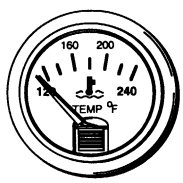
TEMPERATURE GAUGE
The question describes how the gauge should work. If you aren't sure if its working properly, you may want to run the instruments test anyway.
Look for boiling coolant, a


blown surge tank pressure cap or leaking hoses to tell you if the engine is overheating.

COOLING SYSTEM 220° F Is the approximate temperature at which the fan should turn itself on.
The fan will turn on and off as the engine temperature varies.
NOTE If the leaking fluid is red, go to the transmission Paragraph 2-34, Page 2-399 or Paragraph 2-35, Page 2-411.
If the leaking fluid is yellow/green, go to engine cooling, Paragraph 2-25, Page 2-155.
If the oil cooler is leaking, try to determine where the leak is coming from. The oil cooler in front of the radiator cools both engine oil and transmission fluid (top half-transmission fluid, bottom half-engine oil). If the leak is in the oil cooler, go to transmission or engine cooling. If the leak is elsewhere, go to lubrication, Paragraph 2-20, Page 2-65.

COOLING SYSTEM

USE CAUTION WHEN INSPECTING HOT

ENGINE PARTS TO AVOID BURNS.
NEVER REMOVE THE PRESSURE CAP OF A HOT ENGINE.
The coolant surge tank is clear, so you can see what is happening.
2-20. Lubrication System Tests
This paragraph is a top level test for all of the lubrication systems in the vehicle. Just follow the path, answering the questions. Additional information and notes are given on the facing page when necessary.
The HMMWV includes a venting system that is also checked in this paragraph. The purpose of the vent system is to allow vapor to escape to the atmosphere under normal operation, and to prevent venting during deep water fording operations. If the vents were left open, water would enter the engine and other systems and cause damage. The location of the vent lines is shown below. The location of the other parts in the lubrication system are shown in other lower level paragraph as required.
Note
Bold lines represent ventilation system.


LUBRICATION SYSTEM The tests in para. 2-26 test the oil level, cleanliness, leaks in the system, and the CDR valve. Return here when you've fixed everything you can or if no faults were found.
PROCEDURE FOR CHECKING TRANSMISSION FLUID
- Start engine.
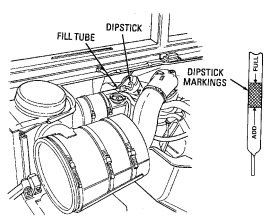 2. Hold down brake pedal and move transmission shift lever through all ranges including reverse. 3. Engage parking brake and place shift lever in neutral. Check fluid level on dipstick. 4. Proper level is between "FULL" and "ADD" marks on dipstick.
2. Hold down brake pedal and move transmission shift lever through all ranges including reverse. 3. Engage parking brake and place shift lever in neutral. Check fluid level on dipstick. 4. Proper level is between "FULL" and "ADD" marks on dipstick.
NOTE CHECK FLUID FOR A BURNT SMELL, GRIT, DISCOLORATION, AIR BUBBLES, OR A MILKY APPEARANCE.
-
Burnt smell, discoloration, or grit indicates worn or damaged internal components. Notify DS maintenance.
-
Bubbles indicate an overfilled system or air leaks in the system. Drain the fluid and refill to proper level. Refer to (para. 5-2).
-
Milky appearance is due to water in the system. Drain the fluid from the entire transmission and transmission cooling system and install a new filter.
Refer to (para 5-2).
-
Check fill tube for indications of fluid being blown out. If fluid is being blown out, check vent line for obstructions, and refill transmission to proper level. Refer to (para. 5-2).
-
Transmission fluid coming out of dipstick filler tube indicates a restriction in the ventilation system. Check for clogged, melted, or crushed lines and/or fittings between transmission and atmosphere vent on air cleaner canister. Replace where needed. Refer to (para. 5-16).
Among the items are the driveshafts, suspension, differentials, and geared hubs.
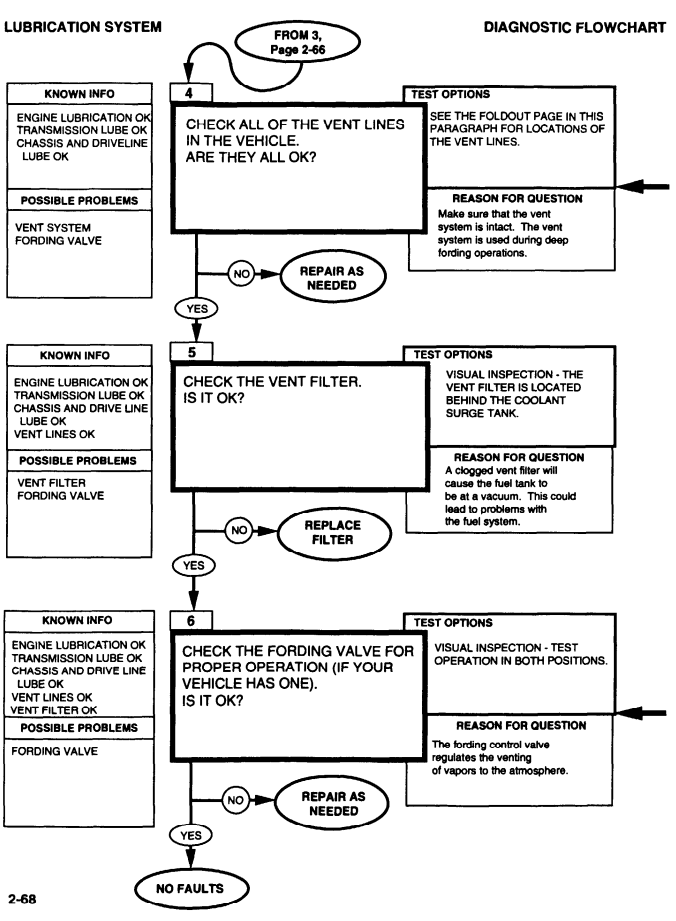
REFERENCE INFORMATION
Lubrication System
There are vent lines attached to all parts of the vehicle with a lubrication reservoir. These parts are the engine, transmission, transfer case, differentials, geared hubs, and the fuel tank.
Removal procedures for the vent lines are given in the repair procedure for the particular component to which the line is attached.

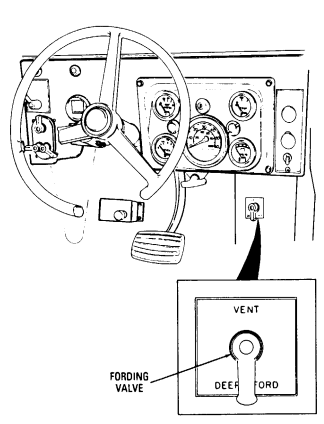
Replace the fording valve. Refer to (para 12-9).
2-21. Electrical Tests
Most of the electrical circuits in the vehicle are included in one of the major systems covered by this manual. This is a top level paragraph to help you pick the right one. A number of schematics are also included to help you find the problem. If you go through the flowchart and can't solve the problem, use the schematics to find wires which may be causing trouble. The Electrical System consists of the batteries, which produce electrical power by a chemical reaction between the lead plates and the electrolyte solution (a mixture of acid and water).
This power is carried by wires and cables to those parts of the vehicle which require electrical power. The batteries get recharged by the alternator, which generates electrical power by using some of the engine's mechanical power, produced when the engine is running. If you are not too confident about electrical concepts and terminology, you should read Paragraph 2-16, page 2-39. All electrical systems require a connection to ground (called grounding), which is the completion of the circuit to the battery negative. Pages 2-66, 2-67 and 2-68 are diagrams of the grounding. If your vehicle exhibits strange symptoms that seem to defy all efforts to fix them, the vehicle may have a grounding problem. Grounding problems cause strange symptoms usually because more than one circuit is using the same ground, or because a circuit has more than one ground. For example, looking at the body ground diagram, if wire 58D (a ground for the instruments) is disconnected from the left side cylinder head, the instruments may still function due to the separate ground, but they would probably be erratic and inaccurate. Usually the problem will be a loose or corroded connection between the circuit, through body ground to battery negative terminal. Be sure to check continuity to battery negative cable rather than simply to the vehicle body or engine block. After the grounding diagrams are functional flow schematics of the major systems in the

vehicle. The shaded areas are the wires and components of the vehicle master power distribution. These are designed to help you find the system giving you problems.

ELECTRICAL The lights are the only circuit on the vehicle which should work or be drawing any power when the switch is in the STOP position. Check the instruments, try turning on the heater fan, listen for any relay clicking or other sign (includes engine running) that power is on when It should't be.
It's best if you use the STE/ICE-R in TK mode to verify that there is no current draw from the batteries. You can't use the DCA mode for this because it will measure this current during the calibration part of the test and think that this is just an offset in the sensor.
0-1500 AMPS DC STEACE-R TEST 90 1. Connect probe.
| 2. Start Test 90, DC amps. |
|---|
- Displayed reading is in amps.
The lights should work with the rotary switch in any position.

ELECTRICAL With engine off, turn switch. If the voltmeter

is slightly in the yellow zone, you can continue down the YES path, but beware of possible test failures due to the low battery charge.
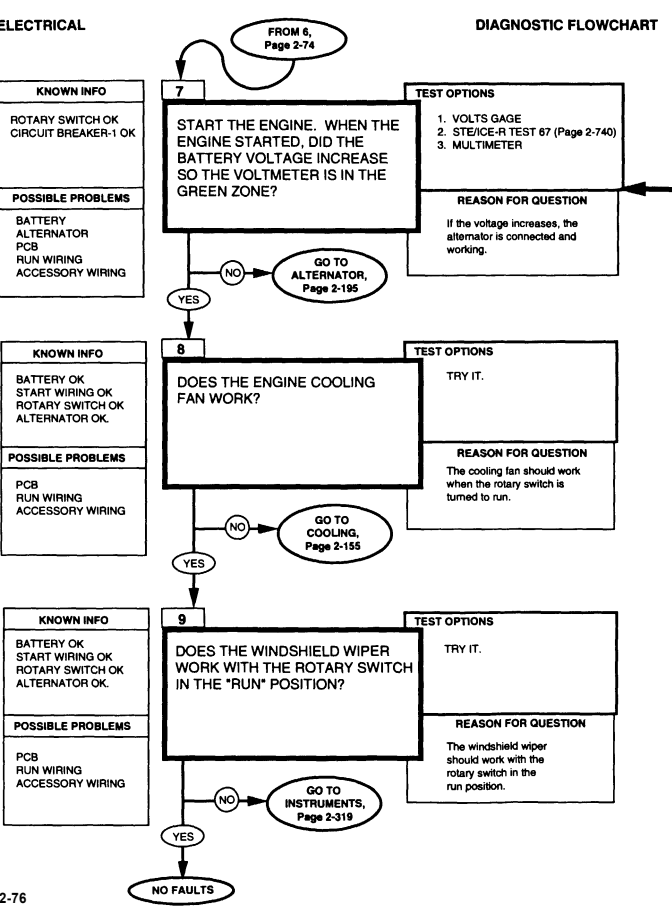
ELECTRICAL

-
Start Test 67, battery voltage.
-
Displayed reading is in volts. Batteries should be 23-25.5 volts. Batteries voltage will drop when glowplugs turn on.
ELECTRICAL DIAGNOSTIC FLOWCHART KNOWN INFO SHORT CIRCUIT IN POWER LINES

CONNECTOR. KEEP THE ROTARY SWITCH IN THE "STOP" POSITION. IS THERE STILL POWER AT ANY CIRCUITS OTHER THAN THE LIGHTS?
POSSIBLE PROBLEMS BODY CONNECTOR HARNESS ENGINE CONNECTOR HARNESS ROTARY SWITCH

KNOWN INFO BODY CONNECTOR HARNESS OK RECONNECT THE BODY CONNECTOR. DISCONNECT THE ENGINE CONNECTOR HARNESS. KEEP THE ROTARY SWITCH AT "STOP". IS THERE POWER AT ANY CIRCUITS TEST OPTIONS
- STE/ICE-R TEST 90 (Page 2-751) 2. VISUAL CHECK POSSIBLE PROBLEMS ENGINE CONNECTOR HARNESS ROTARY SWITCH

A3 REPAIR OR REPLACE THE ENGINE CONNECTOR HARNESS. GO TO STEP 1, PAGE 2-72 TO CONTINUE TESTING.
REASON FOR QUESTION If the problem stays, it has to be a short in the engine connector harness.
REASON FOR QUESTION If the problem goes away, the short is in the body connector harness or the rotary switch TM 9-2320-280-20-1
ELECTRICAL
WARNING


DISCONNECT NEGATIVE BATTERY CABLE BEFORE DISCONNECTING AND RECONNECTING PROTECTIVE CONTROL BOX/DISTRIBUTION BOX HARNESS.
There is battery voltage at the PCB/distribution box at all times. Failure to disconnect battery cable will result in damage to equipment or injury to personnel.
0-1500 AMPS DC STE/ICE-R TEST 90 1. Connect probe. 2. Start Test 90, DC amps.
- Displayed reading is in amps.
Replace PCB, refer to (para. 4-5). Replace distribution box, refer to (para. 4-5.1).
Repair harness, refer to (para. 4-85). Replace harness. Notify DS maintenance.
ELECTRICAL KNOWN INFO SHORT ON BODY CONNECTOR SIDE OF PCB/DISTRIBUTION BOX POSSIBLE PROBLEMS ROTARY SWITCH PCB/DISTRIBUTION BOX BODY CONNECTOR BODY CONNECTOR CABLE HARNESS KNOWN INFO ROTARY SWITCH OK POSSIBLE PROBLEMS PCB/DISTRIBUTION BOX BODY CONNECTOR BODY CONNECTOR CABLE HARNESS

REPAIR OR REPLACE THE BODY CONNECTOR HARNESS.
GO TO A2, PAGE 2-78, TO CONTINUE TESTING.
REFERENCE INFORMATION ELECTRICAL
- Connect RED clip and BLACK clip to the terminations indicated in the question. RED to the first, BLACK to the second. 2. Start Test 91, 0-4500 ohms. 3. Displayed reading is in ohms. Less than 5 ohms is continuity. If the resistance is over 4500 ohms, STE/ICE displays "9.9.9.9." Replace rotary switch. Refer to (para. 4-7).
0-45 DC VOLTS STE/ICE-R TEST 89 Replace PCB. Refer to (para. 4-5). Replace distribution box. Refer to (para. 4-5.1).
-
Connect RED clip to the indicated test point, BLACK clip to negative or ground.
-
Start Test 89, DC volts.
-
Displayed reading is in volts.

DISCONNECT NEGATIVE BATTERY CABLE BEFORE DISCONNECTING AND RECONNECTING PROTECTIVE CONTROL BOX/DISTRIBUTION BOX HARNESS.
There is battery voltage at the PCB/distribution box at all times. Failure to disconnect battery cable will result in damage to equipment or injury to personnel.
Repair or replace harness.
Notify DS maintenance.

Battery cables to starter.

Bus bar to solenoid PCB engine & body connector Light switch

Electrical
Reference Information Battery Voltage Steace-R Test 67
-
Start Test 67, battery voltage.
-
Displayed reading is in volts. Batteries should be 23-25.5 volts. Batteries' voltage will drop when glowplugs tum on.
Battery Voltage Multimeter
-
Set the voltmeter to a DC volts scale of at least 40 volts.
-
Connect the RED lead to positive and the BLACK lead to negative. 3. Be sure to read the correct scale.
ELECTRICAL
Battery/Engine Ground Circuit
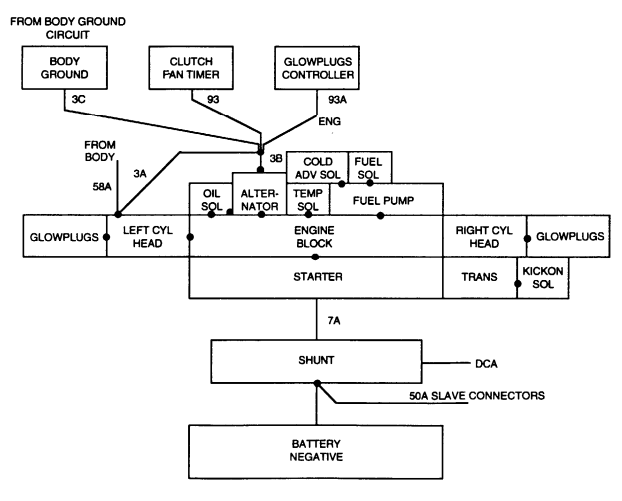
ELECTRICAL
Body Ground Circuit

ELECTRICAL

Front Hood/Lights Ground Circuit
Battery Circuit Interface
ELECTRICAL

ALL CIRCUITS MUST RETURN THROUGH VEHICLE GROUND.
ELECTRICAL

ELECTRICAL
Alternator Interface


ELECTRICAL
SHADED AREA IS VEHICLE MASTER POWER


ELECTRICAL

2-22. Fuel System Tests
These Fuel System tests can be run any time you think there maybe a problem with the fuel system or if you were sent here from another test.
If you are running this test because the engine runs rough remember that air intake and exhaust as well as internal mechanical problems can also cause this condition. At the bottom of this page is a simplified block diagram which shows how the different fuel system

components relate to each other. Refer to fold-out page FO-1, leave open for reference while you are testing.
This set of tests maybe used when the engine is hard starting, has low power or runs rough. Just follow the path, answering the questions. Additional information and notes are given on the facing page (like this one) when necessary. It is recommended that you refer to your fold-out diagram now because it will help you follow the testing.
I

MAKE SURE ALL ELECTRICAL CONNECTIONS ARE CLEAN AND TIGHT. CHECK FUEL SOLENOID, COLD ADVANCE SOLENOID, BATTERIES, ROTARY SWITCH, ETC.
- While cranking or running the engine open the drain fitting end drain some fuel into a clear container.
- The fuel should come out of the open drain valve in a steady stream, if it
doesn't, than ANSWER NO TO THIS QUESTION.
NOTE: Nothing will come out unless the engine is running or cranking. Close the drain valve and turn the rotary switch to STOP. Check the fuel that came out to be sure that it isn't contaminated with water or dirt.
If the fuel didn't come out in a steady stream or if it is contaminated then ANSWER NO TO THIS QUESTION.
If you have trouble starting the engine you should have entered here byway of the Statability tests. If you didn't begin there, go beck to Page 2-41 and the the Startability top level teat.
At this point you don't care how well it starts or runs but just that it will run. THE ANSWER TO THIS QUESTION IS NO if the engine seems to start but stops almost immediately.
Engine temperature may be determined from vehicle temp. gauge (Rotary Switch must be in RUN position) or by touching fortably than it is above 120° F (49° C).
Hard stating can be caused by other things such as fuel in the lines leaking back into the tank while the engine is shut down. This will occur if there is an air leak in the lines.

FUEL SYSTEM Diesel fuel is highly flammable.
Do not perform any procedures near fire, flames, or sparks.
Severe injury ordeath will result WARNING A hot engine may cause serious
 bums. Always use caution when approaching a hot engine.
bums. Always use caution when approaching a hot engine.
FUEL SYSTEM

FUEL SOLENOID OK COLD ADVANCE OK FUEL FILTER FUEL SOLENOID OK COLD ADVANCE OK AND FILTER OK INJECTION PUMP FUEL SUPPLY LINES FUEL RETURN LINES RETURN CHECK VALVE FUEL LINES, PUMP AND FILTER OK INJECTION PUMP EXHAUST RESTRICTED FUEL LINES FUEL PUMP FUEL LINES FUEL FILTER FUEL PUMP FUEL PUMP INJECTORS INJECTORS
FUEL SYSTEM Watch the fuel pump pressure while slowly accelerating the angina from idle to maximum speed. The pressure should always be greater than zero. If pressure, check to be sure it is still above zero even during maximum acceleration (maximum engine power). You can use STE/ICE test 24 with control function 02 (minimum).
NOTE Rapidly accelerating the engine with the transmission in neutral doesn't work for this engine because the fuel supply can't increase as fast as the engine can accelerate so you won't get good test results.
Proper engine performance is dependent upon the availability of the correct fuel volume to the injection pump.
Pay attention to when the engine runs rough. If it runs rough only while warming up after a cold start it may be a glowplug problem and you should run the Glowplug Circuit tests. Rough running may also be caused by air leaks in the fuel supply lines. Air in the fuel should purge itself while idling. If rough running occurs after a period of high speed or high power running but seems to go away after idling, then look for air leaks in the fuel supply lines and fittings. if rough running occurs while driving but idles ok, check the fuel return check valve for any malfunctions (refer to para. 3-35).
Note
Try to adjust the engine idle speed by turning the idle speed screw (refer to para 3-44).
Continue testing if you can adjust the speed properly. If you cannot, notify DS maintenance.
Engine must be at normal operating temperature when making speed checks. Air fitter must be in place and all accessories (lights, heater fan, etc...) must be turned off.
This engine has a min-max governor which controls engine speed at both idle and full throttle.

FUEL SYSTEM Governor no-load speed is with the transmission in neutral. Loaded speed is with the transmission in gear and the vehicle moving. It is the maximum rpm's the engine will develop. The engine will surge at governor speed since the governor will try to lower the engine speed and the accelerator is trying to increase it.
A number over 75 is passing for STE/lCE-R test 13. tf the vehicle seems to be low on power while driving you have to check for other things which could cause this such as the transmission.
To try a road test, accelerate the vehicle from 0 to a safe and reasonable speed on a reasonably level road.
NOTE If the exhaust is not colorless it must be either white, blue or black. If exhaust color is: WHITE . . . . . . . . . . Go to G, Page 2-122. Also could be injector timing. Notify DS maintenance. BLUE . . . . . . . . . . . . Blue smoke is a sign of oil entering the combustion chambers. It usually enters pest the piston rings or intake valve stem seals. This is an internal engine problem that can't be handled at this level of maintenance. You may want to run the Engine Running Mechanical tests, Page 2-47, before you notify DS Maintenance.
BLACK . . . . . . . . . Air lntake/exhaust, Page 2-137.

TM 9-2320-280-20-1 FUEL SYSTEM REFERENCE INFORMATION
-
Note engine rpm reading (STE/lCE-R TEST 10)
-
Gently depress rocker arm on pump towards injection pump 3. If mechanism is functioning properly rpms will decrease.
-
If mechanism doesn't move freely, try putting a drop of oil in the two spots indicated. Gently try to depress rocker arm again.
Injection pump as seen

from rear of engine. Gently press screwdriver against arm.
Use a ten inch screwdriver

REFERENCE INFORMATION If no fuel arrives when cranking engine,

 the diaphragm in the Iift pump may be ruptured, allowing the fuel to drain back into the tank.
the diaphragm in the Iift pump may be ruptured, allowing the fuel to drain back into the tank.
There may be some water or dirt trapped in the filter already that didn't come from the fuel that is in the tank now. Open the filter drain valve and sank the engine for approximately 5 seconds to purge the filter, then take a fuel sample in a clear container.
Inspect the sample for water and dirt. Replace fuel fitter, refer to (para 3-33).
KNOWN INFO B1 ENGINE DOESN'T STAY RUNNING POSSIBLE PROBLEMS FUEL PUMP FUEL SUPPLY LINES FUEL RETURN LINES FUEL FILTER FUEL SOLENOID/WIRING HIGH PRESSURE SYSTEM
Known Info
OTHER SYSTEMS LISTED ABOVE OK POSSIBLE PROBLEMS FUEL PUMP FUEL SUPPLY LINES FUEL RETURN LINES FUEL FILTER FUEL SOLENOID/WIRING HIGH PRESSURE SYSTEM
Known Info
FUEL PUMP OK FUEL SUPPLY LINES OK FUEL FILTER OK POSSIBLE PROBLEMS FUEL RETURN LINES FUEL SOLENOID/WIRING HIGH PRESSURE SYSTEM Disconnect the glowplug
 controller and wire 569B/569D from the injector pump. Make sure that wire 54A is properly connected to the injector pump. With the rotary switch in "RUN" position, do you have at least 0.5 amps DC flowing through wire 54A?
controller and wire 569B/569D from the injector pump. Make sure that wire 54A is properly connected to the injector pump. With the rotary switch in "RUN" position, do you have at least 0.5 amps DC flowing through wire 54A?

Go to N,

Page 2-132 TEST OPTIONS STE/ICE Test 90, (page 2-751) Multimeter
Reason For Question
Current through the wire quickly checks the integrity of the fuel system wiring. The normal reading will be about 1.3 to 1.5 amps.
B2

Test Options
Reconnect the above wires. Check fuel pump pressure and volume during cranking. Is pump pressure greater than 3 psi (20.69 kPa) and fuel volume at the injection pump inlet 1 pint in 30 seconds?



Does the engine start and stay running with the fuel return line (the short rubber line at the injector pump) disconnected?

Go to B4, page 2-108


Volume Test STE/ICE Test 24, (page 2-738) Fuel Pump REASON FOR QUESTION Positive pressure and volume indicate that fuel is present and supply lines and filter are not plugged. This is a test of the lift pump.
TEST OPTIONS Put the return line in a suitable container and try starting the engine.
REASON FOR QUESTION A restricted fuel return line will cause a pressure imbalance in the pump and prevent the engine from running.
Reference Information Fuel System
Note
When using a multimeter to measure current through wire 54A, disconnect the wire. Set the ammeter to a scale of at least 5 amps DC. Connect the red lead of the multimeter to wire 54A and the black lead to ground. With the rotary switch in the RUN position, measure current. Be sure to read the correct scale. Return the switch to the STOP position. Disconnect the multimeter and reconnect wire 54A.
Fuel Pump Pressure Ste/Ice-R Test #24
-
Select Fuel Supply Pressure Test (Test #24). Perform CAL.
-
Crank (or start) engine.
Fuel Pump Volume Test
- Disconnect fuel line at injection pump inlet and route fuel line into a suitable, 1 quart container. 2. Crank the engine for 30 seconds. 3. If the pump and lines are ok, you should get about 1 pint (1/2 quart) (0.5L) in 30 seconds.

Warning
Diesel fuel is highly flammable. Do not perform any procedures near fire, flames, or sparks. Severe injury or death may result.
-
Disconnect the return line and direct it into a suitable container.
-
Watch the fuel flow from the return line as you or an assistant try to start the engine.
5 Amps Dc Ste/Ice-R Test 89
-
Connect RED clip to the indicated test point; BLACK clip to negative or ground.
-
Start Test 90. 3. Displayed reading is in amps.
Fuel Pump Pressure Test Pressure Gauge
-
Connect a tee into the fuel line between the fuel filter outlet and the injection pump inlet.
-
Attach gauge to tee. 3. Crank (or Start) engine.

KNOWN INFO B4 FUEL SOLENOID AND WIRING OK POSSIBLE PROBLEMS FUEL RETURN LINES INJECTION PUMP INJECTORS RETURN CHECK VALVE KNOWN INFO RETURN LINES OK POSSIBLE PROBLEMS INJECTION PUMP INJECTORS

DOES THE ENGINE RUN
POORLY WITH THE RETURN



TEST OPTIONS


Visual Inspection

REASON FOR QUESTION Plugged fuel return lines cause back pressure which prevents injection pump from working properly.
Test Options
Run Intake/Exhaust Tests
 Page 2-137.
Page 2-137.
RUN THE INTAKE/EXHAUST

 TESTS. RETURN HERE IF NO FAULTS FOUND.
TESTS. RETURN HERE IF NO FAULTS FOUND.
REASON FOR TESTS There is still a possible Intake/Exhaust fault. If you came here from Startability then this wasn't tested.
KNOWN INFO RETURN LINES OK

RUN THE STARTABILITY TEST
 RUN THE FUEL SYSTEM TEST
Run Startability Test Page 2-41. Run Fuel System Test Page 2-95.
RUN THE FUEL SYSTEM TEST
Run Startability Test Page 2-41. Run Fuel System Test Page 2-95.
REASON FOR TEST If all efforts have been exhausted, still experience no hot start problem, identify the fuel injection pump model and serial number.
POSSIBLE PROBLEMS INJECTION PUMP INJECTORS TEST OPTIONS
Reference Information Fuel System
Return lines should be inspected for kinks or crushed lines or anything that might restrict fuel flow. Inspect fuel return check valve for any restrictions. Replace valve (para. 3-35). Replace fuel lines. Refer to (para. 3-25).
If you came here from the Startability Tests, return to STEP 5, Page 2-44. If you haven't run the Startability Tests yet, go to STEP 1, Page 2-42.
During high temperature and humidity, early model vehicles can experience difficulty starting while using JP-8 fuel. High temperatures can cause restrictive clearances in some older fuel injection head and rotor assemblies. The engine must be allowed to cool to allow adequate clearance of the pumping plungers to ensure adequate fuel delivery for starting. If this condition persists, run the startability tests. If vehicle passes all startability tests and troubleshooting procedures and still experiences difficulty in hot starting, identify the fuel injection pump and serial numbers. All fuel injection pumps with P/N DB2831-5209, NSN 2910-01-467-9029 incorporated the improved head and rotor assembly, P/N 31506. If your serial number is less than shown in the Serial Number Break Column of the table below, the manufacturer recommends the fuel injection pump to be replaced, tagged as a "no hot restart" condition, and forward for rebuild. Notify direct support maintenance.
| System | ||
|---|---|---|
| 29.1 Annually Dust | Visually inspect dust unloader for | Dust unloader missing or |
| Unloader | presence and for cuts, tears, | has cuts, tears, obstruc |
| obstructions, worn areas, enlarged | tions, worn areas, | |
| gap, or if center opening exceeds | enlarged gap, or if center | |
| 1/8 in. (3.175 mm). | opening exceeds 1/8 in. | |
| (3.175 mm). |
KNOWN INFO C1 HARD COLD STARTING POSSIBLE PROBLEMS COLD ADVANCE CIRCUIT GLOWPLUG CIRCUIT FUEL SYSTEM KNOWN INFO POWER TO COLD ADVANCE SOLENOID POSSIBLE PROBLEMS COLD ADVANCE CIRCUIT GLOWPLUG CIRCUIT FUEL SYSTEM KNOWN INFO COLD ADVANCE CIRCUIT OK POSSIBLE PROBLEMS GLOWPLUG CIRCUIT FUEL SYSTEM
FUEL SYSTEM DIAGNOSTIC FLOWCHART

FUEL SYSTEM The engine temperature must be below 90° F (32°C) to get voltage here. If the engine is warm, either wait for it to cool, or go to step C3 at the bottom of the pegs and remember that the cold advance maybe the problem if everything else checks out OK.
The Glowplugs or the lntake/Exhaust System may be faulty, so you should test them first.
The cold advance circuit advances the fuel injection pump timing approximately 3 to 5 degrees during cold start up. If engine temperature is less than 90°F (32°C), then Advance circuit operation maybe checked as follows: 1.
Start the engine.
Disconnect wire 569B/569D from the Advance Solenoid. If the circuit is working correctly, then engine RPM should decrease.
Look at the advance mechanism on the right side of the fuel injection pump while you connect and disconnect 569D/ 569B with the engine running. The advance mechanism should move about 1/4 inch.
If the advance mechanism is stuck, apply some oil at the points shown and try again.
Remember to reconnect any wires that were disconnected during troubleshooting.
-
Connect RED clip to positive, BLACK clip to negative or ground.
-
Start Test 89, DC volts.
-
Displayed reading is in volts.
Battery Voltage Multimeter
-
Set the voltmeter to a DC volts scale of at least 40 volts.
-
Connect the RED lead to positive and the BLACK lead to negative.
-
Be sure to read the correct scale.




FUEL SYSTEM If you hear a hissing noise while removing the fuel filter cap then either the vent filter is plugged, the vent line is restricted, or the vent valve is restricted. The vent filter is located behind the coolant surge tank.
Replace vent lines or vent line filter, refer to (para. 3-27.) Replace vent valve, refer to (para. 3-24.) Diesel fuel is sensitive to temperature. All diesel fuel has a certain amount of paraffin-like components which have high energy value and help improve fuel economy. When temperatures are less than 20°F (-7°C) these components begin turning into wax flakes that can build upon the fuel tank strainer or in the fuel filter. If wax build-up is found, replace the fuel in the tank with a winter grade of fuel if available. You will have to remove the fuel tank if you need to inspect the tank strainer.
Replace fuel tank, refer to (para. 3-24.)



FUEL SYSTEM Fuel lines should be inspected for kinks, cracks or anything that would restrict fuel flow or allow air to enter the lines. Be sure to check the lines all the way beck to the tank and remember that there is a strainer inside the tank which can become plugged. You will have to remove the tank if it becomes necessary to check this.
Replace fuel lines, refer to (para 3-25) Poor starting and excessive smoke after start up can be the result of a restricted fuel supply. This restriction most likely will be from a plugged fuel filter but can also be caused by a pinched or kinked fuel line.
After the engine warms up, it generally will run satisfactorily. If the restriction gets progressively worse, top speed and performance will be affected also.
Fungus
In warm or humid weather, fungi and/or bacteria in the fuel can cause fuel system damage by plugging the fuel lines, filter, or injection nozzles.
For removal, replacement and torques, refer to (para 3-33) or notify DS maintenance.
Excessive roughness on any of these parts is an indication of wear. The pushrod should slide smoothly in the engine block. If you notice any roughness on the end of the pushrod be sure to check the lobe on the camshaft.
Note
If the pump or rod is worn, replace. Refer to (para 3-23). If the lobe on the camshaft is worn, notify DS maintenance.
Rerun Test Chain
You may have corrected some problems but there may be others including the fuel pump.
For removal, replacement and torques, refer to (para 3-23).

TM 9-2320-280-20-1 REFERENCE INFORMATION FUEL SYSTEM Injection pump timing that is too far

advanced can cause glowplugs failure because it increases cylinder temperature. Usually several but not all glowplugs will fail.

REFERENCE INFORMATION Be sure to keep the line clear of

moving engine parts (fan, pulleys, etc...) and DO NOT place the line on the exhaust manifold.
Replace fuel lines (refer to para 3-25).
Check the fitter vent screw for tightness.
Check the supply lines for kinks, cracks, leaks, or loose connections that could restrict fuel flow or allow air to enter the system. Remember that under certain operating conditons parts of the fuel system can be under vacuum so that loose connections

FUEL SYSTEM
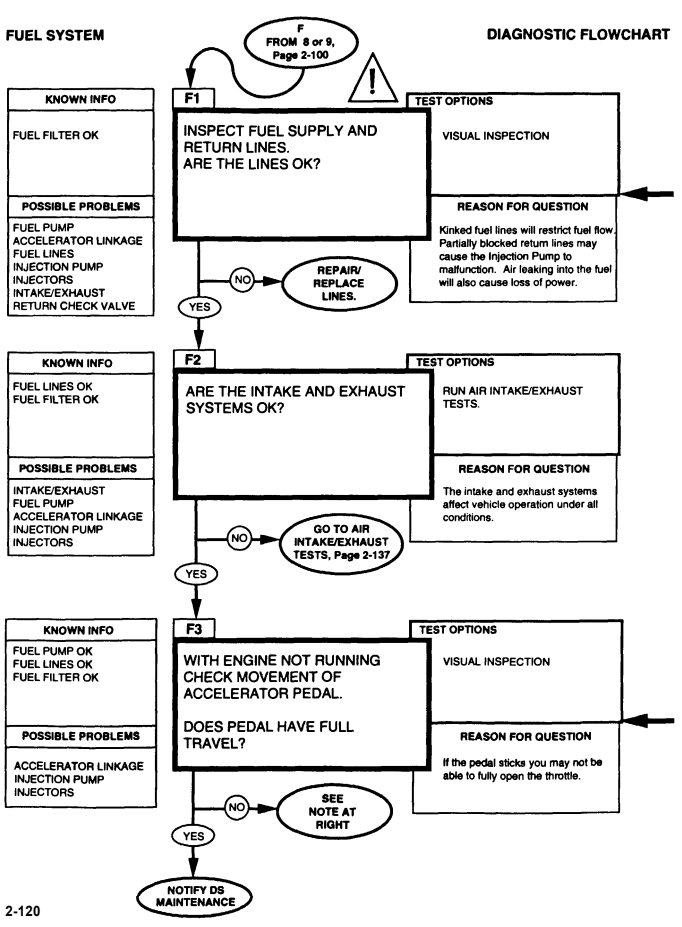
REFERENCE INFORMATION

Be sure to keep the line clear of moving engine parts (fan, pulleys, etc...) and DO NOT place the line on the exhaust manifold.
Fuel lines should be inspected for kinks, cracks, or anything that would restrict fuel flow or allow air into the lines. Be sure to check the lines all the way back to the tank and remember that there is a strainer inside the tank which can also become plugged. To teat for air leaks in the supply lines, disconnect the return line from the injection pump and connect a line that is long enough to reach the ground.
Place the end of the line into a bucket containing diesel fuel, making sure that the end of the line is below the level of fuel in the bucket. Run the engine and watch for air bubbles in the bucket.
Replace fuel line, refer to (para 3-25).
An important function of all hoses, lines and fittings is to carry fuel without admitting air to the system. When the fuel tank cap is in place and the fuel pump and injection pump are drawing fuel through the lines a low vacuum of 0-1 PSI is created. This occurs because the fuel which the engine uses must be replaced by air. During this vacuum condition, the slightest leak, which may not leak fuel out, could draw air into the system and, depending on the volume of air, cause a wide variety of engine malfunctions.
Cold Weather Operation
Diesel fuel is sensitive to temperature. All diesel fuel has a certain amount of wax-like components which have high energy value and help improve fuel economy. When temperatures are less than 20°F (-7°C) these components begin turning into flakes that can build up on the fuel tank strainer or in the fuel filter.
Fungus
In warm or humid weather, fungi and/or bacteria can cause fuel system damage by plugging the fuel lines, filter, or injection nozzles.
Old fuel smells like varnish.
Check the accelerator pedal for full movement with no sticking or binding. It you have sticking or binding, lubricate accelerator pedal bushing and bearing with seasonal grade OE oil (TM 9-2320-280-10). If you do not have full pedal travel then disconnect the accelerator linkage from the fuel injection pump and recheck the travel. It you now have full travel then the problem is in the fuel injection pump and cannot be handled at this level of maintenance. Operation of the injection pump and injectors cannot be verified at this level of maintenance.
FUEL SYSTEM
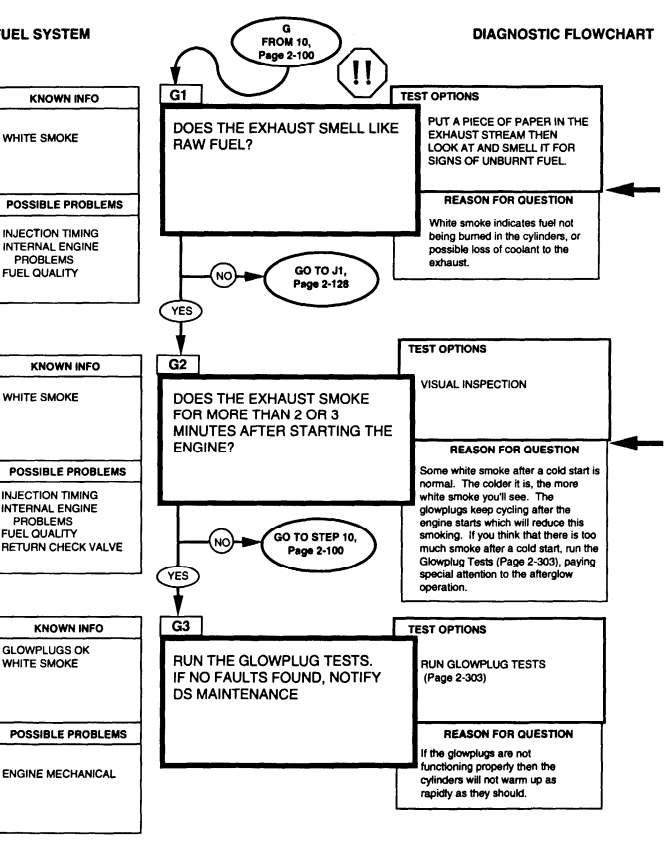
REFERENCE INFORMATION FUEL SYSTEM

Be careful when performing this test. Exhaust gas can be extremely hot end severe bums can result.
Put a piece of paper in the exhaust stream for a few moments with the engine at idle. Then look at the paper to see if there is any condensed fuel on it. Then smell the paper to see if it smells like raw fuel. If it smells like fuel then the engine could be very cold or else it has a DS level fuel system fault or compression fault.
White smoke for a short time after start up, especially on a cold day, is a normal condition. It is caused by incomplete combustion of the fuel because of low cylinder temperature. It should clear up in a few minutes. If not you may have a bed head gasket, cracked block, or a restricted check valve. Check for restricted check valve (para. 3-35).


Keep hands away from engine fan!
Moving fan blades can cause serious injury. Use extreme caution when engine is running.

Disconnect negative battery cable before disconnecting and reconnecting protective control box hamess.
There is battery voltage at the PCB at all times. Failure to disconnect battery cable will result in damage to equipment or injury to personnel.
Rotary Switch must remain in STOP position for the rest of
-
Connect RED clip to positive, BLACK clip to negative or ground.
-
Start Test 89, DC volts.
-
Displayed reading is in volts.
Dc Voltage Multimeter
-
Set the voitmeter to a DC volts scale of at least 40 volts.
-
Connect the RED lead to positive and the BLACK lead to negative.
-
Be sure to read the correct scale.

OK, you have to replace the harness.
Remember to reconnect any wires that may have been disconnected during troubleshooting.
For repair instructions (HARNESS REPAIR), refer to (para 4-85).
For repair/replace instructions (ROTARY SWITCH), refer to (para 4-7).
Fuel System
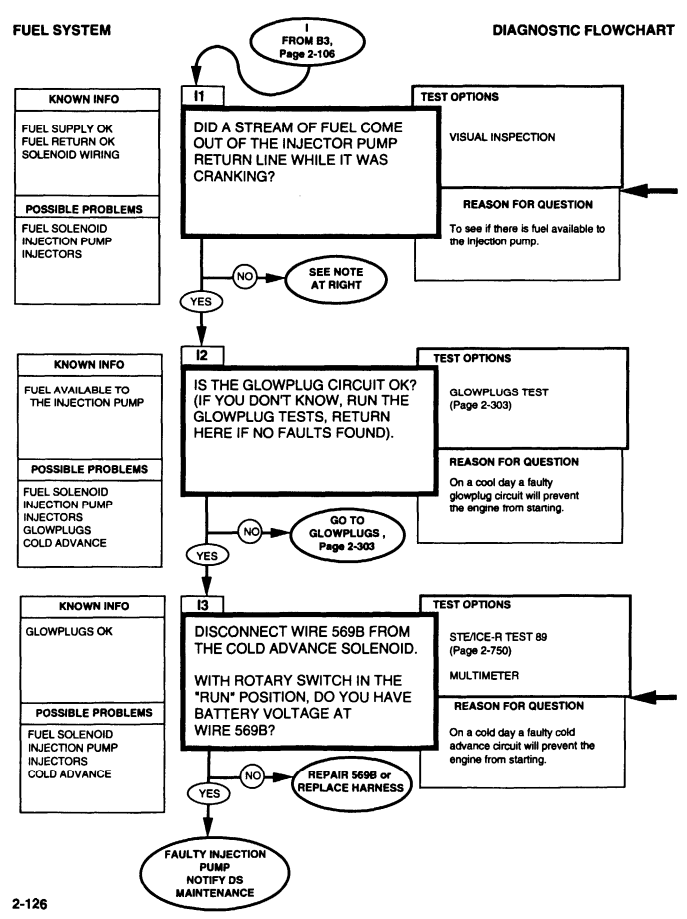
Reference Information Fuel System
NOTE Check the rubber return line from the injection pump to the steel tubing return line. If the rubber line is not clogged go to D1, page 2-112.
If the line is clogged, then replace it. Start the engine and see if it stays running. If it doesn't start or stay running then return to J1 and continue testing. There may be another fuel system fault preventing fuel from reaching this point.
-
Connect RED clip to the indicated test point, BLACK clip to negative or ground.
-
Start Test 89, DC volts.
-
Displayed reading is in volts.
Battery Voltage Multimeter
-
Set the voltmeter to a DC volts scale of at least 40 volts.
-
Connect the RED lead to positive and the BLACK lead to negative.
-
Be sure to read the correct scale.
If the cold advance solenoid is getting power then the only possibilities that would keep the engine from starting are that fuel is not reaching the cylinders due to a fault in the high pressure side of the fuel system or nearly all the cylinders have very low compression. It is unlikely that all the cylinders would lose compression at the same time, but you may want to run a Compression Unbalance test (STE/ICE-R Test #14) to check this.
For repair/replace instructions, refer to (para 4-85).


FUEL SYSTEM
Note
If you are getting white smoke due to coolant entering the cviinders then you should notice a loss of coolant in the radiator or bubbles in the radiator tank while the engine is running. You may need to fill the radiator to proper level and recheck a day later to determine if there is a coolant loss.
If you don't detect coolant loss then you may have missed a fuel problem. Rerun the fuel system tests paying attention for a raw exhaust smell.
If you still find nothing you may have a small or inconsistant leak.
Notify DS maintenance.

Keep hands away from engine fan! Moving fan blades can cause serious iniurv. Use extreme caution when engine is running.
If the enaine doesn't shut off with the solenoid disconnected then fuel is still reaching the cylinders- probably because the fuel solenoid is stuck open. When vou squeeze the return line tight enough to prevent fuel flowing through it, you create a pressure imbalance inside the injection pump that will cause the engine to stall.

Disconnect negative battery cable before disconnecting and reconnecting protective control box hamess.
There is battery voltage at the PCB at all times. Failure to disconnect battery cable will result in damage to equipment or injury to personnel. Remember to reconnect any wires that may have been disconnected during troubleshooting.
For repair/replace instructions (HARNESS), refer to (para 4-85).
For repair/replace instructions (PCB), refer to (para 4-5).
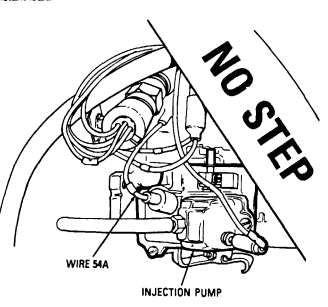
-
Connect RED clip to the indicated test point, BLACK clip to negative or ground.
-
Start Test 89, DC volts.
-
Displayed reading is in volts.
Battery Voltage Multimeter
-
Set the voltmeter to a DC volts scale of at least 40 volts.
-
Connect the RED lead to positive and the BLACK lead to negative.
-
Be sure to read the correct scale.

FUEL SYSTEM
-
Connect RED clip to positive, BLACK clip to negative or ground.
-
Start Test 89. DC volts.
-
Displayed reading is in volts.
You should only run the enaine long enough to determine the gage reading because engine temperature must stav below 90° F (33° C) for the Cold Advance Circuit to function.
Battery Voltage Multimeter
-
Set the voltmeter to a DC volts scale of at least 40 volts.
-
Connect the RED lead to positive and the BLACK lead to negative.
-
Be sure to read the correct scale.
-
Shut off enaine 2. Disconnect wire 569C at Cold Advance Switch.
-
Turn Rotary Switch to Run
position.
- Check for battery voltage at wire
રક્કર્સ્ટ.
Repair wire or replace hamess, refer to (para 4-85).
NOTE Engine temp must be less than 90°F (33° C) when testing the switch.
For repair/replace instructions, (COLD ADVANCE SWITCH), refer to (para 4-27).
For repair/replace instructions, (HARNESS), refer to (para 4-85).


Alternator output is hot when the Rotary Switch is in the RUN position.
Cold Advance Switch is closed when engine temperature is below 90°F (33° C) and open when it goes above 120°F (49° C).
The Cold Advance Solenoid advances the Injection Pump timing when it receives power from the switch. This helps the engine run better when it is cold.
Fuel System
KNOWN INFO NO VOLTAGE AT FUEL SOLENOID POSSIBLE PROBLEMS РСВ ROTARY SWITCH WIRING KNOWN INFO WIRING TO FUEL SOLENOID OK POSSIBLE PROBLEMS PCB ROTARY SWITCH WIRING KNOWN INFO WIRING TO FUEL SOLENOID OK POSSIBLE PROBLEMS PCB ROTARY SWITCH WIRING


Disconnect negative battery cable before disconnecting and reconnecting protective control box hamess.
There is battery voltage at the PCB at all times.
Failure to disconnect battery cable will result in damage to equipment or injury to personnel.
Repair wiring, refer to (para 4-85).
Inspect wiring to be sure that all the wires are connected in their proper places.

PCB ENGINE CONNECTOR (ON LEFT FENDER

PCB BODY CONNECTOR (LOCATED UNDER DASHBOARD) Repair wiring, refer to (para 4-85).
Remember to reconnect any wires that were disconnected during troubleshooting.
FUEL SYSTEM

-
Connect RED clip and BLACK clip to the terminations indicated in the question. RED to the first, BLACK to the second.
-
Start Test 91, 0-4500 ohms.
-
Displayed reading is in ohms. Less than 5 ohms is continuity. If the resistance is over 4500 ohms/ STE/ICE displays "9.9.9.9."
-
Set the voltmeter to an ohms scale of about 1000 ohms.
-
Connect the RED and BLACK leads to the connections stated in the question.
-
Be sure to read the correct scale. Less than 5 ohms indicates continuity. For an open circuit, the meter should peg full scale (needle all the
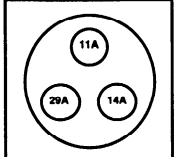
way to the left).
REAR OF ROTARY SWITCH

Reference Information Fuel System


to (para 4-85).

For repair/replace instructions (ROTARY SWITCH), refer to (para 4-7).
WARNING

Disconnect negative battery cable before disconnecting and reconnecting protective control box hamess.
There is battery voltage at the PCB at all times.
Failure to disconnect battery cable will result in damage to equipment or injury to personnel. Be sure to reconnect the wires at the rotary switch and the fuel solenoid.
For repair/replace instructions (PCB), refer to (para 4-5).
-
Connect RED clip and BLACK clip to the terminations indicated in the question.
-
Start Test 91, 0-4500 ohms.
-
Displayed reading is in ohms. Less than 5 ohms is continuity. If the resistance is over 4500 ohms, STE/ICE displays "9.9.9.9.9."
-
Set the voltmeter to an ohms scale of about 1000 ohms.
-
Connect the RED and BLACK leads to the connections stated in the question.
-
Be sure to read the correct scale. Less than 5 ohms indicates continuity. For an open circuit, the meter should peg full scale (needle all the way to the left).
2-23. Air Intake/Exhaust Tests
These Air Intake/Exhaust System tests can be run anytime you think there maybe a problem with the air intake or exhaust systems, or if you were sent here from another test.
At the bottom of this page is a simplified block diagram of the Intake Air/Exhaust System. A detailed functional flow is not applicable to this system.
The Air Intake/Exhaust System is a very simple system that can cause very annoying

problems. Whether the vehicle is hard to start or runs rough or never develops full power, it's worth the few minutes that it takes to check the components of this system. You can run through the diagnostic logic for this system almost anytime you open the hood or check the underside of your vehicle.
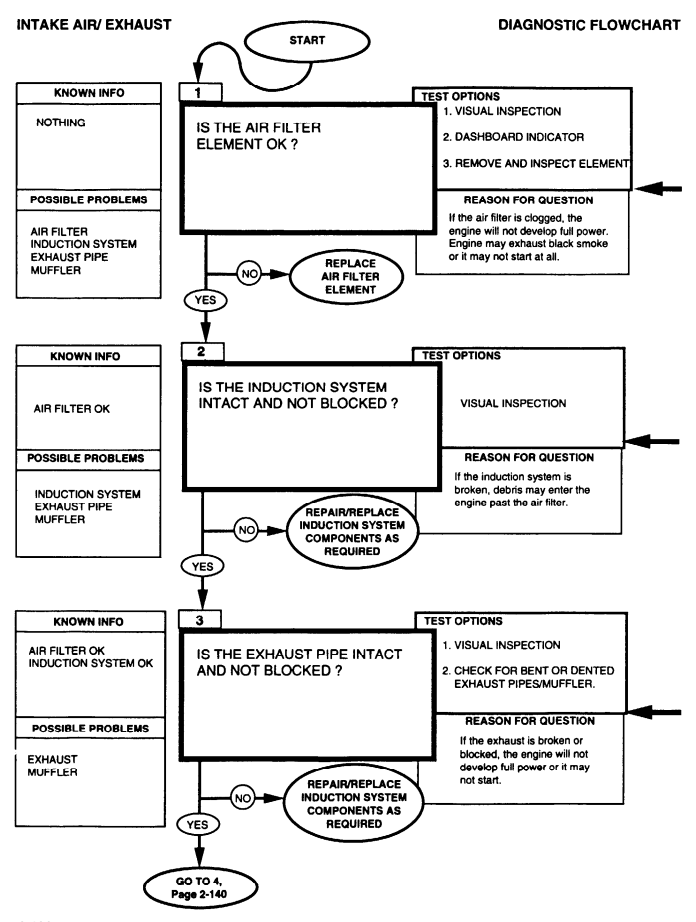
REFERENCE INFORMATION INTAKE AIR/ EXHAUST First, check the Air Filter Restriction gauge on the dashboard, just to the left of the steering wheel and make a note of its reading. Open the air cleaner cannister, remove the air cleaner element and inspect it for dirt and other contaminants. Replace air filter, refer to (para 3-13). A clean air filter is white. If the condition of the filter does not agree with the gauge on the dashboard, make a note to check the gauge, see Instruments section, page 2-319.

Make sure that all mounting bolts are in place and tight. Look for obvious things like a crushed or cracked air filter or air induction tube, check gaskets where possible.
Replace induction system components, refer to (para 3-12).
Look for damage caused by rocks such as bent pipes or holes and loose or broken clamps.
Small dents (depth less than 1/4 the diameter of the exhaust pipes) should not cause the pipes to be replaced as long as the pipes are intact.
Replace induction system components, refer to (para 3-12).

REFERENCE INFORMATION .
Look for damage caused by rocks such as bent pipes or holes, loose or broken clamps.
Replace muffler, refer to (para 3-48).
2-24. Compression/Mechanical Tests
The main intent of this paragraph is to determine if the engine has internal compression or mechanical problems and to fix everything possible without having to notify DS maintenance.

Reference Information Compression / Mechanical Engine Rpm Steace-R Test 10
-
Start Test 10, Engine RPM.
-
Crank or start the engine. Displayed reading is RPM. Cranking RPM should be approximately 100-200. Idle RPM should be

625 - 675.
A healthy engine should crank at least 100 RPM when it's cold and at least 180-200 RPM when it's wam.
If the engine doesn't crank at normal speed then it could be due to a Starter or Battery Circuit fault or it may be due to an internal engine problem.
OIL PRESSURE SENDING UNIT
Oil pressure may go as high as 80 psi if the engine is cold and should be 10 psi minimum at idle speed. You should check the oil pressure with the STE/ICE-R (test 50) using 1000 psi transducer (blue stripe). Check pressure at idle and at 2000 RPM. If pressure is low, check oil level and condition. Add or change oil as required.
Oil Pressure Steace-R Test 50
-
Install STE/ICE-R 0 to1000 PSI transducer (blue stripe) in place of oil pressure sending unit.
-
Connect to STE/ICE-R TK connector J2 or J3.
-
CAL with engine off.
-
Start engine. Run test 50. With the engine warm, oil pressure should be 10 psi minimum at idle and 40-45 psi at 2000 RPM. Pressure may go as high as 80 psi when the engine is cold.

COMPRESSION / MECHANICAL

This is not to evaluate driving performance. If the engine or the vehicle makes strange noises or vibrations at idle speed, don't rev the engine. If there is a problem internal to the engine, revving the engine could cause major damage (like a rod coming through the engine block).
Compression Unbalance Ste/Ice-R Test 14
- Run tests 72, 73, and 74 to verify that the batteries are ok. 2. Disconnect wire 54A at injection pump to prevent starting.
Caution
The glowplug controller and the control valve electrical connector must be disconnected prior to running this test.
- Disconnect glowplug controller and control valve electrical connector. 4. Start Test 14, Compression Unbalance. 5. Wait for the GO message. Crank the engine. 6. Release the rotary switch when the VTM displays OFF. A number less than 25% is passing.
If the vehicle passes the STE/ICE-R Compression
 Unbalance Test, it may still have a compression problem, but it would mean that every cylinder has low compression. This is possible, but not too likely. If you don't find a problem and suspect compression, notify DS maintenance to measure compression.
Unbalance Test, it may still have a compression problem, but it would mean that every cylinder has low compression. This is possible, but not too likely. If you don't find a problem and suspect compression, notify DS maintenance to measure compression.
If STE/ICE-R is not available, accelerate under full power to a reasonable speed on a flat, level, paved surface. You have to decide from your own experience whether or not the engine is developing full power. A number greater than 75 is passing for test # 13.
Power Test (% Power) Ste/Ice-R Test 13
- Start and idle engine. 2. Run STE/ICE-R test #10 to set idle and governor speed as necessary. 3. Start STE/ICE-R test #13. 4. When CIP appears on the display, press down sharply on the accelerator and hold it to the floor until the VTM displays OFF. 5. Displayed value is % POWER.
Change 1 2-147

Battery Voltage Steace-R Test 67
-
Start Test 67, Battery Voltage.
-
Displayed reading is in volts. Batteries should be 23-25.5 volts. Batteries voltage will drop when glowplugs turn on.
Compression / Mechanical
Starter First Peak Current Steace-R Test 72
-
Disconnect wire 54A at injection pump to prevent starting.
-
Disconnect glowplugs controller and fan solenoid.
-
Start Test 72, starter first peak current.
-
Wait for the GO message. Crank the engine.
-
Result is displayed in amps. Starter first peak should be over 400 amps.
Starter Average Current Steace-R Test 71
-
Start Test 71, Starter Average Current.
-
Displayed reading is in amps. The starter should draw at least 200 amps with a peak of over 400 amps.
The Starter Circuit Tests begin on page 2-261.
Internal engine problems (tight main or rod bearings for example) or drivetrain problems could still cause the engine to crank slowly even if the Starter and Battery Circuits are OK.
Battery Internal Resistance Steace-R Test 73
-
Disconnect wire 54A at injection pump to prevent starting.
-
Disconnect glowplugs controller and fan solenoid.
-
Start Test 73, Battery Internal Resistance.
-
Wait for the GO message. Crank the engine.
-
Result is displayed in milliohms. Battery resistance should be 25 milliohms max.

Be sure to disconnect fuel solenoid (wire 54A) to prevent accidental starting. Failure to do so may result in injury to personnel or damage to equipment.
A breaker bar and socket placed on the crankshaft pulley can be used to try to turn the crankshaft. The crankshaft pulley is located directly under the engine cooling fan. It can be reached from under the HMMWV.
If the engine won't turn, remove the glowplugs and try again. If the engine turns now, try cranking it and look for fuel at the eight glowplug holes. If you see fuel at any of the holes then the engine may have had hydrostatic lock. Crank the engine for about 15 seconds to clear the fuel then re-install the glowplugs and try to start the engine. If it still won't crank, notify DS maintenance.
Starter Circuit Resistance Steace-R Test 74
-
Disconnect wire 54A at injection pump to prevent starting.
-
Disconnect glowplugs controller and fan solenoid.
-
Start Test 74, Starter Circuit Resistance.
-
Wait for the GO message. Crank the engine.
-
Result is displayed in milliohms. Starter circuit resistance should be 25 milliohms max.
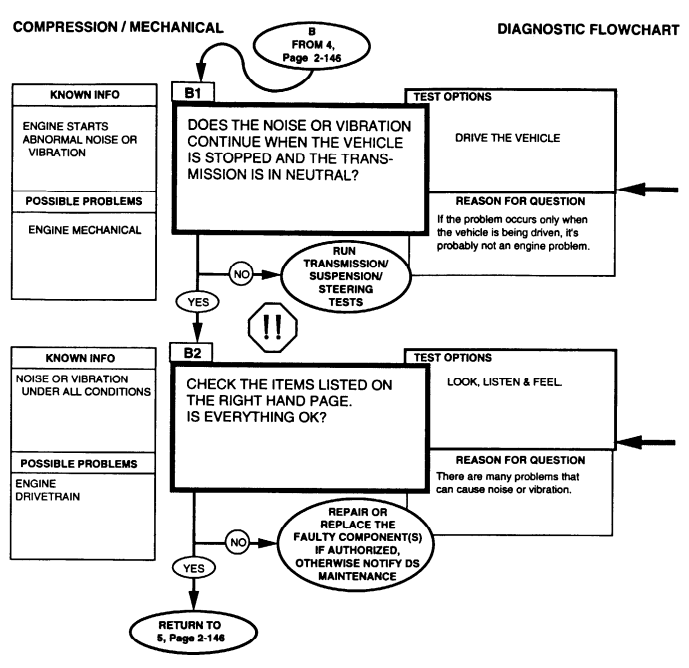
COMPRESSION / MECHANICAL Try the following steps:
-
Determine what noises or vibrations are there when the engine is running with the transmission in neutral.
-
Keep the engine running, put the transmission in drive and take note of any changes in the noises or vibrations.
-
If it's safe to drive, drive the vehicle and take note of any changes in the noises or vibrations. Drive vehicle through all gears and ranges within speed rates listed in TM 9-2320-280-10.


A hot engine may cause serious burns. Always use caution when approaching a hot engine.
Engine Mounts Transmission Mounts Cooling Fan Belts Water Pump Power Steering Pump Fuel Pump Alternator Air Induction Components Exhaust Components
Compression / Mechanical
KNOWN INFO BATTERY AND STARTER CIRCUITS OK POSSIBLE PROBLEMS ENGINE DRIVETRAIN FUEL SYSTEM INTAKE/EXHAUST KNOWN INFO BATTERY AND STARTER CIRCUITS OK AIR INTAKE/EXHAUST ОК POSSIBLE PROBLEMS ENGINE DRIVETRAIN FUEL SYSTEM KNOWN INFO BATTERY AND STARTER CIRCUITS OK AIR INTAKE/EXHAUST OK FUEL SYSTEM OK POSSIBLE PROBLEMS ENGINE DRIVETRAIN

REFERENCE INFORMATION COMPRESSION / MECHANICAL If faults are found and corrected go to STEP 2 of the GO CHAIN. If no faults are found go to B2, page 2-150.
If faults are found and corrected go to STEP 2 of the GO CHAIN. If no faults are found go to B2, page 2-150.
2-25. Engine Cooling Tests
These Engine Cooling tests may be run any time you think you have an engine cooling problem or if you were sent here by another test chain. Just follow the path, answering the questions. Additional information and notes are given on the facing page when necessary. Please note that this paragraph is NOT for diagnoses of problems with the temperature sending unit or the gauge.
Once you are sure that the cooling system is OK, run the instruments test in Paragraph 2-32 to find out if the gauge is OK.
Fold-out FO-4 contains a functional diagram of the engine cooling system. This page may be left open for reference while testing.
The engine cooling system is a pressure type cooling system with thermostatic control of coolant circulation. The cooling system dissipates heat generated from combustion and maintains the engine operating temperature at its most efficient level. When the engine is cold and the thermostat is closed, coolant is recirculated through the water pump and engine. As the engine coolant reaches 190°F (87.7°C), the thermostat opens allowing coolant to flow through the radiator before returning to the water pump and engine. Any air or vapor in the cooling system will be forced to the surge tank under the liquid level and leave through a vent tube. As the system cools, the extra coolant in the tank will be drawn back to the radiator. Normally a 50-50 mixture of water and ethylene glycol base antifreeze will be used. The fan is activated when coolant temperature reaches 215°F (102°C). A separate oil cooler is mounted in front of the radiator. This cooler is divided into two parts.
The top half is for transmission oil. The bottom half is for engine oil. When the cooling system pressure reaches approximately 15 psi (103 kPa), a valve in the surge tank cap opens and lets excess pressure escape to the atmosphere.
| model transmissions. | |
|---|---|
| 31 Biennially Tr a n s m i s s i o n | CAUTION |
| Use Dexron® II or Dexron® III for | |
| 3L80 transmission. Use only Dexron® | |
| III for 4L80-E transmission. Failure to | |
| use only Dexron® III for 4L80E | |
| transmission will cause damage to | |
| transmission. | |
| NOTE | |
| - Change fluid every 12,000 miles | |
| (19,300 km) or biennially, whichever | |
| occurs first (para. 5-2a). Inspect | |
| either 3L80 or 4L80-E transmission | |
| drainplug for metal particles. | |
| - Replace transmission oil filter each | |
| time transmission is drained. Fill |
Ethylene Glycol Mixture Table
NONE PULLEY PULLEY PULLEY

COOLANT LEVEL WATER PUMP AND ENGINE FAN BELTS WATER PUMP AND COOLANT OK THERMOSTAT ENGINE COOLING

Do not remove surge tank filler cap before releasing internal pressure when engine temperature is above 190 °F (88°C). Steam or hot coolant under pressure will cause injury.
Drain and refill coolant, refer to (para 3-60).


Do not remove surge tank filler cap before releasing internal pressure when engine temperature is above 190 °F (88°C). Steam or hot coolant under pressure will cause injury.
Fill coolant to proper level , refer to (para 3-60).

Always use caution when approaching a hot engine. Failure to do so may result in serious burns. Remove and replace the thermostat, refer to (para 3-75).

HOSES


Do not remove surge tank filler cap before releasing internal pressure when engine temperature is above 190 °F (88°C). Steam or hot coolant under pressure will cause injury. Check seal and spring on pressure cap.
Replace pressure cap, refer to (para. 3-60).
Flush cooling system, refer to (para. 3-60). For surge tank and radiator support replacement procedures, refer to (paras. 3-63 and 3-64). For oil cooler and oil cooler hose replacement procedures, refer to (paras. 3-7 and 3-8). Notify DS maintenance to repair radiators.
Engine Cooling Fan Description Of Operation
An external line from the power steering gear brings hydraulic fluid to the clutch fan solenoid through control valve (normally open) and then to the fan drive, keeping it disengaged. The action of the valve is controlled by the time delay module and the fan temperature switch.
During normal operation, the fan timer switch is closed. This keeps the control valve in the open position and the drive disengaged. As the engine reaches a temperature of 215°F (102°C), the temperature switch opens and the control valve closes. This engages the fan. If the fan is engaged and the accelerator is floored, the transmission kickdown system disengages the fan drive for 20 seconds. The easiest way to determine if the fan is engaged is to stand outside the driver's door and gently work the accelerator. If the fan is engaged, you will feel a breeze from the engine area. If the fan is not engaged, you won't feel the breeze. If the vehicle's serial number is 68555 through 72541 or 100000 through 112867, and you see ADCO stamped on top of the time delay module, replace the module with part NSN 5945-01-193-7175, refer to (para. 4-31).
ENGINE COOLING

REFERENCE INFORMATION ENGINE COOLING

Listen for noisy bearings in the water pump, or an in and out motion to the fan.
You can also check the pump and pulley by trying to move it in and out or laterally with the engine off.
Replace the water pump pulley, refer to (para 3-76).
A bad water pump needs to be replaced by DS maintenance.
Replace belts, refer to (para. 3-81, all except "A2" vehicles) (para. 3-83, "A2" vehicles) or tighten belts, refer to (para. 3-82, all except "A2" vehicles).

CONFIGURATION

REFERENCE INFORMATION ENGINE COOLING

Always use caution when approaching a hot engine. Failure to do so may result in serious burns.
Look for excessive white exhaust smoke, steam leaks in the engine compartment oil in the coolant. Other signs include excess condensation in the exhaust system, or white joints in the exhaust system. You can also feel the coolant hoses to see if they have high pressure caused by leaking combustion gasses. Also, if the glowplugs turn off very quickly after starting the engine, or if the engine overheats, or has excessive coolant consumption, you may have a head gasket problem.

REFERENCE INFORMATION ENGINE COOLING


・


Replace fan drive, refer to (para 3-78).
 A YES answer to this question means that you were not able to turn the fan by hand.
A YES answer to this question means that you were not able to turn the fan by hand.

WARNING

Keep hands and arms away from fan blades and drive belts when engine is running or serious injury may result.
See page 2-159 for a description of the operation of the fan system and an easy way to tell if it's engaged or not.
See page 2-159 for a description of the operation of the fan system and an easy way to tell if it's engaged or not.
If you know the engine is cold and the fan temperature switch is good, you can reconnect 45BB to the switch and see if the fan disengages.
Replace the switch, refer to (para 4-30).
You can also remove the switch to test it hot and cold.

-
Connect RED clip and BLACK clip to the terminations indicated in the question. RED to the first, BLACK to the second.
-
Start Test 91, 0-4500 ohms.
-
Displayed reading is in ohms. Less than 5 ohms is continuity. If the resistance is over 4500 ohms, STE/ICE displays "9.9.9.9."
-
Set the voltmeter to an ohms scale of about 1000 ohms.
-
Connect the RED and BLACK leads to the connections stated in the question.
-
Be sure to read the correct scale. Less than 5 ohms indicates continuity. For an open circuit, the meter should peg full scale (needle all the way to the left).
Engine Cooling

Reference Information Engine Cooling Continuity (Resistance) Multimeter
-
Set the voltmeter to an ohms scale of about 1000 ohms.
-
Connect the RED and BLACK leads to the connections stated in the question. 3. Be sure to read the correct scale. Less than 5 ohms indicates continuity. For an open circuit, the meter should peg full scale (needle all the way to the left).
-
Connect RED clip and BLACK clip to the terminations indicated in the question. RED to the first, BLACK to the second. 2. Start Test 91, 0-4500 ohms.
-
Displayed reading is in ohms. Less than 5 ohms is continuity. If the resistance is over 4500 ohms, STE/ICE displays "9.9.9.9."

ENGINE COOLING KNOWN INFO FAN DRIVE OK FAN DOESN'T ENGAGE VIA WIRE 458 POSSIBLE PROBLEMS FAN WIRING TIME DELAY MODULE FAN CONTROL VALVE PCB/DISTRIBUTION BOX KNOWN INFO FAN ENGAGES CONTROL VALVE OK POSSIBLE PROBLEMS WIRING KNOWN INFO FAN ENGAGES CONTROL VALVE OK POSSIBLE PROBLEMS WIRING
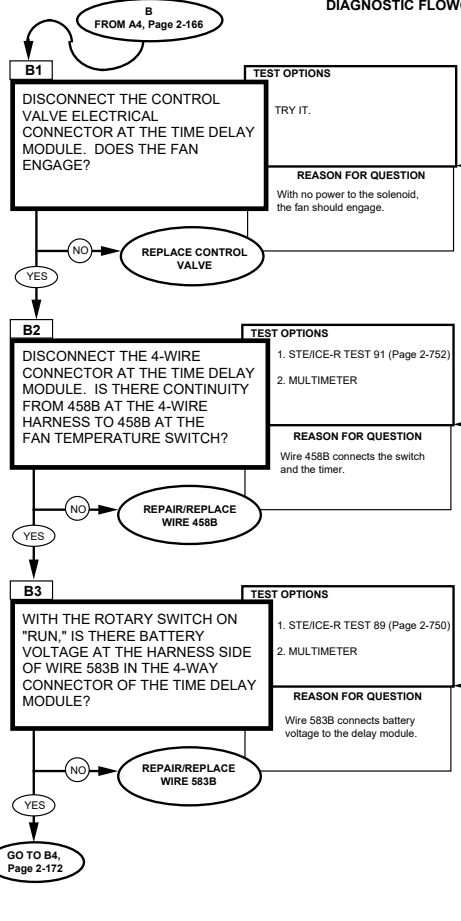

DIAGNOSTIC FLOWCHART 2-170 Change 1
Reference Information Engine Cooling 0-4500 Ohms
Steace-R Test 91
-
Connect RED clip and BLACK clip to the terminations indicated in the question. RED to the first, BLACK to the second.
-
Start Test 91, 0-4500 ohms.
-
Displayed reading is in ohms. Less than 5 ohms is continuity. If the resistance is over 4500 ohms, STE/ICE displays "9.9.9.9.9."
-
Set the voltmeter to an ohms scale of about 1000 ohms. 2. Connect the RED and BLACK leads to the connections stated in the question.
-
Be sure to read the correct scale. Less than 5 ohms indicates continuity. For an open circuit, the meter should peg full scale (needle all the way to the left).

-
Connect RED clip to the indicated test point, BLACK clip to negative or ground.
-
Start Test 89, DC volts.
-
Displayed reading is in volts.
Voltage Multimeter
-
Set the voltmeter to a DC volts scale of at least 40 volts.
-
Connect the RED lead to positive and the BLACK lead to negative.
-
Be sure to read the correct scale.



Reference Information Engine Cooling 0-4500 Ohms Steace-R Test 91 Continuity (Resistance) Multimeter
Voltage Multimeter
-
Connect RED clip and BLACK clip to the terminations indicated in the question. RED to the first, BLACK to the second.
-
Start Test 91, 0-4500 ohms.
-
Displayed reading is in ohms. Less than 5 ohms is continuity. If the resistance is over 4500 ohms, STE/ICE displays "9.9.9.9.9."
-
Set the voltmeter to an ohms scale of about 1000 ohms.
-
Connect the RED and BLACK leads to the connections stated in the question.
-
Be sure to read the correct scale. Less than 5 ohms indicates continuity. For an open circuit, the meter should peg full scale (needle all the way to the left).
-
Connect RED clip to the indicated test point, BLACK clip to negative or ground.
-
Start Test 89, DC volts.
-
Displayed reading is in volts.
-
Set the voltmeter to a DC volts scale of at least 40 volts. 2. Connect the RED lead to positive and the BLACK lead to negative.
-
Be sure to read the correct scale.
TM 9-2320-280-20-1
ENGINE COOLING C,

DIAGNOSTIC FLOWCHART KNOWN INFO DRIVE OK FAN ENGAGES BUT WON'T DISENGAGE REMOVE THE JUMPER BETWEEN WIRE 458A AND WIRE 458B. TURN THE ROTARY SWITCH TO THE "RUN" POSITION. DOES WIRE 458A HAVE BATTERY VOLTAGE?
TEST OPTIONS

REASON FOR QUESTION

POSSIBLE PROBLEMS PCB/DISTRIBUTION BOX TIME DELAY MODULE WIRING HYDRAULIC SYSTEM

KNOWN INFO DRIVE OK FAN ENGAGES BUT WON'T DISENGAGE POSSIBLE PROBLEMS PCB/DISTRIBUTION BOX TIME DELAY MODULE WIRING HYDRAULIC SYSTEM 4-WAY CONNECTOR TO WIRE 458B AT THE FAN TEMPERATURE

KNOWN INFO DRIVE OK FAN ENGAGES BUT WON'T DISENGAGE POSSIBLE PROBLEMS PCB/DISTRIBUTION BOX TIME DELAY MODULE WIRING HYDRAULIC SYSTEM
ENGINE COOLING
-
Connect RED clip to the indicated test point, BLACK clip to negative or ground.
-
Start Test 89, DC volts.
-
Displayed reading is in volts.
Voltage Multimeter
-
Set the voltmeter to a DC volts scale of at least 40 volts.
-
Connect the RED lead to positive and the BLACK lead to negative.
-
Be sure to read the correct scale.
-
Connect RED clip and BLACK clip to the terminations indicated in the question. RED to the first, BLACK to the second.
-
Start Test 91, 0-4500 ohms.
-
Displayed reading is in ohms. Less than 5 ohms is continuity. If the resistance is over 4500 ohms, STE/ICE displays "9.9.9.9."
-
Set the voltmeter to an ohms scale of about 1000 ohms.
-
Connect the RED and BLACK leads to the connections stated in the question.
-
Be sure to read the correct scale. Less than 5 ohms indicates continuity. For an open circuit, the meter should peg full scale (needle all the way to the left).


KNOWN INFO ENGINE COOLANT TEMPERATURE BELOW NORMAL (215°F) (102°C) POSSIBLE PROBLEMS TIME DELAY MODULE
ENGINE COOLING FROM

 "RUN" POSITION. MEASURE THE
VOLTAGE AT WIRE 583 ON THE
2-WAY HARNESS OF THE TIME DELAY MODULE (DO NOT
DISCONNECT HARNESS). IS THERE BATTERY VOLTAGE?
"RUN" POSITION. MEASURE THE
VOLTAGE AT WIRE 583 ON THE
2-WAY HARNESS OF THE TIME DELAY MODULE (DO NOT
DISCONNECT HARNESS). IS THERE BATTERY VOLTAGE?

REASON FOR QUESTION WIRE 583 SHOULD INDICATE KNOWN INFO ENGINE COOLANT TEMPERATURE BELOW NORMAL (215°F) (102°C) POSSIBLE PROBLEMS TIME DELAY MODULE
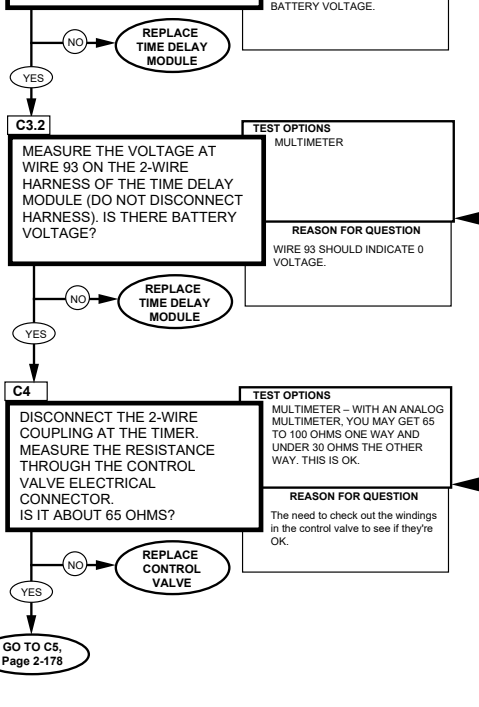


KNOWN INFO FAN DRIVE OK FAN WON'T DISENGAGE POSSIBLE PROBLEMS TIME DELAY MODULE WIRING CONTROL VALVE HYDRAULIC SYSTEM DIAGNOSTIC FLOWCHART 2-176 Change 1 REFERENCE INFORMATION ENGINE COOLING

Replace time delay module, refer to (para. 4-31).
Replace time delay module, refer to (para. 4-31).
When checking coil resistance, use an analog type multimeter.
For an accurate ohms reading, perform this check when the system is at room temperature. Heat will increase resistance, resulting in a higher ohms reading.
Replace the control valve, refer to (para. 8-26).
-
Set the voltmeter to an ohms scale of about 1000 ohms. 2. Connect the RED and BLACK leads to the connections stated in the question.
-
Be sure to read the correct scale. Less than 5 ohms indicates continuity. For an open circuit, the meter should peg full scale (needle all the way to the left).

2-178 ENGINE COOLING Repair wire refe to (para. 4-85) or notify DS maintenance.
Replce the time delay rnodule, refer to (para 4-31).
-
Connect RED clip and BLACK clip to the terminations indicated in the question. RED to the first, BLACK to the second. 2. Start Test 91, 0-4500 ohms.
-
Displayed reading is in ohms. Less than 5 ohms is continuity. If the resistance is over 4500 ohms, STE/lCE displays "9.9.9.9."
-
Set the voltmeter to an ohms scale of about 1000 ohms. 2. Connect the RED and BLACK leads to the connections stated in the question.
-
Be sure to read the correct scale. Less than 5

ohms indicates continuity. For an open circuit the meter should peg full scale (needle all the way to the Ieft).
Replace the time delay module, refer to (para 4-31).
I I

REFERENCE INFORMATION ENGINE COOLING

Replace hoses, refer to (para 8-26).
STE/ICE-R TEST #50

0 TO 1000 PSIG PRESSURE
-
Connect transducer to valve after removing connector, refer to (para 8-26). Do offset test.
-
Connect BLUE pressure transducer to A W4 cable. Make sure the system under testis not pressurized.
-
Turn on system and read pressure.
Measure the pressure at the valve outlet. Remove the fan drive hose and connector from the valve body and screw transducer into the valve. Start the engine and look for leaks.
Replace control valve and/or fan drive, refer to (para 8-26 or 3-78). Check to sea if hoses are blocked prior to replacing parts, and perform back flush procedure (para 8-26).
If pressure in the fan drive hose is not at least 90 psi, (620.5 kPa) perform back flush procedure (para 8-26).
Recheck pressure. If pressure is not at least 90 psi, replace control valve. If pressure in the fan drive hose is at least 90 psi, (620.5 kPa) check for blockage in hose between the control valve and fan drive. If hose is not blocked, replace fan drive (para. 3-78).
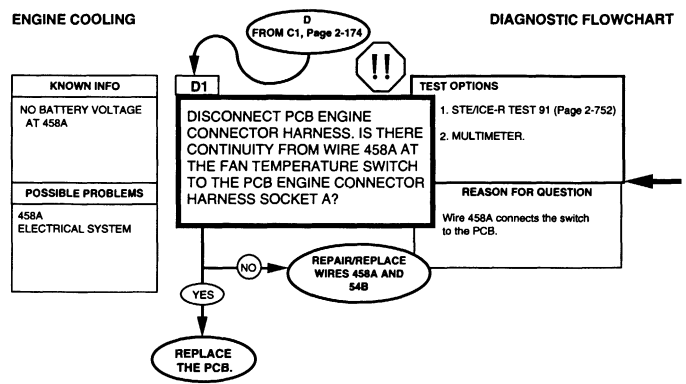
ENGINE COOLING

DISCONNECT NEGATIVE BATTERY CABLE BEFORE DISCONNECTING AND RECONNECTING PROTECTIVE CONTROL BOX HARNESS.
There is battery voltage at the PCB at all times.
Failure to disconnect battery cable will result in damage to equipment or injury to personnel.
Replace PCB, refer to (para 4-5).
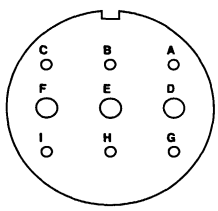
-
Connect RED dip and BLACK clip to the terminations indicated in the question. RED to the first, BLACK to the second.
-
Start Teat 91,0-4500 ohms. 3. Displayed reading is in ohms. Leas than 5 ohms is continuity. If the resistance is over 4500 ohms, STE/ICE displays "9.9.9.9."
-
Set the voltmeter to an ohms scale of about 1000 ohms.
-
Connect the RED and BLACK leads to the connections stated in the question. 3. Be sure to read the correct scale. Leas than 5
 ohms indicates continuity. For an open circuit, the meter should peg full scale (needle all the way to the left).
ohms indicates continuity. For an open circuit, the meter should peg full scale (needle all the way to the left).

ENGINE COOLING Replace time delay module, refer to (para 4-31).
0-45 DC VOLTS STE/lCE-R TEST 89 1. Connect RED clip to the indicated test point, BLACK clip to negative or ground.
- Start Test 89, DC volts. 3. Displayed reading is in volts.
Voltage Multimeter
-
Set the voltmeter to a DC volts scale of at least 40 volts. 2. Connect the RED lead to positive and the BLACK lead to negative.
-
Be sure to read the correct scale.

2-26. Engine Lubrication Tests I
These Engine Lubrication tests may be run any time there is an engine lubrication problem or if you were sent here by another test chain. Just follow the path, answering the questions. Additional information and notes are given on the facing page when necessary.
Fold-out page FO-5 shows the location of the major components of the Engine Lubrication system in case you are not familiar with them. This page may be left open for reference while testing.


Incorrect oil level and type can cause pressure problems, leaks, excessive blowby, and other problems.
Inspect the oil cooler, oil cooler supply return lines, CDR valve hoses, oil pan, and oil filter. Test CDR valve, (para. 3-9). See the location on parts page to find these parts.
Engine Rpm
Ste/Ice-R Test 10
- Start Test 10, Engine RPM. 2. Crank or start the engine. Displayed reading is RPM. Cranking RPM should be approximately 200. Idle RPM should be 625-675.
| OIL PRESSURE CHART | |
|---|---|
| ENGINE RPM | APPROXIMATE OIL PRESSURE |
| STOP | 0 PSI |
| 6.2L IDLE (650 ± 25) | 10-15 PSI |
| 6.5L IDLE (700 ± 25) | 10-15 PSI |
| 6.5L DETUNED | |
| IDLE (700 ± 25) | 10-15 PSI |
| 2000 | 40-50 PSI |
Remove sending unit, refer to (para. 4-25).
Engine Rpm Interleave With 0-1000 Psi Pressure
-
Connect BLUE Transducer in place of oil pressure sending unit. Dial test 50 (0-1000 psi). Perform offset test.
-
Dial test 01, interleave with RPM.
Dial test 50.
- Start engine and observe display.
VTM will display RPM's, then PSI.

ENGINE LUBRICATION DIAGNOSTIC FLOWCHART

No faults found. If you still have a problem, you may want to re-run the test chain to make sure you didn't miss anything.
TM 9-2320-280-20-1
ENGINE LUBRICATION NOTE If the exhaust is not colorless it must be either white, blue or black.
If exhaust color is: WHITE. . . . . . . . . .Go to fuel system, Paragraph 2-22. Could be injector timing, DS level fault. BLUE. . . . . . . . . . . .Blue smoke is a sign of oil entering the combustion chambers. It usually enters past the piston rings or intake valve stem seals. This is an internal engine problem that can't be handled at this level of maintenance. You may want to run the Engine Mechanical Tests, Paragraph 2-18 before you notify DS Maintenence.
BLACK. . . . . . . . . Intake/exhaust. Para. 2-23

GAUGE SENDER WIRING
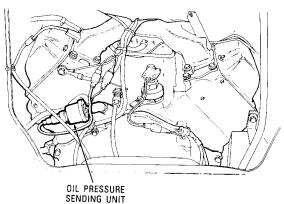
REFERENCE INFORMATION ENGINE LUBRICATION
| OIL PRESSURE CHART | |
|---|---|
| APPROXIMATE OIL PRESSURE ENGINE RPM | |
| STOP | 0 PSI |
| 6.2L IDLE (650 ± 25) | 10-15 PSI |
| 6.5L IDLE (700 ± 25) | 10-15 PSI |
| 6.5L DETUNED | |
| IDLE (700 ± 25) | 10-15 PSI |
| 2000 | 40-50 PSI |
Remove sending unit, refer to (para. 4-25)
Engine Rpm Interleave With 0-1000 Psi Pressure
-
Connect BLUE Transducer in place of oil pressure sending unit. Dial test 50 (0-1000 psi). Perform offset test.
-
Dial test 01, interleave with RPM.
Dial test 50.
- Start engine and observe display.
VTM will display RPM's, then PSI.
2-27. Alternator Tests
These Alternator tests can be run any time you think there may be a problem with the alternator or battery charging or if you were sent here from another system chain.
These tests are NOT for the batteries. These tests are strictly for the alternator, its operation, and its associated wiring. Tests for the batteries are in Battery Circuit, Paragraph 2-29.
A simplified block diagram for the alternator system is given on page 2-195. A detailed functional flow schematic is provided as foldout FO-6 to help you understand the system as you perform the tests.
Note
Dual voltage 100, 200, and 400 amp alternators can be installed in a single voltage system. See Table 2-2 for hookup procedures.
After preliminary common tests, the model of alternator must be identified for specific testing to determine if alternator or regulator is defective.
| Dry System 10 qt (9.5 L) | |
|---|---|
| (INC. oil cooler) | |
| 3/4 Water | |
| 3/5 Water |
Table 2-2. Adaption of dual voltage alternator on a single voltage system

ALTERNATOR KNOWN INFO NOTHING POSSIBLE PROBLEMS ALTERNATOR PROTECTIVE CONTROL BOX/DISTRIBUTION BOX WIRING BELTS KNOWN INFO

POSSIBLE PROBLEMS WIRING ALTERNATOR PCB/DISTRIBUTION BOX KNOWN INFO BELTS OK WIRING CONNECTIONS OK POSSIBLE PROBLEMS ALTERNATOR PCB/DISTRIBUTION BOX WIRING
Note
Cracks, glaze, and frays indicate worn belts, which should be replaced (para. 3-81, all except M1123 and "A2" vehicles) (para. 3-83, M1123 and "A2" vehicles). Use a belt tension gauge to determine if the belts need to be tightened, refer to (para 3-82, all except M1123 and "A2" vehicles).
BAD CONNECTIONS ARE THE MOST COMMON PROBLEM !
Sometimes just disconnecting, cleaning, and reconnecting will solve a problem. BE THOROUGH! The time you save may be your own. Refer to the functional flow schematic and check the following; 1. BATTERY - make sure all connections are clean and tight, including the shunt and power stud. 2. STARTER - check the high current (heavy gauge wire 6A) wire at the starter. Don't just check for voltage; a loose connection will have voltage but can't carry much current. 3. PCB/DISTRIBUTION BOX

Disconnect negative battery cable before disconnecting and reconnecting PCB/distribution box harness.
There is battery voltage at the PCB/distribution box at all times. Failure to disconnect battery cable will result in damage to equipment or injury to personnel.
Unscrew BOTH connectors and look for bent or broken pins, pins pushed out of their socket, or dirt and corrosion in the connections.
Interleave Tests 67 And 89 Battery Voltage And Dc Voltage
USE CONTROL FUNCTION 06 TO INTERLEAVE TESTS ON THE STE/ICE-R. DIAL 06, PRESS THE TEST BUTTON. WHEN PROMPTED BY THE VTM, DIAL IN TEST 67 AND PRESS THE BUTTON. WHEN PROMPTED AGAIN, DIAL IN TEST 89 AND PRESS THE BUTTON. VTM WILL DISPLAY RESULT FOR TEST 67, THEN 89 THEN 6789, AND THEN REPEAT. SEE TM 9-4910-571-12&P FOR MORE INFORMATION.
ALTERNATOR

ALTERNATOR BELTS OK ALTERNATOR CONNECTIONS OK OK ALTERNATOR ALTERNATOR DRIVE WIRING BATTERIES OK BELTS OK ALTERNATOR CONNECTIONS OK OK ALTERNATOR WIRING BATTERIES OK BELTS OK ALTERNATOR CONNECTIONS OK ALTERNATOR OUTPUT OK ALTERNATOR WIRING

2-198 Change 1 POSSIBLE PROBLEMS POSSIBLE PROBLEMS PCB/DISTRIBUTION BOX PCB/DISTRIBUTION BOX ALTERNATOR DRIVE OK PCB/DISTRIBUTION BOX OK ALTERNATOR DRIVE OK
Reference Information Alternator
If the engine doesn't start on its own power, you should check the battery
And Starter Circuits.Notes On Idle Adjustment
If idle can be adjusted to within limits, go to step 5. If idle CANNOT be adjusted to within limits, you may have a problem with the fuel system. You can either continue here or run the fuel system tests and return here.
Engine Rpm Ste/Ice-R Test 10
-
Start Test 10, Engine RPM. 2. Crank or start the engine. Displayed reading is RPM. Cranking RPM should be at least 100. Idle RPM should be 625 - 675.
-
Connect RED clip to the indicated test point, BLACK clip to negative or ground. 2. Start Test 89, DC volts.
-
Displayed reading is in volts.
Notes
Check the wiring and the pins at sockets E & F at PCB/distribution box engine connector.
Check the wiring and the pins at sockets D & G at PCB/distribution box body connector. Check and clean starter solenoid and battery box power stud. Check and clean battery cables and clamps. Look for loose, dirty, or broken connections and repair as necessary. If terminal voltage is still low, harness should be replaced. Notify DS maintenance.
Battery Voltage Ste/Ice-R Test 67
- Start Test 67, battery voltage. 2. Displayed reading is in volts. Batteries should be 23-25.5 volts. Battery voltage will drop when glowplugs turn on.
Note
A charged battery in good condition is a prerequisite for testing an alternator/regulator system. If battery is suspect, substitute a known good battery in the vehicle. Output for 60 amp alternator is wire 5A and stud. All other alternators have a large stud on side of housing as output terminal to connect wire 6.
ALTERNATOR KNOWN INFO BELTS OK ALTERNATOR CONNECTIONS OK PROTECTIVE CONTROL BOX/DISTRIBUTION BOX OK ALTERNATOR DRIVE OK ALTERNATOR OUTPUT OK POSSIBLE PROBLEMS ALTERNATOR

IF YOU STILL HAVE A PROBLEM, RERUN THESE TESTS TO MAKE SURE YOU DIDN'T MISS ANYTHING. IF EVERYTHING CHECKS OUT, RUN BATTERY TESTS AND ELECTRICAL TESTS.
REFERENCE INFORMATION ALTERNATOR NOTE Wire 5A is output path for 60 amp alternator. All other alternators have large stud on alternator case as output connector for wire 6. Alternator current will go up as you turn on vehicle accessories. Turn on the lights, wipers, heater, etc. to make sure alternator can supply enough current to power the loads. To replace 60 and 200 amp alternators, (refer to chapter 4). To replace 100 amp alternator, (refer to chapter 12). To replace 100, 200, and 400 amp dual voltage alternators, (refer to chapter 4).
Battery Current
STE/ICE-R TEST 80 1. Start Test 80, battery current. 2. Displayed reading is in amps. The reading will be greater than 30 amps, depending on how many accessories you have on.
ALTERNATOR KNOWN INFO BATTERY IS NOT CON- NECTED TO ALTERNATOR WHEN ROTARY SWITCH IS IN RUN POSITION POSSIBLE PROBLEMS PCB/DISTRIBUTION BOX WIRING
Known Info
BATTERY IS NOT CON- NECTED TO ALTERNATOR WHEN ROTARY SWITCH IS IN RUN POSITION, BATTERIES CONNECTED TO STARTER POSSIBLE PROBLEMS PCB/DISTRIBUTION BOX WIRING
Known Info
BATTERY IS NOT CON- NECTED TO ALTERNATOR WHEN ROTARY SWITCH IS IN RUN POSITION, BATTERIES CONNECTED TO STARTER POSSIBLE PROBLEMS PCB/DISTRIBUTION BOX WIRING

Reference Information Alternator Interleave Test 67 And 68. Battery Voltage And Dc Voltage
USE CONTROL FUNCTION 06 TO INTERLEAVE TESTS ON THE STE/ICE-R. DIAL 06, PRESS THE TEST BUTTON. WHEN PROMPTED BY THE VTM, DIAL IN TEST 67 AND PRESS THE BUTTON. WHEN PROMPTED AGAIN, DIAL IN TEST 68 AND PRESS THE BUTTON. VTM WILL DISPLAY RESULT FOR TEST 67, THEN 68 THEN 6768, AND THEN REPEAT. SEE TM 9-4910-571-12&P FOR MORE INFORMATION.

DISCONNECT NEGATIVE BATTERY CABLE BEFORE DISCONNECTING AND RECONNECTING PROTECTIVE CONTROL BOX/DISTRIBUTION BOX HARNESS.
There is battery voltage at the PCB/distribution box at all times. Failure to disconnect battery cable will result in damage to equipment or injury to personnel.
Note
When checking for voltage or continuity in a harness connector (steps A2 and A3), check the wiring at the connector carefully for broken wires. Check to see that the connector pins are not bent, broken, or pushed out of place. Check that the connections are clean and tight. Use the STE/ICE-R in TK mode for this measurement. DO NOT USE THE DCA. Leave the negative battery cable off for the measurement. If there is an open circuit, the STE/ICE-R will measure close to 500 ohms. If you don't have continuity or voltage, and the wires and connections are all ok, then the harness must have a broken wire. In this case you have to replace the wiring harness. Replace harness, notify DS Maintenance. Replace PCB, refer to (para. 4-5). Replace distribution box, refer to (para. 4-5.1).
Interleave Test 67 And 89. Battery Voltage And Dc Voltage
USE CONTROL FUNCTION 06 TO INTERLEAVE TESTS ON THE STE/ICE-R. DIAL 06, PRESS THE TEST BUTTON. WHEN PROMPTED BY THE VTM, DIAL IN TEST 67 AND PRESS THE BUTTON. WHEN PROMPTED AGAIN, DIAL IN TEST 89 AND PRESS THE BUTTON. VTM WILL DISPLAY RESULT FOR TEST 67, THEN 89 THEN 6789, AND THEN REPEAT. SEE TM 9-4910-571-12&P FOR MORE INFORMATION.
- Connect RED clip and BLACK clip to the terminations indicated in the question. RED to the first, BLACK to the second. 2. Start Test 91, 0-4500 ohms. 3. Displayed reading is in ohms. Less than 5 ohms is continuity. If the resistance is over 4500 ohms, STE/ICE displays "9.9.9.9".

CORRECT CORRECT CORRECT WIRING ALTERNATOR
Note
For 60 amp Prestolite alternator, continue B. For 100 amp Prestolite alternator, go to C, page 2-208. For 200 amp Prestolite alternator, go to D, page 2-212. For 200 amp single voltage Niehoff alternator, go to E, page 2-218. For 100 amp single voltage Niehoff alternator, go to F, page 2-222. For 100 amp dual voltage Niehoff alternator, go to F.1, page 2-224.2. For 200 amp dual voltage Niehoff alternator, go to G, page 2-224.6. For 400 amp dual voltage Niehoff alternator, go to H, page 2-224.10.
Note
Voltage on wire 568 signals regulator to turn on.
Without voltage, regulator can't operate. Wire 568A is connected with wire 5A inside engine wire harness. If there is no loose end on wire 568A, wire harness repair is required. Notify DS Maintenance.
0-45 DC VOLTS STE/ICE-R TEST 89 1. Connect RED clip to indicated test point, BLACK clip to negative or ground.
-
Start Test 89, DC volts.
-
Displayed reading is in volts.


Reference Information Alternator
- Turn engine off. 2. Remove protective cover from alternator wiring. 3. Remove the potting material. 4. Remove hex head plug to expose adjustment screw. 5. Start engine and lock throttle at 1200-1500 RPM by using STE/ICE-R test 10. 6. Connect the Red test lead to wire 5A and the Black lead to engine ground. 7. Monitor alternator output voltage with STE/ICE-R test 89. 8. Use a cross tip screwdriver to adjust the alternator output voltage 28.0 ± 0.5 Volts. 9. Unlock throttle, replace hex head plug, repot the area with silicon caulk, and replace the protective cover.
Engine Rpm
STE/ICE-R TEST 10 1. Start Test 10, Engine RPM. 2. Crank or start the engine. Displayed reading is RPM. Cranking RPM should be approximately 100. Idle RPM should be 625-675.
-
Connect RED clip to the indicated test point, BLACK clip to negative or ground.
-
Start Test 89, DC volts.
-
Displayed reading is in volts.
NOTE Regulator cannot be tested independently from alternator on 60 amp alternator system.


Reference Information Alternator
Note
For 60 amp Prestolite alternator, go to B, page 2-204. For 100 amp Prestolite alternator, continue C. For 200 amp Prestolite alternator, go to D, page 2-212. For 200 amp single voltage Niehoff alternator, go to E, page 2-218.
For 100 amp single voltage Niehoff alternator, go to F, page 2-222. For 100 amp dual voltage Niehoff alternator, go to F.1, page 2-224.2.
For 200 amp dual voltage Niehoff alternator, go to G, page 2-224.6. For 400 amp dual voltage Niehoff alternator, go to H, page 2-224.10.
Note
Voltage on wire 568 signals regulator to turn on. Without voltage, regulator can't operate. Wire 568A is connected with wire 5A inside engine wire harness. If there is no loose end on wire 568A, wire harness repair is required. Notify DS Maintenance.
| 0-45 DC VOLTS |
|---|
| STE/ICE-R TEST 89 |
| 1. Connect RED clip to the indicated test point, |
| BLACK clip to negative or ground. |
| 2. Start Test 89, DC volts. |
| 3. Displayed reading is in volts. |

ALTERNATOR DIAGNOSTIC FLOWCHART

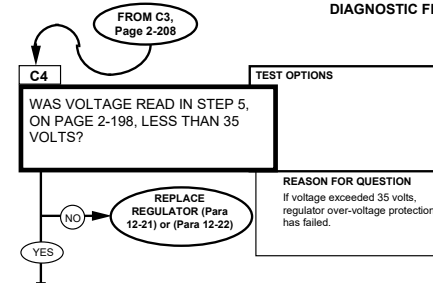
KNOWN INFO VOLTAGE OUTPUT INCORRECT WIRING OR IGNITION OK POSSIBLE PROBLEMS ALTERNATOR REGULATOR KNOWN INFO VOLTAGE OUTPUT INCORRECT WIRING OR IGNITION OK POSSIBLE PROBLEMS ALTERNATOR REGULATOR C5
 WITH REGULATOR REMOVED FROM
WITH REGULATOR REMOVED FROM

ALTERNATOR, PERFORM FULL-FIELD TEST. START ENGINE AND SET SPEED TO 850 RPM. CONNECT A JUMPER WIRE FROM PIN E ON ALTERNATOR TO GROUND.
MOMENTARILY WIRE JUMPER FROM PIN D TO BATTERY VOLTAGE.
MEASURE VOLTAGE AT ALTERNATOR OUTPUT. DID VOLTAGE RISE TO AT

REPLACE REGULATOR (Para 12-21) or (Para 12-22) TEST OPTIONS
-
STE/ICE-R Tests 10 and 89 (pages 2-734 and 2-750).
-
MULTIMETER

REASON FOR QUESTION Determine if alternator or regulator is defective.
Caution
Ensure all electrical loads are disconnected or turned off. Higher voltage could damage components in other devices.
-
Disconnect battery ground cable.
-
Loosen screws.
-
Remove clamp pins from slots.
-
Loosen connector nut. 5. Remove regulator from alternator.
Secure regulator out of the way. 6. Connect battery ground cable.
Note
Jumper wires must be able to handle 15 amp current (14 gauge or larger diameter).
NOTE Multimeter set to read over 75 vdc.
Engine Rpm Ste/Ice-R Test 10
-
Start Test 10, Engine RPM.
-
Crank or start the engine. Displayed reading is RPM. Cranking RPM should be approximately 100. Set idle speed to 850 RPM.
-
Connect RED clip to indicated test point, BLACK clip to negative or ground.
-
Start Test 89, DC volts.
-
Displayed reading is in volts.

Reference Information Alternator
Note
For 60 amp Prestolite alternator, go to B, page 2-204. For 100 amp Prestolite alternator, go to C, page 2-208. For 200 amp Prestolite alternator, continue D. For 200 amp single voltage Niehoff alternator, go to E, page 2-218. For 100 amp single voltage Niehoff alternator, go to F, page 2-222.
For 100 amp dual voltage Niehoff alternator, go to F.1, page 2-224.2.
For 200 amp dual voltage Niehoff alternator, go to G, page 2-224.6. For 400 amp dual voltage Niehoff alternator, go to H, page 2-224.10.
Replacement Of Reverse Polarity Fuse
-
Remove nut, lockwasher, washer, fuse, insulator and cable 6 from output stud.
-
Examine fuse for burns and breaks. Replace fuse and insulator if damaged. 3. Install new fuse and insulator on output stud with washer, lockwasher, and nut. Tighten nut 10-15 lb-in. (14-20 N•m).
-
Disconnect battery ground cable. 2. Remove four screws, lockwashers, gasket, and cover from regulator. 3. Remove potting material as necessary to gain access to studs.
-
Connect RED clip to the indicated test point, BLACK clip to negative or ground. 2. Start Test 89, DC volts. 3. Displayed reading is in volts.

Alternator
Temperature-Environment Adjustment
-
Disconnect battery ground cable. 2. Remove four screws securing regulator to alternator.
-
Position regulator to allow access to the buss bar link. The buss bar link and voltage setting terminals are located under sealant. It maybe necessary to scrape away some of the sealant to access the buss bar link and terminals.
-
To adjust the voltage setting to 27.2 volts (for hot or desert condition), loosen screw E0 and remove screws E1 and E2. Rotate bus bar link to E2. Reinstall screws E1 and E2 and tighten screw E0.
-
Apply RTV sealant to fully cover buss bar link and voltage setting terminals. 6. Install regulator to alternator with four screws. 7. Connect battery ground cable.
-
Check output voltage, it should read 27.2 volts.
Note
To reset alternator output voltage to 28 volts, the buss bar link should be connected between E0 and E1. The terminal connection E0 and E3 provides an output voltage of 28.8 volts (for arctic conditions). When operation in hot weather or arctic conditions cease, the alternator output voltage should be reset to its normal 28.0 volt setting.
- Mark the output voltage setting on the alternator and annotate the information in the vehicle log book for future reference. NOTE This procedure resets the alternator output approximately 0.8 volts on either side of 28 volts, but will not correct for larger errors.
NOTE If an overcharge condition exists, wiring to regulator is satisfactory.
Engine Rpm Ste/Ice-R Test 10
-
Start test 10, Engine RPM.
-
Crank or start the engine. Displayed reading is RPM. Engine RPM should be 850.
-
Connect RED clip to the indicated test point, BLACK clip to negative or ground.
-
Start Test 89, DC volts. 3. Displayed reading is in volts.


Reference Information Alternator
Full Field Test
- Disconnect battery ground cable.
Note
Tag leads before removal.
-
Remove five screws, lockwashers, and leads from bottom of regulator. 3. Insulate leads from V,P, and Z terminals.
-
Connect 6 volt lantern battery NSN 6135-00-643-1310, (or equivalent that can supply 1.0 amp current at 6 volts) with (+) battery and lead connector to W lead and (-) battery and lead connector to Y lead. Insulate all connections. 5. Monitor voltage across alternator output studs. Meter must be capable of reading 50 volts.
Caution
Ensure all vehicle and on board equipment are turned off. Higher voltages could damage components.
-
Connect battery ground cable.
-
Start vehicle and run engine to 900 rpm. Run only long enough to obtain a stable output voltage reading. 8. Stop engine, remove 6 volt battery and leads.
Note
If installing alternator, reconnect regulator (para 4-114).
0-45 Dc Volts Ste/Lce-R Test 89
-
Connect RED clip to the indicated test point, BLACK clip to negative or ground.
-
Start Test 89, DC volts. 3. Displayed reading is in volts.
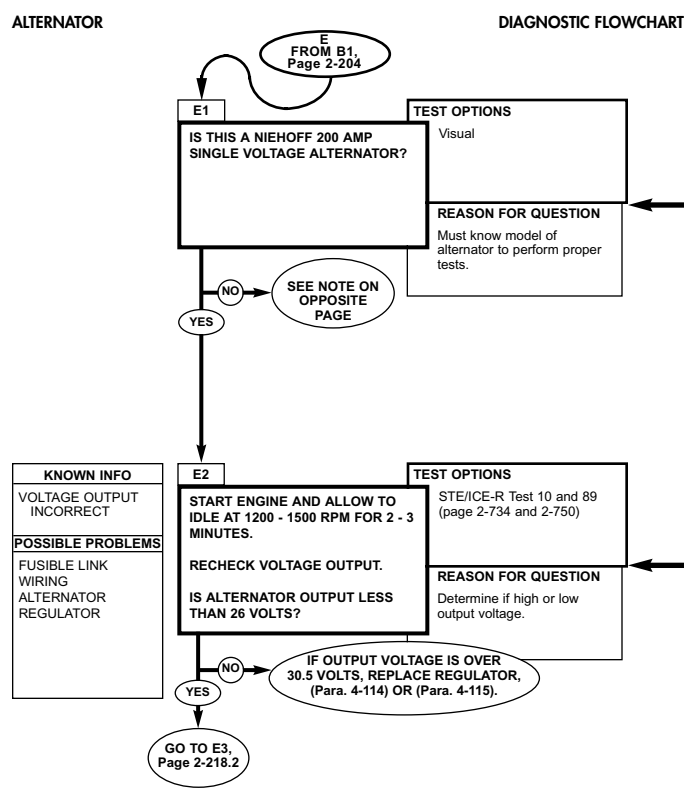
Reference Information Alternator
Note
For 60 amp Prestolite alternator, go to B, page 2-204. For 100 amp Prestolite alternator, go to C, page 2-208. For 200 amp Prestolite alternator, go to D, page 2-212. For 200 amp single voltage Niehoff alternator, continue with E. For 100 amp single voltage Niehoff alternator, go to F, page 2-222. For 100 amp dual voltage Niehoff alternator, go to F.1, page 2-224.2. For 200 amp dual voltage Niehoff alternator, go to G, page 2-224.6. For 400 amp dual voltage Niehoff alternator, go to H, page 2-224.10.
Note
The regulator for this model alternator has overvoltage protection. Any output voltage over 30.5 volts is an overvoltage. Output voltage of 26 - 30.5 is acceptable for this alternator.
Engine Rpm Ste/Ice-R Test 10
-
Start Test 10, Engine RPM. 2. Crank or start the engine. Displayed reading is RPM. Engine RPM should be 1200 - 1500.
-
Connect RED clip to the indicated test point, BLACK clip to negative or ground.
-
Start Test 89, DC volts. 3. Displayed reading is in volts.

Reference Information Alternator
NOTE Wire 6 connects alternator output stud to starter terminal. A poor connection at these points will cause a low or no alternator output condition.
Fusible Link Replacement
-
Disconnect battery ground cable. 2. Remove boot from alternator output terminal. 3. Remove nut, lockwasher, washers, and fusible link from terminal.
-
Inspect fusible link. 5. Replace fusible link if damaged or appears burned.
-
Connect battery ground cable.

VOLTAGE OUTPUT INCORRECT FUSIBLE LINK OK ALTERNATOR VOLTAGE OUTPUT INCORRECT REGULATOR HAS ENERGIZING VOLTAGE FUSIBLE LINK OK ALTERNATOR REGULATOR REPLACE REGULATOR (Para. 4-114). THEN GO TO STEP 5, Page 2-198.
REGULATOR WIRING

Reference Information Alternator
-
Slide boot back from wire lug to expose red terminal.
-
Make contact at stud.
-
Connect RED clip to the indicated test point, BLACK clip to negative or ground.
-
Start Test 89, DC Volts. 3. Displayed reading is in volts.
Engine Rpm Ste/Ice-R Test 10
- Start Test 10, Engine RPM. 2. Crank or start the engine. Displayed reading is RPM. Set engine to fast idle of 1200 - 1500 RPM.
0-1500 Amps Dc Ste/Ice-R Test 90
- Connect probe. 2. Start Test 90, DC amps. 3. Displayed reading is in amps.

Reference Information Alternator
Note
For 60 amp Prestolite alternator, go to B, page 2-204. For 100 amp Prestolite alternator, go to C, page 2-208. For 200 amp Prestolite alternator, go to D, page 2-212. For 200 amp single voltage Niehoff alternator, continue with E. For 100 amp single voltage Niehoff alternator, continue with F. For 100 amp dual voltage Niehoff alternator, go to F.1, page 2-224.2. For 200 amp dual voltage Niehoff alternator, go to G, page 2-224.6. For 400 amp dual voltage Niehoff alternator, go to H, page 2-224.10.
NOTE The regulator for this model alternator has overvoltage protection. Any output voltage over 30.5 volts is an overvoltage. Output voltage of 25-30.5 is acceptable for this alternator.
Engine Rpm Ste/Ice-R Test 10
-
Start Test 10, Engine RPM.
-
Crank or start the engine. Displayed reading is RPM. Engine RPM should be 1200 - 1500.
-
Connect RED clip to the indicated test point, BLACK clip to negative or ground.
-
Start Test 89, DC Volts. 3. Displayed reading is in volts.
Note
Voltage on wire 568 signals regulator to turn on. Without voltage, regulator can't operate. Wire 568A is connected with wire 5A inside engine wire harness. If there is no loose end on wire 568A, wire harness repair is required.
KNOWN INFO VOLTAGE OUTPUT INCORRECT REGULATOR HAS ENERGIZING VOLTAGE POSSIBLE PROBLEMS ALTERNATOR REGULATOR WIRE NO YES KNOWN INFO F5 VOLTAGE OUTPUT INCORRECT REGULATOR HAS ENERGIZING VOLTAGE POSSIBLE PROBLEMS ALTERNATOR REGULATOR AMPS?
YES REPLACE REGULATOR, (Para. 12-22). THEN GO TO STEP 5, Page 2-198.
ALTERNATOR DIAGNOSTIC FLOWCHART

CONNECT WIRE 568A AND 568. DISCONNECT WIRE 568 FROM ALTERNATOR. TURN ROTARY SWITCH TO "RUN". MEASURE VOLTAGE AT ALTERNATOR END OF WIRE. IS THERE VOLTAGE AT BATTERY END OF WIRE 568?
DISCONNECT ALTERNATOR-TO- REGULATOR CABLE. START ENGINE AND SET IDLE 1200-1500 RPM. USING 15 AMP CAPACITY JUMPER WIRE, MOMENTARILY CONNECT PIN A OF ALTERNATOR CONNECTOR TO ENGINE GROUND. DOES CURRENT RISE DURING CONNECTION TO 90-110 NO
Reference Information Alternator
-
Slide boot back from wire lug to expose red terminal.
-
Make contact at stud.
0-45 Dc Volts
Ste/Ice-R Test 89
-
Connect RED clip to the indicated test point, BLACK clip to negative or ground.
-
Start Test 89, DC Volts. 3. Displayed reading is in volts.
Engine Rpm Ste/Ice-R Test 10
- Start Test 10, Engine RPM. 2. Crank or start the engine. Displayed reading is RPM. Set engine to fast idle of 1200 - 1500 RPM.
0-1500 Amps Dc Ste/Ice-R Test 90
- Connect probe. 2. Start Test 90, DC amps. 3. Displayed reading is in amps.

Reference Information Alternator
NOTE For 60 amp Prestolite alternator, go to B, page 2-204.
For 100 amp Prestolite alternator, go to C, page 2-208.
For 200 amp Prestolite alternator, go to D, page 2-212.
For 200 amp single voltage Niehoff alternator, go to E, page 2-218. For 100 amp single voltage Niehoff alternator, go to F, page 2-222.
For 100 amp dual voltage Niehoff alternator, continue with F.1.
For 200 amp dual voltage Niehoff alternator, go to G, page 2-224.6. For 400 amp dual voltage Niehoff alternator, go to H, page 2-224.10.
NOTE The regulator for this model alternator has overvoltage protection. Any output voltage over 30.5 volts is an overvoltage.
Output voltage of 26-30.5 is acceptable for this alternator.
NOTE The regulator for this alternator has overvoltage protection. Any output voltage over 30.5 volts is an overvoltage.
Output voltage of 26-30.5 is acceptable for this alternator.
ENGINE RPM STE/ICE-R TEST 10 1. Start test 10, Engine RPM.
- Crank or start the engine. Displayed reading is RPM. Engine RPM should be 1200-1500.
0-1,500 Amps Dc
STE/ICE-R TEST 90 1. Connect probe.
- Start Test 90, DC amps. 3. Displayed reading is in amps.
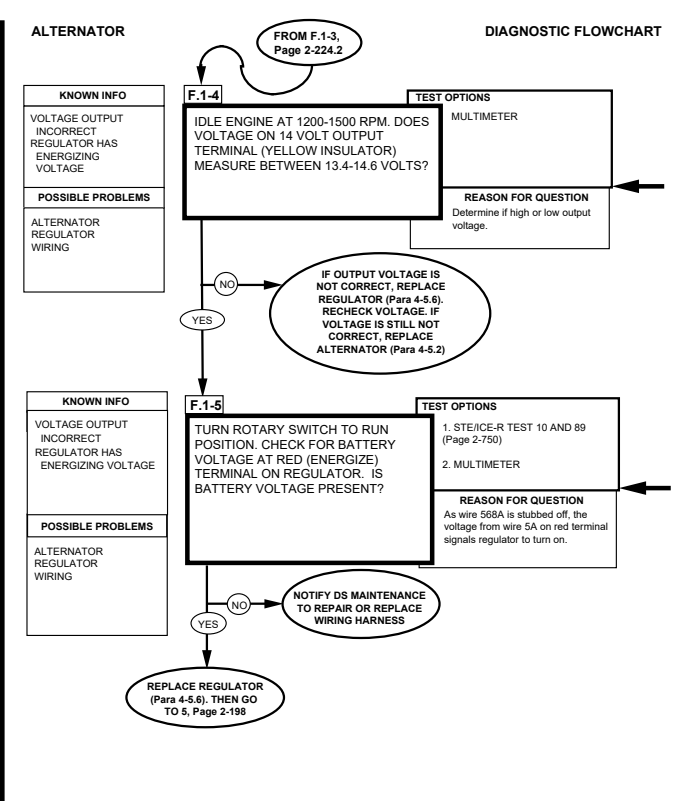

Reference Information Alternator
-
Slide boot back from wire lug to expose red terminal.
-
Make contact at stud.
| 0-45 DC VOLTS |
|---|
| STE/ICE-R TEST 89 |
-
Connect RED clip to the indicated test point, BLACK clip to negative or ground. 2. Start Test 89, DC Volts.
-
Displayed reading is in volts.

Reference Information Alternator
NOTE For 60 amp Prestolite alternator, go to B, page 2-204. For 100 amp Prestolite alternator, go to C, page 2-208.
For 200 amp Prestolite alternator, go to D, page 2-212.
For 200 amp single voltage Niehoff alternator, go to E, page 2-218. For 100 amp single voltage Niehoff alternator, go to F, page 2-222.
For 100 amp dual voltage Niehoff alternator, go to F.1, page 2-224.2.
For 200 amp dual voltage Niehoff alternator, continue with G. For 400 amp dual voltage Niehoff alternator, go to H, page 2-224.10.
NOTE The regulator for this model alternator has overvoltage protection. Any output voltage over 30.5 volts is an overvoltage.
Output voltage of 26-30.5 is acceptable for this alternator.
NOTE The regulator for this alternator has overvoltage protection. Any output voltage over 30.5 volts is an overvoltage.
Output voltage of 26-30.5 is acceptable for this alternator.
ENGINE RPM STE/ICE-R TEST 10 1. Start test 10, Engine RPM. 2. Crank or start the engine. Displayed reading is RPM. Engine RPM should be 1200-1500.
-
Connect RED clip to the indicated test point, BLACK clip to negative or ground.
-
Start Test 89, DC Volts. 3. Displayed reading is in volts.
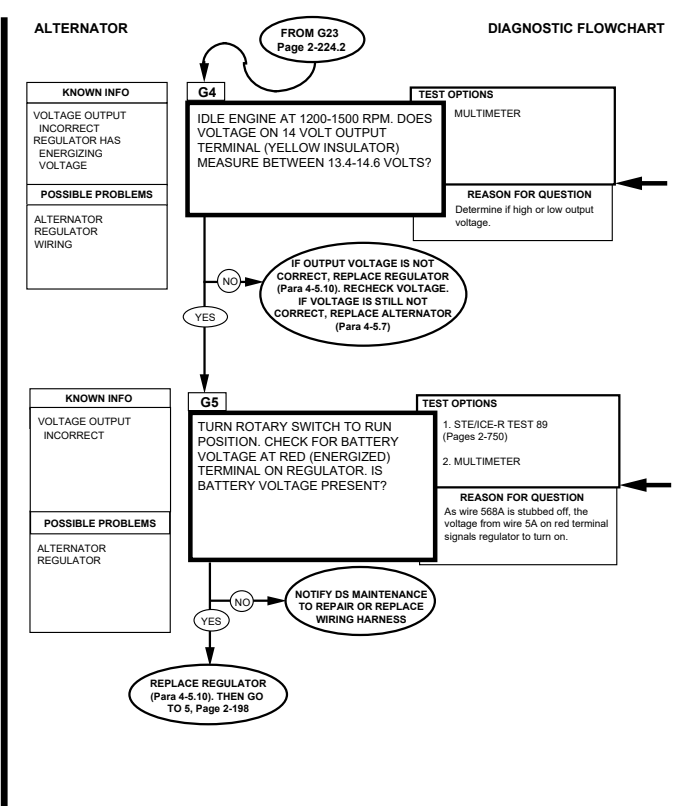

REFERENCE INFORMATION ALTERNATOR
-
Slide boot back from wire lug to expose red terminal.
-
Make contact at stud.
| 0-45 DC VOLTS | STE/ICE-R TEST 89 |
|---|
-
Connect RED clip to the indicated test point, BLACK clip to negative or ground.
-
Start Test 89, DC volts.
-
Displayed reading is in volts.

Reference Information Alternator
NOTE For 60 amp Prestolite alternator, go to B, page 2-204.
For 100 amp Prestolite alternator, go to C, page 2-208.
For 200 amp Prestolite alternator, go to D, page 2-212. For 200 amp single voltage Niehoff alternator, go to E, page 2-218.
For 100 amp single voltage Niehoff alternator, go to F, page 2-222.
For 100 amp dual voltage Niehoff alternator, go to F.1, page 2-224.2. For 200 amp dual voltage Niehoff alternator, continue with G.
For 400 amp dual voltage Niehoff alternator, go to H, page 2-224.10.
NOTE The regulator for this model alternator has overvoltage protection. Any output voltage over 30.5 volts is an overvoltage. Output voltage of 26-30.5 is acceptable for this alternator.
NOTE The regulator for this alternator has overvoltage protection. Any output voltage over 30.5 volts is an overvoltage. Output voltage of 26-30.5 is acceptable for this alternator.
ENGINE RPM STE/ICE-R TEST 10 1. Start test 10, Engine RPM. 2. Crank or start the engine. Displayed reading is RPM. Engine RPM should be 1200-1500.
-
Connect RED clip to the indicated test point, BLACK clip to negative or ground. 2. Start Test 89, DC Volts.
-
Displayed reading is in volts.


Reference Information Alternator
-
Slide boot back from wire lug to expose red terminal.
-
Make contact at stud.
0-45 DC VOLTS STE/ICE-R TEST 89 1. Connect RED clip to the indicated test point, BLACK clip to negative or ground. 2. Start Test 89, DC Volts.
- Displayed reading is in volts.
Engine Rpm
STE/ICE-R TEST 10 1. Start Test 10, Engine RPM.
- Crank or start the engine. Displayed reading is RPM. Set engine to fast idle of 1200-1500 RPM.
0-1500 AMPS DC STE/ICE-R TEST 90 1. Connect probe.
2-28. Protective Control Box/Distribution Box Tests
This protective control box /distribution box test can be run any time you think there may be a problem with the protective control box or distribution box, or if you were sent here from another system chain.
Note
-
To perform PCB/distribution box diagnostics, a PCB test module is needed.
-
For fabrication of PCB/distribution box test module, refer to Appendix D, Figs. 96-113, or requesitioned with NSN 6625-01-440-4522.
PROTECTIVE CONTROL BOX/DISTRIBUTION BOX DIAGNOSTIC FLOWCHART

Reference Information Protective Control Box/Distribution Box
- Remove instrument panel, refer to (para. 4-12). 2. Remove nut and lockwasher assembly and engine harness ground lead 3C from body.
Remove nut and lockwasher assembly , capscrew, and harness ground leads 57A and 79A from body. Discard nut and lockwasher assemblies. 3. Inspect and clean wires and connection points. 4. Apply antiseize compound to harness ground leads 57A and 79A and install on body with capscrew and nut and lockwasher assembly. Apply antiseize compound to engine harness ground lead 3C and install on body with nut and lockwasher assembly. 5. Cover leads 3C, 57A, and 79A with RTV.

Protective Control Box/Distribution Box Diagnostic Flowchart

DISCONNECT THE BODY AND ENGINE WIRING HARNESS CANNON PLUGS FROM PROTECTIVE CONTROL BOX/DISTRIBUTION BOX.
NOTE: THE DISTRIBUTION BOX HAS AN ADDITIONAL GLOWPLUG HARNESS.

CONNECT DIAGNOSTIC TEST MODULE HARNESS RECEPTACLE AND CONNECTORS TO BODY AND ENGINE WIRING HARNESS CANNON PLUGS.

REFERENCE INFORMATION PROTECTIVE CONTROL BOX/DISTRIBUTION BOX

Disconnect negative battery cable before disconnecting and reconnecting protective control box/distribution box harness. Failure to do so may result in injury to personnel or damage to equipment.
Protective Control Box/Distribution Box
DIAGNOSTIC FLOWCHART KNOWN INFO NOTHING POSSIBLE PROBLEMS BATTERIES BAD LEAD 57B BAD GROUND PARKING BRAKE SWITCH BAD BODY HARNESS WIRES BAD GLOWPLUG CONTROLLER BAD ALTERNATOR BAD HARNESS WIRE 2A BAD IGNITION SWITCH BAD HARNESS WIRE 29A BAD HARNESS WIRE 29C BAD PROTECTIVE CONTROL BOX/ DISTRIBUTION BOX BAD KNOWN INFO BATTERIES OK POSSIBLE PROBLEMS LEAD 57B BAD GROUND PARKING BRAKE SWITCH BAD BODY HARNESS WIRES BAD ALTERNATOR BAD HARNESS WIRE 2A BAD IGNITION SWITCH BAD HARNESS WIRE 29A BAD HARNESS WIRE 29C BAD PROTECTIVE CONTROL BOX/ DISTRIBUTION BOX BAD KNOWN INFO BATTERIES OK POSSIBLE PROBLEMS LEAD 57B BAD GROUND PARKING BRAKE SWITCH BAD BODY HARNESS WIRES BAD ALTERNATOR BAD HARNESS WIRE 2A BAD IGNITION SWITCH BAD HARNESS WIRE 29A BAD HARNESS WIRE 29C BAD PROTECTIVE CONTROL BOX/ DISTRIBUTION BOX BAD

NOTE This analyzer requires all glow plugs be serviceable and the batteries fully charged in order to operate properly. Prior to performing diagnostic checks ensure these two items are checked. If either of these two items are found to be faulty, repair/replace prior to beginning checks. Failure to do so will cause the analyzer to give false readings, therefore causing the needless replacement of serviceable components.

Disconnect negative battery cable before disconnecting and reconnecting protective control box/distribution box harness. Failure to do so may result in injury to personnel or damage to equipment. Replace protective control box, refer to (para. 4-5). Replace distribution box, refer to (para. 4-5.1).
Repair lead connectors, refer to (para.
4-85). Repair lead, refer to (para. 4-85).
Reference Information Protective Control Box/Distribution Box
| VERIFY THE CONDITION OF EACH OF THESE SYSTEMS. |
|---|
| 2-251 |
| 2-303 |
| 2-261 |
| 2-95 |
| 2-137 |
| 2-143 |
Protective Control Box/Distribution Box
DIAGNOSTIC FLOWCHART

Reference Information Protective Control Box/Distribution Box
NOTE This analyzer requires all glow plugs be serviceable and the batteries fully charged in order to operate properly. Prior to performing diagnostic checks ensure these two items are checked. If either of these two items are found to be faulty, repair/replace prior to beginning checks. Failure to do so will cause the analyzer to give false readings, therefore causing the needless replacement of serviceable components.
Repair lead connectors, refer to (para. 4-85).
Repair lead, refer to (para. 4-85).
WARNING

Disconnect negative battery cable before disconnecting and reconnecting protective control box/distribution box harness. Failure to do so may result in injury to personnel or damage to equipment. Replace protective control box, refer to (para. 4-5).
Replace distribution box, refer to (para. 4-5.1).
| PROTECTIVE CONTROL BOXINS IRIBUTION BOX | |
|---|---|
| DIAGNOSTIC CHECKS | |
| (GO TASKS) | |
| (For Vehicles with protective control box/distribution box) | |
| OFF | |
| LED's 1, 3, 4, 6, 7, "ON"; Remaining LED's "OFF" If all LED's are "OFF", battery power is not available. If LED 3 or 4 is "OFF", replace the PCB/distribution box. | |
| RUN - (PCB) | If LED 7 is "OFF", body harness wire 57B is not grounded. |
| LED's 1,2,3,4,5,6,7,8,11,13 "ON". LED 13 "OFF" after a few seconds (glow plug warm up time). | |
| (ENGINE | LED 13 "OFF if engine is at operating temperature. |
| NOT RUNNING- | LED 11 cycling "OÑ" and "OFF" (glow plug controller operatlon) LED's 9, 10, 12 "OFF". |
| РСВ) | Release parking brake lever. LED 6 "OFF". |
| Engage parking brake lever. LED 6 "ON". If all LED's are "OFF", no battery power is available. If LED 3 or 4 is "OFF", no battery power is available. If LED 7 is "OFF", and a | |
| If LED 2 is "OFF", and all glow plugs are serviceable, replace the PCB. If LED 5 is "OFF", replace the PCB is LED 13 is "ON". | |
| lf LED's 5 and 13 are "OFF", the ignition switch is defective and/or harness | |
| wires 29A and 29C are defective. If LED 13 is "OFF" aud LED 5 is "ON" and the engine is not at operating | |
| temperature from a previous run, replace the PCB. The PCB is operational | |
| if the engine is at operating temperature trom a previous run. If LED 6 is "OFF" and the parking brake lever is engaged the parking brake | |
| switch is defective or the wires in the body harness are defective | |
| lf LED 8 is "OFF", replace the PCB. If LED 11 is "OFF", check the glow plug controller. If the glow plug | |
| controller is functioning properly, replace the PCB. | |
| RUN - (Distribution Box) | LED's 1, 2, 3, 4, 5, 6, 7, 8,13 "ON"; remaining LED's "OFF" LED 13 "OFF" after a few seconds (glow plug warm up time). |
| (ENGINE NOT | LED 13 "OFF" if engine is at operating temperature. |
| RUNNING- | LED 6 "OFF if parking brake lever is released. |
| Distribution Box) | LED 6 "OF" if parking brake lever is rengaood. LED 6 "ON" if parking brake lever is engaged. If LED 2, 3, 4, or 8 is "OFF", replace distribution box. If LED 7 is "OFF", hody |
| If LED 7 is "OFF" If LED 7 is "OFF", body harness wire 57B is not grounded If LED 5 is "OFF", replace distribution box if LED 13 is "ON" | |
| If LED's 5 and 13 are "OFF", the ignition switch and/or harness wires 29A | |
| and 29C are defective. | |
| If LED 13 is "OFF" and LED 5 is "ON", and engine is not at operating temperature from a previous run, replace distribution box. Distribution box | |
| is operation if engine is at operating temperature from a previous run. | |
| If LED 6 is "OFF"and the parking brake lever is engaged the parking brake | |
| switch and/or the wires in the body harness are defective. | |
| START | LED 10 momentarily "ON" and then remains "OFF" (starter motor |
| ENGINE | frequency lockout). |
| CRANKING- | If LED 11 and 13 remain "ON" or engine does not crank; check battery |
| РСВ) | voltage; charge is low. |
| If LED 10 does not momentarily come "ON" and then stays "OFF", replace РСВ. | |
| START | LED 10 momentarily "ON". |
| (ENGINE | If LED 13 is "ON or engine does not crank; check battery voltage; charge is ow. |
| CRANKING- | If LED 10 does not momentarily come "ON" and then stays "OFF", and |
| Distribution | ignition |
| Box) | switch is operating properly, replace distribution box. |
| RUN (ENGINE | LED's 1,2,3,4,5,6,7,8,9,12 "ON" LED 11 cycling "ON" and "OFF" (glow plug controller operation): "OFF" |
| RUNNING- | time interval increases as engine warms up. |
| РСВ) | LED 11 "OFF" (when engine is at operating temperature). |
| LED 11 may remain "OFF" (when engine is at operating temperature from | |
| prevlous run). | |
| LED 13 "OFF" | |
| Release parking brake lever. LED 6 "OFF". Engage parking brake lever. LED 6 "ON" | |
| If LED 2, 3, 4, 5, or 8 is "OFF" and all glow plugs are serviceable replace the | |
| РСВ. If LED 7 is "OFF", the body harness wire 57B is not grounded. | |
| If LED 9 is "OFF" and LED 12 is "ON", replace the PCB. | |
| If LED's 9 and 12 are "OFF", there is no alternator output (alternating | |
| current tap) available and/or the engine harness wire 2A is defective. | |
| If LED 11 is "OFF" and the engine is not at operating temperature, check the glow plug controller. If the glow plug controller is functioning properly, | |
| replace the PCB. | |
| RUN | LED's 1, 2, 3, 4, 5, 6, 7, 8, 12 "ON", remaining LED's "OFF" LED 6 "OFF" if parking brake lever is released. |
| (ENGINE | |
| RUNNING- | LED 6 "ON" if parking brake lever is released |
| Distribution Box) | lf LED's 2, 3, 4, 5 or 8 is "OFF" replace distribution box. lf LED 7 is "OFF", body harness wire 57B is not grounded lf LED 12 is "OFF", there is no alternator output (alter |
| available and/or engine harness wire 2A is defective. |
Protective Control Box/Distribution Box
KNOWN INFO BATTERIES OK LEAD 57B GROUND OK

POSSIBLE PROBLEMS PARKING BRAKE SWITCH BAD BODY HARNESS WIRES BAD GLOWPLUG CONTROLLER BAD ALTERNATOR BAD HARNESS WIRE 2A BAD IGNITION SWITCH BAD HARNESS WIRE 29A BAD HARNESS WIRE 29C BAD PROTECTIVE CONTROL BOX/ DISTRIBUTION BOX BAD KNOWN INFO BATTERIES OK LEAD 57B GROUND OK IGNITION SWITCH OK HARNESS WIRE 29A OK HARNESS WIRE 29C OK POSSIBLE PROBLEMS PARKING BRAKE SWITCH BAD BODY HARNESS WIRES BAD GLOW PLUG CONTROLLER BAD ALTERNATOR BAD HARNESS WIRE 2A BAD PROTECTIVE CONTROL BOX BAD PARKING BRAKE SWITCH BAD BODY HARNESS WIRES BAD GLOWPLUG CONTROLLER BAD ALTERNATOR BAD HARNESS WIRE 2A BAD PROTECTIVE CONTROL BOX/ DISTRIBUTION BOX BAD
Known Info
BATTERIES OK LEAD 57B GROUND OK IGNITION SWITCH OK HARNESS WIRE 29A OK HARNESS WIRE 29C OK POSSIBLE PROBLEMS PARKING BRAKE SWITCH BAD BODY HARNESS WIRES BAD GLOWPLUG CONTROLLER BAD ALTERNATOR BAD HARNESS WIRE 2A BAD PROTECTIVE CONTROL BOX/ DISTRIBUTION BOX BAD TEST OPTIONS 1.TRY IT DID LED 13 COME "ON" WITH PCB?

REFERENCE INFORMATION PROTECTIVE CONTROL BOX/DISTRIBUTION BOX

Disconnect negative battery cable before disconnecting and reconnecting protective control box/distribution box harness. Failure to do so may result in injury to personnel or damage to equipment. Replace protective control box, refer to (para. 4-5). Replace distribution box, refer to (para. 4-5.1).
Repair lead connectors, refer to (para. 4-85). Repair leads, refer to (para. 4-85).
Protective Control Box/Distribution Box
DIAGNOSTIC FLOWCHART KNOWN INFO BATTERIES OK LEAD 57B GROUND OK IGNITION SWITCH OK HARNESS WIRE 29A OK HARNESS WIRE 29C OK PARKING BRAKE SWITCH OK BODY HARNESS WIRES OK POSSIBLE PROBLEMS GLOWPLUG CONTROLLER BAD ALTERNATOR BAD HARNESS WIRE 2A BAD PROTECTIVE CONTROL BOX/ DISTRIBUTION BOX BAD
Known Info
BATTERIES OK LEAD 57B GROUND OK IGNITION SWITCH OK HARNESS WIRE 29A OK HARNESS WIRE 29C OK PARKING BRAKE SWITCH OK BODY HARNESS WIRES OK POSSIBLE PROBLEMS GLOWPLUG CONTROLLER BAD ALTERNATOR BAD HARNESS WIRE 2A BAD PROTECTIVE CONTROL BOX/ DISTRIBUTION BOX BAD KNOWN INFO BATTERIES OK LEAD 57B GROUND OK IGNITION SWITCH OK HARNESS WIRE 29A OK HARNESS WIRE 29C OK PARKING BRAKE SWITCH OK BODY HARNESS WIRES OK GLOWPLUG CONTROLLER OK POSSIBLE PROBLEMS ALTERNATOR BAD HARNESS WIRE 2A BAD PROTECTIVE CONTROL BOX/ DISTRIBUTION BOX BAD

Reference Information Protective Control Box/Distribution Box

Disconnect negative battery cable before disconnecting and reconnecting protective control box or distribution box harness. Failure to do so may result in injury to personnel or damage to equipment. Replace protective control box, refer to (para. 4-5). Replace distribution box, refer to (para. 4-5.1).
Replace glowplug controller. refer to (para. 4-29).
Service/repair batteries. refer to (para. 4-79).
Protective Control Box/Distribution Box
DIAGNOSTIC FLOWCHART
PROTECTIVE CONTROL BOX/ DISTRIBUTION BOX BAD

Page 2-242 KNOWN INFO POSSIBLE PROBLEMS PARKING BRAKE SWITCH OK BODY HARNESS WIRES OK HARNESS WIRE 29A OK HARNESS WIRE 29C OK PARKING BRAKE SWITCH OK BODY HARNESS WIRES OK PROTECTIVE CONTROL BOX/ DISTRIBUTION BOX BAD POSSIBLE PROBLEMS HARNESS WIRE 29A OK HARNESS WIRE 29C OK PARKING BRAKE SWITCH OK BODY HARNESS WIRES OK LEAD 57B GROUND BAD HARNESS WIRE 2A BAD PROTECTIVE CONTROL BOX/ DISTRIBUTION BOX BAD POSSIBLE PROBLEMS BATTERIES OK LEAD 57B GROUND OK IGNITION SWITCH OK HARNESS WIRE 29A OK HARNESS WIRE 29C OK ALTERNATOR BAD HARNESS WIRE 2A BAD BATTERIES OK LEAD 57B GROUND OK IGNITION SWITCH OK ALTERNATOR BAD HARNESS WIRE 2A BAD BATTERIES OK IGNITION SWITCH OK ALTERNATOR BAD
Reference Information Protective Control Box/Distribution Box

Disconnect negative battery cable before disconnecting and reconnecting protective control box or distribution box harness. Failure to do so may result in injury to personnel or damage to equipment. Replace protective control box, refer to (para. 4-5).
Replace distribution box, refer to (para. 4-5.1).

Disconnect negative battery cable before disconnecting and reconnecting protective control box or distribution box harness. Failure to do so may result in injury to personnel or damage to equipment. Replace protective control box, refer to (para. 4-5). Replace distribution box, refer to (para. 4-5.1).
Repair lead connectors, refer to (para. 4-85). Repair leads, refer to (para. 4-85).
Protective Control Box/Distribution Box
KNOWN INFO BATTERIES OK LEAD 57B GROUND OK IGNITION SWITCH OK HARNESS WIRE 29A OK HARNESS WIRE 29C OK PARKING BRAKE SWITCH OK BODY HARNESS WIRES OK GLOWPLUG CONTROLLER OK POSSIBLE PROBLEMS ALTERNATOR BAD HARNESS WIRE 2A BAD PROTECTIVE CONTROL BOX/ DISTRIBUTION BOX BAD


REASON FOR QUESTION If this LED condition does not exist, that would indicate a protective control box (PCB)/distribution box malfunction.
Known Info
BATTERIES OK LEAD 57B GROUND OK IGNITION SWITCH OK HARNESS WIRE 29A OK HARNESS WIRE 29C OK PARKING BRAKE SWITCH OK BODY HARNESS WIRES OK GLOWPLUG CONTROLLER OK POSSIBLE PROBLEMS TEST OPTIONS VISUAL ARE LEDs 9 AND 12 "ON"?
NOTE: LED 9 DOES NOT FUNCTION WITH DISTRIBUTION BOX. IF LED 12 IS ON, GO TO 27,

REASON FOR QUESTION If these LEDs are OFF, that would indicate a malfunctioning alternator or damaged harness wire 2A.
ALTERNATOR BAD HARNESS WIRE 2A BAD PROTECTIVE CONTROL BOX/ DISTRIBUTION BOX BAD KNOWN INFO 24 BATTERIES OK LEAD 57B GROUND OK IGNITION SWITCH OK HARNESS WIRE 29A OK HARNESS WIRE 29C OK PARKING BRAKE SWITCH OK BODY HARNESS WIRES OK ALTERNATOR OK HARNESS WIRE 2A OK POSSIBLE PROBLEMS GLOWPLUG CONTROLLER BAD PROTECTIVE CONTROL BOX/ DISTRIBUTION BOX BAD WHILE ENGINE IS NOT AT OPERATING TEMPERATURE, IS LED 11 "ON"?
NOTE: LED 11 DOES NOT FUNCTION WITH DISTRIBUTION BOX.
TEST OPTIONS VISUAL

REASON FOR QUESTION If this LED is not ON, that would indicate a glowplug controller malfunction.
Reference Information Protective Control Box/Distribution Box

Disconnect negative battery cable before disconnecting and reconnecting protective control box or distribution box harness. Failure to do so may result in injury to personnel or damage to equipment. Replace protective control box, refer to (para. 4-5). Replace distribution box, refer to (para. 4-5.1).
Repair lead connectors, refer to (para. 4-85). Repair leads, refer to (para. 4-85).
Repair glowplug controller, refer to (para. 4-29).
Protective Control Box/Distribution Box

HARNESS WIRE 29A OK HARNESS WIRE 29C OK ALTERNATOR OK HARNESS WIRE 2A OK PROTECTIVE CONTROL BATTERIES OK LEAD 57B GROUND OK IGNITION SWITCH OK ALTERNATOR OK HARNESS WIRE 2A OK BATTERIES OK LEAD 57B GROUND OK IGNITION SWITCH OK OK BOX BAD OK BAD

REFERENCE INFORMATION PROTECTIVE CONTROL BOX/DISTRIBUTION BOX

Disconnect negative battery cable before disconnecting and reconnecting protective control box/distribution box harness. Failure to do so may result in injury to personnel or damage to equipment. Replace protective control box, refer to (para. 4-5).
PROTECTIVE CONTROL BOX/DISTRIBUTION BOX DIAGNOSTIC FLOWCHART




DISCONNECT BODY AND ENGINE WIRING HARNESS CANNON PLUGS FROM DIAGNOSTIC TEST MODULE.
DISCONNECT CONNECTORS FROM PROTECTIVE CONTROL BOX/DISTRIBUTION BOX.
30 CONNECT BODY AND ENGINE WIRING HARNESS CANNON PLUGS TO PROTECTIVE CONTROL BOX/DISTRIBUTION BOX.
CONNECT BATTERY GROUND CABLE.
REFERENCE INFORMATION PROTECTIVE CONTROL BOX/DISTRIBUTION BOX

Disconnect negative battery cable before disconnecting and reconnecting protective control box or distribution box harness. Failure to do so may result in injury to personnel or damage to equipment.
TM 9-2320-280-20-1 PROTECTIVE CONTROL BOX/DISTRIBUTION BOX DIAGNOSTIC FLOWCHART

IF LED 5 IS "ON," REPLACE PROTECTIVE CONTROL BOX/DISTRIBUTION BOX, OR REPAIR/REPLACE IGNITION SWITCH AND/OR HARNESS WIRES 29A AND 29C.
REFERENCE INFORMATION PROTECTIVE CONTROL BOX/DISTRIBUTION BOX Replace protective control box, refer to (para. 4-5). Replace distribution box, refer to (para. 4-5.1). Repair/replace rotary switch, refer to (para. 4-7). Repair/replace leads 29A and 29C, refer to (para. 4-85).
2-29. Battery Circuit Test 1
These Battery Circuit tests maybe run any time you think you have a battery problem of if you were sent here by another test chain. Just follow the path, answering the questions. Additional information and notes are given on the facing page when necessary.
The fold-out page shows the location of the major components of the Battery Circuit in case you are not familiar with them.
Fold-out page FO-7 may be left open for reference while testing.

BATTERY CIRCUIT BAD COMMECTIONS ARE THE WOST COMWON BHOBLEM T Sometimes, just disconnecting, cleaning and reconnecting will solve a problem. BE THOROUGH ! The time you save may be your own.
Refer to the functional flow schematic and check the following; 1. BATTERY - make sure all connections are clean and tight.
This includes the interconnect cables, clamps, shunt, power stud and the slave connector. Also check wires 6A and 7A under vehicle where they enter shunt.
- STARTER - check the high current (heavy gauge) wire at the starter. Don't just check for voltage; a loose connection will have voltage but can't carry much current.
Battery Voltage Steace-R Test 67
-
Start Test 67, battery voltage.
-
Displayed reading is in volts. Batteries should be 23-25.5 volts. Batteries voltage will drop when glowplugs turn on.
There is a ring inside the battery fill plugs. The water level should be at the ring.


Battery Circuit
These tests check the strength of the batteries during engine cranking. lf you don't have STE/lCE-R, skip this step, but remember that you haven't tested the batteries under load.
Battery Internal Resistance Ste/Ice-R Test 73
-
Disconnect wire 54A at injection pump to prevent stating. 2. Disconnect glowplug controller and fan solenoid.
-
Start Test 73, battery internal resistance. 4. Waif for the GO massage. Crank the engine. 5. Result is displayed in milliohms. Battery resistance should be 25 milliohms max.
Battery Resistance Change Ste/Lce-R Test 75
- Disconnect wire 54A at injection pump to prevent starting. 2. Disconnect glowplug controller and fan solenoid. 3. Start Test 75, battery resistance change. 4. Wait for the GO message. Crank the engine. 5. Result is displayed in milliohms/second.
Battery resistance change should be 50 milliohms/second max.
- Connect RED dip to the indicated test point, BLACK clip to negative or ground. 2. Start Test 89, DC Volts. 3. Displayed reading is in volts.
Starter Neg. Cable Voltage Drop Ste/Ice-R Test 69
- Start Test 69, starter negative cable voltage drop. 2. Displayed reading is in volts. The cable voltage drop should be less than 0.25 volts maximum.

CABLES CABLES BATTERIES ALTERNATOR
BATTERY CIRCUIT Measure from the positive poet to the negative poet of each battery.
For battery replacement instructions, refer to (para. 4-79).
Note
Check these cables: WIRE 68, connecting the batteries together. Test point is the postive terminal of one of the batteries. WIRE 49A, connecting the batteries to the power stud. Test point is the power stud. Wire connecting the battery to the shunt. Test point is the shunt.
Wire connecting shunt to ground stud. Test point is the shunt.
For repair or replacement of cables, refer to (para. 4-73).
If you use STE/lCE-R test 67 in Step 3 on page 2-252, you may have a faulty DCA. Try running the tests using STE/lCE-R test 89 with the W2 cable. Sea paragraph 4-79. (Also check each battery's specific gravity in accordance with TM 9-6140-200-14.) Replace battery refer to (para. 4-79).
0-45 DC VOLTS STE/lCE-R TEST 89 1. Connect RED clip to the indicated test point, BLACK cIip to negative or ground. 2. Start Test 89, DC volts. 3. Displayed reading is in volts.

Battery Circuit
KNOWN INFO BATTERY RESISTANCE NO GOOD POSSIBLE PROBLEMS BATTERIES CABLES KNOWN INFO BATTERIES OK POSSIBLE PROBLEMS CABLES

NO FAULTS FOUND.
(IF YOU USED TESTS 73 & 75 IN STEP 4, P. 2-254, YOU MAY HAVE A PROBLEM WITH THE DCA.
CHECK THE DCA CONNECTIONS AND TRY RUNNING STEP 4 USING TESTS 77 & 79.) SEE NOTE TO RIGHT.
BATTERY CIRCUIT
Battery Internal Resistance Ste/Ice-R Test 73
-
Disconnect wire 54A at injection pump to prevent starting. 2. Disconnect glowplug controller and fan solenoid (to keep waveform clean).
-
Start Test 73, battery internal resistance. 4. Wait for the GO message. Crank the engine. 5. Result is displayed in milliohms. Battery resistance should be 25 milliohms max.
Replace batteries, refer to (para 4-79).
Note
Check these cables WIRE 68, correcting the batteries together. Test point is the positive terminal of one of the batteries.
WIRE 49A, connecting the battery to the power stud. Test point is the power stud.
Wire connecting the battery to the shunt. Test point is the negative terminal of the battery.
Wire connecting shunt to ground stud.
Test point is the shunt.
Replace batteries, refer to (para 4-79).
Note
Tests 77 and 79 are TK tests that do the same thing that DCA tests 73 and 75 do.
See TM 9-4910-571-12&P for instructions on how to run these tests.
Battery Resistance Change Ste/Ice-R Test 75
-
Disconnect wire 54A at injection pump to prevent starting. 2. Disconnect glowplug controller and fan solenoid (to keep waveform dean).
-
Start Test 75, battery resistance change.
-
Wait for the GO message. Crank the engine.
-
Result is displayed in milliohms/second. Battery resistance change should be 50 milliohms/second max.
-
Connect RED clip to the indicated test point, BLACK dip to negative or ground. 2. Start Test 89, DC volts. 3. Displayed reading is in volts.
2-30. Starter Circuit Tests
Starter Circuit Without Starter Lockout

General Description
The Starter Circuit consists of the batteries, starter solenoid, starter motor, rotary switch, neutral safety switch, protective control box/distribution box, and related electrical wiring. The relationship of these parts is shown in the block diagram above, and a simplified functional flow schematic is provided on the foldout FO-8.
The starter solenoid and starter motor are enclosed in housings to protect them from dirt, icing conditions, and other road hazards.
When the rotary switch is turned to "START," the starter solenoid is energized. The solenoid contacts close, sending battery power to the starter motor. The battery power causes the starter motor pinion gear to engage the engine flywheel ring gear and the engine cranks. When the engine starts, the rotary switch should be released, allowing it to return to the "RUN" position. This deenergizes the starter solenoid which, in turn, disengages the starter motor from the engine.
Solenoid current flows from the rotary switch through the neutral safety switch and protective control box/distribution box to the solenoid.
STARTER CIRCUIT ENGINE WON'T CRANK OR CRANKS SLOWLY POSSIBLE PROBLEMS WIRING BATTERIES STARTER SOLENOID ROTORY SWITCH ENGINE LOCKED PCB/DISTRIBUTION BOX KNOWN INFO CABLES & CONNECTORS APPEAR OK POSSIBLE PROBLEMS WIRING BATTERIES STARTER/SOLENOID ROTARY SWITCH ENGINE LOCK PCB/DISTRIBUTION BOX

KNOWN INFO STARTER CIRCUIT BAD CONNECTIONS ARE THE MOST COMMON PROBLEM !
Sometimes, just disconnecting, cleaning and reconnecting will solve a problem. BE THOROUGH!
The time you save may be your own. Refer to the functional flow schematic and check the following:
- BATTERY - make sure all connections are clean and tight, including the shunt and power stud. 2. STARTER - check the high current (heavy gauge wire 6A) wire at the starter. Don't just check for voltage; a loose connection will have voltage but can't carry much current.

Disconnect negative battery cable before disconnecting and reconnecting protective control box/distribution box harness.
There is battery voltage at the PCB/distribution box at all times. Failure to disconnect battery cable will result in damage to equipment or injury to personnel.
2 3. PROTECTIVE CONTROL BOX/ DISTRIBUTION BOX - Unscrew BOTH connectors and look for bent or broken pins, pins pushed out of their socket, or dirt and corrosion in the connections. 4. ROTARY SWITCH - Check the wires at the switch. Don't just look. Feel the connections to make sure they're snug. Many problems can be solved by seeing with your fingers, not just your eyes. A cold engine should crank at least 100 RPM. A warm engine should crank at least 180 RPM.

VOLTS GAUGE
Battery Voltage Ste/Ice Test 67 Ste/Ice-R Test 67
- Start Test 67, battery voltage. 2. Displayed reading is in volts. Batteries should be 23-25.5 volts. Batteries voltage will drop when glowplugs turn on.
| BATTERY VOLTAGE | MULTIMETER |
|---|
-
Set the voltmeter to a DC volts scale of at least 40 volts.
-
Connect the RED lead to positive and the BLACK lead to negative. 3. Be sure to read the correct scale.
STARTER CIRCUIT

REFERENCE INFORMATION STARTER CIRCUIT ENGINE RPM STE/ICE-R TEST 10 1. Start Test 10, Engine RPM.
- Crank or start the engine. Displayed reading is RPM. Cranking RPM should be approximately 200. Idle RPM should be 625-675 (6.2L and 6.5L).

2-266 Change 1
Reference Information Starter Circuit
Starter Average Current Ste/Lce-R Test 71
-
Start Test 71, starter average current.
-
Displayed reading is in amps. The starter should draw at least 200 amps with a peak of over 400 amps.
Battery Current Multimeter
-
Set the voltmeter to a DC volts scale of about 1 volt.
-
Connect the BLACK lead to the battery side of the current shunt and the RED lead to the other end of the current shunt. 3. Current shunt voltage is proportional to battery current, 100 millivolts. 1000 amps. To get current, multiply millivolts x 10.
Battery Voltage Ste/Lce-R Test 67
-
Start Test 67, battery voltage.
-
Displayed reading is in volts. Batteries should be 23-25.5 volts. Batteries voltage will drop when glowplugs turn on.
Battery Voltage Multimeter
-
Set the voltmeter to a DC volts scale of at least 40 volts. 2. Connect the RED lead to positive and the BLACK lead to negative.
-
Be sure to reed the correct scale.
KNOWN INFO ENGINE DOESN'T CRANK AT 200 RPM POSSIBLE PROBLEMS BATTERIES STARTER NEUTRAL SAFETY SWITCH CABLES/WIRING ENGINE MECHANICAL ROTARY SWITCH PCB/DISTRIBUTION BOX KNOWN INFO ENGINE CRANKS SLOW POSSIBLE PROBLEMS BATTERIES STARTER ENGINE MECHANICAL CABLES/CONNECTIONS KNOWN INFO BATTERY VOLTS OK STARTER OK POSSIBLE PROBLEMS WEAK BATTERIES ENGINE MECHANICAL CABLES/CONNECTORS
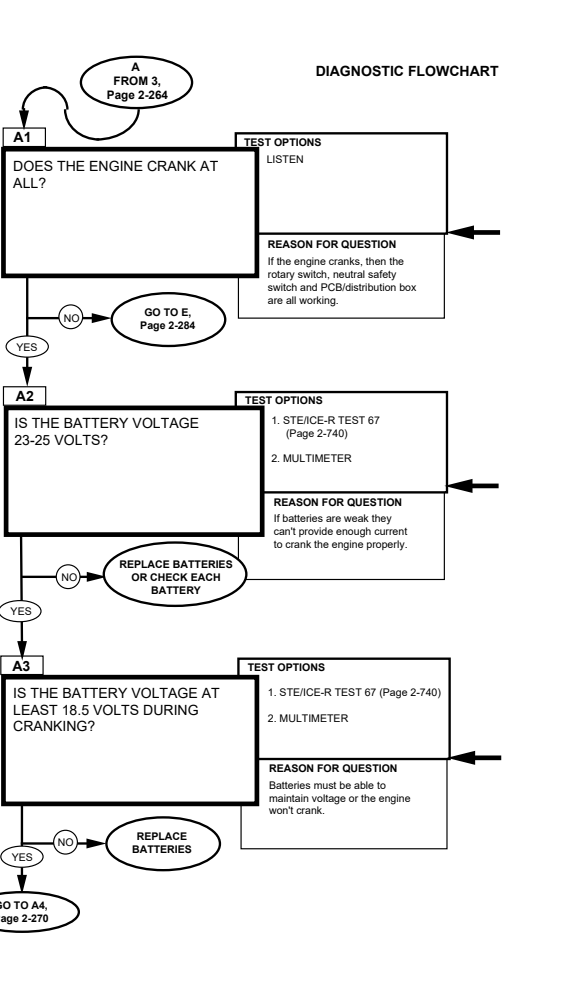
STARTER CIRCUIT A STARTER REPLACE STARTER CIRCUIT
Battery Voltage Ste/Ice-R Test 67
-
Start Test 67, battery voltage.
-
Displayed reading is in volts. Batteries should be 23-25.5 volts. Batteries voltage will drop when glowplugs turn on.
Voltage Multimeter
-
Set the voltmeter to a DC vollts scale of at least 40 volts.
-
Connect the RED lead to positive and the BLACK lead to negative. 3. Be sure to read the correct scale.

VOLTS GAUGE
(para 4-79).
(para 4-79).

STARTER CIRCUIT
Starter Average Current Ste/Lce-R Test 71
- Start Test 71, starter average current. 2. Displayed reading is in amps. The starter should draw at least 200 amps with a peak of over 400 amps.
Starter Neg. Cable Voltage Drop Ste/Ice-R Test 69
-
Start Test 69, starter negative cable voltage drop.
-
Displayed reading is in volts. The cable voltage drop should be less than 0.25 volts max.
Check these cables; Starter negative cable - STE/ICE-R test 69 Wire 68, connecting the batteries together. Test point is the positive battery post. Wire 49A, connecting battery to power stud.
Test point is the power stud.
Wire connecting battery to shunt (50A).
Test point is the positive battery post.
Power stud to starter motor (6A). Test point is the power stud. Replace or repair cables, refer to (para 4-73).

- connect RED clip to the indicated test point, BLACK clip to negative or ground. 2. Start Test 89, DC Volts. 3. Displayed reading is in volts.
Battery Current Multimeter
-
Set the voltmeter to a DC volts scale of about 1 volt.
-
Connect the BLACK lead to the battery side of the current shunt and the RED lead to the other end of the current shunt.
-
Current shunt voltage is proportional to battery current, 100 millivolts = 1000 amps. To get current, multiply millivolts x 10.
Voltage Multimeter
- Set the voltmeter to a DC volts scale of at least 40 volts. 2. Connect the RED lead to positive and the BLACK lead to negative. 3. Be sure to read the correct scale.

STARTER CIRCUIT Remove Starter motor.
Check the pinion and gear for missing or broken teeth, unusual wear, bent pieces, etc. Check the pinion by fuming it on the screw shaft.
Check the armature by prying the pinion with a screwdriver. The armature should turn freely. Replace starter, refer to (para 4-8).
Disconnect the fuel solenoid, wire 54A, to prevent accidental starting. Rotate the engine with a breaker bar and socket on the crankshaft pulley to inspect the engine flywheel for missing or defective teeth.
Replace starter, refer to (para 4-8).

TM 9-2320-280-20-1 REFERENCE INFORMATION

STARTER CIRCUIT Replace starter, refer to (para 4-8).

STARTER CIRCUIT C

DIAGNOSTIC FLOWCHART

KNOWN INFO ENGINE WON'T STOP CRANKING ROTARY SWITCH PCB/DISTRIBUTION BOX WIRING STARTER POSSIBLE PROBLEMSREASON FOR QUESTION No matter what's wrong, the starter can't crank without battery power.
KNOWN INFO ENGINE WON'T STOP CRANKING


DISCONNECT WIRES AT ROTARY SWITCH. WITH SWITCH IN "OFF" POSITION, DO YOU GET: TEST OPTIONS

 (Page 2-752)
2. MULTIMETER
POSSIBLE PROBLEMS
ROTARY SWITCH PCB/DISTRIBUTION BOX WIRING STARTER
(Page 2-752)
2. MULTIMETER
POSSIBLE PROBLEMS
ROTARY SWITCH PCB/DISTRIBUTION BOX WIRING STARTER

REASON FOR QUESTION A good switch exhibits these open circuits in the "OFF" position.
KNOWN INFO ENGINE WON'T STOP CRANKING POSSIBLE PROBLEMS ROTARY SWITCH PCB/DISTRIBUTION BOX WIRING STARTER

TEST OPTIONS
- STE/ICE-R TEST 91

(Page 2-752) 2. MULTIMETER REASON FOR QUESTION A good switch has these opens and shorts.
WITH ROTARY SWITCH IN "RUN" STARTER CIRCUIT
Don't forget that your vehicle batteries are disconnected, so you can't run the STE/lCE-R from the DCA, you have to use the power cable and connect directly to the batteries.
When the resistance is too high for STE/lCE-R to measure, as in the case of an open circuit, STE/lCE-R displays "9.9.9.9." Replace rotary switch, refer to (pare 4-7).
Don't forget that your vehicle batteries are disconnected, so you can't run the STE/lCE-R from the DCA, you have to use the power cable and connect directly to the batteries. When the resistance is too high for STE/lCE-R to measure, es in the case of an open circuit, STE/ICE-R displays "9.9.9.9." Replace rotary switch, refer to (para 4-7).

DIAGNOSTIC FLOWCHART
STARTER CIRCUITFROM C3,

TEST OPTIONS
- STE/ICE-R TEST 91 (Page 2-752) 2. MULTIMETER REASON FOR QUESTION Continuity between any of these pins indicates a short between the wires in body harness KNOWN INFO ROTARY SWITCH OK RECONNECT ROTARY SWITCH. TURN SWITCH TO "STOP." CHECK FOR OPEN CIRCUIT IN THE PCB BODY CONNECTOR HARNESS BETWEEN THE FOLLOWING SOCKETS; G-A, G-B, A-B, F-A, AND F-B.
ARE THEY ALL OPEN CIRCUITS ?
POSSIBLE PROBLEMS PCB/DISTRIBUTION BOX WIRING STARTER

C5

KNOWN INFO ROTARY SWITCH OK BODY HARNESS OK RECONNECT BODY CONNECTOR.
DISCONNECT ENGINE CONNECTOR. DISCONNECT WIRE 74A AT STARTER. IS THERE AN TEST OPTIONS
- STE/ICE-R TEST 91 (Page 2-752) 2. MULTIMETER REASON FOR QUESTION indicates a short in the engine harness.
POSSIBLE PROBLEMS PCB/DISTRIBUTION BOX WIRING STARTER
OPEN CIRCUIT FROM SOCKET E  CONNECTOR HARNESS? Continuity between these pins
KNOWN INFO
ROTARY SWITCH OK BODY HARNESS OK
IS THERE AN OPEN CIRCUIT FROM SOCKET E OF
PCB/DISTRIBUTION BOX ENGINE CONNECTOR
HARNESS TO ENGINE
TEST OPTIONS
CONNECTOR HARNESS? Continuity between these pins
KNOWN INFO
ROTARY SWITCH OK BODY HARNESS OK
IS THERE AN OPEN CIRCUIT FROM SOCKET E OF
PCB/DISTRIBUTION BOX ENGINE CONNECTOR
HARNESS TO ENGINE
TEST OPTIONS
- STE/ICE-R TEST 91 (Page 2-752) 2. MULTIMETER REASON FOR QUESTION connector in the starter solenoid.
POSSIBLE PROBLEMS PCB/DISTRIBUTION BOX WIRING STARTER
GROUND?Continuity indicates shorted

STARTER CIRCUIT Don't forget that your vehicle batteries are disconnected, so you can't run the STE/ICE-R from the DCA, you have to use the power cable and connect directly to the batteries.
When the resistance is too high for STE/ICE-R to measure, as in the case of an open circuit, STE/ICE-R displays "9.9.9.9." Repair wiring or replace harness, refer to (para. 4-85).

PCB/DISTRIBUTION BOX BODY CONNECTOR
-
Connect RED clip and BLACK clip to the indicated test points in the question. RED to the first, BLACK to the second. 2. Start Test 91, 0-4500 ohms. 3. Displayed reading is in ohms. Less than 5 ohms is continuity. If the resistance is over 4500 ohms, STE/ICE displays "9.9.9.9."
-
Set the voltmeter to an ohms scale of about 1000 ohms.
-
Connect the RED and BLACK leads to the connections stated in the question. 3. Be sure to read the correct scale. Less than 5 ohms indicates continuity. For an open circuit, the meter should peg full scale (needle all the way to the left).
Check the wires at the connectors for shorts. If there are no visible shorts, you have to replace the harness.
Repair wiring or replace harness, refer to (para. 4-85).
Replace starter, refer to (para. 4-8).
DIAGNOSTIC FLOWCHART KNOWN INFO ENGINE HARNESS OK POSSIBLE PROBLEMS PCB/DISTRIBUTION BOX BATTERY
STARTER CIRCUITFROM C6,

TEST OPTIONS C8
- STE/ICE-R TEST 67 (Page 2-740) 2. MULTIMETER REASON FOR QUESTION Low battery voltage may, under the proper conditions, cause the starter solenoid to remain energized.
KNOWN INFO ENGINE HARNESS OK POSSIBLE PROBLEMS PCB/DISTRIBUTION BOX BATTERY DISCONNECT BATTERY NEGATIVE CABLE. RECONNECT ENGINE CONNECTOR. REPLACE BATTERY NEGATIVE CABLE. REPLACE BATTERIES. TRY CRANKING ENGINE. IF IT WON'T STOP CRANKING, REPLACE PCB/DISTRIBUTION BOX. RE-RUN STARTER CIRCUIT TEST CHAIN (STEP 1, Page 2-262).
TM 9-2320-280-20-1
STARTER CIRCUIT
Battery Voltage Multimeter
- Set the voltmeter to a DC volts scale of at least 40 volts. 2. Connect the RED lead to positive and the BLACK lead to negative. 3. Be sure to read the correct scale.
Replace PCB, refer to (para. 4-5). Replace distribution box (para. 4-5.1).
Battery Voltage
STE/ICE-R TEST 67 1. Start Test 67, battery voltage. 2. Displayed reading is in volts. Batteries should be 23-25.5 volts. Batteries voltage will drop when glowplugs turn on.
Replace batteries, refer to (para. 4-79). Replace distribution box (para. 4-5.1).

Reference Information Starter Circuit
Battery Voltage Multimeter
- Set the voltmeter to a DC volts scale of at least 40 volts. 2. Connect the RED lead to positive and the BLACK lead to negative. 3. Be sure to read the correct scale.
Replace batteries, refer to (para 4-79).
Battery Voltage Ste/Ice-R Test 67
-
Start Test 67, battery voltage.
-
Displayed reading is in volts. Batteries should be 23-25.5 volts. Batteries voltage will drop when glowplugs turn on.
Replace batteries, refer to (para 4-79).
Battery Internal Resistance Ste/Ice-R Test 73
-
Disconnect wire 54A at injection pump to prevent starting. 2. Disconnect glowplug controller and fan solenoid (to keep waveform clean).
-
Start Test 73, battery internal resistance.
-
Wait for the GO massage. Crank the engine. 5. Result is displayed in milliohms. Battery resistance should be 25 milliohms max.
Replace cables or starter, refer to (para 4-77 or 4-8).
Starter Neg. Cable Voltage Drop Ste/Ice-R Test 69
- Start Test 69, starter negative cable voltage drop. 2. Displayed reading is in volts. The cable voltage drop should be less than 0.25 volts max.
Battery Resistance Change Ste/Ice-R Test 75
- Disconnect wire 54A at injection pump to prevent starting. 2. Disconnect glowplug controller and fan solenoid (to keep waveform clean). 3. Start Test 75, battery resistance change. 4. Wait for the GO message. Crank the engine. 5. Result is displayed in milliiohms/second. Battery resistence change should be 50 milliohms/second max.
0-45 Dc Volts Ste/Lce-R Test 89
-
Connect RED clip to the indicated test point, BLACK clip to negative or ground.
-
Start Test 89, DC volts.
-
Displayed reading is in volts.
Voltage Multimeter
l. Set the voltrneter to a DC volta scale of at least 40 volts. 2. Connect the RED lead to positive and the BLACK lead to negative. 3. Be sure to read the correct scale.
I I STARTER CIRCUIT KNOWN INFO ENGINE WON'T CRANK POSSIBLE PROBLEMS BATTERY STARTER PCB/DISTRIBUTION BOX ROTARY SWITCH NEUTRAL SAFETY SWITCH WIRING/CABLES LOCKED ENGINE
Known Info
BATTERY SHOULD AT LEAST CRANK ENGINE SLOWLY.
POSSIBLE PROBLEMS STARTER PCB/DISTRIBUTION BOX ROTARY SWITCH NEUTRAL SAFETY SWITCH WIRING/CABLES LOCKED ENGINE KNOWN INFO VOLTAGE AVAILABLE AT STARTER POSSIBLE PROBLEMS BATTERY STARTER PCB/DISTRIBUTION BOX ROTARY SWITCH NEUTRAL SAFETY SWITCH WIRING/CABLES LOCKED ENGINE

Reference Information Starter Circuit
Battery Voltage Ste/Lce-R Test 67
-
Start Test 67, battery voltage.
-
Displayed reading is in volts. Batteries should be 23-25.5 volts. Batteries voltage will drop when glowplugs turn on.
Replace batteries, refer to (para 4-79).
Battery Voltage Multimeter
- Set the voltmeter to a DC volts scale at least 40 volts. 2. Connect the RED lead to positive and the BLACK lead to negative. 3. Be sure to read the correct scale.
Starter Motor Voltage Ste/Lce-R Test 68
- Start Test 68, starter motor voltage. 2. Displayed reading is in volts. Starter motor voltage should be the same as battery voltage, 23-25.5 volts. During cranking the starter motor voltage should beat least 18 volts.
Starter Solenoid Voltage Ste/Ice-R Test 70
- Start Test 70, starter solenoid voltage. 2. Displayed reading is in volts. Starter solenoid voltage should be the same as battery voltage, 23-25.5 volts. During cranking the starter solenoid voltage should be at least 18 volts.
I


DIAGNOSTIC FLOWCHART TM 9-2320-280-20-1 STARTER CIRCUIT REFERENCE INFORMATION

Replace starter, refer to (para 4-8)

STARTER CIRCUIT
-
Connect RED clip to the indicated test point, BLACK clip to negative or ground.
-
Start Test 89, DC volts. 3. Displayed reading is in volts.
Voltage Multimeter
-
Set the voltmeter to a DC volts scale of at least 40 volts.
-
Connect the RED lead to positive and the BLACK lead to negative.
-
Be sure to read the correct scale.

WIRE 6A
Starter Circuit
KNOWN INFO NO SOLENOID CONTROL VOLTAGE POSSIBLE PROBLEMS PCB/DISTRIBUTION BOX WIRING ROTARY SWITCH NEUTRAL SAFETY SWITCH KNOWN INFO VOLTAGE AVAILABLE ROTARY SWITCH OK POSSIBLE PROBLEMS NEUTRAL SAFETY
 SWITCH PCB/DISTRIBUTION BOX
KNOWN INFO
NEUTRAL SAFETY SWITCH OK
POSSIBLE PROBLEMS
PCB/DISTRIBUTION BOX WIRING
SWITCH PCB/DISTRIBUTION BOX
KNOWN INFO
NEUTRAL SAFETY SWITCH OK
POSSIBLE PROBLEMS
PCB/DISTRIBUTION BOX WIRING
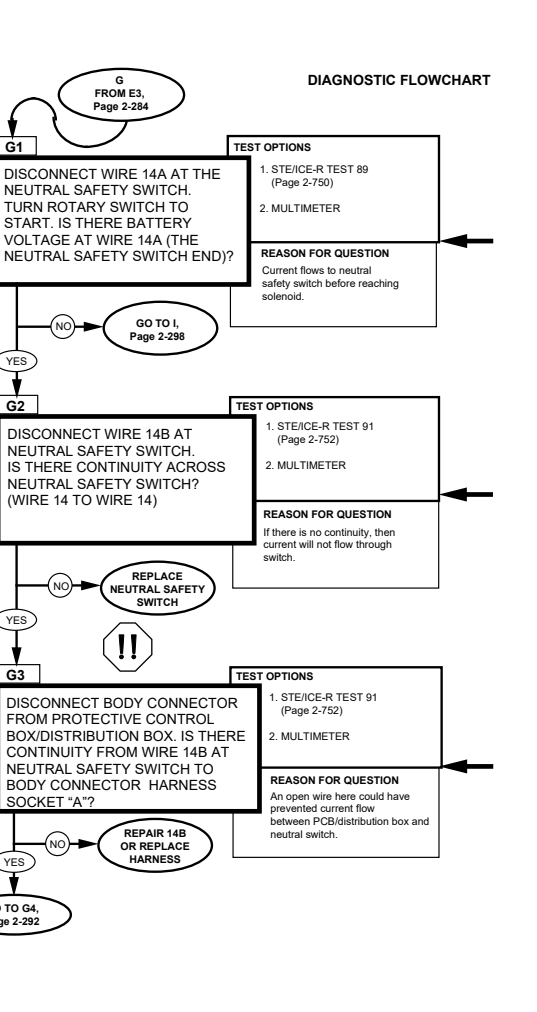
WIRING REPLACE STARTER CIRCUIT
Voltage Multimeter
-
Set the voltmeter to a DC volts scale of at least 40 volts. 2. Connect the RED lead to positive and the BLACK lead to negative. 3. Be sure to read the correct scale.
-
Set the voltmeter to an ohms scale of about 1000 ohms. 2. Connect the RED and BLACK leads to the connections stated in the question. 3. Be sure to read the correct scale. Less than 5 ohms indicates continuity. For an open circuit, the meter should peg full scale (needle all the way to the left).
-
Connect RED clip and BLACK clip to the terminations indicated in the question. RED to the first, BLACK to the second. 2. Start Test 91, 0-4500 ohms. 3. Displayed reading is in ohms. Less than 5 ohms is continuity. If the resistance is over 4500 ohms, STE/ICE displays "9.9.9.9." The connections for the neutral safety switch can be reached by removing the engine cover. The connections are near the gear shift lever.
Replace rotary switch, refer to (para. 4-7).
WARNING


Disconnect negative battery cable before disconnecting and reconnecting protective control box/distribution box harness.
There is battery voltage at the PCB/distribution box at all times. Failure to disconnect battery cable will result in damage to equipment or injury to personnel.
Repair wiring or replace switch, refer to (para. 4-7). A
- Connect RED clip to the indicated test point, BLACK clip to negative or ground. 2. Start Test 89, DC volts. 3. Displayed reading is in volts.

PCB/DISTRIBUTION BOX BODY CONNECTOR Change 1 2-291
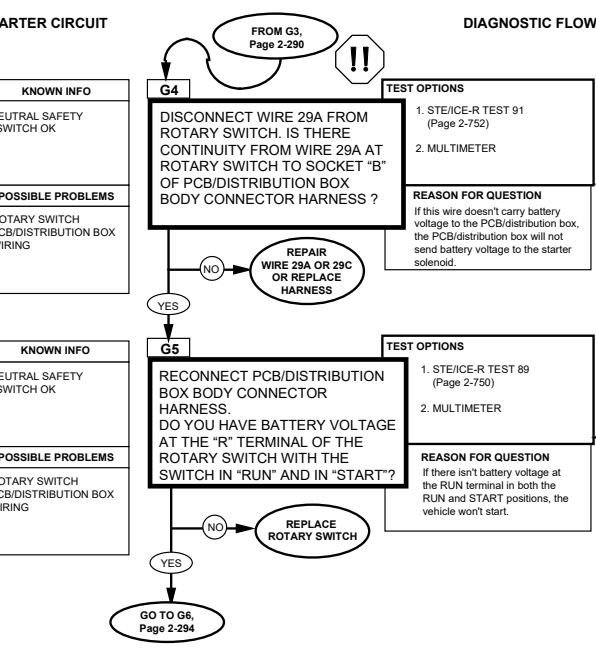
STARTER CIRCUIT

Disconnect negative battery cable before disconnecting and reconnecting protective control box/distribution box harness.
There is battery voltage at the PCB/distribution box at all times. Failure to disconnect battery cable will result in damage to equipment or injury to personnel.
Check the wires and connections at both ends for broken wires or any kind of bad connection. Repair whatever you can. If the wires and connections seem OK, you have to replace the harness.
Repair wiring or replace harness, refer to (para. 4-85).

Replace rotary switch, refer to (para. 4-7).
-
Connect RED clip to the indicated test point, BLACK clip to negative or ground.
-
Start Test 89, DC volts. 3. Displayed reading is in volts.
Voltage Multimeter
-
Set the voltmeter to a DC volts scale of at least 40 volts. 2. Connect the RED lead to positive and the BLACK lead to negative. 3. Be sure to read the correct scale.
-
Connect RED clip and BLACK clip to the terminations indicated in the question. RED to the first, BLACK to the second. 2. Start Test 91, 0-4500 ohms. 3. Displayed reading is in ohms. Less than 5 ohms is continuity. If the resistance is over 4500 ohms, STE/ICE displays "9.9.9.9."
-
Set the voltmeter to an ohms scale of about 1000 ohms.
-
Connect the RED and BLACK leads to the connections stated in the question.
-
Be sure to read the correct scale. Less than 5 ohms indicates continuity. For an open circuit, the meter should peg full scale (needle all the way to the left).
STARTER CIRCUIT FROM G5,

TEST OPTIONS DIAGNOSTIC FLOWCHART KNOWN INFO POWER AVAILABLE TO PCB/DISTRIBUTION BOX POSSIBLE PROBLEMS PCB/DISTRIBUTION BOX WIRING DISCONNECT BATTERY NEGATIVE CABLE. RECONNECT NEUTRAL SAFETY SWITCH. DISCONNECT ENGINE CONNECTOR FROM PCB/DISTRIBUTION BOX. IS THERE CONTINUITY FROM ENGINE CONNECTOR HARNESS SOCKET "I" TO THE STARTER SOLENOID WIRE 74A?
- STE/ICE-R TEST 91 (Page 2-752) 2. MULTIMETER REASON FOR QUESTION If there is continuity there, you know all the wiring is good and the problem is in the PCB/distribution box.

REPAIR 74A

OR REPLACE HARNESS KNOWN INFO WIRING OK G7 POSSIBLE PROBLEMS PCB/DISTRIBUTION BOX REPLACE PCB/DISTRIBUTION BOX. IF YOU STILL HAVE A PROBLEM, RE-RUN THE TEST CHAIN (Page 2-261).
STARTER CIRCUIT

Disconnect negative battery cable before disconnecting and reconnecting protective control box/distribution box harness.
There is battery voltage at the PCB/distribution box at all times. Failure to disconnect battery cable will result in damage to equipment or injury to personnel.
Replace PCB, refer to (para. 4-5). Replace distribution box, refer to (para. 4-5.1).
-
Connect RED clip and BLACK clip to the terminals indicated in the question.
-
Start Test 91, 0-4500 ohms.
-
Displayed reading is in ohms. Less than 5 ohms is continuity. If the resistance is over 4500 ohms, STE/ICE-R displays "9.9.9.9."
-
Set the voltmeter to an ohms scale of about 1000 ohms. 2. Connect the RED and BLACK leads to the connections stated in the question. 3. Be sure to read the correct scale. Less than 5 ohms indicates continuity. For an open circuit, the meter should peg full scale (needle all the way to the left).

TM 9-2320-280-20-1 REFERENCE INFORMATION STARTER CIRCUIT

in serious injury or death.
STARTER CIRCUIT

TEST OPTIONS DIAGNOSTIC FLOWCHART KNOWN INFO NO VOLTAGE AVAILABLE AT NEUTRAL SAFETY SWITCH.
POSSIBLE PROBLEMS ROTARY SWITCH PCB/DISTRIBUTION BOX WIRING
- STE/ICE-R TEST 89 (Page 2-750) 2. MULTIMETER
REASON FOR QUESTION
 Power must be available to
rotary switch.
Power must be available to
rotary switch.
Known Info
BATTERY VOLTAGE AVAILABLE TO ROTARY SWITCH.
POSSIBLE PROBLEMS
ROTARY SWITCH PCB/DISTRIBUTION BOX WIRING
DISCONNECT WIRE 14A AT ROTARY SWITCH . WITH THE
ROTARY SWITCH TURNED TO
START, IS THERE CONTINUITY 
"S" STUD ?
TEST OPTIONS
- STE/ICE-R TEST 91 (Page 2-752) 2. MULTIMETER REASON FOR QUESTION Continuity here indicates rotary switch is OK.
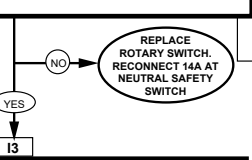
KNOWN INFO ROTARY SWITCH OK REPAIR WIRE 14A OR REPLACE HARNESS.
POSSIBLE PROBLEMS WIRING
Starter Circuit Reference Information
Voltage Multimeter
-
Set the voltmeter to a DC volts scale of at least 40 volts.
-
Connect the RED lead to positive and the BLACK lead to negative. 3. Be sure to read the correct scale.
-
Set the voltmeter to an ohms scale of about 1000 ohms.
-
Connect the RED and BLACK leads to the connections stated in the question. 3. Be sure to read the correct scale. Less than 5 ohms indicates continuity. For an open circuit, the meter should peg full scale (needle all the way to the left).
Replace rotary switch, refer to (para 4-7).
0-45 Dc Volts Ste/Ice-R Test 89 I
-
Connect RED clip to the indicated test point, BLACK clip to negative or ground. 2. Start Test 89, DC volts. 3. Displayed reading is in volts.
-
Connect RED clip and BLACK clip to the terminations indicated in the question. RED to the first, BLACK to the second. 2. Start Test 91, 0-4500 ohms. 3. Displayed reading is in ohms. Less than 5 ohms is continuity. If the resistance is over 4500 ohms, STE/lCE displays "9.9.9.9." I I
REAR OF ROTARY SWITCH
Repair wiring or replace harness,
 refer to (para 4-85).
refer to (para 4-85).
KNOWN INFO NO VOLTAGE AT ROTARY SWITCH POSSIBLE PROBLEMS PCB/DISTRIBUTION BOX WIRING
STARTER CIRCUIT DIAGNOSTIC FLOWCHART

TEST OPTIONS DISCONNECT BATTERY NEGATIVE CABLE. DISCONNECT BODY CONNECTOR FROM PCB/DISTRIBUTION BOX. IS THERE CONTINUITY FROM SOCKET G OF BODY CONNECTOR HARNESS TO WIRE

- STE/ICE-R TEST 91
 (Page 2-752) 2. MULTIMETER
REASON FOR QUESTION If this wire is open, no power can get to the rotary switch.
(Page 2-752) 2. MULTIMETER
REASON FOR QUESTION If this wire is open, no power can get to the rotary switch.
KNOWN INFO NO VOLTAGE AT ROTARY SWITCH WIRING TO ROTARY SWITCH OK RECONNECT WIRE 11A AT ROTARY SWITCH. DISCONNECT ENGINE CONNECTOR OF PCB/DISTRIBUTION BOX.
RECONNECT BATTERY NEGATIVE CABLE. IS THERE BATTERY VOLTAGE AT SOCKET E OF TEST OPTIONS
- STE/ICE-R TEST 89 (Page 2-750) 2. MULTIMETER POSSIBLE PROBLEMS PCB/DISTRIBUTION BOX WIRING

REASON FOR QUESTION This wire provides power from the batteries directly to the PCB/distribution box. If there is power here, then this wire is OK and the PCB/distribution box must be bad.
KNOWN INFO WIRING OK REPLACE PROTECTIVE CONTROL BOX/DISTRIBUTION BOX.
POSSIBLE PROBLEMS PCB/DISTRIBUTION BOX

Disconnect negative battery cable before disconnecting and reconnecting PCB/ distribution box harness. There is battery voltage at the PCB/distribution box at all times. Failure to disconnect battery cable will result in damage to equipment or injury to personnel.
Replace harness or repair wiring, refer to (para. 4-85).
WARNING


Disconnect negative battery cable before disconnecting and reconnecting PCB/distribution box harness. There is battery voltage at the PCB/distribution box at all times. Failure to disconnect battery cable will result in damage to equipment or injury to personnel. Replace harness or repair wiring, refer to (para. 4-85).
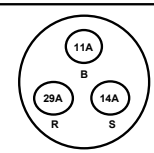
REAR OF ROTARY SWITCH

Disconnect negative battery cable before disconnecting and reconnecting PCB/distribution box harness.
There is battery voltage at the PCB/distribution box at all times. Failure to disconnect battery cable will result in damage to equipment or injury to personnel.
Replace PCB, refer to (para. 4-5).
Replace distribution box, refer to (para. 4-5.1)
Voltage Multimeter
-
Set the voltmeter to a DC volts scale of at least 40 volts. 2. Connect the RED lead to positive and the BLACK lead to negative. 3. Be sure to read the correct scale.
-
Set the voltmeter to an ohms scale of about 1000 ohms. 2. Connect the RED and BLACK leads to the connections stated in the question. 3. Be sure to read the correct scale. Less than 5 ohms indicates continuity. For an open circuit, the meter should peg full scale (needle all the way to the left).
-
Connect RED clip to the indicated test point, BLACK clip to negative or ground. 2. Start Test 89, DC volts. 3. Displayed reading is in volts.
-
Connect RED clip and BLACK clip to the indicated terminals in the question. RED to the first, BLACK to the second. 2. Start Test 91, 0-4500 ohms. 3. Displayed reading is in ohms. Less than 5 ohms is continuity. If the resistance is over 4500 ohms, STE/ICE displays '9.9.9.9.' STARTER CIRCUIT
2-31. Glowplugs Circuit Tests (Protective Control Box)
These tests of the Glowplugs Circuit can be run anytime you think there may be a problem with the glowplugs, or if you were sent here from another test.
If you were sent from another test, be sure to mark where you came from so you will be able to return.
If you are running this test because the engine is hard to start when cold, remember that there is also a cold start advance circuit (part of the fuel system) which is not checked here. For any starting problem, we recommend running the "STARTABILITY" test chain just to be sure you don't miss anything. At the bottom of this page is a simplified block diagram which shows how the different parts of the glowplug circuit depend on each other and on other engine circuits. Refer to fold-out page FO-9 and leave it open for reference while preforming these tests. The fold-out diagram is arranged to allow you to follow the diagnostic logic and understand what you are testing, when and why.

GLOWPLUGS CIRCUIT SIMPLIFIED BLOCK DIAGRAM FOR PROTECTIVE CONTROL BOX
Glowplugs
DIAGNOSTIC FLOWCHART

KNOWN INFO NOTHING POSSIBLE PROBLEMS GLOWPLUGS GLOWPLUG CONTROLLER PCB CABLES KNOWN INFO BATTERIES OK POSSIBLE PROBLEMS GLOWPLUGS GLOWPLUG CONTROLLER РСВ CABLES KNOWN INFO BATTERIES OK CABLES/CONNECTIONS SEEM OK POSSIBLE PROBLEMS GLOWPLUGS GLOWPLUG CONTROLLER ьсв CABLES TESTS. THE BATTERIES MUST BE IN A GOOD STATE OF CHARGE.
IF YOU AREN'T SURE, RUN THE BATTERY CIRCUIT TESTS. IF YOU ARE HERE BECAUSE THE "WAIT-TO-START" LAMP DOESN'T WORK PROPERLY, SEE THE NOTE ON THE RIGHT-HAND PAGE.

TEST OPTIONS BATTERY TESTS

(Page 2-251) REASON FOR QUESTION The glowplugs and their control circuits require battery power to work.

Reference Information Glowplugs
If the engine cranks ok (or starts), then the batteries are good enough for testing the glowplugs. If the engine starts, shut it off. You can use STE/lCE Test 10 to measure cranking speed. The engine should crank at least 100 RPM in cold weather and at least 180 RPM in warm weather.

Disconnect negative battery cable before disconnecting and reconnecting protective control box harness.
There is battery voltage at the PCS at all times. Failure to disconnect battery cable will result in damage to equipment or injury to personnel.
Bad Connections Are The Most Common
Sometimes, just disconnecting, cleaning and reconnecting will solve a problem. BE THOROUGH ! The time you save may be your own. Refer to the functional flow schematic and check the following 1. BATTERY - make sure all connections are dean and tight, including the shunt and power stud. 2. PROTECTIVE CONTROL BOX - unscrew BOTH connectors and look for bent or broken pins, pins pushed out of their socket, or dirt and corrosion in the connections. 3. GLOWPLUG CONTROLLER - pop the controller connector off (squeeze the sides) and check the pins in both the controller and the connector. Look for bent, broken or pushed out pins, dirt or corrosion. Check for broken wires at the connector. Take note that pin 2 of the glowplugs controller connector has no pin in it. 4. GLOWPLUGS - Check that all the glowplug wires are snug. Don't just look with your eyes. Many problems are solved by Iooking with your fingers to be sure a connection is snug.
The glowplugs first come ON when the engine temperature is below 120 °F (49°C) and the rotary switch is turned to "RUN". They stay ON for up to 9 seconds and then go OFF.
They will stay OFF for about 7-15 seconds then come ON again for about 1 second.
Note Note
The WAIT-TO-START lamp is NOT diagnosed in this section. If the lamp does not work property, the glowplug circuit may be affecting its operation.
Run these tests to check out the glowplug circuit. If the lamp still does not work properly, go to the INSTRUMENTS section for a full diagnosis of the

Battery Current Multimeter
-
Set the voltmeter to a DC volts scale of about 1 volt.
-
Connect the BLACK lead to the battery side of the current shunt and the RED lead to the other end of the current shunt. 3. Currant shunt voltage is proportional to battery current, 100 millivolts = 1000 amps. To get current, multiply millivolts x 10.
Battery Current Ste/Ice-R Test 80
- Start Test 80, battery currant. 2. Displayed reading is in amps. The reading will be greater then 30 amps, depending on how many accessories you have on.
To check for glowplug current draw, start STE/lCE-R Test 80, battery current. Turn off all accessories (lights, heater, wipers etc). STE/lCE-R should immediately measure at least 74 amps. Take note, however, that if all your glowplugs are working, the current draw should be close to or more than 100 amps, especially if it's cold. If it's near freezing and the glowplugs only draw 75-80 amps, you probably have a few bad glowplugs.
GLOWPLUGS The glowplugs first come ON when the engine temperature is below 120 °F (49 °C) and the rotary switch is turned to RUN. They stay ON for up to 9 seconds and then go OFF. They will stay OFF for about 7-15 seconds then come ON again for about 1 second, than go OFF again. If you don't start the engine, the glowplugs should keep cycling like this, due to the glowplug cycle timer in the glowplugs controller. It you start the engine, they will cycle until the engine is warm, due to the afterglow cycle timer in the glowplug controller. When the engine gets up to 120 °F (49 °C), the glowplugs should stop cycling completely.
Engine Not Running
If the glowplugs are cycling property, you should hear a click from the protective control box (PCB) when the glowplugs turn on and when they turn off. This is the glowplug cycle timer, a thermal circuit breaker. A good way to check for cycling is STE/lCE-R test 80, battery current. When the glowplugs turn on, STE/lCE-R will measure 74-125 amps.
When the glowplugs turn off, the STE/lCE-R will measure 3-8 amps.
Engine Running. Rotary Switch In Run
If the glowplugs are cycling properly, you can hear a click from the protective control box (PCB) when the glowplugs turn on and when they turn off (you may have to duck your head under the dash). This is the afterglow cycle timer, a thermal circuit breaker. A good way to check for cycling is STE/ICE-R test 80, battery current. When the glowplugs turn on, STE/lCE-R will measure 74-125 amps. When the glowplugs turn off, STE/lCE-R will measure 3-8 amps. As the engine gets warmer, the glowplugs turn on leas frequently and for baa time.
Note
If you don't have a STE/lCE-R or a multimeter for measuring current, you can watch the vehicle volts gauge for indication of glowplug operation. The glowplugs drew so much current that the volts gage should jump about half-an-inch to the left when the glowplugs come on. Before starting the engine, you should hear the glowplug power relay click open and closed as the glowplugs cycle. (You can hear the relay after the engine has started by leaning your head under the dash near the protective control box.) This method won't tell you if all the glowplugs are working property, but it at least shows that the glowplugs are trying to work and that the glowplug power relay is working.
Glowplugs
KNOWN INFO GLOWPLUGS DO NOT DRAW ENOUGH CURRENT POSSIBLE PROBLEMS GLOWPLUGS GLOWPLUG CONTROLLER CABLES
Known Info
GLOWPLUGS DRAW SOME BUT NOT ENOUGH CURRENT.
РСВ ОК POSSIBLE PROBLEMS GLOWPLUGS GLOWPLUG CONTROLLER CABLES
Known Info
GLOWPLUGS DRAW SOME BUT NOT ENOUGH CURRENT РСВ ОК GLOWPLUG CONTROLLER OK POSSIBLE PROBLEMS GLOWPLUGS CABLES

only reason they wouldn't draw enough current is that the glowplugs themselves are bad or the wires are no good.
Dead glowplugs draw virtually no current, but other parts of the vehicle are drawing some current, up to 8 amps. If any glowplugs are drawing any current, then the protective control box is probably OK.
Disconnect ALL the glowplugs.

Disconnect the negative battery cable. Disconnect the PCB connector harness from the PCB. Reconnect the negative battery cable. Measure the resistance between pin Din the engine connector harness of the protective control box and ground. There should NOT be continuity (resistance reading off-the-scale). If there is continuity, repair or replace the harness.
Repeat the following for each glowplug a.
Reconnect the wiring harness to the glowplug while you repeat the resistance measurement described in step 2. When you reconnect the wire to the glowplug, the resistance should drop to between 1 and 2 ohms (glowplugs are typically 1.6 ohms).
b.
If step a passed; disconnect the glowplug again, making sure the resistance goes off-scale again. Repeat step a for the next glowplug.
If step a failed; then either the glowplug or its wire is no good. Take the wire off the glowplug again and measure the resistance from the glowplug to the engine block. If the resistance is 1-2 ohms, then the cable is no good, otherwise replace the glowplug and check the cable for continuity, just to be sure.
c.
For a good description of how glowplugs cycle and how to check for proper cycling, refer to page 2-307.

Disconnect negative battery cable before disconnecting and reconnecting protective control box harness.
There is battery voltage at the PCB at all times.
Failure to disconnect battery cable will result in damage to equipment or injury to personnel.
If most or all of the glowplugs are bad, you may also have a problem with the protective control box or the glowplug controller which caused them to go bed (usually they burn out from being on too long or not turning off at all). After replacing the bad glowplugs, rerun the glowplugs test chain paying special attention to the glowplugs cycling, especially that they turn OFF when they should.
Replace glowplugs, wires, or harness, refer to (para 3-38).
4.Reconnect the PCB and all wires.

GLOWPLUGS
Note
Ensure that alternator "AC" tap is functioning correctly by measuring DC volts at wire 2A. Reading should be between 9-16 Vdc. If this votage is not present, glowplug system will never stop cycling. Refer to the functional flow schematic. If the glowplug controller is shorted (continuity from pin 6 to pin 3), the glowplug power relay will always be energized and the glowplugs will always be drawing current.
Battery Current Ste/Ice-R Test 80
- Start Test 80, battery current. 2. Displayed reading is in amps. The reading will be greater than 30 amps, depending on how many accessories you have on.
Since the glowplugs draw current without the glowplug controller connected, there must be a short in the harness or a stuck relay in the protective control box (PCB). If there were a short in the harness directly to the glowplugs, the glowplugs would have burned out long ago and you wouldn't be here. The only other short in the harness that would make the glowplugs turn on without the glowplug controller installed would show up as battery voltage at pin 6 of the controller's connector.
Replace PCB, refer to (para. 4-5).
Check the end of the harness at the protective control box, glowplugs, etc. for shorts. Repair whatever you can. If you don't see anything wrong, the short must be in the main body of the harness, which means that you have to replace the harness.
WARNING

Disconnect negative battery cable before disconnecting and reconnecting protective control box.
There is battery voltage at the PCB at all times. Failure to disconnect battery cable will result in damage to equipment or injury to personnel.
For repair or replacement of wiring, refer to (para. 4-85).
Battery Current Multimeter
-
Set the voltmeter to a DC volts scale of about 1 volt. 2. Connect the BLACK lead to the battery side of the current shunt and the RED lead to the other end of the current shunt. 3. Current shunt voltage is proportional to battery current, 100 millivolts = 1000 amps. To get current, multiply millivolts x 10.
-
Connect RED clip to the indicated test point, BLACK clip to negative or ground. 2. Start Test 89, DC volts.
-
Displayed reading is in volts.
Voltage Multimeter
- Set the voltmeter to a DC volts scale of at least 40 volts. 2. Connect the RED lead to positive and the BLACK lead to negative. 3. Be sure to read the correct scale.

Glowplug Controller Harness Schematic GLOWPLUG CONTROLLER РСВ
GLOWPLUGS
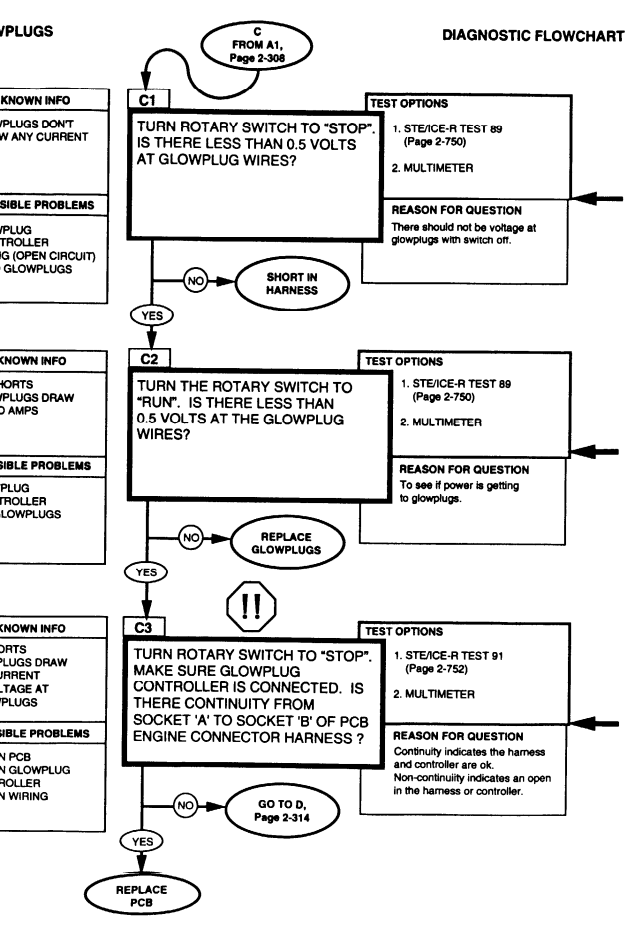
8 BAD GLOWPLUGS NO SHORTS ZERO AMPS CONTROLLER BAD GLOWPLUGS GLOWPLUGS DRAW NO CURRENT NO VOLTAGE AT GLOWPLUGS OPEN IN GLOWPLUG CONTROLLER OPEN IN WIRING GLOWPLUG PCB NO SHORTS OPEN IN PCB REFERENCE INFORMATION GLOWPLUGS Replace harness. Notify DS Maintenance.
0-45 Dc Volts
Steace-R Test 89
-
Connect RED clip to the indicated test point, BLACK clip to negative or ground.
-
Start Test 89, DC volts.
-
Displayed reading is in volts.
Voltage Multimeter
-
Set the voltmeter to a DC volts scale of at least 40 volts.
-
Connect the RED lead to positive and the BLACK lead to negative. 3. Be sure to read the correct scale.
-
Connect RED clip and BLACK clip to the indicated test points in the question. RED to the first, BLACK to the second.
-
Start Test 91, 0-4500 ohms.
-
Displayed reading is in ohms. Less than 5 ohms is continuity. If the resistance is over 4500 ohms.
STE/ICE displays "9.9.9.9."
-
Set the voltmeter to an ohms scale of about 1000 ohms.
-
Connect the RED and BLACK leads to the connections stated in the question.
-
Be sure to read the correct scale. Less than 5 ohms indicates continuity. For an open circuit, the meter should peg full scale (needle all the way to the left).
Replace glowplugs, refer to (para 3-38).

Disconnect negative battery cable before disconnecting and reconnecting protective control box harness.
There is battery voltage at the PCB at all times. Failure to disconnect battery cable will result in damage to equipment or injury to personnel.
Replace PCB, refer to
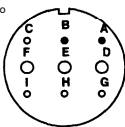
(para 4-5).
Engine Connector with pins 'A' & 'B' highlighted.

GLOWPLUGS


Disconnect negative battery cable before disconnecting and reconnecting protective control box harness.
There is battery voltage at the PCB at all times. Failure to disconnect battery cable will result in damage to equipment or injury to personnel.
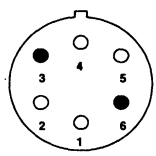
Engine Connector Hamess with sockets "A" & "B" highlighted.
-
Connect RED clip and BLACK clip to the indicated test points in the question. RED to the first, BLACK to the second.
-
Start Test 91, 0-4500 ohms.
-
Displayed reading is in ohms. Less than 5 ohms. is continuity. If the resistance is over 4500 ohms, STE/ICE displays '9.9.9.9.'
-
Set the voltmeter to an ohms scale of about 1000 ohms.
-
Connect the RED and BLACK leads to the connections stated in the question. 3. Be sure to read the correct scale. Less than 5 ohms indicates continuity. For an open circuit, the meter should peg full scale (needle all the way to the left).
| PIN-TO-PIN | RESISTANCE | |
|---|---|---|
| 1 | 5 | 130 ರ ಕ ರ |
| 2 | 3 | 0.40 Ω TO 0.75 Ω |
| 4 | 5 | 27 Ω + 3 Ω |
| 2 | 6 | .45 Ω MAXIMUM |
Glowplug Controller Hamess with sockets 3 & 6 highlighted
Note
You will not be able to check the solid-state controller using the pin-to-pin resistance check. The solid-state controller is identified by a green finish and a larger case.
Replace glowplug controller, refer to (para 4-29).

Glowplug Controller

GLOWPLUGS CIRCUIT

Disconnect negative battery cable before disconnecting and reconnecting protective control box harness.
There is battery voltage at the PCB at all times.
Failure to disconnect battery cable will result m damage to equipment or injury to personnel.
Repair wiring or replace harness, refer to (pare 4-34).
-
Connect RED clip and BLACK clip to the indicated test points in the question. RED to the first, BLACK to the second.
-
Start Test 91,0-4500 ohms.
-
Displayed reading is in ohms. Less than 5 ohms is continuity. If the resistance is over 4500 ohms, STE/lCE displays "9.9.9.9." Repair wiring or replace harness, refer to (para 4-85). Replace glowplug controller, refer to (para 4-29).
-
Set the voltmeter to an ohms scale of about 1000 ohms. 2. Connect the RED and BLACK leads to the connections stated in the question. 3. Be sure to read the correct scale. Less than 5 ohms indicates continuity. For an open circuit, the meter should peg full scale (needle all the way to the left).
2-31.1. Glowplugs Circuit Tests (Distribution Box)
These tests of the Glowplugs Circuit can be run anytime you think there may be a problem with the glowplugs, or if you were sent here from another test.
If you were sent from another test, be sure to mark where you came from so you will be able to return.
If you are running this test because the engine is hard to start when cold, remember that there is also a cold start advance circuit (part of the fuel system) which is not checked here. For any starting problem, we recommend running the "STARTABILITY" test chain just to be sure you don't miss anything. At the bottom of this page is a simplified block diagram which shows how the different parts of the glowplug circuit depend on each other and on other engine circuits.

GLOWPLUGS CIRCUIT SIMPLIFIED BLOCK DIAGRAM FOR DISTRIBUTION BOX

2-318.2 Change 1
Glowplugs
KNOWN INFO NOTHING POSSIBLE PROBLEMS DISTRIBUTION BOX CABLES GLOWPLUGS KNOWN INFO POSSIBLE PROBLEMS DISTRIBUTION BOX CABLES GLOWPLUGS KNOWN INFO BATTERIES OK CABLES/CONNECTIONS SEEM OK POSSIBLE PROBLEMS DISTRIBUTION BOX CABLES GLOWPLUGS
Glowplugs
If the engine cranks ok (or starts), then the batteries are good enough for testing the glowplugs. If the engine starts, shut it off. You can use STE/ICE Test 10 to measure cranking speed. The engine should crank at least 100 RPM in cold weather and at least 180 RPM in warm weather.

Disconnect negative battery cable before disconnecting and reconnecting distribution box harness.
There is battery voltage at the distribution box at all times. Failure to disconnect battery cable will result in damage to equipment or injury to personnel.
Bad Connections Are The Most Common
PROBLEM !
Sometimes, just disconnecting, cleaning and reconnecting will solve a problem. BE THOROUGH ! The time you save may be your own. Refer to the functional flow schematic and check the following; 1. BATTERY - make sure all connections are clean and tight, including the shunt and power stud. 2. DISTRIBUTION BOX - unscrew the three connectors and look for bent or broken pins, pins pushed out of their socket, or dirt and corrosion in the connections. 3. GLOWPLUGS - Check that all the glowplug wires are snug. Don't just look with your eyes. Many problems are solved by looking with your fingers to be sure a connection is snug.
Normal Glowplug Operation
The glowplugs are heated quickly for 5 to 20 seconds. This cycle is active while the "Wait-to-Start" light is on. The length of "on" time is dependent on battery voltage, the weaker the batteries the longer the "on" time. This cycle will only repeat if the run start switch has been off for more than 2 1/2 minutes. After the initial 5 to 20 seconds preglow, the system goes to afterglow. Afterglow provides lower voltage to the glowplugs to keep them at operating temperature for approximately 60 seconds.
Note
To check for glowplug current draw, start STE/ICE-R Test 80, battery current. Turn off all accessories (lights, heater, wipers etc). STE/ICE-R should immediately measure at least 74 amps. Take note, however, that if all your glowplugs are working, the current draw should be close to or more than 100 amps, especially if it's cold. If it's near freezing and the glowplugs only draw 75-80 amps, you probably have a few bad glowplugs.
Note
The "WAIT-TO-START" lamp is NOT diagnosed in
 this section. If the lamp does not work properly, the glowplug circuit may be affecting its operation. Run these tests to check out the glowplug circuit. If the lamp still does not work properly, go to the INSTRUMENTS section for a full diagnosis of the lamp's problem.
this section. If the lamp does not work properly, the glowplug circuit may be affecting its operation. Run these tests to check out the glowplug circuit. If the lamp still does not work properly, go to the INSTRUMENTS section for a full diagnosis of the lamp's problem.
Battery Current Multimeter
- Set the voltmeter to a DC volts scale of about 1 volt. 2. Connect the BLACK lead to the battery side of the current shunt and the RED lead to the other end of the current shunt. 3. Current shunt voltage is proportional to battery current, 100 millivolts = 1000 amps. To get current, multiply millivolts x 10.
Battery Current Ste/Ice-R Test 80
- Start Test 80, battery current. 2. Displayed reading is in amps. The reading will be greater than 30 amps, depending on how many accessories you have on.
KNOWN INFO BATTERIES OK GLOWPLUGS OK DISTRIBUTION BOX OK POSSIBLE PROBLEMS CABLES GLOWPLUG CONTROL CIRCUIT

REFERENCE INFORMATION GLOWPLUGS
Normal Glowplug Operation
The glowplugs first come ON when the engine temperature is below 120 °F (49 °C) and the rotary switch is turned to RUN. They stay ON for up to 9 seconds and then go OFF. They will stay OFF for about 7-15 seconds then come ON again for about 1 second, then go OFF again. If you don't start the engine, the glowplugs should keep cycling like this, due to the glowplug cycle timer in the glowplugs controller. If you start the engine, they will cycle until the engine is warm, due to the afterglow cycle timer in the glowplug controller. When the engine gets up to 120 °F (49 °C), the glowplugs should stop cycling completely.
Engine Not Running, Rotary Switch In Run.
If the glowplugs are cycling properly, you should hear a click from the distribution box when the glowplugs turn on and when they turn off. This is the glowplug cycle timer, a thermal circuit breaker. A good way to check for cycling is STE/ICE-R test 80, battery current. When the glowplugs turn on, STE/ICE-R will measure 74-125 amps. When the glowplugs turn off, the STE/ICE-R will measure 3-8 amps.
Engine Running, Rotary Switch In Run
If the glowplugs are cycling properly, you can hear a click from the distribution box when the glowplugs turn on and when they turn off (you may have to duck your head under the dash). This is the afterglow cycle timer, a thermal circuit breaker. A good way to check for cycling is STE/ICE-R test 80, battery current. When the glowplugs turn on, STE/ICE-R will measure 74-125 amps. When the glowplugs turn off, STE/ICE-R will measure 3-8 amps. As the engine gets warmer, the glowplugs turn on less frequently and for less time.
Note
If you don't have a STE/ICE-R or a multimeter for measuring current, you can watch the vehicle volts gauge for indication of glowplug operation. The glowplugs draw so much current that the volts gage should jump about half-an-inch to the left when the glowplugs come on. Before starting the engine, you should hear the glowplug power relay click open and closed as the glowplugs cycle. (You can hear the relay after the engine has started by leaning your head under the dash near the distribution box.) This method won't tell you if all the glowplugs are working properly, but it at least shows that the glowplugs are trying to work and that the glowplug power relay is working.
Expected Glowplug Current
ROTARY SWITCH IN RUN POSITION; GLOWPLUGS ON : 74 - 125 AMPS 74 is only for weak batteries. You should get at least 100 amps when glowplugs are working properly.
GLOWPLUGS OFF : AT or NEAR ZERO With the rotary switch in the RUN position, other parts of the vehicle are drawing current. You might measure up to 8 amps.
Battery Current Ste/Ice-R Test 80
- Start Test 80, battery current. 2. Displayed reading is in amps. The reading will be greater then 30 amps, depending on how many accessories you have on.
Battery Current Multimeter
- Set the voltmeter to a DC volts scale of about 1 volt. 2. Connect the BLACK lead to the battery side of the current shunt and the RED lead to the other end of the current shunt. 3. Current shunt voltage is proportional to battery current, 100 millivolts = 1000 amps. To get current, multiply millivolts x 10.
KNOWN INFO GLOWPLUGS DO NOT DRAW ENOUGH CURRENT POSSIBLE PROBLEMS GLOWPLUGS GLOWPLUG CONTROLLER CABLES

SEE THE PROCEDURE ON THE KNOWN INFO GLOWPLUGS DRAW SOME BUT NOT ENOUGH CURRENT DISTRIBUTION BOX OK POSSIBLE PROBLEMS GLOWPLUGS GLOWPLUG CONTROLLER CABLES KNOWN INFO GLOWPLUGS DRAW SOME BUT NOT ENOUGH CURRENT DISTRIBUTION BOX OK GLOWPLUG CONTROLLER OK POSSIBLE PROBLEMS GLOWPLUGS CABLES CHECK THE GLOWPLUGS AND WIRES USING THE PROCEDURE ON THE RIGHT-HAND PAGE. REPAIR OR REPLACE PARTS AS REQUIRED. RERUN THE MAIN TEST CHAIN.
RIGHT HAND PAGE AND USE: 1. STE/ICE-R TEST #91 (Page 2-752) 2. MULTIMETER REASON FOR QUESTION Since the glowplugs draw some current and cycle properly, the only reason they wouldn't draw enough current is that the glowplugs themselves are bad or the wires are no good.
GLOWPLUGS
Battery Current Ste/Ice-R Test 80
- Start Test 80, battery current. 2. Displayed reading is in amps. The reading will be greater then 30 amps, depending on how many accessories you have on.
Battery Current Multimeter
-
Set the voltmeter to a DC volts scale of about 1 volt. 2. Connect the BLACK lead to the battery side of the current shunt and the RED lead to the other end of the current shunt.
-
Current shunt voltage is proportional to battery current, 100 millivolts = 1000 amps. To get current, multiply millivolts x 10.
Checking Glowplugs & Their Wires
Disconnect ALL the glowplugs.

Disconnect the negative battery cable. Disconnect the distribution box connector harness from the distribution box. Reconnect the negative battery cable. Measure the resistance between pin D in the engine connector harness of the distribution box and ground. There should NOT be continuity (resistance reading off-the-scale). If there is continuity, repair or replace the harness.
Repeat the following for each glowplug: a.
Reconnect the wiring harness to the glowplug while you repeat the resistance measurement described in step 2. When you reconnect the wire to the glowplug, the resistance should drop to between 1 and 2 ohms (glowplugs are typically 1.6 ohms).
b.
If step a passed; disconnect the glowplug again, making sure the resistance goes off-scale again. Repeat step a for the next glowplug.
c.
If step a failed; then either the glowplug or its wire is no good. Take the wire off the glowplug again and measure the resistance from the glowplug to the engine block. If the resistance is 1 - 2 ohms, then the cable is no good, otherwise replace the glowplug and check the cable for continuity, just to be sure.
Reconnect the distribution box and all wires.
Dead glowplugs draw virtually no current, but other parts of the vehicle are drawing some current, up to 8 amps. If any glowplugs are drawing any current, then the distribution box and glowplug circuit is probably OK.
For a good description of how glowplugs cycle and how to check for proper cycling, refer to page 2-307.

Disconnect negative battery cable before disconnecting and reconnecting distribution box harness.
There is battery voltage at the distribution box at all times. Failure to disconnect battery cable will result in damage to equipment or injury to personnel.
If most or all of the glowplugs are bad, you may also have a problem with the distribution box or the glowplug controller which caused them to go bad (usually they burn out from being on too long or not turning off at all). After replacing the bad glowplugs, rerun the glowplugs test chain paying special attention to the glowplugs cycling, especially that they turn OFF when they should.
Replace glowplugs, wires, or harness, refer to (para. 3-38).
GLOWPLUGS KNOWN INFO GLOWPLUG CURRENT OK NOT CYCLING PROPERLY POSSIBLE PROBLEMS DISTRIBUTION BOX

KNOWN INFO GLOWPLUG CURRENT OK GLOWPLUGS NOT CYCLING GLOWPLUGS DRAW CURRENT WITH DISTRIBUTION BOX DISCONNECTED.
POSSIBLE PROBLEMS WIRING SHORT DISTRIBUTION BOX (GLOWPLUG POWER RELAY)
GLOWPLUGS
Note
Ensure that alternator "AC" tap is functioning correctly by measuring DC volts at wire 2A. Reading should be between 9-16 Vdc. If this voltage is not present, glowplug system will never stop cycling. Refer to the functional flow schematic. If the distribution box is shorted (continuity from pin 6 to pin 3), the glowplug power relay will always be energized and the glowplugs will always be drawing current.
Battery Current Ste/Ice-R Test 80
- Start Test 80, battery current. 2. Displayed reading is in amps. The reading will be greater then 30 amps, depending on how many accessories you have on.
Since the glowplugs draw current without the distribution box connected, there must be a short in the harness or a stuck relay in the distribution box. If there were a short in the harness directly to the glowplugs, the glowplugs would have burned out long ago and you wouldn't be here. The only other short in the harness that would make the glowplugs turn on without the distribution box installed would show up as battery voltage at pin 6 of the controller's connector.

Glowplug Controller Harness Schematic Replace distribution box, refer to (para. 4-5.1).
Check the end of the harness at the distribution box, glowplugs, etc. for shorts. Repair whatever you can. If you don't see anything wrong, the short must be in the main body of the harness, which means that you have to replace the harness.

Disconnect negative battery cable before disconnecting and reconnecting distribution box harness.
There is battery voltage at the distribution box at all times. Failure to disconnect battery cable will result in damage to equipment or injury to personnel.
For repair or replacement of wiring, refer to (para. 4-85).
Battery Current Multimeter
-
Set the voltmeter to a DC volts scale of about 1 volt. 2. Connect the BLACK lead to the battery side of the current shunt and the RED lead to the other end of the current shunt. 3. Current shunt voltage is proportional to battery current, 100 millivolts = 1000 amps. To get current, multiply millivolts x 10.
-
Connect RED clip to the indicated test point, BLACK clip to negative or ground. 2. Start Test 89, DC volts.
-
Displayed reading is in volts.
Voltage Multimeter
- Set the voltmeter to a DC volts scale of at least 40 volts. 2. Connect the RED lead to positive and the BLACK lead to negative. 3. Be sure to read the correct scale.

Glowplugs
GLOWPLUGS DON'T DRAW ANY CURRENT POSSIBLE PROBLEMS GLOWPLUG CONTROLLER WIRING (OPEN CIRCUIT) BAD GLOWPLUGS DISTRIBUTION BOX KNOWN INFO NO SHORTS GLOWPLUGS DRAW ZERO AMPS POSSIBLE PROBLEMS GLOWPLUG CONTROLLER BAD GLOWPLUGS DISTRIBUTION BOX NO SHORTS GLOWPLUGS DRAW NO CURRENT NO VOLTAGE AT GLOWPLUGS POSSIBLE PROBLEMS OPEN IN DISTRIBUTION BOX OPEN IN WIRING KNOWN INFO KNOWN INFO 2-318.10 Change 1
GLOWPLUGS Replace harness. Notify DS Maintenance.
Replace glowplugs, refer to (para. 3-38).

Disconnect negative battery cable before disconnecting and reconnecting distribution box harness.
There is battery voltage at the distribution box at all times. Failure to disconnect battery cable will result in damage to equipment or injury to personnel.
Replace distribution box, refer to (para. 4-5.1).

Engine Connector with pins 'A' & 'B' highlighted.
- Connect RED clip to the indicated test point, BLACK clip to negative or ground. 2. Start Test 89, DC volts. 3. Displayed reading is in volts.
Voltage Multimeter
-
Set the voltmeter to a DC volts scale of at least 40 volts. 2. Connect the RED lead to positive and the BLACK lead to negative. 3. Be sure to read the correct scale.
-
Connect RED clip and BLACK clip to the indicated test points in the question. RED to the first, BLACK to the second. 2. Start Test 91, 0-4500 ohms. 3. Displayed reading is in ohms. Less than 5 ohms is continuity. If the resistance is over 4500 ohms, STE/ICE displays "9.9.9.9."
-
Set the voltmeter to an ohms scale of about 1000 ohms. 2. Connect the RED and BLACK leads to the connections stated in the question. 3. Be sure to read the correct scale. Less than 5 ohms indicates continuity. For an open circuit, the meter should peg full scale (needle all the way to the left).

2-318.12 Change 1 GLOWPLUGS

Disconnect negative battery cable before disconnecting and reconnecting distribution box harness. There is battery voltage at the distribution box at all times. Failure to disconnect battery cable will result in damage to equipment or injury to personnel.

Engine Connector Harness with sockets "A" & "B" highlighted.

Glowplug Controller Harness with sockets 3 & 6 highlighted

Glowplug Controller
-
Connect RED clip and BLACK clip to the indicated test points in the question. RED to the first, BLACK to the second. 2. Start Test 91, 0-4500 ohms. 3. Displayed reading is in ohms. Less than 5 ohms is continuity. If the resistance is over 4500 ohms, STE/ICE displays '9.9.9.9.'
-
Set the voltmeter to an ohms scale of about 1000 ohms. 2. Connect the RED and BLACK leads to the connections stated in the question. 3. Be sure to read the correct scale. Less than 5 ohms indicates continuity. For an open circuit, the meter should peg full scale (needle all the way to the left).

Reference Information Glowplugs Circuit

Disconnect negative battery cable before disconnecting and reconnecting distribution box harness.
There is battery voltage at the distribution box at all times. Failure to disconnect battery cable will result in damage to equipment or injury to personnel.
Repair wiring or replace harness, refer to (para. 4-84).
Repair wiring or replace harness, refer to (para. 4-85). Replace glowplug controller, refer to (para. 4-29).
-
Connect RED clip and BLACK clip to the indicated test points in the question. RED to the first, BLACK to the second. 2. Start Test 91, 0-4500 ohms. 3. Displayed reading is in ohms. Less than 5 ohms is continuity. If the resistance is over 4500 ohms, STE/ICE displays "9.9.9.9."
-
Set the voltmeter to an ohms scale of about 1000 ohms.
-
Connect the RED and BLACK leads to the connections stated in the question. 3. Be sure to read the correct scale. Less than 5 ohms indicates continuity. For an open circuit, the meter should peg full scale (needle all the way to the left).
2-32. Instrument Tests
These Instrument Tests can be run any time you think there is a problem with the instruments or if you were sent here from another test.
If you get an unusual gauge reading it is a good idea to check out the system that the gauge monitors to be sure that it is a gauge problem and not a real problem in the engine or electrical system.
Refer to fold-out page FO-10 and leave fold-out open for reference during testing. Diagrams of the individual gauge circuits will be found on the page that deals with that circuit.
2-319

TM 9-2320-280-20-1
INSTRUMENTS CIRCUIT None of the following instruments and accessories should work when the rotary switch is in the STOP position: Volts gauge

Wait-to-start lamp Temperature gauge oil pressure gauge Fuel gauge Windshield wiper/washer Brake warning lamp If any of the instruments and accessories work when the rotary switch is in the RUN position, then power is available and the circuit breaker is OK.
Note
The wait-to-start lamp is not an accurate indication of glowplug operation. Make sure the glowplugs are operating property BEFORE you check out the light. Go to the Glowplug Tests, page 2-303. Return here if the light still doesn't operate property.
The wait-t-start lamp should come on when the engine is below 120°F (49° C) and the rotary switch is first turned to the RUN position.

INSTRUMENTS CIRCUIT The brake warning lamp should come on


when the engine is cranking, when the parking brake is set, or When there is a failure in the brake system. If brake warning lamp stays on, go to 1, page 2-342. If the warning lamp does not come on, go to D, page 2-338.
BRAKE WARNING LAMP

The volt gauge may be checked by running STE/ICE-R Test 67 with the engine running.
The position in the center of the green area of the volt gauge marked GEN is approximately 26 volts.
The volt gauge is a gatvanometer type gauge. It is conceivable that the coil in the gauge may have a broken wire that only opens when the gauge is heated up. If you are having an intermittent gauge problem, leave the vehicle running for awhile and watch the gauge.
If the charging system is ok, but the gauge is reading full scale one way or the other, then you may have this type of problem.

Rotary switch has to be in the RUN position
 for the windshield wiper or washer to operate.
for the windshield wiper or washer to operate.

Instruments Circuit
REFERENCE INFORMATION NOTE These gauges are galvanometer type gauges.
It is conceivable that the coil in the gauge may have a broken wire that only opens when the gauge is warmed up. If you are having an intermittent gauge problem, leave the vehicle running for a while and watch the gauge. If the system the gauge monitors is OK, but the gauge is reading full scale one way or the other, then you may have this type of problem.
Fill the fuel tank if necessary to obtain a reading greater than empty.
FUEL GAUGE

With the engine running, the oil pressure should be approximately 10 PSI at idle, 40-45 PSI at 2000 RPM, and it should be 0 when stopped.
Make sure shift lever is in neutral before running this test.
With the engine cold the gauge should read off scale to the left and when warm the reading should be 190°- 230°F (88° - 110° C).
OIL PRESSURE

GAUGE TEMPERATURE GAUGE

INSTRUMENTS CIRCUIT
When vacuum is applied to the line at the air filter, the gauge should read yellow and hold the reading until it is released by pressing the reset button on the gauge.



Reference Information Instruments Circuit 0-45 Dc Volts Steace-R Test 89
-
Connect RED clip to the indicated test point, BLACK clip to negative or ground.
-
Start Test 89, DC volts.
-
Displayed reading is in volts.
Battery Voltage Multimeter
-
Set the voltmeter to a DC volts scale of at least 40 volts. 2. Connect the RED lead to positive and the BLACK lead to negative.
-
Be sure to read the correct scale.
-
Connect RED clip and BLACK clip to the indicated terminals in the question. RED to the first, BLACK to the second.
-
Start Test 91, 0-4500 ohms.
-
Displayed reading is in ohms. Less than 5 ohms is continuity. If the resistance is over 4500 ohms, STE/ICE displays "9.9.9.9."
-
Set the voltmeter to an ohms scale of about 1000 ohms. 2. Connect the RED and BLACK leads to the connections stated in the question.
-
Be sure to read the correct scale. Less than 5 ohms indicates continuity. For an open circuit, the meter should peg full scale (needle all the way to the left).
The easiest way to reach the circuit breaker and gauge wiring is to remove the gauge panel screws and pull the panel out far enough to work with the wiring.

Replace harness/or repair wiring, refer to (para 4-85).
Connect the Black test lead to a good engine ground and connect the Red test lead to each gauge ground terminal (the uninsulated screw) one at a time and note each reading.
NOTE You have checked all the wiring that is common to all the gauges and warning lamps. Reconnect wires and return to step 2 of the go-chain, page 2-320, and continue testing.

Reference Information Instruments Circuit
The easiest way to reach the circuit breaker and gauge wiring is to remove the gauge panel screws and pull the panel out far enough to work with the wiring.
Replace harness/or repair wiring, refer to (para 4-85).
-
Connect RED clip to the indicated test point, BLACK clip to negative or ground.
-
Start Test 89, DC volts.
-
Displayed reading is in volts.
Battery Voltage Multimeter
-
Set the voltmeter to a DC volts scale of at least 40 volts.
-
Connect the RED lead to positive and the BLACK lead to negative.
-
Be sure to read the correct scale.
Replace circuit breaker, refer to (para 4-9).

Replace hamess/or repair wiring, refer to (para 4-85).
NOTE You have checked all the common power wiring to all the gauges and waming lamps. Reconnect wires and return to step 3 of the go-chain, page 2-320, and continue testing.
INSTRUMENTS CIRCUIT DIAGNOSTIC FLOWCHART

KNOWN INFO POWER AVAILABLE TO GAUGES WAIT-TO-START LAMP DOESN'T COME ON DISCONNECT WIRE 27F AT THE WAIT-TO-START LAMP. WITH THE ROTARY SWITCH IN THE "RUN" POSITION, DO YOU HAVE BATTERY VOLTAGE AT WIRE 27F?
TEST OPTIONS
- STE/ICE-R TEST 89 (Page 2-750) 2. MULTIMETER REASON FOR QUESTION You know power is available at the wire junction. Now you need to know if it is reaching the gauge.

TEST OPTIONS
- STE/ICE-R TEST 91 (Page 2-752) 2. MULTIMETER REASON FOR QUESTION The ground circuit for the lamp goes through this wire and the PCB/distribution box.
TEST OPTIONS
- STE/ICE-R TEST 91 (Page 2-752) 2. MULTIMETER (RESISTANCE) REASON FOR QUESTION You need to make sure the lamp can light.
POSSIBLE PROBLEMS WAIT-TO-START LAMP PCB/DISTRIBUTION BOX GLOWPLUG CONTROLLER WIRING NOTE: NO GLOWPLUG CONTROLLER WITH DISTRIBUTION BOX KNOWN INFO POWER AVAILABLE TO LAMP DISCONNECT PCB/DISTRIBUTION BOX ENGINE CONNECTOR, BODY CONNECTOR & WIRE 571A AT THE WAIT-TO-START LAMP. DO YOU HAVE CONTINUITY BETWEEN WIRE 571A & SOCKET E ON THE BODY CONNECTOR HARNESS?
POSSIBLE PROBLEMS WAIT-TO-START LAMP PCB/DISTRIBUTION BOX GLOWPLUG CONTROLLER WIRING

KNOWN INFO LAMP HAS GROUND CONNECT RED LEAD OF STE/ICE-R OR MULTIMETER TO LEAD WIRE 27 OF THE WAIT-TO- START LAMP AND CONNECT THE BLACK LEAD TO WIRE 571 LEAD OF THE LAMP. DOES THE LAMP GLOW DIMLY?
POSSIBLE PROBLEMS WAIT-TO-START LAMP PCB/DISTRIBUTION BOX GLOWPLUG CONTROLLER WIRING
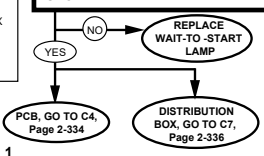

Disconnect negative battery cable before disconnecting and reconnecting protective control box/distribution box harness.
There is battery voltage at the PCB/distribution box at all times. Failure to disconnect battery cable will result in damage to equipment or injury to personnel.
-
Set the voltmeter to a DC volts scale of at least 40 volts. 2. Connect the RED lead to positive and the BLACK lead to negative. 3. Be sure to read the correct scale.
-
Connect RED clip and BLACK clip to the terminations indicated in the question. RED to the first, BLACK to the second. 2. Start Test 91, 0-4500 ohms. 3. Displayed reading is in ohms. Less than 5 ohms is continuity. If the resistance is over 4500 ohms, STE/ICE displays "9.9.9.9." It is important to connect the leads as indicated because you are checking continuity across a diode. The lamp will glow dimly because you are supplying a small amount of power thru STE/ICE-R. You may have to shade the lamp with your hand to see if it glows. NOTE A multimeter may not supply enough power to light the lamp. In this case look for a much greater resistance when measuring with the leads connected in one direction than when they are connected in reverse.
Replace harness or lamp, refer to (para. 4-17).
Instruments Circuit
- Connect RED clip to the indicated test point, BLACK clip to negative or ground. 2. Start Test 89, DC volts. 3. Displayed reading is in volts.

- Set the voltmeter to an ohms scale of about 1000 ohms. 2. Connect the RED and BLACK leads to the connections stated in the question. 3. Be sure to read the correct scale. Less than 5 ohms indicates continuity. For an open circuit, the meter should peg full scale (needle all the way to the left).

KNOWN INFO POSSIBLE PROBLEMS KNOWN INFO POSSIBLE PROBLEMS KNOWN INFO POSSIBLE PROBLEMS 2-334 Change 1 PCB/DISTRIBUTION BOX PCB/DISTRIBUTION BOX PCB/DISTRIBUTION BOX LAMP OK GLOWPLUG CONTROLLER WIRING LAMP OK GLOWPLUG CONTROLLER WIRING WIRING TO & FROM CONTROLLER OK GLOWPLUG CONTROLLER

Disconnect negative battery cable before disconnecting and reconnecting protective control box/distribution box harness.
There is battery voltage at the PCB/distribution box at all times. Failure to disconnect battery cable will result in damage to equipment or injury to personnel.
-
Connect RED clip and BLACK clip to the terminations indicated in the question. RED to the first, BLACK to the second. 2. Start Test 91, 0-4500 ohms. 3. Displayed reading is in ohms. Less than 5 ohms is continuity. If the resistance is over 4500 ohms, STE/ICE displays "9.9.9.9."
-
Set the voltmeter to an ohms scale of about 1000 ohms. 2. Connect the RED and BLACK leads to the connections stated in the question.
-
Be sure to read the correct scale. Less than 5 ohms indicates continuity. For an open circuit, the meter should peg full scale (needle all the way to the left).
Engine temperature must be below 120°F (49°C) in order to make this test, otherwise normal operation of the glowplug controller will cause the circuit to be open.
Replace harness and glowplug controller, refer to (para. 4-29).
PCB ENGINE CONNECTOR

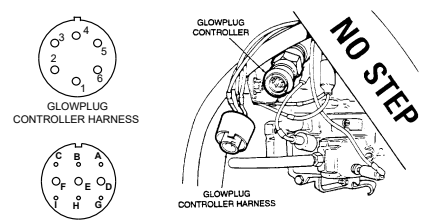
INSTRUMENTS CIRCUIT

TM 9-2320-280-20-1 REFERENCE INFORMATION

Disconnect negative battery cable before disconnecting and reconnecting protective control box/distribution box harness.
There is battery voltage at the PCB/distribution box at all times. Failure to disconnect battery cable will result in damage to equipment or injury to personnel. Engine temperature must be below 120°F (49° C) or the lamp may not come on. Replace PCB, refer to (para. 4-5). Replace distribution box (para. 4-5.1).
INSTRUMENTS CIRCUIT
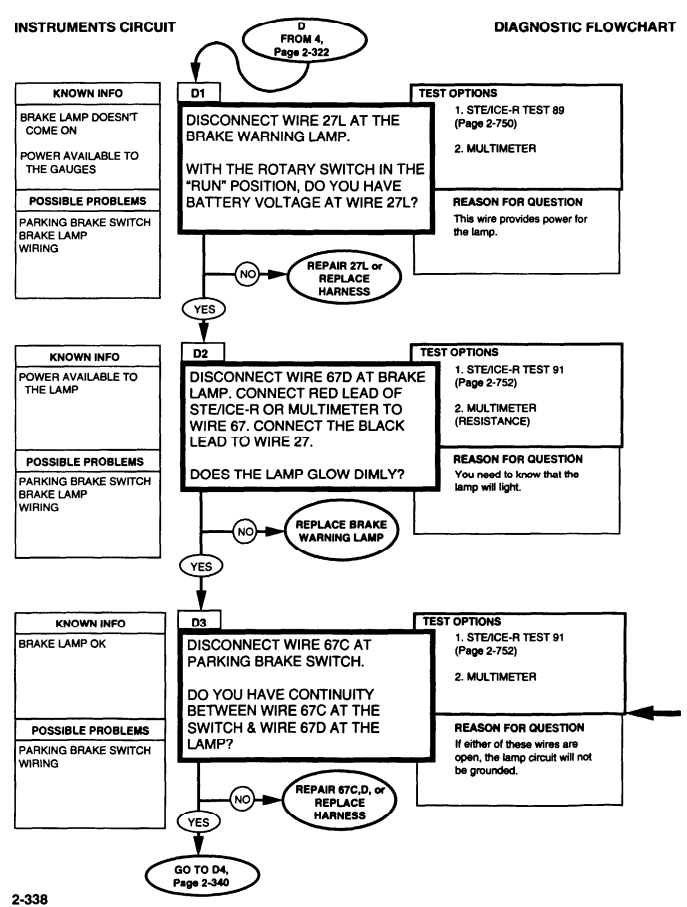
Instruments Circuit
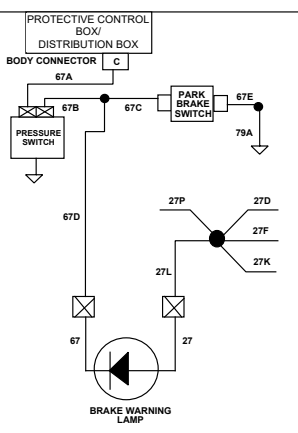

It is important to connect the leads as indicated because you are checking continuity across a diode. The lamp will glow dimly because you are supplying a small amount of power thru STE/ICE-R. You may have to shade the lamp with your hand to see if it glows.
Note
A multimeter may not supply enough power to light the lamp.
In this case look for a much greater resistance when measuring with the leads connected in one direction than when they are connected in reverse.
Replace harness/or repair wiring, refer to (para. 4-85). Replace brake warning lamp, refer to (para. 4-17).
- Connect RED clip to the indicated test point, BLACK clip to negative or ground. 2. Start Test 89, DC volts. 3. Displayed reading is in volts.
Battery Voltage Multimeter
-
Set the voltmeter to a DC volts scale of at least 40 volts. 2. Connect the RED lead to positive and the BLACK lead to negative. 3. Be sure to read the correct scale.
-
Connect RED clip and BLACK clip to the indicated terminals in the question. RED to the first, BLACK to the second. 2. Start Test 91, 0-4500 ohms.
-
Displayed reading is in ohms. Less than 5 ohms is continuity. If the resistance is over 4500 ohms, STE/ICE displays "9.9.9.9."
-
Set the voltmeter to an ohms scale of about 1000 ohms. 2. Connect the RED and BLACK leads to the connections stated in the question. 3. Be sure to read the correct scale. Less than 5 ohms indicates continuity. For an open circuit, the meter should peg full scale (needle all the way to the left).

Instruments Circuit

Reconnect all wiring. Connect the glowplug controller last.
Replace parking brake switch. Refer to (para. 4-19).
Replace harness/or repair wiring.
Refer to (para. 4-85).
-
Connect RED clip and BLACK clip to the terminations indicated in the question. RED to the first, BLACK to the second.
-
Start Test 91, 0-4500 ohms.
-
Displayed reading is in ohms. Less than 5 ohms is continuity. If the resistance is over 4500 ohms, STE/ICE displays '9.9.9.9.'
-
Set the voltmeter to an ohms scale of about 1000 ohms. 2. Connect the RED and BLACK leads to the connections stated in the question. 3. Be sure to read the correct scale. Less than 5 ohms indicates continuity. For an open circuit, the meter should peg full scale (needle all the way to the left).
KNOWN INFO BRAKE WARNING LIGHT WON'T GO OFF POSSIBLE PROBLEMS WIRING PARKING BRAKE SWITCH PCB/DISTRIBUTION BOX BRAKE WARNING
INSTRUMENTS CIRCUIT DIAGNOSTIC FLOWCHART

PRESSURE SWITCH END OF TEST TEST OPTIONS NONE REASON FOR QUESTION If the lamp stays on, it could be that the hydraulic brake system has a fault and might require bleeding.
KNOWN INFO BRAKE WARNING LIGHT WON'T GO OFF DISCONNECT WIRE 67A AND 67B FROM BRAKE WARNING PRESSURE SWITCH, WIRE 67C FROM PARKING BRAKE SWITCH. DISCONNECT THE PCB/DISTRIBUTION BOX BODY HARNESS CONNECTOR. CONNECT A JUMPER WIRE BETWEEN WIRES TEST OPTIONS
- STE/ICE-R TEST 89 (Page 2-750)
- MULTIMETER REASON FOR QUESTION If the lamp stays on with the PCB/distribution box, valve switch and park brake switch disconnected, the problem is in the wiring.
POSSIBLE PROBLEMS WIRING PARKING BRAKE SWITCH PCB/DISTRIBUTION BOX BRAKE WARNING PRESSURE SWITCH
67A AND 67B. DOES THE LIGHT GO

TEST OPTIONS KNOWN INFO TEST OPTIONS
- STE/ICE-R TEST 91 (Page 2-752) 2. MULTIMETER (RESISTANCE) REASON FOR QUESTION When the protective control box/distribution box is connected, the light should not come on. If it does, the PCB/distribution box is faulty.
WIRING OK POSSIBLE PROBLEMS BRAKE WARNING PRESSURE SWITCH PCB/DISTRIBUTION BOX PARKING BRAKE SWITCH

Bleed brake system. Refer to (para. 7-10). Replace parking brake switch. Refer to (para. 4-19). Replace harness/or repair wiring.
Refer to (para. 4-85).
Replace PCB. Refer to (para. 4-5). Replace distribution box (para. 4-5.1).
Instruments Circuit 0-45 Ohms Ste/Ice-R Test 89
- Connect RED clip to the indicated test point, BLACK clip to negative or ground. 2. Start Test 89, DC volts. 3. Displayed reading is in volts.
Battery Voltage Multimeter
-
Set the voltmeter to a DC volts scale of at least 40 volts. 2. Connect the RED lead to positive and the BLACK lead to the negative.
-
Be sure to read the correct scale.
-
Connect RED clip and BLACK clip to the terminations indicated in the question. RED to the first, BLACK to the second. 2. Start Test 91, 0-4500 ohms. 3. Displayed reading is in ohms. Less than 5 ohms is continuity. If the resistance is over 4500 ohms, STE/ICE displays '9.9.9.9.'
-
Set the voltmeter to an ohms scale of about 1000 ohms. 2. Connect the RED and BLACK leads to the connections stated in the question. 3. Be sure to read the correct scale. Less than 5 ohms indicates continuity. For an open circuit, the meter should peg full scale (needle all the way to the left).
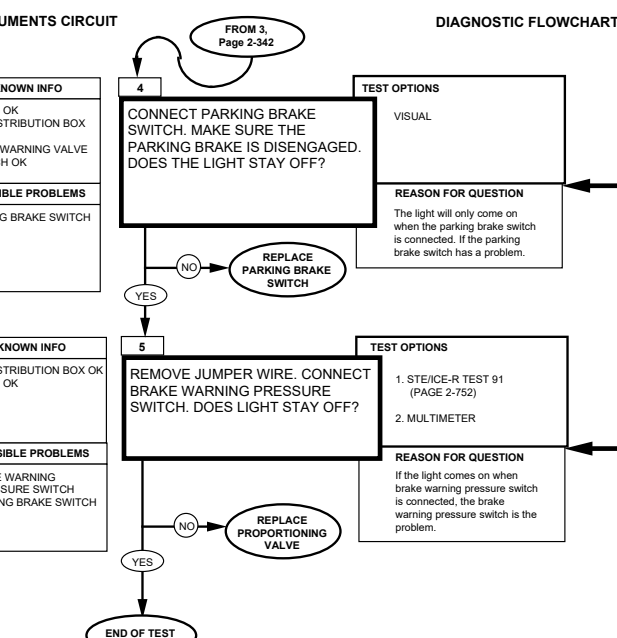
PARKING BRAKE SWITCH PCB/DISTRIBUTION BOX BRAKE WARNING VALVE BRAKE WARNING PRESSURE SWITCH WIRING OK OK SWITCH OK WIRING OK INSTRUMENTS CIRCUIT REFERENCE INFORMATION Replace parking brake switch, refer to (para. 4-19).
When the brake waming pressure switch is defective, the proportioning valve must be replaced. Refer to (para. 7-18).
-
Connect RED clip and BLACK clip to the terminations indicated in the question. RED to the first, BLACK to the second.
-
Start Test 91, 0-4500 ohms. 3. Displayed reading is in ohms. Less than 5 ohms is continuity. If the resistance is over 4500 ohms, STE/ICE displays "9.9.9.9."
-
Set the voltmeter to an ohms scale of about 1000 ohms.
-
Connect the RED and BLACK leads to the connections stated in the question. 3. Be sure to read the correct scale. Less than 5 ohms indicates continuity. For an open circuit, the meter should peg full scale (needle all the way to the left).

Reference Information Instruments Circuit 0-45 Dc Volts Steace-R Test 89
-
Connect RED clip to the indicated test point, BLACK clip to negative or ground.
-
Start Test 89, DC volts. 3. Displayed reading is in volts.
Battery Voltage Multimeter
-
Set the voltmeter to a DC volts scale of at least 40 volts.
-
Connect the RED lead to positive and the BLACK lead to negative.
-
Be sure to read the correct scale.
-
Connect RED clip and BLACK clip to the indicated terminals in the question. RED to the first, BLACK to the second.
-
Start Test 91, 0-4500 ohms.
-
Displayed reading is in ohms. Less than 5 ohms is continuity. If the resistance is over 4500 ohms, STE/ICE displays "9.9.9.9."
-
Set the voltmeter to an ohms scale of about 1000 ohms.
-
Connect the RED and BLACK leads to the connections stated in the question.
-
Be sure to read the correct scale. Less than 5 ohms indicates continuity. For an open circuit, the meter should peg full scale (needle all the way to the left).
Replace hamess/or repair wiring, refer to (para 4-85).
Replace hamess/or repair wiring, refer to (para 4-85).
Be sure the charging system is functioning properly before replacing the gauge. Run the altemator tests, page 2-196, if you're not sure.
Replace volt gauge, refer to (para 4-13).

Reference Information Instruments Circuit
-
Connect RED clip to the indicated test point, BLACK clip to negative or ground.
-
Start Test 89, DC volts.
-
Displayed reading is in volts.
Battery Voltage Multimeter
-
Set the voltmeter to a DC volts scale of at least 40 volts.
-
Connect the RED lead to positive and the BLACK lead to negative.
-
Be sure to read the correct scale.
-
Connect RED clip and BLACK clip to the indicated terminals in the question. RED to the first, BLACK to the second. 2. Start Test 91, 0-4500 ohms.
-
Displayed reading is in ohms. Less than 5 ohms is continuity. If the resistance is over 4500 ohms, STE/ICE-R displays "9.9.9.9."
-
Set the voltmeter to an ohms scale of about 1000 ohms.
-
Connect the RED and BLACK leads to the connections stated in the question.
-
Be sure to read the correct scale. Less than 5 ohms indicates continuity. For an open circuit, the meter should peg fuil scale (needle all the way to the left).
Replace wiper motor SF5578716.
Refer to (para. 10-71.)

Reference Information
Instruments Circuits
Replace wiper switch, refer to (para. 10-72.)

connections stated in the question.
- Be sure to read the correct scale. Less than 5 ohms indicates continuity. For an open circuit, the meter should peg full scale (needle all the way to the left).
Replace wiper switch,
 refer to (para. 10-72.)
refer to (para. 10-72.)

Replace wiper switch,

refer to (para. 10-72.) Replace wiper motor, refer to (para. 10-72.)


Reference Information Instruments Circuit 0-45 Dc Volts Steace-R Test 89
-
Connect RED clip to the indicated test point, BLACK clip to negative or ground.
-
Start Test 89, DC volts.
-
Displayed reading is in volts.
Battery Voltage Multimeter
-
Set the voltmeter to a DC volts scale of at least 40 volts. 2. Connect the RED lead to positive and the BLACK lead to negative. 3. Be sure to read the correct scale.
-
Connect RED clip and BLACK clip to the indicated terminals in the question. RED to the first, BLACK to the second.
-
Start Test 91, 0-4500 ohms.
-
Displayed reading is in ohms. Less than 5 ohms is continuity. If the resistance is over 4500 ohms, STE/ICE displays "9.9.9.9."
-
Set the voltmeter to an ohms scale of about 1000 ohms. 2. Connect the RED and BLACK leads to the connections stated in the question.
-
Be sure to read the correct scale. Less than 5 ohms indicates continuity. For an open circuit, the meter should peg full scale (needle all the way to the left).
Replace hamess/or repair wiring, refer to (para 4-85).
Replace hamess/or repair wiring, refer to (para 4-85).

REFERENCE INFORMATION INSTRUMENTS CIRCUIT
Replace fuel gauge,refer to (para 4-13).


Replace fuel gauge, refer to (para 4-13).



2-356
Reference Information Instruments Circuit 0-45 Dc Volts Steace-R Test 89
-
Connect RED clip to the indicated test point, BLACK clip to negative or ground.
-
Start Test 89, DC volts.
-
Displayed reading is in volts.
Replace hamess/or repair wiring, refer to (para 4-85).
Battery Voltage Multimeter
-
Set the voltmeter to a DC volts scale of at least 40 volts.
-
Connect the RED lead to positive and the BLACK lead to negative. 3. Be sure to read the correct scale.
-
Connect RED clip and BLACK clip to the indicated terminals in the question. RED to the first, BLACK to the second. 2. Start Test 91, 0-4500 ohms.
-
Displayed reading is in ohms. Less than 5 ohms is continuity. If the resistance is over 4500 ohms, STE/ICE displays "9.9.9.9." Replace hamess/or repair wiring, refer to (para 4-85).
-
Set the voltmeter to an ohms scale of about 1000 ohms.
-
Connect the RED and BLACK leads to the connections stated in the question. 3. Be sure to read the correct scale. Less than 5 ohms indicates continuity. For an open circuit, the meter should peg full scale (needle all the way to the left).

Replace hamess/or repair wiring, refer to (para 4-85).
DIF PRESSURE SENDING UNIT

INSTRUMENTS CIRCUIT Make sure wire 36A is not connected
 to the sending unit and is not touching anything metal that could cause the wire to be grounded.
to the sending unit and is not touching anything metal that could cause the wire to be grounded.
Replace oil pressure gauge, refer to (para 4-13).
Wire 36A must be connected at the

gauge. Short the wire at the sending unit to ground.
Replace oil pressure gauge, refer to (para 4-13).
Replace oil pressure sending unit, refer to

(para 4-25).

THE GAUGES DOESN'T WORK.
SENDING UNIT HAS POWER.
SENDING UNIT SENDING UNIT GAUGE WIRING GAUGE WIRING WIRING
Reference Information Instruments Circuit 0-45 Dc Volts Steace-R Test 89
-
Connect RED clip to the indicated test point, BLACK clip to negative or ground. 2. Start Test 89, DC volts.
-
Displayed reading is in volts.
-
Set the voltmeter to an ohms scale of about 1000 ohms.
-
Connect the RED and BLACK leads to the connections stated in the question.
-
Be sure to read the correct scale. Less than 5 ohms indicates continuity. For an open circuit, the meter should peg full scale (needle all the way to the left).

Replace hamess/or repair wiring, refer to (para 4-85).
Replace hamess/or repair wiring, refer to (para 4-85).
- Connect RED clip and BLACK clip to the indicated terminals in the question. RED to the first, BLACK to the second. 2. Start Test 91, 0-4500 ohms. 3. Displayed reading is in ohms. Less than 5 ohms is continuity. If the resistance is over 4500 ohms, STE/ICE displays "9.9.9.9." Replace hamess/or repair wiring, refer to (para 4-85).
Battery Voltage Multimeter
-
Set the voltmeter to a DC volts scale of at least 40 volts.
-
Connect the RED lead to positive and the BLACK lead to negative.
-
Be sure to read the correct scale.
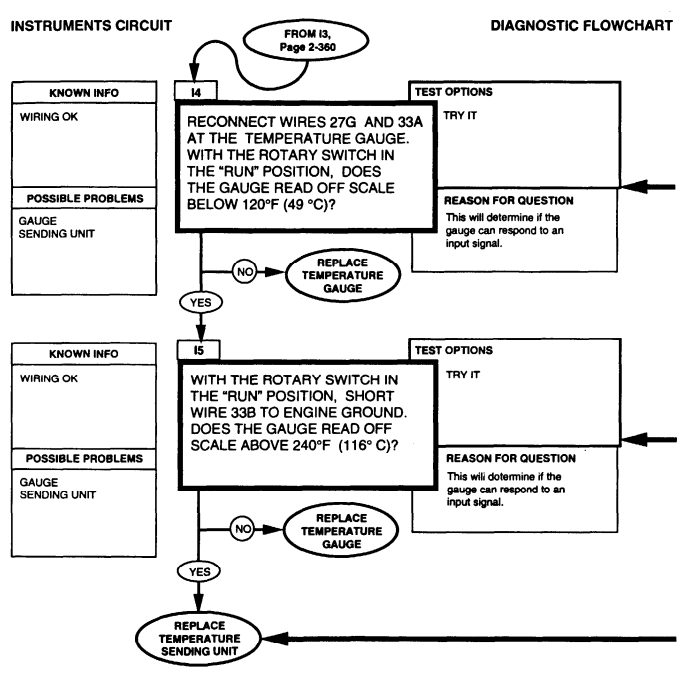
INSTRUMENTS CIRCUIT Make sure wire 33B is not connected to


the sending unit and is not touching anything metal that could cause the wire to be grounded.
Replace temperature gauge, refer to (para 4-13).
(para 4-13).
Replace temperature gauge, refer to



(para 4-24).




Reference Information Instruments Circuit 0-45 Dc Volts Steace-R Test 89
-
Connect RED clip to the indicated test point, BLACK clip to negative or ground.
-
Start Test 89, DC volts.
-
Displayed reading is in volts.
Battery Voltage Multimeter
-
Set the voltmeter to a DC volts scale of at least 40 volts.
-
Connect the RED lead to positive and the BLACK lead to negative.
-
Be sure to read the correct scale.
-
Connect RED clip and BLACK clip to the indicated terminals in the question. RED to the first, BLACK to the second.
-
Start Test 91, 0-4500 ohms.
-
Displayed reading is in ohms. Less than 5 ohms is continuity. If the resistance is over 4500 ohms, STE/ICE displays "9.9.9.9."
-
Set the voltmeter to an ohms scale of about 1000 ohms.
-
Connect the RED and BLACK leads to the connections stated in the question.
-
Be sure to read the correct scale. Less than 5 ohms indicates continuity. For an open circuit, the meter should peg full scale (needle all the way to the left).
Replace hamess/or repair wiring, refer to (para 4-85).
Replace rotary switch, refer to (para 4-7).


Instruments Circuit
-
Connect RED clip and BLACK clip to the indicated terminals in the question. RED to the first, BLACK to the second.
-
Start Test 91, 0-4500 ohms.
-
Displayed reading is in ohms. Less than 5 ohms is continuity. If the resistance is over 4500 ohms, STE/ICE displays "9.9.9.9."
-
Set the voltmeter to an ohms scale of about 1000 ohms.
-
Connect the RED and BLACK leads to the connections stated in the question.
-
Be sure to read the correct scale. Less than 5 ohms indicates continuity. For an open circuit, the meter should peg full scale (needle all the way to the left).
The connector is located above the driveshaft toward the rear of the vehicle.

| GAUGE READING | OHMS |
|---|---|
| FULL | 35 |
| HALF | 16 |
| EMPTY | 0 |

In order to reach these wires and the sending unit you have to remove the fuel tank. You may want to recheck the previous steps to be sure you didn't miss anything before you proceed with this step. Replace fuel level sending unit and repair wiring, refer to (para 4-28 and 4-85).
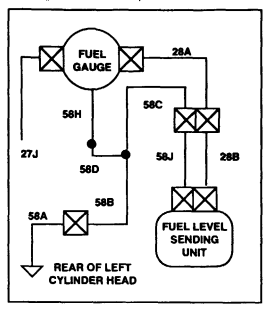
Instruments Circuit
0-4500 Ohms
Steace-R Test 91
-
Connect RED clip and BLACK clip to the indicated terminals in the question. RED to the first, BLACK to the second.
-
Start Test 91, 0-4500 ohms.
-
Displayed reading is in ohms. Less than 5 ohms is continuity. If the resistance is over 4500 ohms, STE/ICE displays "9.9.9.9."
-
Set the voltmeter to an ohms scale of about 1000 ohms.
-
Connect the RED and BLACK leads to the connections stated in the question.
-
Be sure to read the correct scale. Less than 5 ohms indicates continuity. For an open circuit, the meter should peg full scale (needle all the way to the left).


Reference Information Instruments Circuit
Make sure these contacts are clean otherwise the wiper motor may not have power or ground.
If you experience intermittent problems with the wiper motor on your vehicle, inspect the terminals and the rubber grommet of the contact assembly. If the terminals are dirty or corroded, clean or replace as required. If the grommet shows signs of damage or deformity, replace the contact assembly (TM 9-2320-280-24P).
Replace harness or repair wiring, refer to (para 4-85).
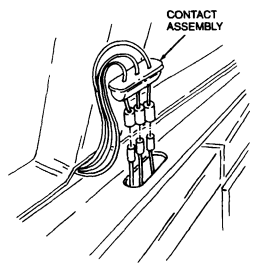
-
Connect RED clip to the indicated test point, BLACK clip to negative or ground.
-
Start Test 89, DC volts.
-
Displayed reading is in volts.
Battery Voltage Multimeter
-
Set the voltmeter to a DC volts scale of at least 40 volts.
-
Connect the RED lead to positive and the BLACK lead to negative.
-
Be sure to read the correct scale.
0-4500 Ohms
Steace-R Test 91
-
Connect RED clip and BLACK clip to the indicated terminals in the question. RED to the first, BLACK to the second.
-
Start Test 91, 0-4500 ohms.
-
Displayed reading is in ohms. Less than 5 ohms is continuity. If the resistance is over 4500 ohms, STE/ICE displays "9.9.9.9." Replace hamess/or repair wiring, refer to (para 4-85).

WINDSHIELD CONNECTOR AS VIEWED FROM ABOVE
Continuity (Resistance)
Multimeter
-
Set the voltmeter to an ohms scale of about 1000 ohms.
-
Connect the RED and BLACK leads to the connections stated in the question.
-
Be sure to read the correct scale. Less than 5 ohms indicates continuity. For an open circuit, the meter should peg full scale (needle all the way to the left).

Reference Information Instruments Circuit 0-4500 Ohms Steace-R Test 91
-
Connect RED clip and BLACK clip to the indicated terminals in the question. RED to the first, BLACK to the second.
-
Start Test 91, 0-4500 ohms.
-
Displayed reading is in ohms. Less than 5 ohms is continuity. If the resistance is over 4500 ohms, STE/ICE displays "9.9.9.9." Make sure these contacts are clean otherwise the wiper motor may not have power or ground.
Replace hamess/or repair wiring, refer to (para 4-85).
-
Set the voltmeter to an ohms scale of about 1000 ohms.
-
Connect the RED and BLACK leads to the connections stated in the question.
-
Be sure to read the correct scale. Less than 5 ohms indicates continuity. For an open circuit, the meter should peg full scale (needle all the way to the left).

WINDSHIELD CONNECTOR AS VIEWED FROM ABOVE
Replace harness/or repair winng, refer to (para 4-85).

REFERENCE INFORMATION INSTRUMENTS CIRCUIT

You can provide enough vacuum to operate the gauge by sucking on the line.
Replace vacuum line, refer to (para 3-19).
Replace gauge, refer to (para 3-17).

Instruments Circuit
KNOWN INFO AIR FILTER RESTRICTION GAUGE OK VACUUM TUBE OK POSSIBLE PROBLEMS WIRING SWITCH MOTOR CIRCUIT BREAKER #1 РСВ KNOWN INFO WIRE 27C OK POSSIBLE PROBLEMS WIRING SWITCH MOTOR CIRCUIT BREAKER #1 PCB KNOWN INFO WIRE 27C OK WIRE 27D OK CIRCUIT BREAKER #1 OK POSSIBLE PROBLEMS WIRING SWITCH MOTOR РСВ

2-376 GO TO P4, Page 2-378
INSTRUMENTS CIRCUIT The easiest way to reach the circuit breaker is to remove the gauge panel screws and pull the panel out far enough to work with the wiring.
-
Connect RED clip to the indicated test point, BLACK clip to negative or ground.
-
Start Test 89, DC volts. 3. Displayed reading is in volts.
Battery Voltage Multimeter
-
Set the voltmeter to a DC volts scale of at least 40 volts.
-
Connect the RED lead to positive and the BLACK lead to negative. 3. Be sure to read the correct scale.
The heater motor is located directly in front of the passenger seat under the dashboard, connected to the heating ducts.



Reference Information Instruments Circuit 0-4500 Ohms Ste/Ice-R Test 91 I
-
Connect RED clip and BLACK clip to the indicated terminals in the question. RED to the first, BLACK to the second. 2. Start Test 91, 0-4500 ohms.
-
Displayed reading is in ohms. Lees then 5 ohms is continuity. It the resistance is over 4500 ohms, STE/ICE displays "9.9.9.9."
-
Set the voltmeter to an ohms scale of about 1000 ohms. 2. Connect the RED and BLACK leads to the connections stated in the question. 3. Be sure to read the correct scale. Less than 5 ohms indicates continuity. For an open circuit, the meter should peg full scale (needle all the way to the left).

Instruments Circuit
-
Connect RED clip to the indicated test point, BLACK clip to negative or ground.
-
Start Test 89, DC volts. 3. Displayed reading is in volts.
Replace harness/or repair wiring, refer to (para 4-85).
Battery Voltage Multimeter
1.Set the voltmeter to a DC volts scale of at least 40 volts.
-
Connect the RED lead to positive and the BLACK lead to negative.
-
Be sure to read the correct scale.
I I

Reference Information Instruments Circuit 0-4500 Ohms Steace-R Test 91
-
Connect RED clip and BLACK clip to the indicated test points in the question. RED to the first, BLACK to the second. 2. Start Test 91, 0-4500 ohms.
-
Displayed reading is in ohms. Less than 5 ohms is continuity. If the resistance is over 4500 ohms, STE/ICE displays "9.9.9.9."
-
Set the voltmeter to an ohms scale of about 1000 ohms. 2. Connect the RED and BLACK leads to the connections stated in the question.
-
Be sure to read the correct scale. Less than 5 ohms indicates continuity. For an open circuit, the meter should peg full scale (needle all the way to the left).
Replace harness or repair wiring, refer to (para 4-85).

Reference Information Instruments Circuit 0-4500 Ohms Steace-R Test 91
-
Connect RED clip and BLACK clip to the indicated test points in the question. RED to the first, BLACK to the second.
-
Start Test 91, 0-4500 ohms.
Repair wire or replace harness, refer to (para 4-85).
-
Displayed reading is in ohms. Less than 5 ohms is continuity. If the resistance is over 4500 ohms, STE/ICE displays "9.9.9."
-
Set the voltmeter to an ohms scale of about 1000 ohms.
-
Connect the RED and BLACK leads to the connections stated in the question.
-
Be sure to read the correct scale. Less than 5 ohms indicates continuity. For an open circuit, the meter should peg full scale (needle all the way to the left).
 Instruments Circuit Reference Information
Instruments Circuit Reference Information

Disconnect negative battery cable before disconnecting and reconnecting protective control box hamess.
There is battery voltage at the PCB at all times. Failure to disconnect battery cable will result in damage to equipment or injury to personnel. Replace harness or repair wiring, refer to (para 4-85).

Disconnect negative battery cable before disconnecting and reconnecting protective control box hamess.
There is battery voltage at the PCB at all times. Failure to disconnect battery cable will result in damage to equipment or injury to personnel.
Replace the PCB, refer to (para 4-5).
-
Connect RED clip and BLACK clip to the indicated terminals in the question. RED to the first, BLACK to the second.
-
Start Test 91, 0-4500 ohms.
-
Displayed reading is in ohms. Less than 5 ohms is continuity. If the resistance is over 4500 ohms, STE/ICE displays "9.9.9.9."
-
Set the voltmeter to an ohms scale of about 1000 ohms.
-
Connect the RED and BLACK leads to the connections stated in the question. 3. Be sure to read the correct scale. Less than 5 ohms indicates continuity. For an open circuit, the meter should peg full scale (needle all the way to the left).
2-33. Light Tests
The Lights paragraph has almost no flow chart to guide you through a problem. This is because there aren't very many problems that can occur. The most common problems are burned-out bulbs and loose or corroded connections. Aside from bulbs and wiring, the only components are the PCB and the lights switch. If either of these is found to be faulty, you just replace the bad unit. On the following pages you will find diagrams of the major portions of the Lights Circuit. These are designed to help you isolate a problem without wasting too much time.
2-389
Lights Diagnostic Flowchart

socket, there may be a fault in the wiring harness.
b) Check for continuity to ground (STE/ICE-R TEST 91, P2-752) from the light socket, there may be a missing connection to ground.
c)
Go to the wiring diagram(s) for more help.
Reference Information Lights

DISCONNECT NEGATIVE BATTERY CABLE BEFORE DISCONNECTING AND RECONNECTING PROTECTIVE CONTROL BOX HARNESS.
There is battery voltage at the PCB at all times. Failure to disconnect battery cable will result in damage to equipment or injury to personnel.

PCB BODY CONNECTOR LIGHT SWITCH
CONNECTOR HARNESS
-
Connect RED clip and BLACK clip to the indicated terminals in the question.
-
Start Test 91, 0-4500 ohms. 3. Displayed reading is in ohms. Less than 5 ohms is continuity. If the resistance is over 4500 ohms, STE/ICE displays "9.9.9.9."
-
Connect RED clip to positive, BLACK clip to negative or ground.
-
Start Test 89, DC volts.
-
Displayed reading is in volts.
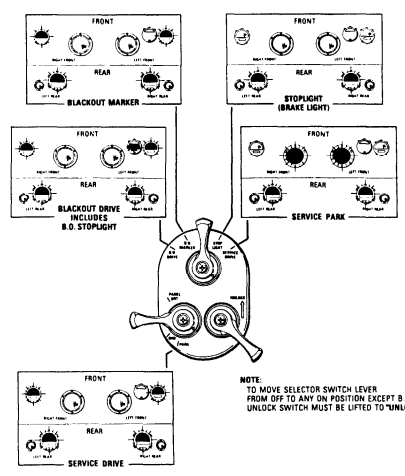
LIGHTS REAR LIGHTS (NOT INCLUDING BACKUP LAMPS AND SIDE MARKERS)

WHEN CHECKING FOR VOLTAGE, MAKE SURE THAT THE LAMP YOU ARE CHECKING IS SUPPOSED TO BE ON (CHECK THE LIGHTS SWITCH, TURN SIGNAL SWITCH, TRANSMISSION, ETC.).
CAUTION DISCONNECT NEGATIVE BATTERY CABLE PRIOR TO MAKING CONTINUITY MEASUREMENTS 2.
CHECK CONTINUITY TO BODY GROUND.
LIGHTS BACKUP LAMPS AND REAR SIDE MARKERS
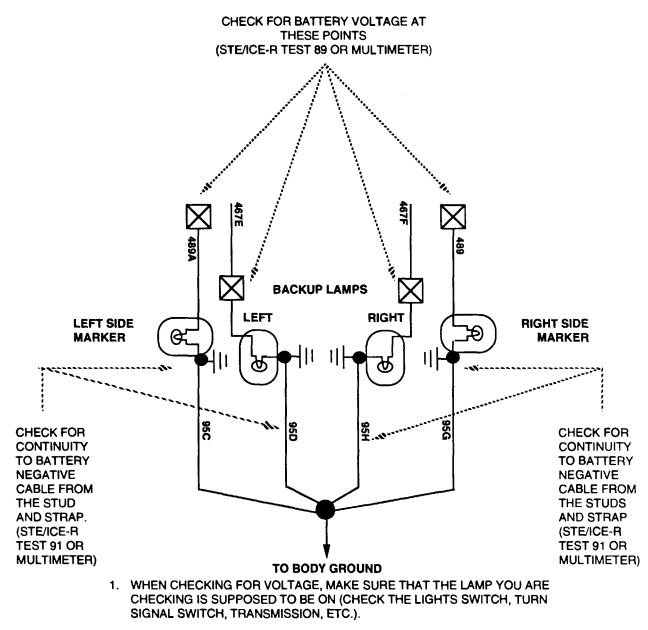
CAUTION DISCONNECT NEGATIVE BATTERY CABLE PRIOR TO MAKING CONTINUITY MEASUREMENTS 2. CHECK CONTINUITY TO BODY GROUND.
LIGHTS FRONT LIGHTS (PARK LIGHTS, TURN SIGNAL LAMPS, BLACKOUT MARKERS)

- WHEN CHECKING FOR VOLTAGE, MAKE SURE THAT THE LAMP YOU ARE CHECKING IS SUPPOSED TO BE ON (CHECK THE LIGHTS SWITCH, TURN SIGNAL SWITCH, TRANSMISSION, ETC.).
CAUTION DISCONNECT NEGATIVE BATTERY CABLE PRIOR TO MAKING CONTINUITY MEASUREMENTS.
- CHECK CONTINUITY TO BODY GROUND.
FRONT LIGHTS HEADLAMPS, BLACKOUT DRIVING LAMP, SIDE MARKERS

- WHEN CHECKING FOR VOLTAGE, MAKE SURE THAT THE LAMP YOU ARE CHECKING IS SUPPOSED TO BE ON (CHECK THE LIGHTS SWITCH, TURN SIGNAL SWITCH, TRANSMISSION, ETC.).
CAUTION DISCONNECT NEGATIVE BATTERY CABLE PRIOR TO MAKING CONTINUITY MEASUREMENTS.
- CHECK CONTINUITY TO BODY GROUND.
LIGHTS LIGHTS
Turn Signal Switch


SUMMARY OF CONNECTIONS: TERMINAL CONNECTION WIRE NUMBER
| ERMINAL UNNECTION | WIRE NUMB | |
|---|---|---|
| A | RIGHT FRONT TURN SIGNAL | 460A |
| B | LEFT FRONT TURN SIGNAL | 461A |
| C | LEFT REAR TURN SIGNAL/STOP LAMP | 22-461A |
| D | LIGHT SWITCH TERMINAL "C" | 22A |
| 는 | RIGHT REAR TURN SIGNAL | 22-460A |
| F | HAZARD/TURN SIGNAL FLASHER TERM. "B" 325B | |
| G | LIGHT SWITCH TERMINAL "J" (24 VOLTS) | 467B |
| H | HAZARD/TURN SIGNAL FLASHER TERM. "A" 325A |
CAUTION DISCONNECT NEGATIVE BATTERY CABLE PRIOR TO MAKING CONTINUITY MEASUREMENTS.
Turn Signal Switch Lights
-
WITH THE SWITCH IN THE 'LEFT" POSITION, YOU SHOULD HAVE CONTINUITY FROM PIN "H" TO PINS "B" AND "C", PIN "D" TO "E", AND PIN "F" TO "G".
-
WITH THE SWITCH IN THE "RIGHT" POSITION, YOU SHOULD HAVE CONTINUITY FROM PIN "H" TO PINS "A" AND "E", PIN "C" TO "D", AND PIN "F TO "G".

NOTE
-
IF VEHICLE IS EQUIPPED WITH BRAKE LIGHT OVERRIDE DIRECTIONAL SIGNAL CONTROL ASSEMBLY (P/N12339312-1), REFER TO STEP 3.
-
IF VEHICLE IS EQUIPPED WITH DIRECTIONAL SIGNAL CONTROL ASSEMBLY (P/N 12339312), REFER TO STEP 4.
-
WITH SWITCH IN HAZARD POSITION, YOU SHOULD HAVE CONTINUITY FROM PIN H TO PINS "A", "B", "C", "D", AND "E" AND PIN "F" TO "G".
-
WITH SWITCH IN HAZARD POSITION, YOU SHOULD HAVE CONTINUITY FROM PIN H TO PINS "A", "B", "C". AND "E" AND PIN "F" TO "G".
2-34. Transmission System Tests (3L80)
These Transmission System tests may be run any time you think you have a transmission problem or if you were sent hereby another test chain. Just follow the path, answering the questions. Additional information and notes are given on the facing page when necessary.
(4L80-E) Transmission system tests, refer to (para. 2-35).
Fold-out page FO-12 may be left open for reference while testing.

MODULATOR TRANSMISSION MODULATOR TRANSMISSION SHIFTER OK MODULATOR TRANSMISSION
(3L80)
NOTHING FLUID SHIFTER FLUID OK SHIFTER FLUID OK 2-400
TRANSMISSION SYSTEM

(3L80) Procedure for checking transmission fluid 1. Start engine. 2. Hold down brake pedal and move transmission shift lever through all ranges including reverse. Leave the lever in each range for 2 seconds. 3. Engage parking brake and place shift lever in neutral. Check fluid level on dipstick. 4. Proper level is between FULL and ADD marks on dipstick.
Note
Check fluid for a burnt smell, grit, discoloration, air bubbles, or a milky appearance.
- Burnt smell, discoloration, or grit indicates worn or damaged internal components. Notify DS maintenance. - Bubbles indicate an overfilled system or air leaks in the system. Drain the fluid and refill to proper level. Refer to (para 5-2). - Milky appearance is due to water in the system. Change the fluid and filter. - Check fill tube for indications of fluid being blown out. If fluid is being blown out, check vent line for obstructions, and refill transmission to proper level. Refer to (para 5-2). - Transmission fluid coming out of dipstick filler tube indicates a restriction in the ventilation system. Check for clogged, melted, or crushed lines and/or fittings between transmission and atmosphere vent on air cleaner canister. Replace where needed. Refer to (para 5-16).
Road Test Procedure
1.Position transmission shift lever in "D" (drive) and accelerate vehicle from 0 mph. A 1-2 and 2-3 shift should occur at all throttle openings. Allow vehicle to coast down to about 0 mph and 3-2 and 2-1 shifts should occur. 2.Position transmission shift lever in "2" (low two) and accelerate vehicle from 0 mph. A 1-2 shift should occur at all throttle openings. No 2-3 shift can be obtained in this range. A 1-2 shift in 2 is somewhat firmer than in "D". This is normal. 3.Position shift lever in "1" and accelerate the vehicle from 0 mph. No upshifts should occur in this range. 4.Position shift lever in "D" and with the vehicle speed at approximately 35 mph, close throttle and move lever to "2". Transmission should downshift to 2nd gear. An increase in engine rpm and engine braking effect should be noticed. 5.Position shift lever "2" and with the vehicle speed at approximately 25 mph, close thethrottle and move lever to "1". Transmission should downshift to 1st gear. An increase in engine RPM and engine braking effect should be noticed. 6. Position shift lever in "R" and check for reverse operation. 7. Hard shifting may be indicative of an underfilled or clogged system. The kickdown system is used to shift the transmission to a lower gear under heavy acceleration. The system also disengages the engine cooling fan so as to allow maximum engine power to be used for moving the vehicle.

REFERENCE INFORMATION TRANSMISSION SYSTEM
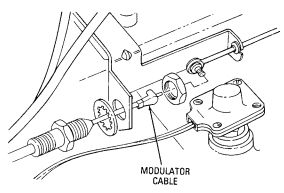
(3L80) Replace transmission modulator, refer to (para. 5-14).
Ste/Ice-R Test #50
0 To 1000 Psig Pressure Interleaved With Rpm
- Connect blue pressure transducer (1000 PSI) to system under test, and other end to a W4 cable. Make sure the system under test is not pressurized. 2. Dial 01 into VTM, and then 50 when prompted. 3. Perform offset test. 4. Start engine and VTM will display pressure interleaved with RPM.
Transmission Oil Pressure Test
-
Remove plug from pressure port on left side of transmission. 2. Connect transducer to port using appropriate fittings. 3. Perform offset test. 4. Start engine and check for leaks at connections. 5. Bring engine to operating temperature. 6. Place shift lever in N and bring engine to 1000 RPM (STE/ICE-R test 10). Pressure should be 55-70 psi (379-483 kPa). If not notify DS Maintenance. 7. Apply service brakes and place shifter in D. Operate engine at 1000 RPM. Pressure should be 60-90 psi (414-621 kPa). If not, notify DS Maintenance. 8. Apply brakes and place lever in 2. With engine at 1000 RPM, pressure should be 135-160 psi (931- 1103 kPa). If not, notify DS Maintenance.
-
Apply brakes and place lever in 1. With engine at 1000 RPM, pressure should be 135-160 psi (931-1103 kPa). If not, notify DS Maintenance. 10. Apply brakes and place lever in R. With engine at 1000 RPM, pressure should be 95-150 psi (655-1034 kPa). If not, notify DS Maintenance.
-
Apply brakes and place lever in D. With engine idling, pressure should be 60-85 psi (414-586 kPa). If not, notify DS Maintenance.
Note
NEXT TEST MUST BE PERFORMED DURING A ROAD TEST OR WITH VEHICLE RAISED AND TIRES OFF THE GROUND. RECORD PRESSURE WITH THROTTLE CLOSED.
- Place lever in D and take foot off brake. With engine at 2000 RPM, close throttle and read pressure between 1200 and 2000 RPM. Pressure should be 65-70 psi (448-485 kPa). If not, notify DS Maintenance. 13. Shut off engine, remove transducer and reinstall plug.

REFERENCE INFORMATION TRANSMISSION SYSTEM (3L80) lf the drivetrain system checks out OK, the
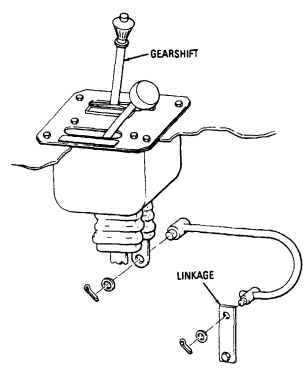
problem is either the transmission itself, the shifter or the modulator. The DRIVETRAIN tests are located in (para. 2-38) of this manual.
Make sure that the detents in the shifter correspond to the shift posittions shown on the plate. Have an assistant move the shifter and look to see that the linkage is moving at the transmission.
Linkage repair and adjustment procedures are shown in (para. 5-12).
Look for a modulator problem if fhe vehicle was not shifting, or wee not shifting as well as it should be.
NOTE Run the BRAKES and DRIVETRAIN tests in this manual. If you don't find any faults, notify DS maintenance.
(3L80)

WIRING 2-406
TRANSMISSION SYSTEM (3L80) A NO answer here means the kickdown works with the time delay module disconnected.

-
Connect RED clip and BLACK clip to the test points indicated in the question. RED to the first, BLACK to the second.
-
Start Test 91, 0-4500 ohms.
-
Displayed reading is in ohms. Less than 5 ohms is continuity. If the resistance is over 4500 ohms, STE/ICE displays "9.9.9.9." A measurement of zero or infinity means the solenoid is no good.
-
Set the voltmeter to an ohms scale of about 1000 ohms.
-
Connect the RED and BLACK leads to the connections stated in the question.
-
Be sure to read the correct scale. Less than 5 ohms indicates continuity. For an open circuit, the meter should peg full scale (needle all the way to the left).

Reference Information Transmission System (3L80)
0-4500 Ohms
Steace-R Test 91
-
Connect RED clip and BLACK clip to the indicated terminals in the question. RED to the first, BLACK to the second.
-
Start Test 91, 0-4500 ohms.
-
Displayed reading is in ohms. Less than 5 ohms is continuity. If the resistance is over 4500 ohms, STE/ICE displays "9.9.9.9." Repair or raplace of wiring, refer to (para 4-85).
-
Set the voltmeter to an ohms scale of about 1000 ohms.
-
Connect the RED and BLACK leads to the connections stated in the question.
-
Be sure to read the correct scale. Less than 5 ohms indicates continuity. For an open circuit, the meter should peg full scale (needle all the way to the left).

There should be continuity when the injector pump is wide open, and an open circuit when it isn't. Check out both positions.
Adjust or replace kickdown switch, refer to (para 4-43).
Note
Recheck everything in the circuit. If you don't find anything wrong, notify DS maintenance. The problem is probably in the transmission itself.
-
Connect RED clip to the indicated test point, BLACK clip to negative or ground.
-
Start Test 89, DC volts.
-
Displayed reading is in volts.
Voltage
Multimeter
-
Set the voltmeter to a DC volts scale of at least 40 volts.
-
Connect the RED lead to positive and the BLACK lead to negative.
2-35. Transmission System Tests (4L80-E)
The 4L80-E Transmission system is equipped with a computer called the Transmission Control Module (TCM) (located left rear seat compartment; for M996A2 and M997A2 vehicles, located in the left exterior stowage compartment) which interprets, analyzes and records electronic signals form sensors and switches located on the engine, brake pedal, and transmission. The recorded codes stored in the TCM are known as TROUBLE CODES which are retrieved using the Diagnostic Switch Cable on the J2 connector of the TCM. The TCM can protect the transmission from damage by locking it in Second Gear, with maximum fluid pressure, until the problem has been corrected. The following procedures will detail diagnostic testing, troubleshooting and corrective action for any existing faults. These Transmission System tests may be run any time you think there is a transmission problem or if you were sent here by another test chain. This paragraph has a different kind of flow chart to guide you through testing because of the may problems that can occur. The most common problems are loose or corroded wiring connections. To troubleshoot the transmission, you will need a diagnostic switch cable, digital multimeter and a throttle position (TP) sensor test cable.
Caution
Do not disconnect battery without recording Trouble Codes. Failure to do so will result in loss of diagnostic test codes.
The diagnostic test codes (DTC) are transmitted from the TCM to transmission lamp located next to the shift lever. When Diagnostic Switch Cable is connected to the J2 connector, the system is placed in the diagnostic mode, which causes the transmission lamp to flash. The transmission lamp will flash once, pause, flash twice (meaning code 12) pause, flash once, pause, flash twice (code 12 again), and do this one more time for a total of three times, which means the system is operational.
Note
Diagnostic test code 63 will be set at all times.
For example if the TCM is sending the trouble code 74, the lamp will flash 12 three times, flash 63 three times, which is set all the time and is to be disregarded, flash code 7 and 4,7 and 4, 7 and 4 for code 74, and then 12, 12, 12, which ends the diagnostic check. These codes will repeat again, if not taken out of diagnostic mode.
The TCM J1 connector will be used to diagnose and troubleshoot wiring, sensor connectors, pins, solenoids, and brake switch, to insure all external problems are checked and corrected prior to TCM and transmission faults. On the following pages you will find diagrams and charts of the major portions of the transmission circuits. These are designed to help you isolate a problem and correct it.
2-411

2-412
Reference Information Transmission System
(4L80-E)

Procedure for checking transmission fluid 1. Start engine 2. Hold down brake pedal and move transmission shift lever through all ranges including raverse. Leave the lever in each range for 2 seconds.
- Engage parking brake and place shift lever in neutral. Check fluid level on dipstick. 4. Proper level is between FULL and ADD marks on dipstick.
Note
Check fluid for a burnt small, grit, discoloration, air bubbles, or a milky appearance.
Burnt smell, discoloration, or grit indicates worn or damaged internal components.
Notify DS maintenance Bubbles indicate an overfilled system or air leaks in the system. Drain the fluid and refill to proper level. Refer to (para 5-2). Milky appearance is due to water in the system. Change the fluid and filter.
Check fill tube for indications of fluid being blown out. If fluid is being blown out, cheek vent line for obstructions, and refill transmission to proper level. Refer to (para. 5-2).
-
Position shift lever in (overdrive) and accelerate vehicle from 0 mph. A 1-2, 2-3 and 3-4 shift should occur at all throttle openings. Allow vehicle to coast down to about 0 mph and 4-3, 3-2 and 2-1 shifts should occur.
-
Position transmission shift lever in "D" (drive) and accelerate vehicle from 0 mph. A 1-2 and 2-3 shift should occur at all throttle openings. Allow vehicle to coast down to about 0 mph and 3-2 and 2-1 shifts should occur.
-
Position transmission shift lever in "2" (low two) and accelerate vehicle from 0 mph. A 1-2 shift should occur at all throttle openings. No 2-3 shift can be obtained in this range. A 1-2 shift in 2 is somewhat firmer than in "D". This is normal.
-
Position shift lever in "1" and accelerate the vehicle from 0 mph. No upshifts should occur in this range.
-
Position shift lever in and with the vehicle speed at approximately 45 mph, close throttle and move lever to "3".
Transmission should downshift to 3rd gear. An increase in engine rpm and engine braking effect should be noticed.
- Position shift lever in "D" and with the vehicle speed at approximately 35 mph, close throttle and move lever to "2".
Transmission should downshift to 2nd gear. An increase in engine rpm and engine braking effect should be noticed.
- Position shift lever "2" and with the vehicle speed at approximately 25 mph, close the throttle and move lever to "1".
Transmission should downshift to 1st gear. An increase in engine RPM and engine braking effect should be noticed.
- Position shift lever in "R" and check for reverse operation. 9. Hard shifting may be indicative of an underfilled or dogged system.
The fan cut off switch and TP sensor are used to shift the transmission to a lower gear under heavy acceleration. The system also disengages the engine cooling fan so as to allow maximum engine power to be used for moving the vehicle.

Reference Information
Repair or replace fen cut-off switch, refer to (para 4-44).
TRANSMISSION SYSTEM

(4L80-E)

REFERENCE INFORMATION TRANSMISSION SYSTEM (4L80-E) If the drivetrain system checks out OK, the

problem is either the transmission itself, the shifter or the modulator. The DRIVETRAIN tests are located in Paragraph 2-33 of this manual.
Make sure that the detents in the shifter


correspond to the shift positions shown on the plate. Have an assistant move the shifter and look to see that the linkage is moving at the transmission.
Linkage repair and adjustment procedures are shown in Paragraph 5-13.
Look for a fan cut-off switch problem if the vehicle was not shifting, or was not shifting as well as it should be.
NOTE Run the BRAKES and DRIVETRAIN tests in this manual. If you don't find any faults, notify DS maintenance.
Transmission System
(4L80-E) KNOWN INFO NO LEAKS FLUID OK SHIFTER OK POSSIBLE PROBLEMS TRANSMISSION

KNOWN INFO NO LEAKS FLUID OK SHIFTER OK POSSIBLE PROBLEMS TRANSMISSION
Known Info
NO LEAKS FLUID OK SHIFTER OK POSSIBLE PROBLEMS TRANSMISSION
TRANSMISSION SYSTEM (4L80-E)

Will Not Display Dtc Code 12, Or Check Transmission "On" Steady
NOTE: AFTER TROUBLESHOOTING, RECONNECT GLOWPLUG CONTROLLER. VEHICLE WILL HAVE TO BE OPERATED IN ORDER FOR TCM TO RECEIVE TROUBLE CODES. AFTER REPAIRS, CHECK TRANS LAMP OPERATION.
TRANSMISSION SYSTEM (4L80-E)
KNOWN INFO


POSSIBLE PROBLEMS TRANSMISSION

FOLLOWING THE CODE 12 DISPLAYS. EACH STORED CODE WILL BE FLASHED THREE TIMES IN NUMERIC ORDER FROM LOWEST TO HIGHEST. WHEN ALL CODES HAVE BEEN DISPLAYED,

THREE CODE 12s WILL FLASH AGAIN. TURN THE SWITCH OFF IF YOU DO NOT WISH TO REPEAT THE SEQUENCE.

RECORD THE CODES AND REFER TO THE J1 CABLE DIAGNOSTICS CHART ON PAGES 2-428 THROUGH 2-443 AND COMPLETE THE DIAGNOSTICS. REFER TO PAGE 2-421 FOR DESCRIPTION OF TROUBLE CODES.



IF CODE 51 SHOWS, REPLACE TCM.

REFER TO PARA. 4-42.

Diagnostic Flowchart
REFERENCE INFORMATION TRANSMISSION SYSTEM (4L80-E)
| TROUBLE CODE | CIRCUIT | PAGE NO. |
|---|---|---|
| 21 | Throttle Position High | 2-422 |
| 22 | Throttle Position Low | 2-422 |
| 24 | Transmission Output Speed Sensor (TOSS) | 2-422 |
| 28 | Transmission Range Pressure Switch | 2-422 |
| 37 | Torque Converter Clutch (TCC) Brake Switch Stuck "ON" | 2-422 |
| 38 | TCC Brake Switch Stuck "OFF" | 2-422 |
| 3a | TCC Stuck "OFF" | 2-423 |
| 51 | Transmission Control Module (TCM) Bad | 2-423 |
| 52 | System Voltage High Long | 2-423 |
| રૂ3 | System Voltage High | 2-423 |
| 58 | Transmission Temperature High | 2-423 |
| 59 | Transmission Temperature Low | 2-423 |
| ୧୫ | Transmission Component Slipping | 2-424 |
| 69 | Torque Converter Clutch (TCC) Stuck "ON" | 2-424 |
| 71 | Engine Speed Sensor Circuit Low | 2-424 |
| 73 | Pressure Control Solenoid (PCS) Current | 2-424 |
| 74 | Transmission Input Speed Sensor (TISS) Circuit | 2-425 |
| 75 | System Voltage Low | 2-425 |
| 79 | Transmission Fluid Overtemp | 2-425 |
| 81 | 2-3 Shift Solenoid Circuit Fault | 2-425 |
| 82 | 1-2 Shift Solenoid Circuit Fault | 2-426 |
| 83 | TCC Solenoid (PWM) Circuit Fault | 2-426 |
| 85 | Undefined Ratio | 2-426 |
| 86 | Low Ratio | 2-427 |
| 87 | High Ratio | 2-427 |
The following chart will help you find the code you need. The J1 cable diagnostics checks (page 2-428) must be performed. Always correct the lower code number first. If code 51 shows up, replace TCM (para. 4-42), operate vehicle, and recheck for trouble codes.
TRANSMISSION SYSTEM (4L80-E)
Dtc 21/22 Throttle Position (Tp) Sensor Circuit High/ Throttle Position Sensor Circuit Low Circuit Description:
The TP sensor contains a resistor strip with one end connected to a 5-volt supply and the other to ground.
The signal is connected to a movable contact within the TP sensor. As the accelerator pedal is applied, and the throttle shaft rotates, the voltage signal will increase from approximately 0.5 to 4.5 volts.
Dtc 21 Will Set When:
-
Engine is operating.
-
TP sensor signal voltage is greater than 4.9 voits.
c Conditions are met for one second.
Dtc 22 Will Set When:
- Engine is operating.
. TP sensor signal voltage is less than 0.2 volt.
- Conditions are met for one second.
Dtc 24 Output Speed Sensor Signal Circuit Decription:
The Output Speed sensor is a magnetic induction type sensor. Gear teeth pressed onto the output shaft induce an alternating voltage into the sensor.
Dtc 24 Will Set When:
-
Not in P/N.
-
CKT voltage is constant.
-
Engine speed is greater than 3000 rpm.
. Output speed is less than 200 rpm.
-
TP is between 10% and 100%.
-
All conditions are met for 3 seconds.
Dtc 28 Transmission Range (Tr) Pressure Switch Assembly (Psa) Fault Circuit Description:
The Transmission Range (TR) switch assembly consists of five normally open pressure switches mounted on the valve body. The TCM supplies battery voltage to each range signal. BY grounding one or more of these circuits through various combinations of the pressure switches, the TCM assembly detects what transmission range has been selected by the vehicle operator. When the transmission electrical connector is disconnected, the ground potential for the three range signals to the TCM will be removed and D2 gear will be indicated
Dtc 28 Will Set When:
- Range signals "A" and "C" are both zero volts. - Condition is met for 2 seconds.
Dtc 37/38 Torque Converter Clutch (Tcc) Brake Switch Stuck "On"/ Tcc Brake Switch Stuck "Off" Circuit Description:
The normally closed brake switch supplies a B+ signal volt when the TCC brake switch is closed (brake pedal not applied).
Dtc 37 Will Set When:
CKT 810B is open.
-
Then vehicle speed is between 5 mph (8 kph) and 20 mph (32 kph) for greater than 6 seconds.
-
Then vehicle speed is greater than 20 mph (32 kph) for greater than 6 seconds.
-
For a complete total of seven times.
Dtc 38 Will Set When:
TCC brake switch feed CKT 810B has constant voltage.
- Vehicle speed is greater than 20 mph (32 kph) for greater than 6 seconds.
. Then vehicle speed is between 5 mph (8 kph) and 20 mph (32 kph) for greater than 6 seconds.
- For a complete total of seven times.
Dtc 39 Tcc Stuck "Off" Circuit Description:
The TCM commands the TCC PWM solenoid "ON" by modulating TCC signal fluid acting on the converter clutch shift valve. Then TCC fluid applies the torque converter clutch.
Dtc 39 Will Set When:
- TCC is commanded "ON."
- TCC slip speed greater than 65 RPM. - Trans range in D3 or D4. - 2nd or 3rd gear. - All conditions are met for two seconds.
Dtc 51 Faulty Or Incorrect Circuit Description:
The transmission Control Module (TCM) , an on board computer, receives and processes input signals from sensors on the vehicle and delivers output signals to the solenoids located on the control valve assembly. These solenoids control the transmission operating pressures, upshift and downshift patterns and torque converter clutch (TCC) operation.
Dtc 51 Will Set When:
- There is an uncorrectable computational error, or an input is in error intermittently.
(4L80-E)
Dtc 52/53 System Voltage High Long/ System Voltage High Circuit Description:
Ignition voltage is supplied to the control module to indicate the status of the ignition switch. Battery voltage is supplied to the control module to, in part, maintain memory of learned functions and parameters.
Dtc 52 Will Set When:
-
The ignition is "ON" and the system voltage is greater than 16 volts.
-
Condition is met for 109 minutes.
Dtc 53 Will Set When:
- The ignition is "ON" and the system voltage
is greater than 19.5 volts.
- Condition is met for 2 minutes.
Dtc 58 Transmission Fluid Temperature (Tft) Sensor Circuit Low (High Temperature Indicated) Circuit Description:
The TFT sensor is a thermistor that controls the signal voltage to the TCM, The TCM supplies a 5-volt reference signal to the sensor on TWC pin "L." When the transmission fluid is cold, the sensor resistance is high and the TCM will sense high signal voltage.
As the transmission fluid temperature warms to normal transmission operating temperature 212°F (100°C), the sensor resistance becomes less and the voltage decreases to approximately 1.5 to 2.0 volts. With DTC 79 also set, check the transmission cooling system.
Dtc 58 Will Set When:
-
Signal voltage indicates TFT greater than 304°F (151°C).
-
Condition is met for 1 second.
Transmission System
(4L80-E)
Dtc 59 Transmission Fluid Temperature (Tft) Sensor Circuit High (Low Temperature Indicated) Circuit Description:
The TFT sensor is a thermistor that controls the signal voltage to the TCM. The TCM supplies a 5-volt reference signal to the sensor on TWC Pin "L." When the transmission fluid is cold, the sensor resistance is high and the TCM will sense high signal voltage.
As the transmission fluid temperature warms to normal transmission operating temperature 212°F (100°C), the sensor resistance becomes less and the voltage decreases to approximately 1.5 to 2.0 volts.
Dtc 59 Will Set When:
. Signal voltage indicates TFT less than -34°F (-37°C).
- Condition is met for 1 second.
Dtc 68 Transmission Component Slipping Circuit Description:
The TCM monitors the difference in engine Speed and input Speed.
Dtc 68 Will Set When:
-
TCC slip speed greater than 200 RPM.
-
Fourth gear is indicated.
-
TCC is locked.
-
Not in park/neutral.
-
All conditions are met for 2 seconds.
-
Trans range switch indicates D3 or D4.
-
Commanded gear indicates 2nd or 3rd gear.
-
All conditions are met for 2 seconds.
Dtc 69 Torque Converter Clutch (Tcc) Stuck "On" Circuit Description:
The TCM commands the TCC PWM solenoid "ON" by modulating TCC signal fluid acting on the converter clutch shift vaIve. Then TCC fluid applies the torque converter clutch.
Dtc 69 Will Set When:
- TCC slip speed RPM indicates between -5 and +10 RPM.
. TCC solenoid is commanded "OFF."
- TP sensor signal is greater than 25%.
Dtc 71 Engine Speed, Sensor Circuit Low Circuit Description:
The camshaft position sensor (CPS) detects the rotational speed of the camshaft. As the camshaft rotates, an AC signal is generated in the circuit.
This signal provides the input to determine engine speed for use in various calculations including TCC slip speed and overdrive ratio.
Dtc 71 Will Set When:
-
Engine speed less than 50 rpm
-
Transmission range indicates, R, D4, D3, or D1. - Conditions are met for 2 seconds.
Transmission System
(4L80-E)
Dtc 73 Pressure Control Solenoid (Pcs) Circuit Current Error (Force Motor Circuit) Circuit Description:
The pressure control solenoid is a TCM-controlled device used to regulate transmission line pressure. The TCM compares TP voltage, engine rpm and other inputs to determine the appropriate line pressure of a given load. The TCM will regulate the pressure by applying a varying amperage to the pressure control solenoid. The applied amperage can vary from 0.1 to 1.1 amp. The TCM then monitors the amperage at the return line.
Dtc 73 Will Set When:
. The return amperage varies greater than 0.16 amps from the commanded amperage.
. All conditions are met for 1 second.
Dtc 74 Transmission Input Speed Sensor (Tiss) Circuit Circuit Description:
The TISS sensor consists of a permanent magnet surrounded by a coil of wire. As the forward clutch housing rotates, an AC voltage is induced in the circuit. The signal voltage and frequency vary directly with the forward clutch rotational speed.
Dtc 74 Will Set When"
s Trans range not in park or neutral.
. Engine speed greater than 300 rpm.
-
Trans output speed greater than 200 rpm.
-
Trans input speed less than 50 rpm.
. All conditions are met for 2 seconds.
DTC 75 System Voltage Low
Circuit Description:
Ignition voltage is supplied to the control module to indicate the status of the ignition switch. Battery voltage is supplied to the control module to, in part, maintain memory of learned functions and parameters.
Dtc 75 Will Set When:
-
The ignition is "ON." - Ignition feed voltage to the control module is less than the graduated scale of: . -40°F (-40°C) = 7.3 volts.
-
194°F (-90°C) = 10.3 volts.
-
302°F (-150°C) = 11.7 volts.
-
Engine speed greater than 1000 rpm.
-
All conditions are met for 4 seconds.
Dtc 79 Transmission Fluid Overtemp Circuit Description:
The Transmission Fluid Temperature (TFT) sensor is a thermistor that controls the signal voltage to the TCM. The TCM supplies a 5-volt reference signal to the sensor on CKT 923A. When the transmission fluid is cold, the sensor resistance is high and the TCM will sense high signal voltage. As the transmission fluid temperature warms to normal transmission operating temperature 212°F (100°C), the sensor resistance becomes less and the voltage decreases to approximately 1.5 to 2.0 volts.
Dtc 79 Will Set When:
- Trans fluid temp greater than 295°F (146°C). - All conditions are met for 30 minutes.
Transmission System
(4L80-E)
Dtc 81 2-3 Shift Solenoid Circuit Fault Circuit Description:
Ignition voltage is supplied directly to the 2-3 shift solenoid. The TCM controls the solenoid by providing the ground path through CKT 315A to TCM.
Dtc 81 Will Set When:
- The TCM commands the solenoid "ON" and voltage remains high.
c The TCM commands the solenoid "OFF" and voltage remains low.
. All conditions are met for 2 seconds.
Dtc 82 1-2 Shift Solenoid Fault Circuit Description:
Ignition voltage is supplied directly to the 1-2 shift solenoid. The TCM controls the solenoid by providing the ground path through CKT 237A to TCM.
Dtc 82 Will Set When:
-
The TCM commands the solenoid "ON" and voltage remains high.
-
The TCM commands the solenoid "OFF" and voltage remains low.
-
All conditions are met for 2 seconds.
Dtc 83 Tcc Solenoid (Pwm) Circuit Fault Circuit Description:
The control module supplies a ground through an internal Quad-Driver Module (QDM) allowing current to flow through the solenoid coil according to the duty cycle (percentage of "ON" and "OFF" time). This current flow through the solenoid coil creates a magnetic field that magnetizes the solenoid core. The magnetized core attracts the check-ball to seat against spring pressure. This blocks the exhaust for the TCC signal fluid and allows 2-3 drive fluid to feed the TCC signal circuit. The TCC signal fluid pressure acts on the TCC regulator valve to regulate line pressure and to apply fluid pressure to the TCC shift valve. When the TCC shift valve is in the "apply" position, regulated apply fluid pressure is directed through the TCC valve to apply the torque converter clutch.
Dtc 83 Will Set When:
● The TCM commands the solenoid "ON" and voltage remains high. The TCM commands the solenoid "OFF" and voltage remains low.
●
● AU conditions are met for 2 seconds.
(4L80-E)
Dtc 85 Undefined Ratio Error Circuit Description:
The control module calculates ratio based on the transmission input speed and output speed sensor reading. The control module compares the known transmission ratio to the calculated ratio for the particular gear range selected.
Dtc 85 Will Set When:
- TP is greater than 25%.
. Not in park neutral, or 4th gear.
. Engine speed is greater than 300 rpm.
-
Vehicle speed is greater than 7 mph (11 kph).
-
All conditions are met for 2 seconds.
Dtc 86 Low Ratio Error
Circuit Description:
The control module calculates ratio based on the transmission input speed and output speed sensor readings. The control module compares the known transmission ratio to the calculated ratio for the particular gear range selected.
Dtc 86 Will Set When:
● Not in park, reverse, or neutral. Engine speed greater than 300 rpm.
- ● TP greater than 25%.
Vehicle speed is greater than 7 mph (11 kph).
Trans gear ratio is less than 1.06 in first or second gear.
All conditions are met for 2 seconds.
● ● ●
Dtc 87 High Ratio Error Circuit Description:
The control module calculates ratio based on the transmission input speed and output speed sensor readings. The control module compares the known transmission ratio to the calculated ratio for the particular gear range selected.
Dtc 87 Will Set When:
- TP greater than 25%. - Not in park, reverse, or neutral.
. Engine speed greater than 300 rpm.
. Vehicle speed greater than 7 mph (11 kph). - Transmission temperature is greater than 68°F (20°C).
- All conditions are met for 2 seconds.
TRANSMISSION SYSTEM DIAGNOSTIC FLOWCHART (4L80-E) NOTE
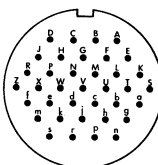
-
The following diagnostics will help isolate and repair problem circuits, wires, pins, connectors, sensors, circuit breakers, and solenoids.
-
For repair of all wiring, refer to para. 4-85. - Check connector pins before inserting probes.
J1 CABLE DIAGNOSTICS CHART J1 Voltage Measurements With Ignition ON, Engine OFF, and Glow Plug Controller Disconnected. Refer to para 4-29.
| opens and lets excess pressure escape to the atmosphere. |
|---|
- Jumper wire from U to a or b.
| +20 | -6.7 | 1-1/2 | 1.022 |
|---|---|---|---|
| +10 | -12.2 | 2 | 1.036 |
| 0 | -17.7 | 2-3/4 | 1.047 |
| -10 | -23.3 | 3-1/4 | 1.055 |
| -20 | -28.8 | 3-1/2 | 1.062 |
| -30 | -34.4 | 4 | 1.067 |
| -40 | -40.0 | 4-1/4 | 1.073 |
| -50 | -45.5 | 4-1/2 | |
| -55 | -48.3 | 4-3/4 | |
| BELOW -60 | BELOW -51.1 | USE ARCTIC | |
| GRADE ANTIFREEZE (-90°F) (-67.7°C) |
Reconnect Glow Plug Controller; refer to para 4-29.
J1 Voltage Measurement With Ignition ON, Engine ON, and Transmission in PARK.

Go to pg 2-430 Go to pg 2-431

Go to pg 2-432

Go to pg 2-433


Go to pg 2-433 Go to pg 2-434





DIAGNOSTIC FLOWCHART TRANSMISSION SYSTEM (4L80-E)
| Inspect the oil cooler, oil cooler supply | |
|---|---|
| return lines, CDR valve hoses, oil pan, and | |
| oil filter. Test CDR valve, (para. 3-9). See | |
| the location on parts page to find these | |
| parts. | |
| ENGINE RPM | |
| STE/ICE-R TEST 10 | |
| 1. Start Test 10, Engine RPM. | |
| 2. Crank or start the engine. Displayed | |
| reading is RPM. Cranking RPM | |
| should be approximately 200. Idle RPM should be 625-675. | |
| OIL PRESSURE CHART | |
| APPROXIMATE OIL PRESSURE | ENGINE RPM |
| STOP 0 PSI | |
| 6.2L IDLE (650 ± 25) 10-15 PSI | |
| 6.5L IDLE (700 ± 25) 10-15 PSI | |
| 6.5L DETUNED | |
| IDLE (700 ± 25) 10-15 PSI | |
| 2000 40-50 PSI | |
| Remove sending unit, refer to (para. 4-25). | |
| ENGINE RPM | |
| INTERLEAVE WITH 0-1000 PSI PRESSURE | |
| 1. Connect BLUE Transducer in place |
Upon completion of J1 cable diagnostics, operate the vehicle and recheck for codes to insure codes have cleared. If codes have not cleared, refer to DS Maintenance.
NOTE Check connector pins before inserting probes.
TRANSMISSION SYSTEM (4L80-E)

DIAGNOSTIC FLOWCHART BATTERY CIRCUIT 537D- TRANSMISSION SYSTEM (4L80-E)

VEHICLE GROUND CIRCUIT

TRANSMISSION SYSTEM (4L80-E) TRANSMISSION LIGHT CIRCUIT
Diagnostic Flowchart

DIAGNOSTIC FLOWCHART TRANSMISSION SYSTEM (4L80-E) BRAKE SWITCH CIRCUIT

TRANSMISSION SYSTEM DIAGNOSTIC FLOWCHART (4L80-E) ENGINE RPM SENSOR

Are 125 to 175 ohms present between engine RPM sensor (located on engine front cover), pins 1 and 2?

Replace engine rpm sensor, (para. 4-33).
Is continuity present from pin h wire 349A of J1 to pin 1 wire 359B of J1 to 2 wire 359J on engine harness connector to rpm sensor?




sensor, (para. 4-33).
Repair wire 349A/349B, and/or wire 359B/359J, (para. 4-85).
2-434 Change 2
Diagnostic Flowchart
THROTTLE POSITION SENSOR CIRCUIT TRANSMISSION SYSTEM (4L80-E)
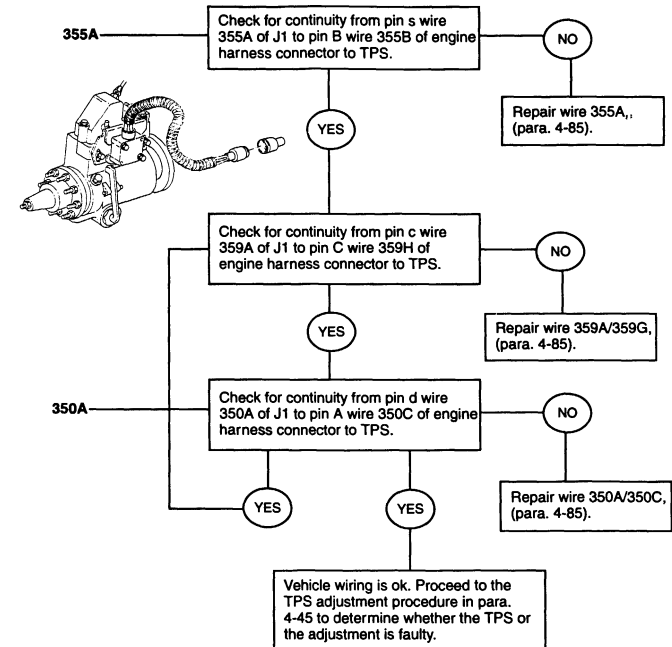
TRANSMISSION SYSTEM (4L80-E) TRANSMISSION INPUT SPEED SENSOR (TISS) CIRCUIT

495A 496A LOW RESISTANCE Disconnect TISS and check continuity between pins M and N at J1.

Repair wire 495A/496A.
(para. 4-85).

TRANSMISSION OUTPUT SPEED SENSOR (TOSS) CIRCUIT DIAGNOSTIC FLOWCHART TRANSMISSION SYSTEM (4L80-E) If reading from J1 diagnostics chart is greater than 2, perform high resistance - less than 1 perform low resistance.
HIGH RESISTANCE 497A 498A Check transmission output speed sensor connector and pins for continuity.
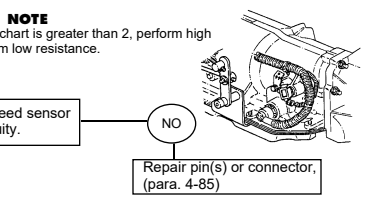

Disconnect and check continuity of wire 495A on J1 pin S to transmission output speed connector pin A, and check continuity of wire 498A on J1 pin R to transmission output speed connector pin B.

Check continuity of transmission output speed sensor and pins A and B (TOSS) 1 Kohm to 2 Kohms W.

NO Replace TOSS, (para. 4-46).

LOW RESISTANCE Disconnect TOSS and check continuity between pins M and N at J1.
YES Repair wire 497A/498A, (para. 4-85).

END TRANSMISSION SYSTEM (4L80-E) TORQUE CONVERTER CLUTCH SOLENOID CIRCUIT
Diagnostic Flowchart
HIGH RESISTANCE 924A-

LOW RESISTANCE

from J1 pin X to J1 pin j.
Diagnostic Flowchart
TRANSMISSION SYSTEM (4L80-E) 1-2 SHIFT SOLENOID CIRCUIT SHIFT SOLENOID A

LOW RESISTANCE Disconnect transmission connector from transmission. Check continuity from J1 pin E to J1 pin j.


Transmission System (4L80-E)
2-3 SHIFT SOLENOID CIRCUIT SHIFT SOLENOID B DIAGNOSTIC FLOWCHART

HIGH RESISTANCE LOW RESISTANCE Disconnect transmission connector from transmission. Check continuity from J1 pin D to J1 pin j.


Diagnostic Flowchart
TRANSMISSION SYSTEM (4L80-E) PRESSURE CONTROL SOLENOID CIRCUIT FORCE MOTOR HIGH

LOW RESISTANCE

wire 264A and wire 265A.
TRANSMISSION SYSTEM (4L80-E) TRANSMISSION RANGE PRESSURE SWITCH, CIRCUIT PRESSURE SWITCH A 765A-

TRANSMISSION RANGE PRESSURE SWITCH, CIRCUIT PRESSURE SWITCH B

TRANSMISSION RANGE PRESSURE SWITCH, CIRCUIT PRESSURE SWITCH C 764A- Disconnect the transmission connector from transmission. Check continuity from J1 pin C to chassis ground at shunt.

DIAGNOSTIC FLOWCHART NO


DIAGNOSTIC FLOWCHART TRANSMISSION SYSTEM (4L80-E) TRANSMISSION TEMPERATURE SENSOR The transmission temperature sensor is a thermistor. The resistance decreases as the temperature increases at 68°F (20°C) the resistance should be from 2980 to 4020 ohms, at 248°F (120°C) the resistance should be 90 to 111 ohms.
RESISTANCE TOO LOW 923A

Resistance Too High
Disconnect transmission connector from transmission. Check continuity from J1 pin e to transmission connector pin L.

Check continuity from J1 pin c to transmission connector pin M. Refer to DS maintenance.
2-36. Brake System Tests
These Brake System tests may be run any time you think you have a braking problem or if you were sent here by another test chain. Just follow the path, answering the questions. Additional information and notes are given on the facing page when necessary.
Fold-out page FO-13 may be left open for reference while testing.
Note
-
The brake lights and the parking brake warning lamp are not diagnosed here. If you are having trouble with these parts, and you are sure the brakes are OK, go to Instruments, Page 2-319, for the warning lamp, or Lights, Page 2-389, for the brake lights.
-
When parking brake handle is pulled, the parking brake is applied to the left and right rear service brake rotors.

Reference Information Brakes

Make sure the area is clear of personnel and obstacles prior to performing this test. Failure to do so may result in serious injury. PARKING BRAKE TEST PROCEDURE: 1. Depress service brake pedal and start engine. 2. Place transmission shift lever in D (drive) and transfer case shift lever in H (high).
- Apply parking brake. Slowly let up on service brake pedal. Vehicle should remain stationary.
Service Brake Road Test Procedure:
-
On an open, smooth, flat surface, accelerate to a steady, reasonable, safe speed (below posted limits).
-
Apply pressure on the brake pedal and bring the vehicle to a stop.
-
Repeat this procedure several times, applying a different brake pressure each time. Look for the following symptoms, which may indicate a problem with the service brakes: 1) Spongy or pulsating brake pedal, 2) Incomplete brake pedal return, 3) Excessive pull to one side, 4) Unusually long braking distance, 5) Rear wheels lock-up before front wheels, 6) Brake warning light comes on while braking, and 7) A squealing, grinding, or chattering noise while braking.


BRAKES
Parking Brake Adjustment:
A.
Chock wheels and release parking brake handle.
B.
Turn adjusting knob at the tip of the brake handle clockwise as tight as possible by hand.
Apply parking brake handle.
C.
D.
E.
If parking brake cannot be applied, turn
 adjusting knob counterclockwise until parking brake can be applied.
adjusting knob counterclockwise until parking brake can be applied.
Test parking brake.
Make sure the area is clear of personnel and obstacles prior to performing this test. Failure to do so may result in serious injury.
WARNING (1) (2) (3) (4) Remove chocks. Depress service brake pedal and start engine. Place transmission shift lever in drive and transfer case shift lever in high. Apply parking brake and slowly let up on service brake pedal. Vehicle should remain stationary.
Replace or repair parts, refer to (para. 7-3) for old configuration. Replace or repair parts, refer to (para 7-20)

Repair or replace linkage, refer to (paras. 7-5, 7-23, and 7-24).

BRAKES Flush and bleed the brake system, refer to

(para 7-10).
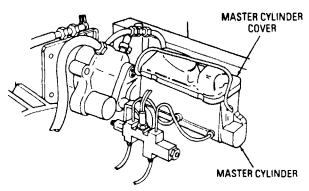
Master Cylinder Test Procedure:
-
With the engine off, purnp the brake pedal six or seven times, or until the pedal becomes noticeably stiffer and harder to depress.
-
Press hard on the brake pedal. If the pedal keeps going down to the floor, either the master cylinder is bad, or there is a leak in the hydraulic system.
Replace master cylinder, refer to (para 7-13).
Check the individual lines going to each brake. Check the supply and return lines to the hydro- boost unit. Replace brake line, refer to (para 7-15).
NOTE Brake hydraulic system must be bled of air whenever hydraulic lines are broken.
Bleed service brake, refer to (para 7-10).


TM 9-2320-280-20-1

BRAKES Replace brake pad, refer to (para 7-11).

NOTE The minimum brake pad thickness is 1/8 of an inch (3.2mm).
Replace service brake rotor, refer to (para 7-1 9).

NOTE The only way the rotors can be sticking is if the calipers are not releasing fully. Remove calipers. clean and lubricate guide pins with grease. Replace and clean brake caliper, refer to (para 7-12).


BRAKES Test for faulty proportioning valve: Drive the vehicle and have an assistant observe during the performance of this test. With vehicle at curb weight, decelerate vehicle from 46 to 40mph (72 to 69 kph) on dry concrete mad and apply sufficient pressure to lockup front brakes. If rear brakes lock up before front brakes, then the proportioning valve should be replaced. Replace proportioning valve, refer to (para 7-18).
Method for checking hydrobooster:
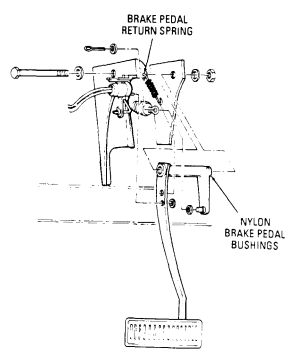
Depress brake pedal several times to exhaust accumulator pedal. Depress brake pedal and start engine. Brake pedal should fall, then push back against operators foot.
Replace hydro-booster, refer to (para 7-14).
Replace service brake pedal, refer to (para 7-16).
The steering tests will check for suspension problems that will affect braking.

BRAKES Bleed power steering system, refer
 to (para 8-29).
to (para 8-29).
Check belts using the belt tension
 gauge, refer to (pars 3-82) (All except "A2" vehicles).
gauge, refer to (pars 3-82) (All except "A2" vehicles).
A defective power steering pump, gear, hoses, or control valve could affect hydro-booster operation.
2-37. Steering System Tests
These Steering System tests may be run any time you have a steering problem or if you were sent here by another test chain. Just follow the path, answering the questions. Additional information and notes are given on the facing page when necessary.
The fold-out page shows the location of the major components of the steering in case you are not familiar with them. These parts are shown in a schematic manner. Illustrations of the actual components are given wherever applicable on the reference pages of the diagnostics.
Fold-out page FO-14 may be left open for reference while testing. The functional flow diagram shows the mechanical and hydraulic parts of the system and how they interact. Even if the hydraulic system fails, you will still be able to steer the vehicle, although it will require more effort.
2-459

STEERING SYSTEM POWER STEERING COMPONENTS STEERING LINKAGES BRAKING SYSTEM OK POWER STEERING COMPONENTS STEERING LINKAGES BRAKES GRABBING POWER STEERING COMPONENTS STEERING LINKAGES NOTHING SUSPENSION BRAKES SUSPENSION BRAKES OK SUSPENSION ОК 2-460
Make sure that the area where you conduct these teats is free of natural

and man-made obstructions. Failure to do so may result in serious injury.
Visualty inspect steering components:
- Check all four tires and rims for wear, inflation, damage, or warping.
a. Adjust tire pressure (TM 9-2320-280-10). b. Replace my unserviceable rims (para 8-4).
- check steering linkage for damage.
a. Replace any damaged steering Iinkage components (para 3-12).
b. Lubricate steering linkage (TM 9-2320-280-10).
- Check power steeing fluid for contamination and level (TM 9-2320-280-10).
a. Drain and replace any fluid that appears black and smells burned.
b. Bleed air from system where fluid appears milky white (para 8-29).
- Check pump drivebelts for fraying, cracks, damage, or misadjustrnent.
a. Replace unserviceable power steering drivebelts (para 3-80).
b. Adjust loose power steering drivebelts (para 3-82).
While travelling at a moderate speed (20mph) (32 kmph), apply the brakes while applying minimal pressure to the steering wheel. If pull to one side or the other occurs, make a note of the speed at which it occurs and on what side of the vehicle it occurs. Repeat this procedure for different speeds and braking forces. If the vehicle seems to steer straight while braking, then there probably isn't a problem with the brakes (at least not one that affects the steering). If the braking action feels strange in anyway, then the brake diagnostics should be run to assure vehicle safety. TM test will usually reveal problems with frozen brake calipers.
If the wheels are out of alignment or if the tires are worn unevenly, vehicle may wander.
Symptoms of bad steering characteristics include hard steering, excesssive play in steering, a momentary increase in steering effort when turning wheel quickly, end jerking of the steering wheel when turning.
STEERING SYSTEM

TM 9-2320-280-20-1
I Drive the vehicle until the fires warm up. If the condition goes away it was probably caused by a burst lube pack or a flat spot on a tire. L Both of these conditions are OK since the vehicle will operate normally after the fires warm up.
STEERING SYSTEM I

Uneven tire wear can be caused by improper inflation, suspension misalignment or damage, hard service, or wheel imbalance. For wheel and tire replacement and maintenance procedures, refer to (para 8-3).
For instructions on adjusting front wheel toe-in, refer to
 (para 8-10).
(para 8-10).
For instructions on adjusting rear wheel toe-out, refer to

 (para 8-11). Part C will test out the suspension parts to see if they are OK.
(para 8-11). Part C will test out the suspension parts to see if they are OK.
STEERING SYSTEM

BELTS OK BELTS OK 2-466 TM 9-2320-280-20-1
STEERING SYSTEM

Check belts using the belt tension gauge, refer to (para 3-82) (All except "A2" Vehicles).
Do not overfill hydraulic fluid.


See TM 9-2320-280-10 for fluid replacement procedure. For bleeding procedure, refer to (para 8-29). Low fluid level could indicate a problem elsewhere in the system, either leaking hydraulic Iines or a leaking or demaged power steering pump. lf adding fluid seems to cure the problem, you should probably run the reat of the tests to make sure there aren't any other problem.
A Ioose pump, pulley, or bracket could cause excess noise, slipping belts, or other malfunctions. For appropriate repair or replacement procedures, refer to (para 8-24).
Check hydraulic hoses, power steering pump, power steering cooler, hydraulic control valve, hydro-boost unit, steering gear, fan shroud, and fan clutch. See hose replacement procedures (refer to para 8-25). Check power steering cooler for bent fins or any other airflow restrictions. Straighten fins or replace power steering cooler (para. 8-28) if damaged beyond repair.
- With engine off, disconnect pressure hose from hydro-boost and connect tube and quickdisconnect to hydro-boost.
Note
Have drainage container ready to catch fluid.
-
Connect adapter and quick-disconnect to pressure hose.
-
Connect hose from valve on power steering analyzer to tube and quick-disconnect on hydro-boost.
-
Connect hose from gauge side of power steering analyzer to adapter and quickdisconnect on pressure hose.
-
Loosen hose clamp and remove cooler hose from return tube on steering gearbox.
-
Plug hose with plug or bolt (3/8 in. or 10 mm dia.) and secure with hose clamp.
-
Connect bypass hose to tube on steering gearbox and secure with hose clamp.
(continued on page 2-469)


STEERING SYSTEM

2-468.2 Change 2
Reference Information Steering System
-
Loosen hose clamp and remove control valve return hose from tube on power steering pump. 9. Plug return hose with plug or bolt (3/8 in. or 10 mm dia.) and secure with hose clamp. 10. Connect other end of bypass hose to tube on power steering pump and secure with hose clamp. 11. Connect STE/ICE-R to vehicle diagnostic connector and set for measuring RPM (para. 2-43). 12. Open analyzer valve to full open position. 13. Start engine (Refer to TM 9-2320-280-10). 14. Remove power steering reservoir cap and turn steering wheel all the way left, hold in place for 5 seconds, then repeat process with steering wheel all the way right. This releases air from the system.
-
Return steering wheel to center position and shut engine off (para. 3-44).
-
Check and add power steering fluid to reach FULL COLD level in reservoir (Refer to TM 9-2320-280-10).
-
Start engine (Refer to TM 9-2320-280-10) and allow engine to idle and reach operating temperature of 190° F to 230° F.

- Check for proper engine idle speeds and adjust if necessary (para. 3-44).
6.2L engine 650±25 RPM 6.5L engine 700±25 RPM 6.5L detuned engine 700±25 RPM 19. Ensure analyzer valve is in full open position and engine is at proper idle speed.
-
Initial pressure should be 150-250 psi and a flow of 2.50-3.50 gpm. If these specifications aren't present, check installation of analyzer and check power steering system (Refer to TM 9-2320-280-10).
-
With power steering system working properly, partially close analyzer valve until pressure reaches 700 psi. If flow rate varies more than 1 gpm from the initial reading, replace power steering pump (para. 8-24).
CAUTION Do not leave analyzer valve fully closed for more than 5 seconds. Severe damage may occur to power steering pump.
-
With engine at idle, close and open analyzer valve three times, recording pressure each time. All readings should be 1300 psi or higher, if pressure is lower, replace power steering pump (para. 8-24).
-
With analyzer valve in the open position, increase engine rpm to 1500 and record fluid flow. If fluid flow varies more than 1 gpm from initial reading, replace power steering pump (para. 8-24).
-
With engine at idle, turn steering wheel all the way left, hold in place for 5 seconds, then repeat process with steering wheel all the way right and record flow rates. If flow rate does not drop to 1 gpm or less, replace steering gearbox (para. 8-21).
-
With engine at idle, turn wheels slightly left and right and release quickly. If pressure does not increase and snap back within 2 seconds, check steering shaft and column for binding and repeat step 15. If pressure still does not increase and snap back, replace steering gearbox (para. 8-21).
-
With engine at idle, push brake pedal down and hold. Record pressure. If pressure varies more than 50 psi from step 22, replace hydro-boost (para. 7-14).
-
With engine at idle, push brake pedal down and release quickly. If pressure does not increase and snap back within 2 seconds, replace hydro-boost (para. 7-14).
-
Shut off engine. Remove power steering analyzer and restore power steering system to original configuration. 29. Bleed power steering system (para. 8-29).
NOTE You must be certain that the engine cooling system is working ok, or this test won't tell you anything. If the engine is cold, and everything is working ok, the fan should be disengaged. You can tell by gently revving the engine in neutral with the hood open. If the fan is engaged you will feel a breeze outside the driver's door. If it's disengaged, you won't feel it. If you aren't sure if it's working ok, run the tests in Paragraph 2-25.

FAN DRIVE FAN DRIVE STEERING SYSTEM
Method for checking hydro-booster. Depress brake pedal several times to exhaust accumulator. Depress brake pedal and start engine. Brake pedal should fall, then push back against operator's foot.
| ANSWERS TO QUESTION: | COMPONENT | ||
|---|---|---|---|
| B6 | B7 | B8 | TO REPLACE |
| NO | NO | NO | POWER STEERING PUMP |
| NO | NO | YES | SEE NOTE BELOW |
| NO | YES | NO | SEE NOTE BELOW |
| NO | પ્રદર્ | YES | RUN ENGINE COOLING TEST (PARA 2-19) |
| YES | NO | NO | POWER STEERING PUMP |
| YES | NO | YES | HYDRO-BOOSTER |
| YES | YES | NO | DS LEVEL STEERING GEAR |
| YES | YES | YES | NO FAULTS |
Note
To diagnose the second and third cases to one item, it is necessary to have a power steering analyzer. Additionally, for all cases, check the hoses for the particular part to make sure they are OK.

REFERENCE INFORMATION STEERING SYSTEM

Check for looseness in idler arm and pitman arm, refer to (para. 8-18 and 8-14). For replacing center link refer to (para. 8-15). For replacing tie rods refer to (para. 8-17).
For adjusting the drivebelt tension, refer to (para. 3-82, all except M1123 and "A2" vehicles), and replacing the pulley, refer to (para 8-24).
CAUTIONM1123 and "A2"

Do not loosen slotted nut to install cotter pin. Loosening the nut may result in damage to the equipment.
To check for proper operation of ball joints: (i) Chock rear wheels front and back.
(ii) Raise front wheels about two inches off the ground and support on a jack stand.
(a)Lower ball joints. (iii) Mark a line across the head of the top bolt holding the steering arm cover. Make sure the mark is parallel to the lower control arm. (iv) Put a prybar between the cover control arm and geared hub.
(v) Set a 6-inch ruler upright between the lower control arm and the marked screw. (vi) Push down the prybar to try to move the hub.
(vii) Measure movement in the hub assembly. If movement is more than 1/8 inch (3 mm), replace lower ball joint (refer to para. 6-27). (b) Upper ball joints.
(viii) Grasp top of tire and attempt to move it in and out.
(ix) Measure any movement at top outer edge of tire. Replace upper ball joints if tire movement is 3/8 inch (10 mm) or more (refer to para. 6-26).
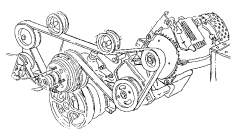
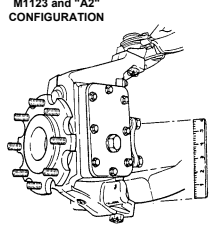

STEERING SYSTEM

For upper and Iower control arm and bushing replacement instructions, refer to (para 6-28 and 6-29).
To test the shocks and springs, drive the vehicle over a variety of terrain. If the vehicle continues to bounce after hitting a bump, the shocks may be worn. If the vehicle bottoms out on the suspension, the shocks may be worn. If the vehicle sags when loaded, the springs maybe worn. If the shock absorber bodies are not warm after driving the vehicle, the shocks are no good. For coil spring and shock absorber replacement instructions, refer to (para 6-30 and 6-31).
For instructions on replacing the radius rod, refer
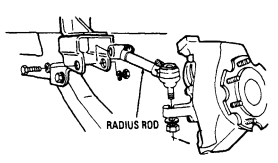 to (para 6-25).
to (para 6-25).

TM 9-2320-280-20-1
STEERING SYSTEM NOTE

Inspect intermediate shaft U-joints for wear, binding, or missing/damaged grease fittings. Replace or lubricate as necessary. Refer to (para. 8-22) for replacement and TM 9-2320-280-10, Appendix G, for lubrication instructions. Replace the steering column and intermediate shaft, refer to (paras 8-19 and 8-20).
Replace the stabilizer bar, refer to (para 6-23).

If you still have a problem, rerun the test chain to make sure you didn't miss anything. If you didn't go down the "A" chain, you may want to run those tests in order to check out the hydraulic parts of the steering system.
2-38. Drivetrain Tests
These Drivetrain tests maybe run anytime you think you have a drivetrain problem or if you were sent here by another test chain. Just follow the path, answering the questions. Additional information and notes are given on the facing page when necessary.
The fold-out page shows the location of the major components of the drivetrain system in case you are not familiar with them.
Fold-out page FO-15 may be left open for reference while testing. Also, due to the design of the functional flow diagram, it is not necessary to have a location of parts diagram, so it has been omitted.
NOTE Problems with the transmission and drivetrain cooling system are dealt with in Paragraph 2-34 or 2-35.
2-479

NOTHING IS THE TRANSMISSION DRIVETRAIN KNOWN INFO POSSIBLE PROBLEMS TRANSFER CASE DIFFERENTIALS HALF AND PROPELLER SHAFTS CV & U-JOINTS GEARED HUBS KNOWN INFO FLUID OK POSSIBLE PROBLEMS TRANSFER CASE DIFFERENTIALS HALF AND PROPELLER SHAFTS CV & U-JOINTS GEARED HUBS KNOWN INFO SHIFTER OK FLUID OK VEHICLE PASSES ROAD TEST POSSIBLE PROBLEMS TRANSFER CASE DIFFERENTIALS HALF AND PROPELLER SHAFTS CV & U-JOINTS GEARED HUBS GO TO 4, Page 2-482 2-480 Change 1
DRIVETRAIN
-
Start engine 2. Hold down brake pedal and move transmission shift lever through ail ranges including reverse.
-
Engage parking brake and place shift lever in neutral. Check fluid level on dipstick.
-
Proper level is between FULL and ADD marks on dipstick NOTE Check fluid for a burnt smell, grit, discoloration, air bubbles, or a milky appearance.
o Burnt smell, discolration, or grit indicates worn or damaged internal components. Notify DS maintenance.
o Bubbles indicate of an overfilled system or air

leaks in the syetem. Drain the fluid and refill to proper level, refer to (para 5-2).
o Milky appearance is due to watar in the system.
Replace fluid, and replace fifter.
If the speedometer works, but the vehicle doesn't move, the transmission is OK and the problem is in the final drive. Most likely the fault is in the splined output shafts of the transfer case. Listen for unusual noise.

REFERENCE INFORMATION DRIVETRAIN Check for torn boots on the CV joints, stripped splines, smooth joint operation, and proper mounting torques. Replace halfshafts and CV joints, refer to (para 6-9).
TM 9-2320-280-10.

Check for smooth operation of U-joints,
 stripped splines, bent yokes, or other problems. Also check to see if the shaft itself is bent. Replace propeller shafts or U-joints, refer to (para 6-2 through 6-7). Lube in accordance with TM 9-2320-280-10.
stripped splines, bent yokes, or other problems. Also check to see if the shaft itself is bent. Replace propeller shafts or U-joints, refer to (para 6-2 through 6-7). Lube in accordance with TM 9-2320-280-10.
Make sure the geared hubs turn freely.
Check mounting hardware for proper installation Lube in accordance with TM 9-2320-280-10. Replace geared hubs, refer to (para 6-11).

Reference Information
DRIVETRAIN Check for loose mounting
 and broken parts. Check fluid in accordance with TM 9-2320-280-10.
and broken parts. Check fluid in accordance with TM 9-2320-280-10.
Notify DS maintenance for other faults.


DRIVETRAIN Lube in accordance with table 2-1.
Adjust and repair linkage, refer to (para 5-8 or 5-11). Make sure the detents in the shifter correspond with the positions on the name plate. If difficulty occurs when shifting transfer range with engine running, perform Engine Idle Speed Adjustment prior to troubleshooting drivetrain. If engine was turned OFF in order to shift transfer to desired range, notify DS maintenance.
For the vehicle not to move, there must be a major problem in the drivetrain.
If you've already run the transmission tests, and you still can't find the problem, continue down this test chain.

TM 9-2320-280-20-1
DRIVETRAIN Lube in accordance with TM 9-2320-280-10.
Check for smooth operation
 of U-Joints, stripped splines, bent yokes, or other problems.
of U-Joints, stripped splines, bent yokes, or other problems.
Also check to see if the shaft itself is bent.
Repair and replace propeller shafts and U-joints, refer to (para 6-4 thru 6-7).
Check for torn boots on the CV joints, stripped splines, smooth joint operation, and proper mounting torques. For halfshaft maintenance procedures, refer to (para 6-9).
Lube in accordance with

TM 9-2320-280-10.
Make sure the geared hubs turn freely. Check mounting hardware for proper installation.
TM 9-2320-280-10.
NOTE If you havan't found any faults, check the differential fluid in accordance with TM 9-2320-280-10. Otherwise notify DS maintenance.
Drivetrain
KHOWN INFO VEHICLE DOESN'T MOVE SHIFTER OK FLUID OK POSSIBLE PROBLEMS TRANSFER CASE TRANSMISSION HALF AND PROPELLER SHAFTS GEARED HUBS KNOWN INFO SHIFTER OK TRANSFER CASE OK TRANSMISSION OK SPEEDOMETER WORKS POSSIBLE PROBLEMS PROPELLER SHAFTS U-JOINTS GEARED HUBS HALFSHAFTS AND CV JOINTS OK KNOWN INFO SHIFTER OK TRANSFER CASE OK TRANSMISSION OK SPEEDOMETER WORKS PROPELLER SHAFTS U-JOINTS POSSIBLE PROBLEMS GEARED HUBS HALFSHAFTS AND CV JOINTS OK

2-490

DRIVETRAIN If the vehicle doesn't work, then both shafts would have to be broken.
Check for smooth operation of U-joints, stripped splines, bent yokes, or other problems.
Also check to see if the shaft

itself is bent. Replace propeller shafts, refer to (para 6-2 thru 6-6).
Lube in accordance with TM 9-2320-280-10.
If the vehicle doesn't move, all four shafts maybe broken. Check for tom boots on the CV joints, stripped splines, smooth joint operation, and proper mounting torques. For halfshaft maintenance procddures, refer to (para 6-9).
Lube in accordance with TM 9-2320-280-10.

REFERENCE INFORMATION DRIVETRAIN Make sure the geared hubs turn freely.
 For geared hub replacement procedure, refer to (para 6-11). Check mounting hardware for proper installation.
For geared hub replacement procedure, refer to (para 6-11). Check mounting hardware for proper installation.
Lube in accordance with TM 9-2320-280-10.
Check for loose mounting and broken parts. Notify DS maintenance. Check fluid level in accordance with TM 9-2320-280-10.
Notify DS maintenance for other faults.


DRIVETRAIN A no answer means the speedometer did move.
NOTE If you answer NO, check the driven gear in the transfer case. if it's OK, the problem is the drive gear. Notify DS maintenance.
Replace the driven gear, refer to (para 5-24).

Replace the cable, refer to (para 4-15).
Replace speedometer, refer to (para 4-14).
2-39. Ambulance Electrical System Tests
This section provides information to diagnose and correct malfunctions of the ambulance electrical system.
Each malfunction symptom given for an individual component or system is followed by step(s) that you should take to determine the cause and corrective action necessary to remedy the problem.
Before taking any action to correct a possible malfunction, the following rules should be followed: Question the operator to obtain any information that might help you determine the cause of the problem.
(1) (2) Never overlook the chance that the problem could be of simple origin because it could be corrected with minor adjustment.
Use all senses to observe and locate trouble spots.
(3) (4) Use test instruments or gauges to help you determine and isolate problem.
Always isolate the system where the malfunction occurs and then locate the defective component.
(5) (6) Use standard automotive theories and principles when troubleshooting the vehicles covered in this manual.
Functional Schematics for ambulance electrical systems are located on pages 2-685 thru 2-691.
(7)
Ambulance
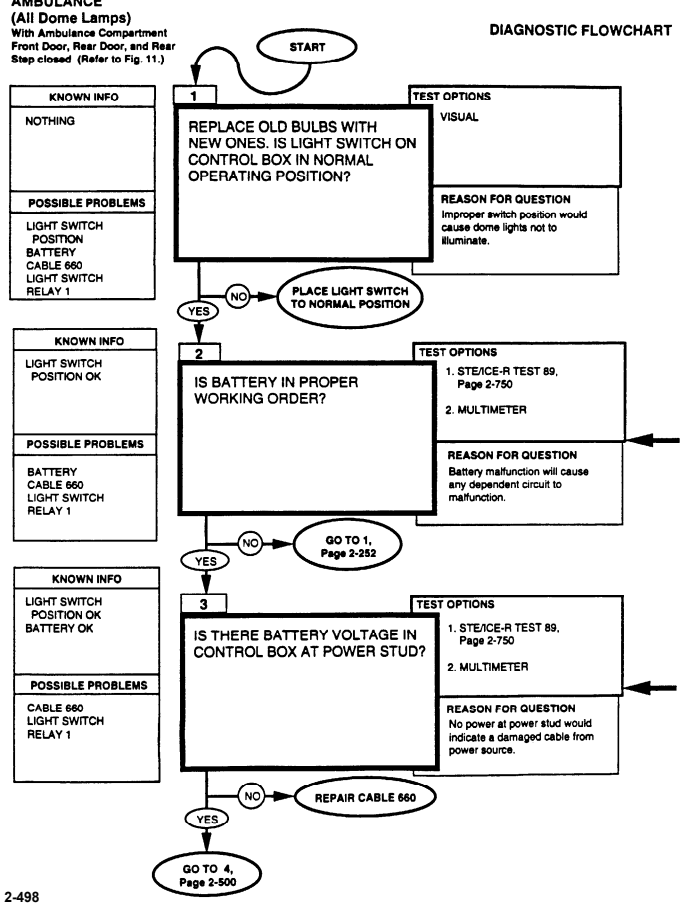
AMBULANCE

STEACE-R TEST 89
-
Connect RED clip to the indicated test point, BLACK clip to negative or ground.
-
Start Test 89, DC volts. 3. Displayed reading is in volts.
Battery Voltage Multimeter
-
Set the voltmeter to a DC volts scale of at least 40 volts.
-
Connect the RED lead to positive and the BLACK lead to negative.
-
Be sure to read the correct scale.
Repair cable, refer to DS Maintenance.

AMBULANCE
0-45 Dc Volts
STEACE-R TEST 89 1. Connect RED clip to the indicated test point, BLACK clip to negative or ground. 2. Start Test 89, DC volts.
- Displayed reading is in volts.
Battery Voltage Multimeter
-
Set the voltmeter to a DC volts scale of at least 40 volts. 2. Connect the RED lead to positive and the BLACK lead to negative.
-
Be sure to read the correct scale.
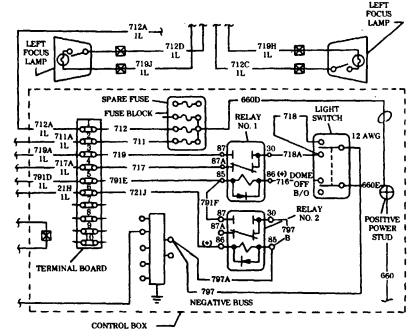
Replace light switch, refer to (para. 4-118).
Replace relay 1, refer to (para. 4-120).

Ambulance Reference Information

0-4500 Dc Ohms Steace-R Test 91
-
Connect RED clip and BLACK clip to the indicated terminals in question; RED to the first, BLACK to the second.
-
Start test 91, 0-4500 ohms.
-
Displayed reading is in ohms. Less than 5 ohms is continuity. If the resistance is over 4500 ohms, STE/ICE displays "9.9.9.9."
-
Set the voltmeter to an ohms scale of about 1000 ohms.
-
Connect the RED and BLACK leads to the connections stated in the question.
-
Be sure to read the correct scale. Less than 5 ohms indicates continuity. For an open circuit, the meter should peg full scale (needle all the way to the left).
Replace blackout rear step switch, refer to (para. 4-92).

AMBULANCE


AMBULANCE Replace blackout rear door switch, refer to (para. 4-93).
0-4500 Dc Ohms Steace-R Test 91
-
Connect RED clip and BLACK clip to the indicated terminals in question; RED to the first, BLACK to the second.
-
Start test 91, 0-4500 ohms.
-
Displayed reading is in ohms. Less than 5 ohms is continuity. If the resistance is over 4500 ohms, STE/ICE displays "9.9.9.9."

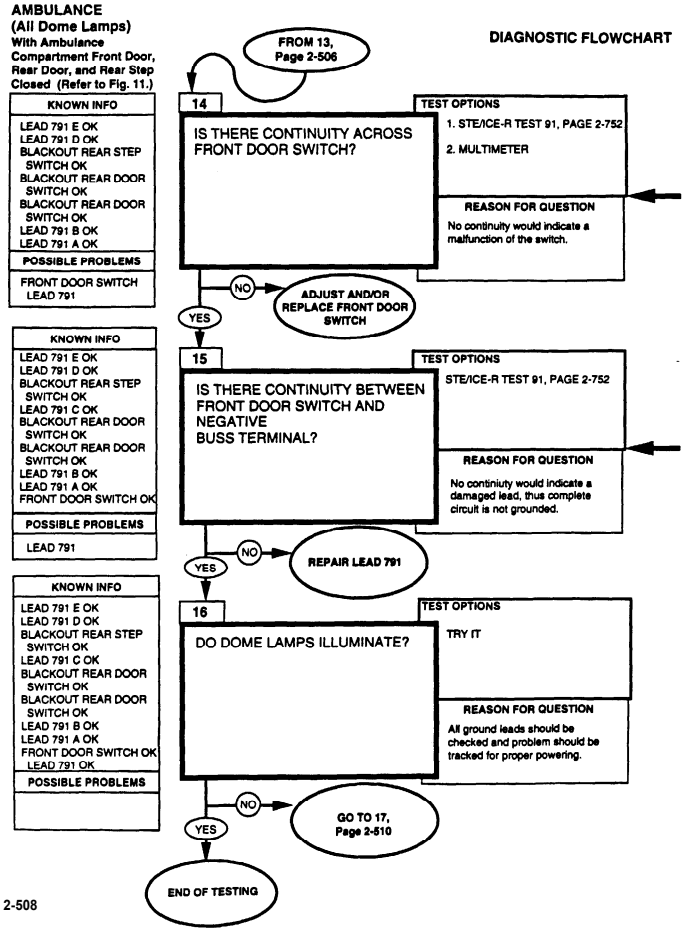
AMBULANCE
0-4500 Dc Ohms Steace-R Test 91
-
Connect RED clip and BLACK clip to the Indicated terminals in question. RED to the first, BLACK to the second.
-
Start test 91, 0-4500 ohms.
-
Displayed reading is in ohms. Less than 5 ohms is continuity. If the resistance is over 4500 ohms. STE/ICE displays "9.9.9.9."
-
Set the voitmeter to an ohms scale of about 1000 ohms.
-
Connect the RED and BLACK leads to the connections stated in the question.
-
Be sure to read the correct scale. Less than

Replace front door switch, refer to (para. 4-94).
AMBULANCE

With Ambulance LEAD 712 LEAD 711
Ambulance 0-45 Dc Volts Steace-R Test 89
-
Connect RED clip to the indicated test point, BLACK clip to negative or ground.
-
Start test 89, DC votts.
-
Displayed reading is in volts.
Battery Voltage Multimeter
-
Set the voltmeter to a DC volts scale of at least 40 volts.
-
Connect the RED lead to positive and the BLACK lead to negative. 3. Be sure to read the correct scale.


AMBULANCE


AMBULANCE Repair lead, refer to (para. 4-85).
0-4500 Dc Ohms Steace-R Test 91
-
Connect RED clip and BLACK clip to the indicated terminals in question; RED to the first, BLACK to the second.
-
Start Test 91, 0-4500 ohms. 3. Displayed reading is in ohms. Less than 5 ohms is continuity. If the resistance is over 4500 ohms, STE/ICE displays "9.9.9.9."
-
Set the voltmeter to an ohms scale of about 1000 ohms.
-
Connect the RED and BLACK leads to the connections stated in the question.
-
Be sure to read the correct scale. Less than 5 ohms indicates continuity. For an open circuit, the meter should peg full scale (needle all the way to the left).

Replace light switch, refer to (para. 4-118).
Ambulance
(All Dome Lamps) With Ambulance Compartment Front Door, Rear Door, and Rear Step Closed (Refer to Fig. 11.) KNOWN INFO LEAD 797 OK LIGHT SWITCH OK LEAD 718 OK POSSIBLE PROBLEMS LEAD 718 A LEAD 719 DAMAGED LEADS DOME LAMP SOCKETS KNOWN INFO LEAD 797 OK LIGHT SWITCH OK LEAD 718 OK LEAD 718A OK POSSIBLE PROBLEMS LEAD 719 DAMAGED LEADS DOME LAMP SOCKETS KNOWN INFO LEAD 797 OK LIGHT SWITCH OK LEAD 718 OK LEAD 718 A OK LEAD 719 OK POSSIBLE PROBLEMS DAMAGED LEADS DOME LAMP SOCKETS

Reference Information Ambulance

0-4500 Dc Ohms Steace-R Test 91
-
Connect RED clip and BLACK clip to the indicated terminals in question; RED to the first, BLACK to the second.
-
Start Test 91, 0-4500 ohms.
-
Displayed reading is in ohms. Less than 5 ohms is continuity. If the resistance is over 4500 ohms, STE/ICE displays "9.9.9.9."
-
Set the voltmeter to an ohms scale of about 1000 ohms.
-
Connect the RED and BLACK leads to the connections stated in the question.
-
Be sure to read the correct scale. Less than 5 ohms indicates continuity. For an open circuit, the meter should peg full scale (needle all the way to the left).


AMBULANCE
(para. 4-87). Replace dome lamps, refer to

0-4500 Dc Ohms Steace-R Test 91
- Connect RED clip and BLACK clip to the indicated terminals in question; RED to the first.
BLACK to the second. 2. Start Test 91, 0-4500 ohms.
-
Dilsplayed reading is in ohms. Less than 5 ohms is continuity. If the resistance is over 4500 ohms, STE/ICE displays "9.9.9.9.9."
-
Set the voltmeter to an ohms scale of about 1000 ohms.
-
Connect the RED and BLACK leads to the connections stated in the question.
-
Be sure to read the correct scale. Less than 5 ohms indicates continuity. For an open circuit, the meter should peg full scale (needle all the way to the left).
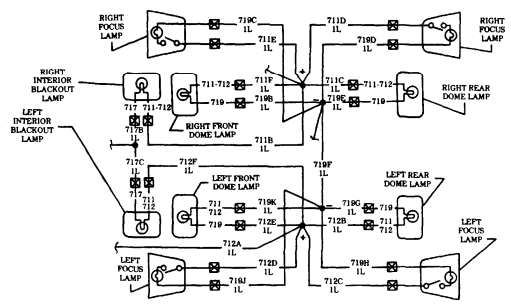
AMBULANCE

REFERENCE INFORMATION AMBULANCE Replace main light switch, refer to (para. 4-59).

Ambulance

AMBULANCE
-
Connect RED clip to the indicated test point, BLACK clip to negative or ground.
-
Start Test 89, DC volts.
-
Displayed reading is in volts.
BATTERY VOLTAGE MULTIMETER
-
Set the voltmeter to volts scale of at least 40 volts.
-
Connect the RED lead to positive and the black lead to negative.
-
Be sure to read the correct scale.

Replace relay 2, refer to (para. 4-120).
Replace main light switch, refer to (para. 4-59).

AMBULANCE 0-4500 DC OHMS STEACE-R TEST 91 1. Connect RED clip and BLACK clip to the indicated terminals in question; RED to the first, BLACK to the second.
-
Start test 91, 0-4500 ohms.
-
Displayed reading is in ohms. Less than 5 ohms is continuity. If the resistance is over 4500 ohms, STE/ICE displays "9.9.9.9."

Ambulance

AMBULANCE
0-4500 Dc Ohms Steace-R Test 91
-
Connect RED clip and BLACK clip to the indicated terminals in question; RED to the first, BLACK to the second.
-
Start test 91, 0-4500 ohms. 3. Displayed reading is in ohms. Less than 5 ohms is continuity. If the resistance is over 4500 ohms, STE/ICE displays "9.9.9.9."


AMBULANCE
REFERENCE INFORMATION

-
Connect RED clip to the indicated test point, BLACK clip to negative or ground.
-
Start Test 89, DC volts. 3. Displayed reading is in volts.
Battery Voltage Multimeter
-
Set the voltmeter to a volts scale of at least 40 volts.
-
Connect the RED lead to positive and the black lead to negative.
-
Be sure to read the correct scale.
Replace dome lamp assembly, refer to (para. 4-87).
Repair lead, refer to (para. 4-85).
Repair lead connector, refer to (para. 4-85).

REFERENCE INFORMATION AMBULANCE :
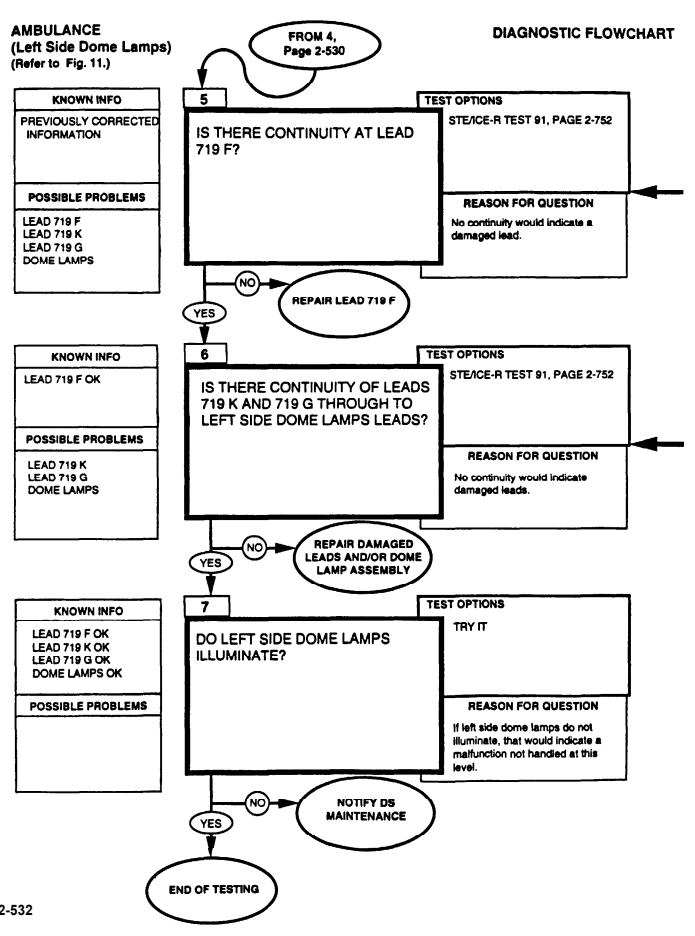
AMBULANCE

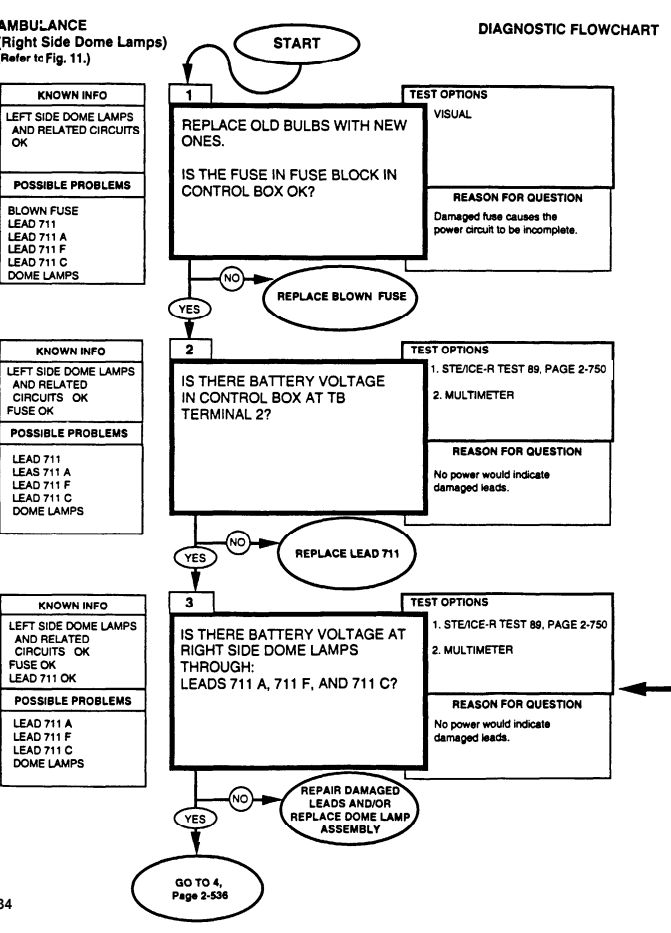
AMBULANCE 0-45 DC VOLTS STEACE-R TEST 89 1. Connect RED clip to the indicated test point, BLACK clip to negative or ground.
-
Start Test 89, DC volts.
-
Displayed reading is in volts.
BATTERY VOLTAGE MULTIMETER
-
Set the voltmeter to volts scale of at least 40 volts.
-
Connect the RED lead to positive and the black lead to negative.
-
Be sure to read the correct scale.
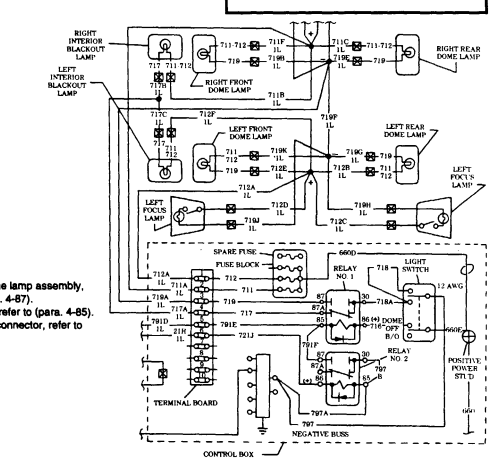
Replace dome lamp assembly, refer to (para. 4-87). Repair lead, refer to (para. 4-85).
Repair lead connector, refer to (para. 4-85).


Reference Information
AMBULANCE Repair lead, refer to (para. 4-85).
0-4500 Dc Ohms Steace-R Test 91
-
Connect RED clip and BLACK clip to the indicated terminals in question; RED to the first, BLACK to the second.
-
Start Test 91, 0-4500 ohms.
-
Displayed reading is in ohms. Less than 5 ohms is continuity. If the resistance is over 4500 ohms, STE/ICE displays "9.9.9.9." Replace dome lamp assembly, refer to (para. 4-87). Repair lead, refer to (para. 4-85). Repair lead connector, refer to (para. 4-85).


AMBULANCE Repair leads, refer to (para. 4-85).
Repair lead connector, refer to (para. 4-85).
| 2. Start Test 89, DC volts. |
|---|
| 3. Displayed reading is in volts. |
| 3. Be sure to read the correct scale. |
|---|
| 2. Connect the RED lead to positive and the black | lead to negative. |
|---|
| and and any and the promote of the promote of the program and on the comments of the control of the control of the control of the control of the contribution of the contribut |
|---|
| 1. Connect RED clip to the indicated test point, |
| BLACK clip to negative or ground. |
| of the property of a management of the property of the control of the control of the continues of the control of the continues of the control of the control of the continued 0-45 DC VOLTS |
|---|
| ben and and a many of a result of the consideration of the consisted and the consideration of the consideration of the consideration of the consisted on the consideration of STEACE-R TEST & |

Replace dome lamp assembly, refer to (para. 4-87).

AMBULANCE REFERENCE INFORMATION


AMBULANCE Replace spotlight assembly, refer to (para. 4-88).
Repair leads, refer to (para. 4-85).
Repair lead connector, refer to (para. 4-85).
- Connect RED clip to the indicated test point.
BLACK clip to negative or ground.
-
Start Test 89, DC volts.
-
Displayed reading is in volts.
Battery Voltage Multimeter
-
Set the voltmeter to a DC volts scale of at least 40 volts.
-
Connect the RED lead to positive and the BLACK lead to negative.
-
Be sure to read the correct scale.
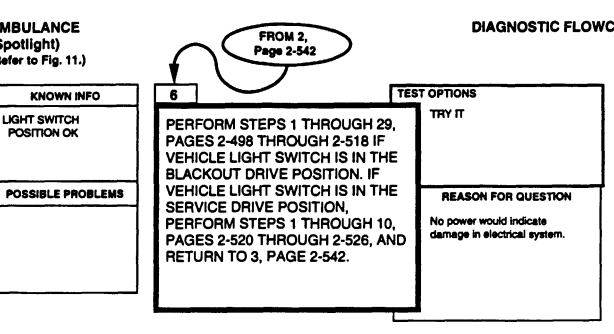

REFERENCE INFORMATION AMBULANCE
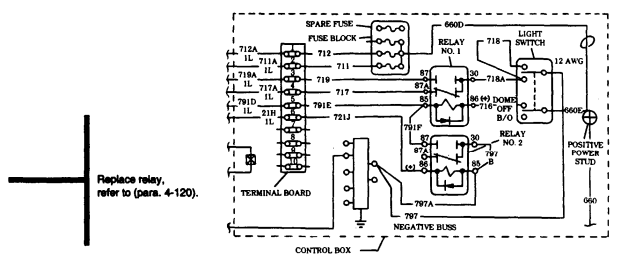
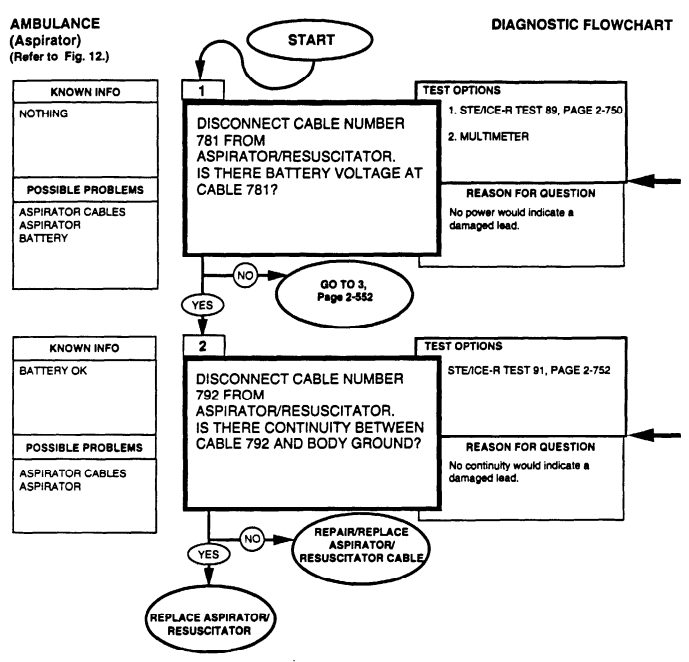
Ambulance Reference Information 0-45 Dc Volts Steace-R Test 89
-
Connect RED clip to the indicated test point, BLACK clip to negative or ground.
-
Start Test 89, DC volts. 3. Displayed reading is in volts.
Battery Voltage Multimeter
-
Set the voltmeter to a DC volts scale of at least 40 volts.
-
Connect the RED lead to positive and the BLACK lead to negative.
-
Be sure to read the correct scale.
0-4500 Dc Ohms Steace-R Test 91
- Connect RED clip and BLACK clip to the indicated terminals in question; RED to the first, BLACK to the second. 2. Start Test 91, 0-4500 ohms. 3. Displayed reading is in ohms. Less than 5 ohms is continuity. If the resistance is over 4500 ohms, STE/ICE displays "9.9.9.9." Replace Aspirator/Resuscitator cable, refer to (para. 4-104).
Repair cable, refer to DS Maintenance.

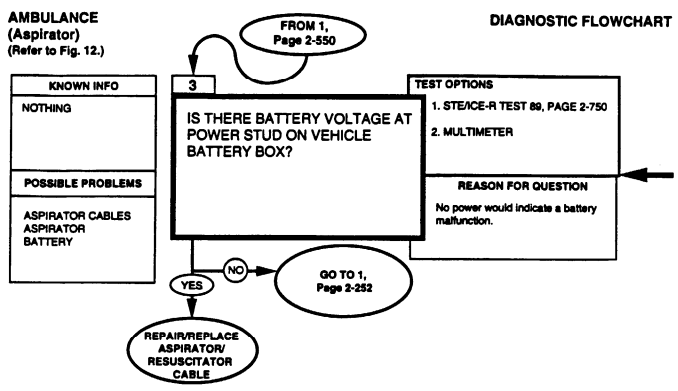
Reference Information Ambulance

40 volts.
- Connect RED clip to the indicated test point, BLACK clip to negative or ground. 2. Start Test 89, DC volts. 3. Displayed reading is in volts.
BATTERY VOLTAGE MULTIMETER
-
Set the voltmeter to a DC volts scale of at least 2. Connect the RED lead to positive and the BLACK lead to negative.
-
Be sure to read the correct scale.

AMBULANCE
-
Connect RED clip to the indicated test point, BLACK clip to negative or ground.
-
Start Test 89, DC volts.
-
Displayed reading is in volts.

Battery Voltage Multimeter
-
Set the voltmeter to a DC voits scale of at least 40 volts. 2. Connect the RED lead to positive and the BLACK lead to negative.
-
Be sure to read the correct scale.
0-4500 Dc Ohms Steace-R Test 91
-
Connect RED clip and BLACK clip to the indicated terminals in question; RED to the first, BLACK to the second.
-
Start Test 91, 0-4500 ohms.
-
Displayed reading is in ohms. Less than 5 ohms is continuity. If the resistance is over 4500 ohms, STE/ICE displays "9.9.9.9." Repair lead, refer to (para. 4-85).
Repair lead connector, refer to (para. 4-85).

AMBULANCE Repair lead, refer to (para. 4-85).
Repair lead connector, refer to (para. 4-85).
-
Connect RED clip to the indicated test point, BLACK clip to negative or ground. 2. Start Test 89, DC volts.
-
Displayed reading is in volts.
Battery Voltage Multimeter
-
Set the voltmeter to a DC volts scale of at least 40 volts.
-
Connect the RED lead to positive and the BLACK lead to negative.
-
Be sure to read the correct scale.
Repair lead connectors, refer to (para. 4-85).
Repair lead, refer to (para. 4-85).
Replace front DC outlet, refer to (para. 4-90).

0-4500 Dc Ohms
Steace-R Test 91
-
Connect RED clip and BLACK clip to the indicated terminals in question; RED to the first, BLACK to the second.
-
Start Test 91, 0-4500 ohms.
-
Displayed reading is in ohms. Less than 5 ohms is continuity. If the resistance is over 4500 ohms, STE/ICE displays "9.9.9.9."
-
Set the voltmeter to an ohms scale of about 1000 ohms.
-
Connect the RED and BLACK leads to the connections stated in the question.
-
Be sure to read the correct scale. Less than 5 ohms indicates continuity. For an open circuit, the meter should peg full scale (needle all the way to the left).
AMBULANCE

Ambulance Reference Information

Repair lead, refer to (para. 4-85).
Repair lead connector, refer to (para. 4-85).
0-4500 Ohms
Steace-R Test 91
-
Connect RED clip and BLACK clip to the indicated terminals in question; RED to the first, BLACK to the second.
-
Start Test 91, 0-4500 ohms. 3. Displayed reading is in ohms. Less than 5 ohms is continuity. If the resistance is over 4500 ohms, STE/ICE displays "9.9.9.9."
-
Set the voltmeter to an ohms scale of about 1000 ohms.
-
Connect the RED and BLACK leads to the connections stated in the question.
-
Be sure to read the correct scale. Less than 5 ohms indicates continuity. For an open circuit, the meter should peg full scale (needle all the way to the left).
-
Connect RED clip to the indicated test point, BLACK clip to negative or ground.
-
Start Test 89, DC volts. 3. Displayed reading is in volts.
Battery Voltage Multimeter
-
Set the voltmeter to a volts scale of at least 40 volts.
-
Connect the RED lead to positive and the BLACK lead to negative.
-
Be sure to read the correct scale.
Repair lead, refer to (para. 4-85).
Repair lead connector, refer to (para. 4-85).

Ambulance Reference Information
Repair lead, refer to (para. 4-85). Repair lead connector, refer to (para. 4-85).
-
Connect RED clip to the indicated test point, BLACK clip to negative or ground.
-
Start Test 89, DC volts.
-
Displayed reading is in volts.
Battery Voltage Multimeter
- Set the voltmeter to a DC volts scale of at least 40 volts. 2. Connect the RED lead to positive and the BLACK lead to negative. 3. Be sure to read the correct scale.
Repair lead, refer to (para. 4-85).
Replace rear DC outlet, refer to (para. 4-90).
0-4500 Dc Ohms Steace-R Test 91
-
Connect RED clip and BLACK clip to the indicated terminals in question; RED to the first, BLACK to the second.
-
Start Test 91, 0-4500 ohms.
-
Displayed reading is in ohms. Less than 5 ohms is continuity. If the resistance is over 4500 ohms, STE/ICE displays "9.9.9.9."
-
Set the voltmeter to an ohms scale of about 1000 ohms.
-
Connect the RED and BLACK leads to the connections stated in the question.
-
Be sure to read the correct scale. Less than 5 ohms indicates continuity. For an open circuit, the meter should peg full scale (needle all the way to the left).


Ambulance

-
Connect RED clip to the indicated test point, BLACK clip to negative or ground.
-
Start Test 89, DC volts.
-
Displayed reading is in volts.

AMBULANCE
-
Connect RED clip to the indicated test point, BLACK clip to negative or ground. 2. Start Test 89, DC volts.
-
Displayed reading is in volts.
Battery Voltage Multimeter
-
Set the voltmeter to a DC volts scale of at least 40 volts.
-
Connect the RED lead to positive and the BLACK lead to negative.
-
Be sure to read the correct scale.

Repair cable, refer to DS Maintenance.
Repair lead, refer to (para. 4-85).
Repair lead connector, refer to (para. 4-85).

AMBULANCE 0-45 DC VOLTS STEACE-R TEST 89 1. Connect RED clip to the indicated test point, BLACK clip to negative or ground.
-
Start Test 89, DC volts.
-
Displayed reading is in volts.

Repair lead, refer to (para. 4-85). Repair lead connector, refer to (para. 4-85).
Replace door switch,
 refer to DS Maintenance.
refer to DS Maintenance.

AMBULANCE 0-45 DC VOLTS STEACE-R TEST 89 1. Connect RED clip to the indicated test point, BLACK clip to negative or ground.
-
Start Test 89, DC volts.
-
Displayed reading is in volts.

Repair lead, refer to (para. 4-85).

AMBULANCE 0-45 DC VOLTS STEACE-R TEST 89 1. Connect RED clip to the indicated test point, BLACK clip to negative or ground.
-
Start Test 89, DC volts.
-
Displayed reading is in volts.
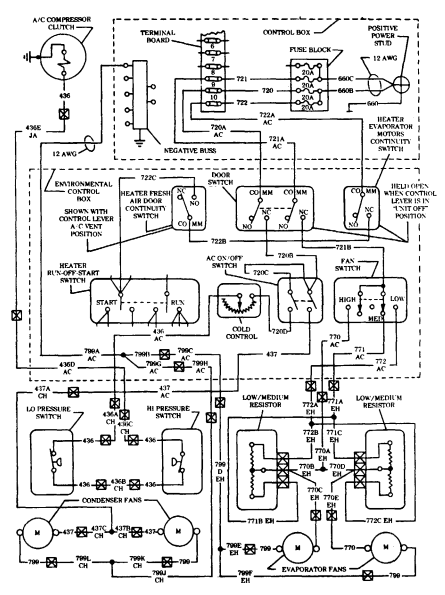
Replace cold control, refer to DS Maintenance.

AMBULANCE
-
Connect RED clip to the indicated test point, BLACK clip to negative or ground.
-
Start Test 89, DC volts.
-
Displayed reading is in volts.
Battery Voltage Multimeter
- Set the voltmeter to a DC volts scale of at least 2. Connect the RED lead to positive and the BLACK lead to negative. 3. Be sure to read the correct scale.

40 volts.

AMBULANCE
-
Connect RED clip to the indicated test point, BLACK clip to negative or ground.
-
Start Test 89, DC volts.
-
Displayed reading is in volts.
Battery Voltage Multimeter
-
Set the voltmeter to a DC volts scale of at least 40 volts.
-
Connect the RED lead to positive and the BLACK lead to negative.
-
Be sure to read the correct scale.

Replace high pressure switch, refer to DS Maintenance.

AMBULANCE
0-45 Dc Volts
STEACE-R TEST 89 1. Connect RED clip to the indicated test point, BLACK clip to negative or ground.
-
Start Test 89, DC volts.
-
Displayed reading is in volts.
Replace compressor wiring hamess, refer to (para. 4-122). Repair lead, refer to (para. 4-85).
Repair lead connector, refer to (para. 4-85).


AMBULANCE 0-4500 DC OHMS STEACE-R TEST 91 1. Connect RED clip and BLACK clip to the indicated terminals in question; RED to the first, BLACK to the second. 2. Start Test 91, 0-4500 ohms.
- Displayed reading is in ohms. Less than 5 ohms is continuity. If the resistance is over 4500 ohms, STE/ICE displays "9.9.9.9."

Repair lead, refer to (para. 4-85).
Repair lead connector, refer to (para. 4-85).

AMBULANCE REFERENCE INFORMATION

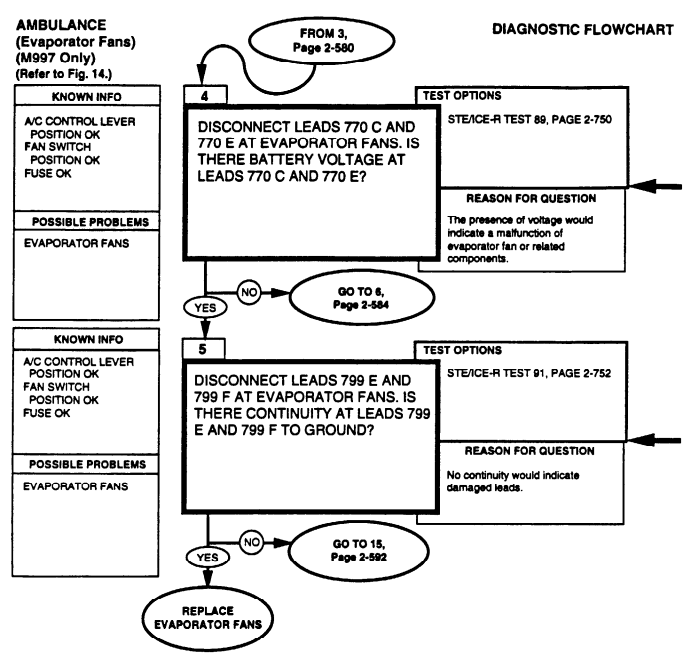
Ambulance 0-45 Dc Volts Steace-R Test 89
-
Connect RED clip to the indicated test point, BLACK clip to negative or ground. 2. Start Test 89, DC volts.
-
Displayed reading is in volts.

-
Connect RED clip and BLACK clip to the indicated terminals in question; RED to the first, BLACK to the second.
-
Start Test 91, 0-4500 ohms.
-
Displayed reading is in ohms. Less than 5 ohms is continuity. If the resistance is over 4500 ohms, STE/ICE displays "9.9.9.9."

AMBULANCE

€ Repair lead, refer to (para. 4-85).
Repair lead connector, refer to (para. 4-85).
-
Connect RED clip to the indicated test point, BLACK clip to negative or ground.
-
Start Test 89, DC volts.
-
Displayed reading is in volts.

AMBULANCE Repair lead,

refer to (para. 4-85).
Repair lead connector, refer to (para. 4-85).
-
Connect RED clip to the indicated test point, BLACK clip to negative or ground.
-
Start Test 89, DC volts.
-
Displayed reading is in volts.
Replace door switch, refer to DS Maintenance.
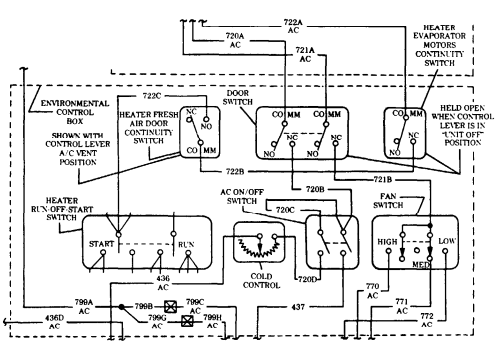
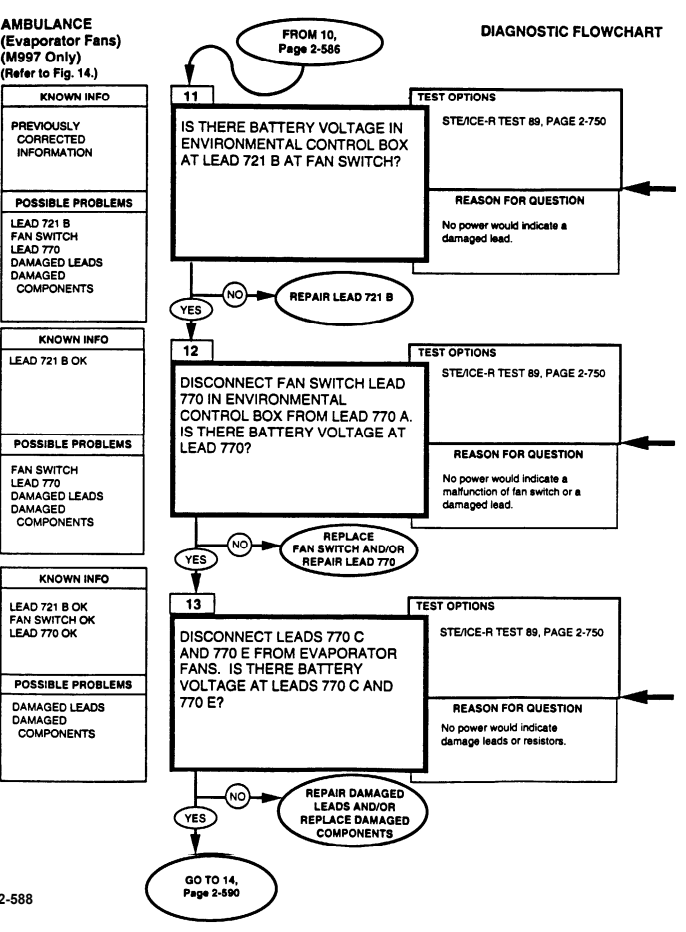
REFERENCE INFORMATION AMBULANCE 0-45 DC VOLTS STEACE-R TEST 89 1. Connect RED clip to the indicated test point, BLACK clip to negative or ground.
-
Start Test 89, DC volts.
-
Displayed reading is in volts.

Repair lead, refer to (para. 4-85).

REFERENCE INFORMATION AMBULANCE

AMBULANCE Repair lead, refer to (para. 4-85).
Repair lead connector, refer to (para. 4-85).
-
Connect RED clip and BLACK clip to the indicated terminals in question; RED to the first, BLACK to the second. 2. Start Test 91, 0-4500 ohms.
-
Displayed reading is in ohms. Less than 5 ohms is continuity. If the resistance is over 4500 ohms, STE/ICE displays "9.9.9.9."


AMBULANCE Repair lead, refer to (para. 4-85). Repair lead connector, refer to (para. 4-85).
-
Connect RED clip and BLACK clip to the indicated terminals in question; RED to the first, BLACK to the second.
-
Start Test 91, 0-4500 ohms.
-
Displayed reading is in ohms. Less then 5 ohms Is continuity. If the resistance is over 4500 ohms, STE/ICE displays "9.9.9.9."
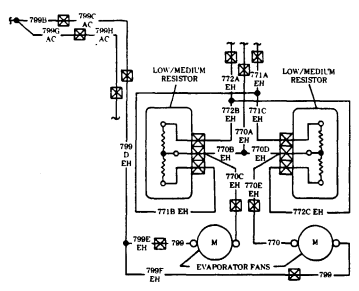
Repair lead, refer to (para. 4-85). Repair lead connector, refer to (para. 4-85).
AMBULANCE

TM 9-2320-280-20-1 REFERENCE INFORMATION AMBULANCE Replace evaporator fans, refer to (para.11-198).


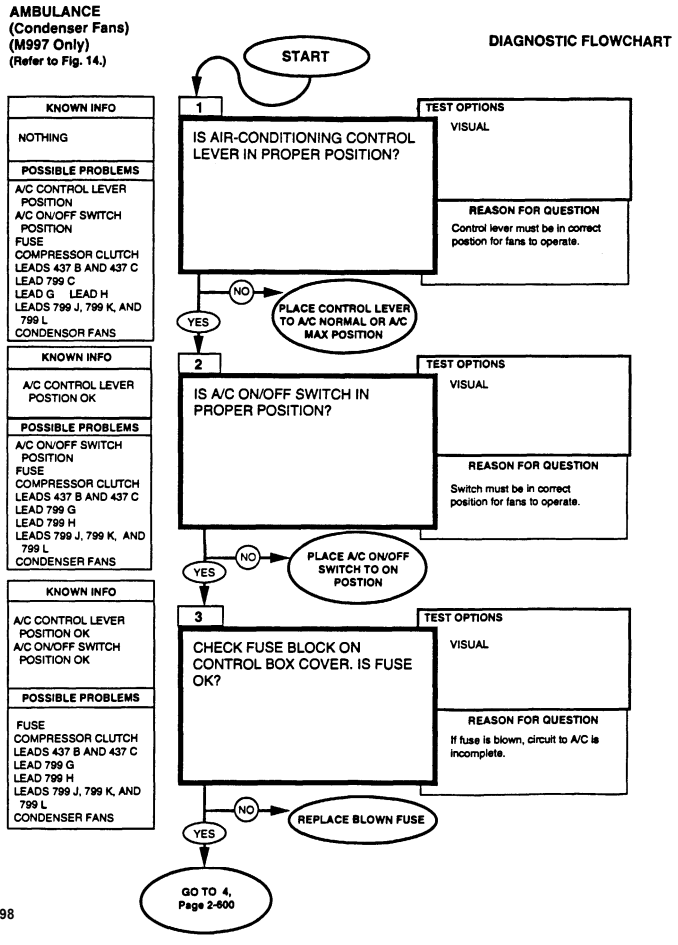
REFERENCE INFORMATION AMBULANCE



AMBULANCE Repair leads, refer to (para. 4-85).
Repair lead connectors, refer to (para. 4-85).
-
Connect RED clip to the indicated test point, BLACK clip to negative or ground.
-
Start Test 89, DC volts.
-
Displayed reading is in volts.
Repair lead, refer to (para. 4-85).
Repair lead connector, refer to (para. 4-85).
-
Connect RED clip and BLACK clip to the Indicated terminals in question; RED to the first, BLACK to the second.
-
Start Test 91, 0-4500 ohms.
-
Displayed reading is in ohms. Less than 5 ohms is continuity. If the resistance is over 4500 ohms STE/ICE displays "9.9.9.9."

AMBULANCE
Reference Information
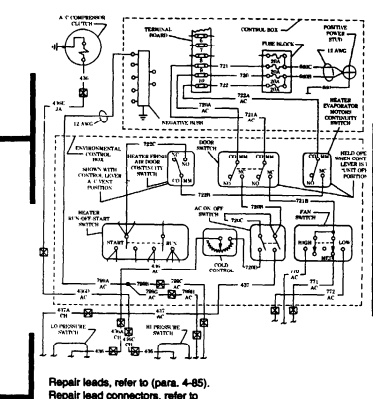
(para. 4-85).
-
Connect RED clip and BLACK clip to the indicated terminals in question; RED to the first, BLACK to the second.
-
Start Test 91, 0-4500 ohms.
-
Displayed reading is in ohms. Less than 5 ohms is continuity. If the resistance is over 4500 ohms STE/ICE displays "9.9.9.9."
-
Set the voltmeter to an ohms scale of about 1000 ohms.
-
Connect the RED and BLACK leads to the connections stated in the question.
-
Be sure to read the correct scale. Less than 5 ohms indicates continuity. For an open circuit, the meter should peg full scale (needle all the way to the left).

Replace condenser fans, refer to (para. 11-201).

REFERENCE INFORMATION AMBULANCE Repair leads, refer to (para. 4-85).
Repair lead connector, refer to (para. 4-85).
-
Connect RED clip and BLACK clip to the indicated terminals in question; RED to the first, BLACK to the second.
-
Start Test 91, 0-4500 ohms.
-
Displayed reading is in ohms. Less than 5 ohms is continuity. If the resistance is over 4500 ohms STE/ICE displays "9.9.9.9." Repair lead, (refer to 4-85).
Repair lead connector, refer to (para. 4-85).
Replace condenser fan, refer to (para. 11-201).
-
Connect RED clip to the indicated test point, BLACK clip to negative or ground.
-
Start Test 89, DC volts.
-
Displayed reading is in volts.
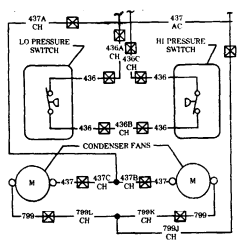
AMBULANCE

AMBULANCE

Remove heater compartment panel, refer to (para. 11-214).
Installation/adjustment of fan duct door linkage, refer to (para. 11-211).

AMBULANCE
-
Connect RED clip to the indicated test point, BLACK clip to negative or ground.
-
Start Test 89, DC volts. 3. Displayed reading is in volts.
Battery Voltage
MULTIMETER
-
Set the voltmeter to a DC volts scale of at least 40 volts.
-
Connect the RED lead to positive and the BLACK lead to negative.
-
Be sure to read the correct scale.
Repair lead, refer to (para. 4-85).

Repair lead, refer to (para. 4-85).
Repair lead connector, refer to (para. 4-85).

AMBULANCE

0-45 Dc Volts
Steace-R Test 89
-
Connect RED clip to the indicated test point, BLACK clip to negative or ground.
-
Start Test 89, DC volts.
-
Displayed reading is in volts.
Battery Voltage Multimeter
-
Set the voltmeter to a DC volts scale of at least 40 volts.
-
Connect the RED lead to positive and the BLACK lead to negative.
-
Be sure to read the correct scale.
Repair lead, refer to (para. 4-85).
Repair lead connector, refer to (para. 4-85).
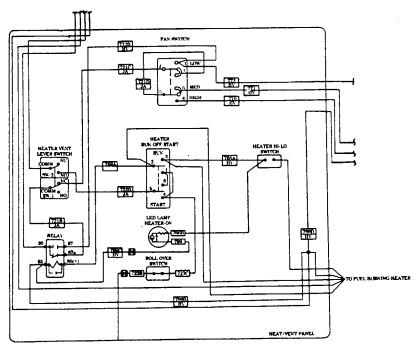
Replace relay, refer to (para. 4-120).

AMBULANCE
-
Connect RED clip to the indicated test point, BLACK clip to negative or ground.
-
Start Test 89, DC volts.
-
Displayed reading is in volts.

-
Connect RED clip and BLACK clip to the indicated terminals in question; RED to the first, BLACK to the second.
-
Start Test 91, 0-4500 ohms.
-
Displayed reading is in ohms. Less than 5 ohms is continuity. If the resistance is over 4500 ohms STE/ICE displays "9.9.9.9.9." Replace fan switch, refer to (para. 4-127).
AMBULANCE

REFERENCE INFORMATION AMBULANCE

AMBULANCE
0-4500 Ohms
STEACE -R TEST 91 1. Connect RED clip and BLACK clip to the indicated terminals in question; RED to the first, BLACK to the second.
-
Start Test 91, 0-4500 ohms.
-
Displayed reading is in ohms. Less than 5 ohms is continuity. If the resistance is over 4500 ohms STE/ICE displays "9.9.9.9."
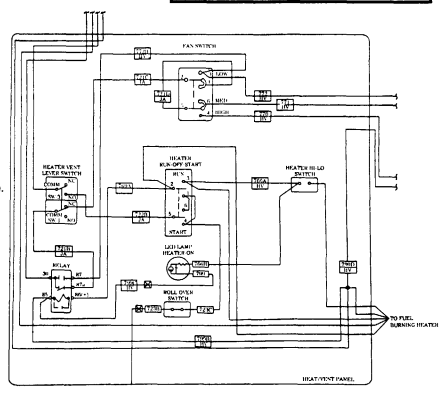
Repair lead, refer to (para. 4-85).
Repair lead connector, refer to (para. 4-85).
Repair lead, refer to (para. 4-85).
Replace blower assembly, refer to (para. 11-212).

AMBULANCE

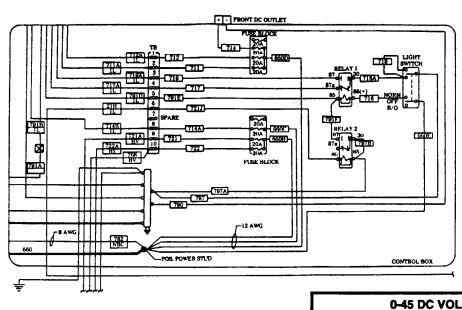
Ambulance Steace-R Test 89
-
Connect RED clip to the indicated test point, BLACK clip to negative or ground.
-
Start Test 89, DC volts.
-
Displayed reading is in volts.
Battery Voltage Multimeter
-
Set the voltmeter to a DC volts scale of at least 40 volts.
-
Connect the RED lead to positive and the BLACK lead to negative.
-
Be sure to read the correct scale.
Repair lead, refer to (para. 4-85).

AMBULANCE

-
Connect RED clip to the indicated test point, BLACK clip to negative or ground.
-
Start Test 89, DC volts.
-
Displayed reading is in volts.
Repair lead, refer to (para. 4-85). Repair lead connector, refer to (para. 4-85).
Replace heater fuel pump, refer to (para. 11-194).
-
Connect RED clip and BLACK clip to the indicated terminals in question; RED to the first, BLACK to the second.
-
Start Test 91, 0-4500 ohms. 3. Displayed reading is in ohms. Less than 5 ohms is continuity. If the resistance is over 4500 ohms STE/ICE displays "9.9.9.9."

REFERENCE INFORMATION AMBULANCE
-
Connect RED clip to the indicated test point, BLACK clip to negative or ground.
-
Start Test 89, DC volts.
-
Displayed reading is in volts.

Repair lead, refer to (para. 4-85).
Repair lead connector, refer to (para. 4-85).
Repair lead, refer to (para. 4-85).
Repair lead connector, refer to (para. 4-85).
20 44
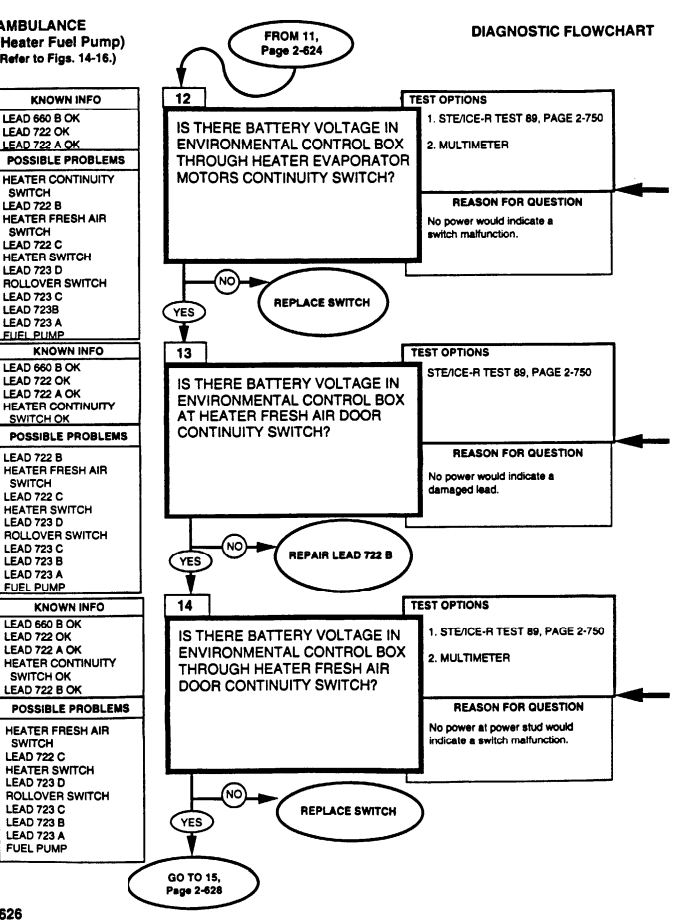
REFERENCE INFORMATION AMBULANCE Replace Heater Evaporator Motors continuity switch, refer to DS Maintenance.
-
Connect RED clip to the indicated test point, BLACK clip to negative or ground.
-
Start Test 89, DC volts.
-
Displayed reading is in volts.
Battery Voltage Multimeter
-
Set the voltmeter to a DC volts scale of at least 40 volts.
-
Connect the RED lead to positive and the BLACK lead to negative.
-
Be sure to read the correct scale.

Replace Heater Fresh Air Door continuity switch, refer to DS Maintenance.

AMBULANCE
Reference Information 0-45 Dc Volts Steace-R Test 89
-
Connect RED clip to the indicated test point, BLACK clip to negative or ground.
-
Start Test 89, DC volts. 3. Displayed reading is in volts.
Battery Voltage
MULTIMETER
-
Set the voltmeter to a DC volts scale of at least 40 volts.
-
Connect the RED lead to positive and the BLACK lead to negative. 3. Be sure to read the correct scale.
Replace Heater Switch, refer to (para. 4-126 or 4-127).

Repair lead, refer to (para. 4-85).
Repair lead connector, refer to (para. 4-85).
Repair lead, refer to (para. 4-85).

AMBULANCE Replace Rollover Switch, refer to (para. 4-126 or 4-127).
-
Connect RED clip to the indicated test point, BLACK clip to negative or ground.
-
Start Test 89, DC volts. 3. Displayed reading is in volts.
Battery Voltage Multimeter
-
Set the voltmeter to a DC volts scale of at least 40 volts.
-
Connect the RED lead to positive and the BLACK lead to negative. 3. Be sure to read the correct scale.
Repair lead.
refer to (para. 4-85).
Repair lead connector, refer to (para. 4-85).


REFERENCE INFORMATION AMBULANCE Repair lead, refer to (para. 4-85).
Repair lead connector, refer to (para. 4-85).
-
Connect RED clip to the indicated test point, BLACK clip to negative or ground.
-
Start Test 89, DC volts.
-
Displayed reading is in volts.
Replace Heater Fuel Pump, refer to (para. 11-194).
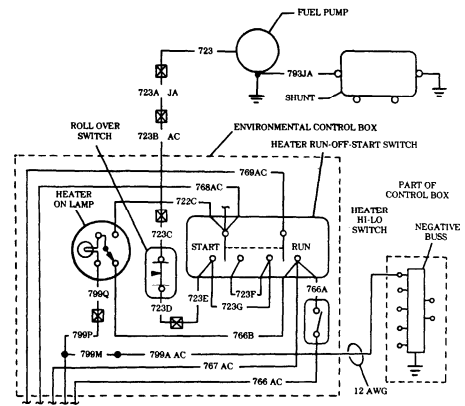

Ambulance

Repair lead, refer to (para. 4-85).
Repair lead, refer to (para. 4-85).
Repair lead connector, refer to (para. 4-85).
Replace Heater on Lamp, refer to (para. 4-126 or 4-127).
-
Connect RED clip and BLACK clip to the indicated terminals in question; RED to the first, BLACK to the second.
-
Start test 91, 0-4500 ohms.
-
Displayed reading is in ohms. Less than 5 ohms is continuity. If the resistance is over 4500 ohms, STE/ICE displays "9.9.9.9."

REFERENCE INFORMATION AMBULANCE


AMBULANCE

Repair/replace fuel fitter, refer to (para. 11-192).
-
Connect RED clip to the indicated test point, BLACK clip to negative or ground.
-
Start Test 89, DC volts.
-
Displayed reading is in volts.
Repair lead, refer to (para. 4-85).
Replace fuel switch, refer to (para. 4-127).

AMBULANCE Repair lead, refer to (para. 4-85).
Repair lead connector, refer to (para. 4-85).
0-45 DC VOLTS STEACE-R TEST 89 1. Connect RED clip to the indicated test point, BLACK clip to negative or ground.
-
Start Test 89, DC volts.
-
Displayed reading is in volts.
Replace heater assembly, refer to (para. 11-190 or 11-209).


AMBULANCE

Repair lead, refer to (para. 4-85).
Repair lead connector, refer to (para. 4-85).
-
Connect RED clip to the Indicated test point, BLACK clip to negative or ground.
-
Start Test 89, DC volts.
-
Displayed reading is in volts.
Battery Voltage Multimeter
-
Set the voltmeter to volts scale of at least 40 volts. 2. Connect the RED lead to positive and the black lead to negative.
-
Be sure to read the correct scale.
Replace Rollover Switch, refer to (para. 4-127).

AMBULANCE
Repair lead, refer to (para. 4-85). Repair lead connector, refer to (para. 4-85).
0-45 DC VOLTS STEACE-R TEST 89 1. Connect RED clip to the indicated test point, BLACK clip to negative or ground.
-
Start Test 89, DC volts.
-
Displayed reading is in volts.


AMBULANCE Replace fuel pump, refer to (para. 11-194).
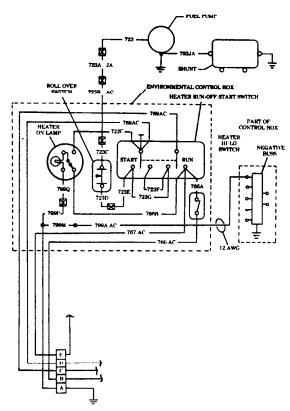
Replace heater assembly, refer to (para. 11-190 or 11-209).
0-45 DC VOLTS STEACE-R TEST 89 1. Connect RED clip to the indicated test point, BLACK clip to negative or ground.
-
Start Test 89, DC volts.
-
Displayed reading is in volts.

AMBULANCE


AMBULANCE
-
Connect RED clip to the indicated test point, BLACK clip to negative or ground.
-
Start Test 89, DC volts.
-
Displayed reading is in volts.
Battery Voltage Multimeter
-
Set the voltmeter to a DC volts scale of at least 40 volts.
-
Connect the RED lead to positive and the BLACK lead to negative.
-
Be sure to read the correct scale.

Repair lead, refer to (para. 4-85).
Repair lead connector, refer to (para. 4-85).
Repair lead, refer to (para. 4-85).

AMBULANCE

EVAPORATUR
-
Connect RED clip to the indicated test point, BLACK clip to negative or ground.
-
Start Test 89, DC volts.
-
Displayed reading is in volts.
Battery Voltage
MULTIMETER
-
Set the voltmeter to volts scale of at least 40 volts.
-
Connect the RED lead to positive and the black lead to negative.
-
Be sure to read the correct scale.
Replace Heater Evaporator Motors continuity switch, refer to DS Maintenance.

AMBULANCE Repair lead, refer to (para. 4-85).
-
Connect RED clip to the indicated test point, BLACK clip to negative or ground.
-
Start Test 89, DC volts.
-
Displayed reading is in volts.
Battery Voltage Multimeter
-
Set the voltmeter to volts scale of at least 40 volts.
-
Connect the RED lead to positive and the black lead to negative.
Replace heater fresh air door continuity switch, refer to DS Maintenance.
- Be sure to read the correct scale.
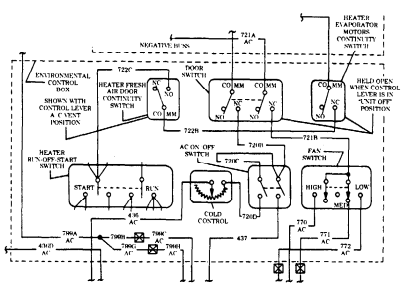
Repair lead, refer to (para. 4-85).

AMBULANCE
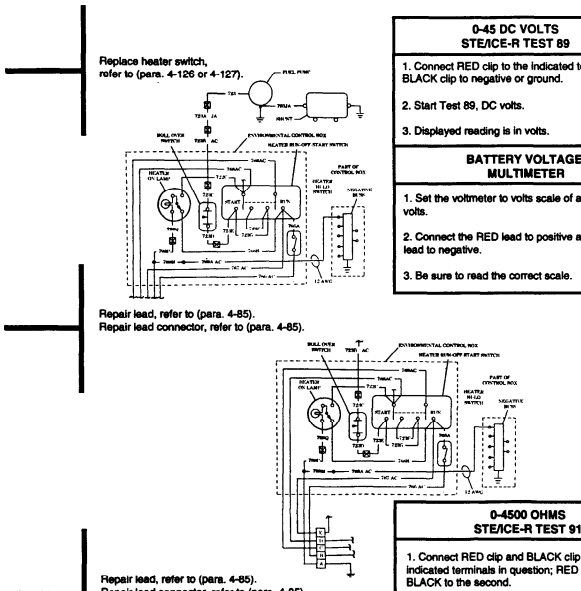
Repair lead connector, refer to (para. 4-85).
-
Start Test 91, 0-4500 ohms.
-
Displayed reading is in ohms. Less than 5 ohms is continuity. If the resistance is over 4500 ohms, STE/ICE displays "9.9.9.9.9."

TM 9-2320-280-20-1 REFERENCE INFORMATION

AMBULANCE Replace heater assembly, refer to (paras.11-190 or 11-209).

AMBULANCE

SHITU

- Connect RED clip to the indicated test point, BLACK clip to negative or ground. 2. Start Test 89, DC volts. 3. Displayed reading is in volts.
Replace NBC filter blower, refer to DS Maintenance.
-
Connect RED clip and BLACK clip to the indicated terminals in question; RED to the first, BLACK to the second. 2. Start Test 91, 0-4500 ohms.
-
Displayed reading is in ohms. Less than 5 ohms is continuity. If the resistance is over 4500 ohms, STE/ICE displays "9.9.9.9."

AMBULANCE
0-45 Dc Volts
STEACE-R TEST 89 1. Connect RED clip to the indicated test point,

BLACK clip to negative or ground. 2. Start Test 89, DC volts.
- Displayed reading is in volts.
Battery Voltage
MULTIMETER
- Set the voltmeter to a DC volts scale of at

- Connect the RED lead to positive and the


AMBULANCE
0-45 DC VOLTS STEACE-R TEST 89 1. Connect RED clip to the indicated test point, BLACK clip to negative or ground.
-
Start Test 89, DC volts.
-
Displayed reading is in volts.

Repair lead, refer to (para. 4-85).

AMBULANCE 0-45 DC VOLTS STEACE-R TEST 89 1. Connect RED clip to the indicated test point, BLACK clip to negative or ground.
-
Start Test 89, DC volts.
-
Displayed reading is in volts.

Replace NBC switch, refer to DS Maintenance.

AMBULANCE REFERENCE INFORMATION

0-4500 Ohms
STEACE R TEST 91 1. Connect RED clip and BLACK clip to the Indicated terminals in question; RED to the first, BLACK to the second.
-
Start Test 91, 0-4500 ohms.
-
Displayed reading in ohms. Less than 5 ohms is continuity. If the resistance is over 4500 ohms, STE/ICE displays "9.9.9.9."


Reference Information
AMBULANCE
Repair lead, refer to (para. 4-85).
-
Connect RED clip and BLACK clip to the indicated terminals in question; RED to the first, BLACK to the second.
-
Start Test 91, 0-4500 ohms. 3. Displayed reading in ohms. Less than 5 ohms Is continuity. If the resistance is over 4500 ohms, STE/ICE displays "9.9.9.9." Replace NBC filter blower, refer to DS Maintenance.

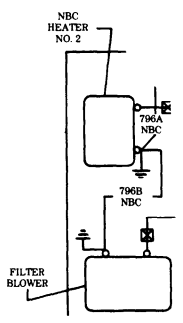

AMBULANCE


AMBULANCE

0-45 DC VOLTS STEACE-R TEST 89 1. Connect RED clip to the indicated test point, BLACK clip to negative or ground.
-
Start Test 89, DC volts.
-
Displayed reading is in volts.

AMBULANCE 0-45 DC VOLTS STEACE-R TEST 89 1. Connect RED clip to the indicated test point, BLACK clip to negative or ground.
-
Start Test 89, DC volts.
-
Displayed reading is in volts.

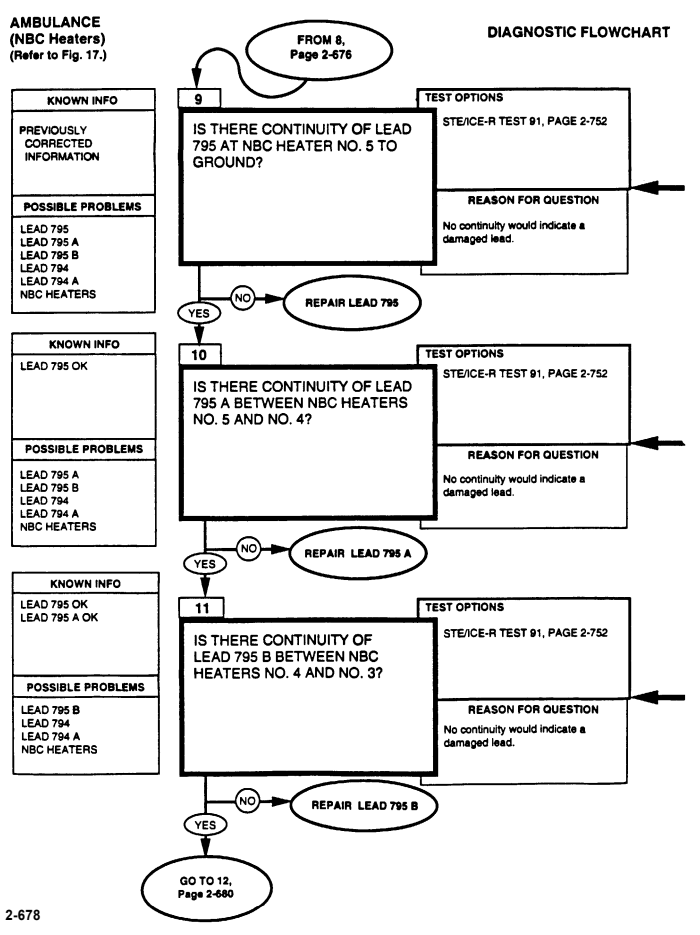
AMBULANCE 0-4500 OHMS STEACE-R TEST 91 1. Connect RED clip and BLACK clip to the indicated terminals in question; RED to the first, BLACK to the second.

- Displayed reading is in ohms. Less than 5 ohms is continuity. If the resistance is over 4500 Repair lead, refer to (para. 4-85).

Reference Information
AMBULANCE Repair lead, refer to (para. 4-85).
-
Connect RED clip and BLACK clip to the Indicated terminals in question; RED to the first, BLACK to the second.
-
Start Test 91, 0-4500 ohms. 3. Displayed reading is in ohms. Less than 5 ohms is continuity. If the resistance is over 4500 ohms, STE/ICE displays "9.9.9.9."


AMBULANCE

Repair lead, refer to (para. 4-85).
Repair lead connector, refer to (para. 4-85).
- Connect RED clip to the indicated test point, BLACK clip to negative or ground.
| 2. Start Test 89, DC volts. |
|---|
- Displayed reading is in volts.
Repair lead, refer to (para. 4-85).
Replace NBC heater, refer to (para. 11-164).
-
Connect RED clip and BLACK clip to the indicated terminals in question; RED to the first, BLACK to the second.
-
Start Test 91, 0-4500 ohms.
-
Displayed reading is in ohms. Less than 5 ohms is continuity. If the resistance is over 4500 ohms, STEACE displays "9.9.9.9."
Malfunction Test Or Inspection

Figure 11. Lighting System
MALFUNCTION TEST OR INSPECTION

Figure 12. Aspirator System
Malfunction
TEST OR INSPECTION

Figure 13. DC Voltage System
MALFUNCTION
Test Or Inspection

०३०
Figure 14. Air-Conditioning Control System
Malfunction

Figure 15. M996 and M996A1 Heater/Ventilation Control Box and Blower Fan MALFUNCTION TEST OR INSPECTION
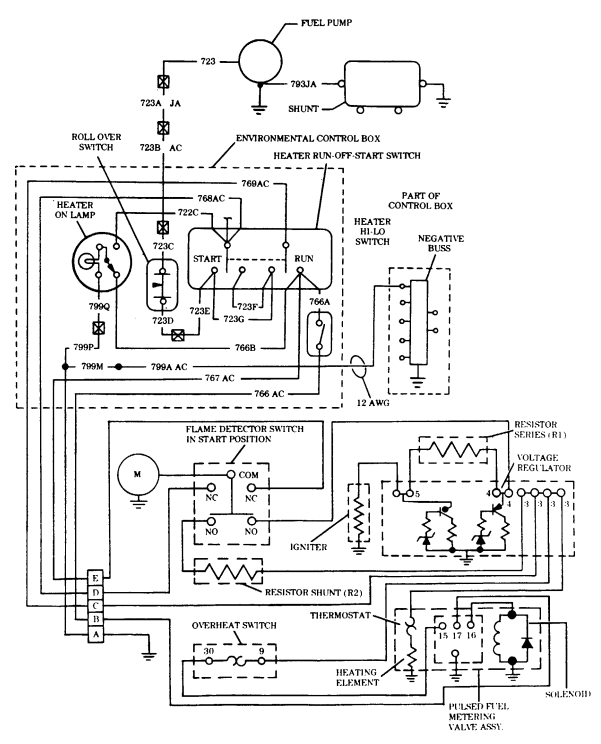
Figure 16. Heater Control System
Malfunction Test Or Inspection
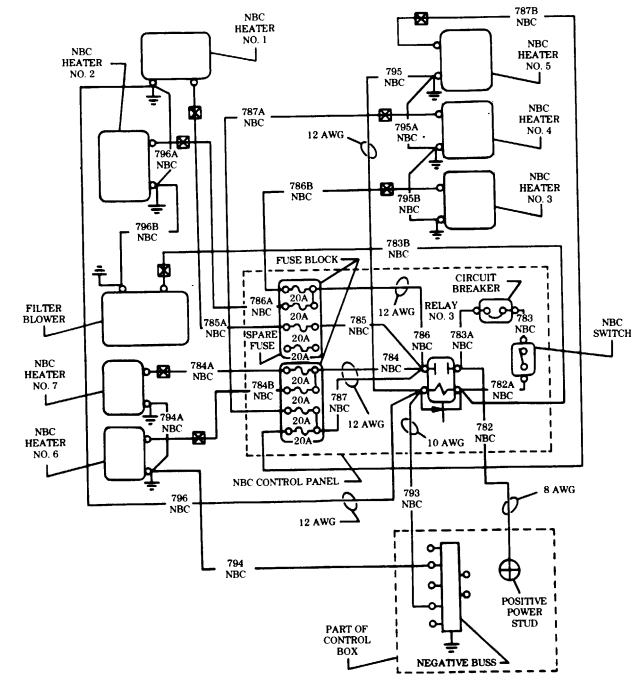
2-40. Ambulance Mechanical System Tests
These ambulance system mechanical tests may be run anytime you think you have an ambulance mechanical problem or if you were sent here by another test chain. Just follow the path, answering the questions. Additional information and notes are given on the facing page when necessary.
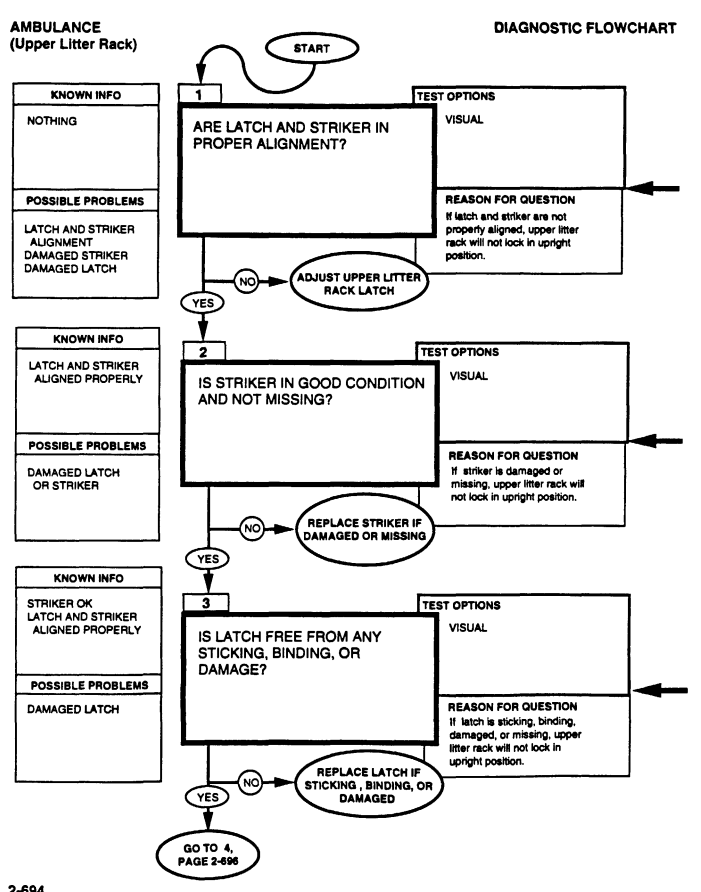
REFERENCE INFORMATION

AMBULANCE Adjust upper litter rack latch, refer to (para. 11-142).




REFERENCE INFORMATION AMBULANCE Unhook suspension straps, refer to (TM 9-2320-280-10).

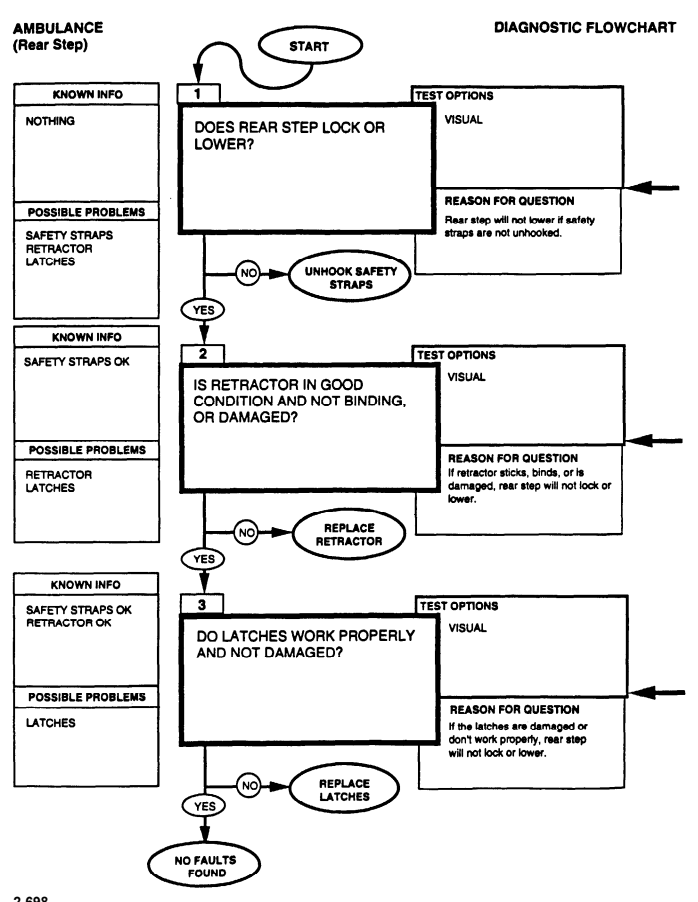
2-698 REFERENCE INFORMATION

AMBULANCE Unhook safety straps, refer to (TM 9-2320-280-10).




REFERENCE INFORMATION AMBULANCE Replace latch rods, refer to (para. 11-128).






TM 9-2320-280-20-1
AMBULANCE To ensure the proper alignment of
 attendant seat tracks and rails, remove and reinstall attendant seat making sure that tracks fully engage. Refer to
(para. 11-157).
attendant seat tracks and rails, remove and reinstall attendant seat making sure that tracks fully engage. Refer to
(para. 11-157).
Replace latch, refer to (para. 11-157).


Replace spring, refer to (para. 11-157).


TM 9-2320-280-20-1 REFERENCE INFORMATION AMBULANCE


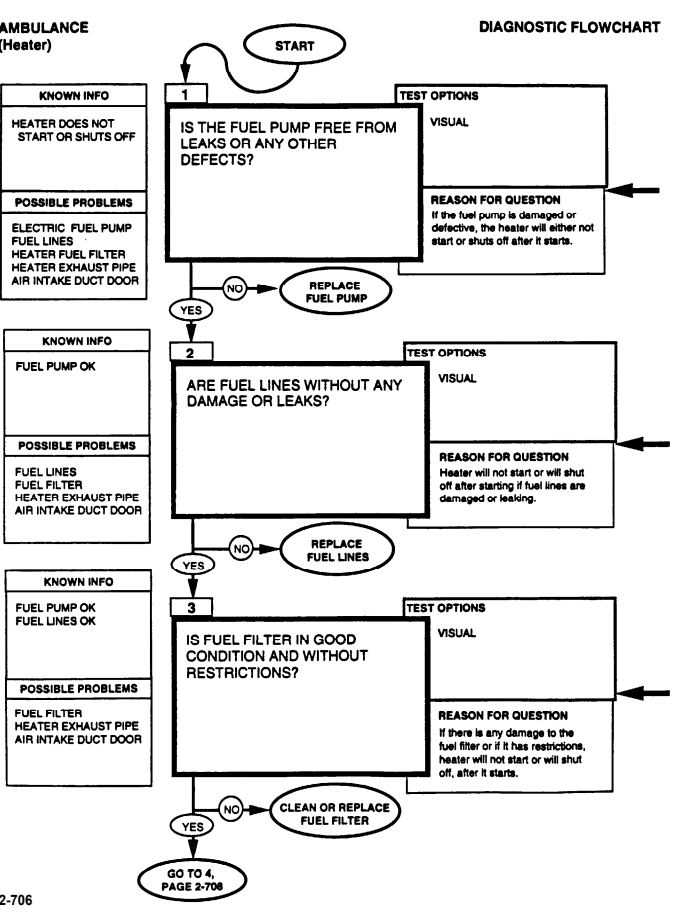
TM 9-2320-280-20-1 REFERENCE INFORMATION AMBULANCE




REFERENCE INFORMATION AMBULANCE Clean or replace heater exhaust pipe, refer to


(para. 11-189 or 11-207).
Adjust or replace door cable, refer to (para. 11-199).

Replace duct door, refer to (para. 11-185).
At the completion of the mechanical troubleshooting


steps, the heater should start. If not, there might be an electical problem. Refer to electrical troubleshooting section, para. 2-39 (heater electrical troubleshooting, page 2-636).

AMBULANCE Turn on air-conditioning and set controls to

maximum cooling and blower speed settings (TM 9-2320-280-10). Maintain engine speed at 1500 rpm with hand throttle. Verify rpm with STE/CE equipment. Open ambulance body doors to allow flow of fresh air through vehicle. Run air-conditioner five minutes to allow temperature and pressure to stabilize.
Check outlet ducts for cool air.
Adjust drivebelt, refer to (para. 11-202).

Properly adjust evaporator intake cable and
 heater/air-conditioning outlet cable, refer to
(para. 11-199).
heater/air-conditioning outlet cable, refer to
(para. 11-199).

REFERENCE INFORMATION AMBULANCE Repair or replace latch, refer to (para. 11-163).




2-41. Winch System Tests
These winch system tests may be run anytime you think you have a winch problem or if you were sent here by another test chain, Just follow the path and answer the questions. Additional information and notes are given on the facing page when necessary.

REFERENCE INFORMATION WINCH
1.Connect RED clip to the indicated test point, BLACK clip to negative or ground. 2. Start Test 89, DC volts.
- Displayed reading is in volts.
Battery Voltage Multimeter
-
Set the voltmeter to a DC voits scale of at least 40 volts.
-
Connect the RED lead to positive and the BLACK lead to negative.
-
Be sure to read the correct scale.
Repair/replace winch power cables, refer to (para. 10-107 or 10-108).
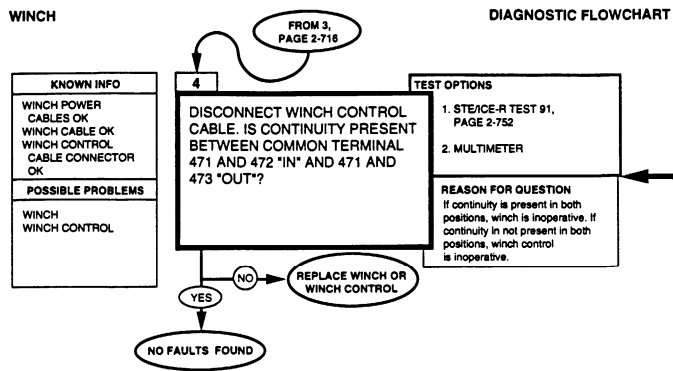
Winch

-
Connect RED clip and BLACK clip to the indicated terminals in question; RED to the first, BLACK to the second.
-
Start test 91, 0-4500 ohms.
-
Displayed reading is in ohms. Less than 5 ohms is continuity. If the resistance is over 4500 ohms, STE/ICE displays, 9.9.9.9."

-
Set the voltmeter to an ohms scale of about 1000 ohms. 2. Connect the RED and BLACK leads to the connections stated in the question.
-
Be sure to read the correct scale. Less than 5 ohms indicates continuity. For an open circuit, the meter should peg fuil scale (needle all the way to the left).

TM 9-2320-280-20-1 REFERENCE INFORMATION ARMAMENT/TOW CARRIERS

2-42. Dca Troubleshooting
These DCA tests can be run anytime you think there is a problem with the vehicle's DCA or its on board transducers. Do not use this paragraph to test the STE/lCE-R and its cables and transducers. Refer to TM 9-4910-571-12&P to test the STE/ICE-R. This paragraph will also supply instructions on how to use the STE/lCE-R in the TK mode to substitute for tests run through the DCA.
The HMMWV is equipped with three transducers - the pulse tachometer, the fuel pressure transducer, and the current shunt. A power test (12, 13) or RPM test (10) uses the pulse tachometer. The fuel pressure test (24) uses the pressure transducer. All of the starting circuit tests and battery tests done through the DCA use the shunt. Check to see that the wires are connected to the transducer for the test you're trying to run. There is a four wire connector for the fuel pressure transducer, a two wire connector for the pulse tachometer, and there are four wires connected to the shunt in addition to the battery cables.
The fold-out page FO-16 gives a cross reference between DCA tests and TK tests. Use this cross reference to find out how to substitute TK tests for DCA tests if you have a bad DCA. The Location of Parts page has a schematic of the HMMWV DCA.
2-723

DCA TROUBLESHOOTING NOTE The diagnostics in this chapter assume you have already run a test through the DCA. If you haven't run a test and are here to test the entire DCA, run tests 10 (RPM), 24 (Fuel Pressure) and 80 (BatteryCurrent) Make note of the results for later. If you want to test the entire DCA hamess, answer YES

here and then return and answer NO when you've finished the test chain. Answer NO here to test the shunt.
Answer NO here to test the pulse tachometer.
Repair wiring or replace transducer, refer to (para 4-26).

DCA TROUBLESHOOTING The fuel pressure should always be greater than 3 psi. If you get about the same pressure with the 2 transducers, then you have a fuel system problem. Remove fuel pressure transducer, refer to (para 4-26). Make sure the STE/ICE-R is powered by a W5 cable.
Steace-R Test 49 0 To 25 Psig Pressure
-
CONNECT RED TRANSDUCER TO FUEL FILTER.
-
CONNECT TRANSDUCER TO A W4 CABLE.
MAKE SURE THE SYSTEM UNDER TEST IS NOT PRESSURIZED. CONNECT OTHER END OF W4 TO J2 OR J3. PERFORM OFFSET TEST.
- TURN ON SYSTEM AND READ PRESSURE.
You will have to decide if test 24 gave the wrong result. If test 24 gave a substantially different result than test 49, answer NO to this question.
NOTE VEHICLE DCA FAULTY. Use the STE/ICE-R in the TK mode for the rest of your testing. See the chart on the foldout page for a way to run the rest of the DCA tests in the TK Mode. Have DS maintenance repair the DCA when you're finished.

REFERENCE INFORMATION DCA TROUBLESHOOTING Make sure the STE/ICE-R is powered by a W5 cable. If the TK mode test tells you that the vehicle has a fault, then return to the paragraph you came from. If the vehicle tests OK, continue here.
You will have to decide if the DCA test result is wrong. If the TK test gave a substantially different result than the DCA test, answer NO to this question.
NOTE VEHICLE DCA FAULTY. Use the STEΛCE-R in the TK mode for the rest of your testing. See the chart on the foldout page for a way to run the rest of the DCA tests in the TK Mode. Have DS maintenance repair the DCA when you're finished.
You can check the connections at the shunt and the power stud to see if they are OK. Look at the schematic for help.

REFERENCE INFORMATION DCA TROUBLESHOOTING Remove tachometer, refer to (para 4-13). If you find the tachometer defective, replace it and return to where you came from and rerun the original DCA test. If it fails again return to this question and answer "YES".
Make sure the STE/ICE-R is powered by the W5 cable.
If you don't find any faults in the vehicle, the slot in the oil pump drive could be too worn to drive the tachometer.
If you see this, notify DS maintenance.
You will have to decide if the DCA test result is wrong.
If the TK test gave a substantially different result than the DCA test, answer "NO" to this question.
NOTE Vehicle DCA faulty. Use the STEACE-R in the TK mode for the rest of your testing. See the chart on the foldout page for a way to run the rest of the DCA tests in the TK mode. Have DS maintenance repair the DCA when you're finished.
2-43. Ste/Ice-R Test Procedures
This paragraph will be helpful when using the STE/lCE-R to answer diagnostic questions. Use this paragraph as a reference if you need additional information about a specific test. This paragraph contains information such as possible errors, test procedure, control codes, and additional notes as necessary. The following chart will help you find the test you need. The STE/lCE setup and internal checks (test no. G01, Page 2-763) must be perfomed prior to performing tests. A complete description and operation of the STE/lCE-R is found on Page 2-753. See TM 9-4910-571-12&P for additional information.
| OIL PRESSURE CHART |
|---|
| ENGINE RPM |
Engine Rpm (Average) Test #10
Description: This procedure measures engine speed in the range 50 to 5000 RPM. At speeds below 50 RPM the VTM will display 0. At speeds above 5000 RPM the display may give a false reading.
Test requires DCA hookup only.
Pre-Test Procedures Run Confidence Test.
Typical Applications: Check Engine Speed Possible Error Messages E014 Incorrect # of cylinders entered Test Procedure:
- Set TEST SELECT switches to 10 2. Press and release TEST button 3. Start engine 4. Observe displayed value (RPM).
Power Test (Rpm/Sec) Test #12
Description:
This procedure measures an engine's power producing potential in units of RFM/SEC. Test requires DCA hookup only.
Pre-Test Procedures: Run Confidence Test. Warm up engine to operating temperature.
Typical Applications:
Check engine power in units of RPM/SEC.
Possible Error Messages:
E009 Engine not running at start of test.
E011 Throttle control operated incorrectly.
E012 Ignition adapter/pulse tachometer missing.
E014 Incorrect number of cylinder entries.
E033 Error in entry of power test constants
Test Procedure:
-
Start and idle engine 2. Set TEST SELECT switches to 10 3. Press and release TEST button 4. Observe displayed value (RPM) to adjust idle Speed if necessary.
-
Press down sharply on accelerator end observe displayed value (RPM) to adjust governor speed if necessary.
-
Set TEST SELECT switches to 12. 7. Press and release TEST button. 8. Wait for prompting message CIP to appear. 9. When CIP appears on display, press down sharply on engine accelerator end hold it to the floor. When VTM displays a number, release accelerator.
-
Observe displayed value (RFM/SEC).
Notes
Engine idle speed must rechecked before performing power test. Idle spead must be within the range 625-675 RPM (6.2L and 6.5L) range to run test.
Engine governor no bad speed must be checked before performing power test. Governor no-load speed must be within the 39004100 RPM (6.2L) end 3600-3600 RPM (6.5L) range to run test.
Power Test (Percent) Test #13
Description:
This procedure measures the percentage of engine's power producing potential as compared to a good engine.
Test requires DCA hookup only.
Pm-lest Procedures: Run Confidence Test. Warm up engine to operating temperature.
Typical Applications: Check engine power
Possible Error Messages:
E009 Engine not running at start of test.
E011 Throttle control operated incorrectly.
E012 Ignition adapter/pulse tachometer missing.
E024 Test not valid for VID entered
Notes:
Engine idle speed must be checked before performing power test. Idle speed must be within the 625-675 RPM (6.2L and 6.5L) range to run test. Engine governor no load speed must be checked before performing power test. Governor no load speed must be within the 3600-3800 RPM (6.2L) and 3900-4100 RPM (6.5L) range to run test.
Test Procedure:
-
Start and idle engine 2. Set TEST SELECT switches to 10 3. Press and release TEST button 4. Observe displayed value (RPM) to adjust idle speed if necessary.
-
Press down sharply on on engine accelerator and observe displayed value (RPM) to adjust governor speed if necessary.
-
Set TEST SELECT switches to 13. 7. Press and release TEST button. 8. Wait for prompting message CIP to appear. 9. When CIP appears on display, press down sharply on engine accelerator and hold it to the floor. When VTM displays OFF, release accelerator.
-
A number will be displayed after the engine has returned to idle speed. This number is the test result in units of percent of nominal rated power.
Compression Unbalance Test #14 (6.2L Only)
Description:
This procedure compares the compression between the highest and lowest cylinders and displays the unbalance in percent. Test requires DCA hookup only.
Pre-Test Procedures:
Run Confidence Test. Warmup engine to operating temperature.
Run first-peak series teats 72,73,74, 75.
Typical Applications:
Check compression unbalance of engine with VTM powered from battery of vehicle being tested.
Possible Error Messages:
E006 VTM doesn't detect battery Voltage.
E013 VTM cannot use date received.
E027 Error in entry of compression Unbalance constants.
E032 Vehicle's cranking speed is varying too much for a compression unbalance measurement.
Test Procedure:
-
Set up engine to prevent Starting by disconnecting wire 54A. Stop Engine. Shut off fuel before cranking. Crank engine without fuel for 5 seconds to dear fuel from cylinders.
-
Set TEST SELECT switches to 14.
-
Press and release TEST button.
-
Wait until GO appears on display before proceeding.
-
When GO appears, crank engine. Display will change to while engine is turning.
-
When OFF or E013 appears, stop cranking.
-
If OFF appears, wait for message to appear.
(A) The number displayed will be the percent unbalance between the highest and lowest cylinders. A number above 25 is a failure.
(B) If GO appears, repeat from step 2.
(C) A FAIL message usually means compression is too far unbalanced to measure with STE/ICE.
Note
If E013 appears, test data cannot be analyzed because of weak batteries, or interrupted cranking during test. Correct problem and repeat from Step 2.
Fuel Supply Pressure (Psi) Test # 24
Description:
This procedure measures the return pressure, in order to detect line blockage, leaks or insufficient restrictor back pressure. Test requires DCA hookup only.
Pre-Test Procedure-.
Run Confidence Test. Wait for 1 minute after turning engine off to run this test.
Typical Applications: Fuel Supply Pressure Control Functions: 01,02,03,04,06
Test Procedure:
-
Turn off vehicle.
-
Set TEST SELECT switch to 24. 3. Press and hold TEST button until CAL appears on display.
-
Release TEST button and wait for offset value to appear on display. If offset is within -15 to 15 proceed. If not, go to DCA Troubleshooting Procedure 5. Press and release TEST button. 6. Start engine 7. Observe displayed value.
Possible Error Messages: E005 offset not performed.
Pressure (Psi) 0 To 1000 Test #50
Description: This procedure measures pressure, in the 0 to 1000 PSIG range. Teat requires the use of the TK adapters and transducers.
Pre-Test Procedures Run Confidence Test.
Typical Applications: Oil Pressure Control Functions: 01,02,03,04,06
Test Procedure:
-
Attach connector P1 of cable W4 to J2 TK or J3 TK.
-
Install blue striped pressure transducer where pressure is to be measured. Attach connector P2 of cable W4 to transducer.
-
Set TEST SELECT switch to 50. Press and hold TEST button until CAL appears on display.
-
Release TEST button and wait for offset value to appear on display. If offset is within -150 to 150 proceed. If not, go to DCA Troubteshooting Procedure.
-
Energize system 6. Press and release TEST button. 7. Observe displayed value.
Possible Error Messages E005 Offset not perfomed. E002 Transducer not connected
2-739
Battery Voltage Test #67
Description: Pre-Test Procedures: Run Confidence Test.
| Typical Applications: |
|---|
| Check Battery Voltage |
This procedure measures battery voltage in the 9 to 32 range volts. The voltage is measured directly at the power source of the VTM, and maybe done with the vehicle operating or shut down. Test requires DCA hookup only.
Test Procedure:
| Control Functions: |
|---|
| 01,02,03,04,06 |
-
Set TEST SELECT switch to 67. 2. Press and release TEST button.
-
If .9.9.9.9 is displayed, voltage is not within the test range.
-
Observe displayed value (volts).
Possible Error Messages: none
Starter Motor Voltage Test #68
Description: Pm-Test Procedures: Run Confidence Test.
This procedure measures the voltage present at the starter motor positive terminal, in the 0-32 volts range.
Test requires DCA hookup only.
Typical Applications: Check Starter Motor Voltage Control Functions: 01,02,03,04,06 Test Procedure: Possible Error Messages: none 1. Disconnect Fuel Solenoid wire 54A to prevent starting.
-
Set TEST SELECT switch to 68.
-
Press and release TEST button.
-
Crank the engine and observe the displayed Votage.
Starter Negative Cable Voltage Drop Test #69
Description:
| is required. Notify DS Maintenance. |
|---|
This procedure measures the voltage drop on the starter path. A high voltage (>2V) indicates excessive ground path resistance.
Test requires DCA hookup only.
Pre-Test Procedures: Run Confidence Test.
Test Procedure:
| Control Functions: |
|---|
| 01,02,03,04,06 |
Possible Error Messages: None 1. Disconnect Fuel Solenoid wire 54A to prevent starting.
-
Set TEST SELECT switch to 69.
-
Press and release TEST button.
-
Crank the engine and observe the displayed voltage.
Starter Solenoid Volts Test #70
Description:
| Typical Applications: |
|---|
| Check Starter Solenoid Volts. |
| 1. Discoonned Fuel Solenoid wire 54A toprevent |
|---|
| starting. |
| 2. Set TEST SELECT switch to 70. |
| 3. Press and release TEST button. |
| 4. Crank the engine and observe the displayed - |
This procedure measures the voltage present at the starter solenoids positive terminal. Test requires DCA hookup only.
| Pre-Test Procedures: |
|---|
| Run Confidence Test. |
| Control Functions: 01,02,03,04,08 |
|---|
Test Procedure:
| Possible Error Messages: None |
|---|
voltage.
Possible Error Messages:
Starter Current Average Test #71
Description: This procedure measures the average starter current in the 0 - 1000 amps range. Test requires DCA hookup only.
Pre-Test Procedureas Run Confidence Test.
Typical Applications: Check Starter Current.
Control Functions: 01,02,03,04,08
Test Procedure:
-
Disconnect fuel solenoid wire 54A to prevent startimg.
-
Set TEST SELECT switch to 71. 3. Press and hold TEST button until CAL appears on display.
-
Release TEST button and wait for offset value to appear on display. If offset is within -150 to 150, proceed. If not, go to DCA .Troubleshooting Procedure.
-
Press and release TEST button.
-
Crank engine.
-
Observe the displayed starter current.
Possible Error Messages E005 Offset not performed.
Current Flrst Peak Test #72
Description:
This procedure measures the overall condition of the complete starting system. Test requires DCA hookup only.
Pre-Test Procedures: Run Confidence Test. Warm up engine to operating temperature. Turn off ail electrical accessories.
Typical Applications:
Check conditon of starting system on C1 engines with VTM trdngpowered from battery of vehicle tested.
Possible Error Messages:
E002 Transducer not connected.
E005 Offset not performed.
E008 VTM does not detect battery voltage.
E013 VTM cannot use data received.
E020 No first peak information was detected by the VTM.
E021 VTM cannot calculate result because current is over current probe's range.
Test Procedure:
DiscABonnect fuel solenoid wire 54A to prevent NOTES: starting. Make sure all vehicle accessories are off. Set TEST SELECT switches to 72.
Press and hold TEST button until CAL appears on display. If E013 is displayed, then check battery Release TEST button and wait for offset value connections and correct as necessary. Repeat to appear on display. If offset is within the range Step 6. If E013 persists after 3 tests, VTM -150 to 150, proceed. If not, go to DCA cannot perform test.
Troubteshooting Procedure.
Press and release TEST button. When GO appears on display, crank engine for 2 seconds or until one of the following appears on the display OFF .9.9.9.9 A number An error measage Observe displayed value (amps).
If .9.9.9.9 is displayed, current first peak was too high and cannot be measured with VTM.
Battery Internal Resistance Test #73
Description:
This procedure measures the internal battery resistance. Internal battery resistance is a measure of the state of the batteries. Test requires DCA hookup only.
Pre-Test Procedures:
Run Confidence Test. Turn off all electrical accessories.
Typical Applications:
Evaluate batteries on Cl engines with VTM being powered from battery of vehicle tested.
Possible Error Messages:
E002 Transducer not connected E005 Offset not performed E008 VTM does not detect battery voltage E013 VTM cannot use data received.
E020 No first peak information was detected by the VTM.
E021 VTM cannot calculate result because current is over current probe's range.
Test Procedure:
-
Disconnect fuel solenoid wire 54A from the injector pump to prevent starting.
-
Make sure all vehicle accessories are off. 3. Set TEST SELECT switches to 73. 4. Press and hold TEST button until CAL appears on display.
-
Release TEST button and waif for offset value to appear on display. If offset is within the -150 to 150 range, proceed. If not, go to DCA Troubleshooting Procedure 6. Press and release TEST button. 7. When GO appears on display, crank engine for 2 seconds or until one of the following appears on the display OFF .9.9.9.9 A number An error message 8. Observe displayed value (milliohms). The limit is 25 milliohms per battery pair.
-
Test #75 is Battery Resistance Change. You can run that test after this one if you want to.
Notes:
If .9.9.9.9 is displayed, battery internal resistance was too high and cannot be measured with VTM.
If E013 is displayed, then check battery connections and correct as necessary.
Repeat Step 6. If E013 persists after 3 tests, VTM cannot perform test.
Starter Circuit Resistance Test #74
Description:
This procedure measures starter circuit resistance. Test requires DCA hookup only.
Pre-Test Procedures:
Run Confidence Test Warm up engine to operating temperature. Turn off all electrical accessories.
Typical Applications:
Check resistance of complete starting system in Cl engines with VTM powered from batteries of Vehicle being tested.
Possible Error Messages
E002 Transducer not connected.
E005 Offset not performed. E003 VTM does not detect battery voltage. E013 VTM cannot use data received.
E020 No first peak information was detected by the VTM.
E021 VTM cannot calculate result because current is over current probe's range.
Test Procedure:
-
Disconnect fuel Solenoid wire 54A to prevent starting.
-
Make sure all vehicle accessories are off. 3. Set TEST SELECT switches to 74. 4. Press and hold TEST button until CAL appears on display.
-
Release TEST button and waft for offset value to appear on display. lf offset is within the range -150 to 150, proceed. If not, go to DCA Troubleshooting Procedure.
-
Press and release TEST button. 7. When GO appears on display, crank engine for 2 seconds or until one of the following appears on the display OFF .9.9.9.9 A number An error message 8. Observe displayed value(milliohms).
Notes
If .9.9.9.9 is displayed, the starter circuit resistance value was too high and cannot be measured with VTM. If E013 is displayed, then check battery connections and correct as necessary. Repeat Step 6. If E013 persistes after 3 tests, VTM cannot perform test.
Battery Resistance Change Test #75
Description: This procedure measures the change of battery resistance. Test requires DCA hookup only.
Pre-Test Procedures: Run Confidence Test. Warm up engine to operating temperature. Turn off all electrical accessories.
Typical Applications:
Evaluate batteries in Cl engines with VTM powered from batteries of vehicle being tested.
Possible Error Messages
E002 Transducer not connected. E005 Offset not performed. E006 VTM does not detect battery voltage. E013 VTM cannot use data received. E020 No first peak information was detected by the VTM.
E021 VTM cannot calculate result because current is over current probe's range.
Test Procedure:
-
Disconnect fuel solenoid wire 54A to prevent starting.
-
Make sure all vehicle accessories are off. 3. Set TEST SELECT switches to 75. 4. Press and hold TEST button until CAL appears on display.
-
Release TEST button and wait for offset value to appear on display. If offset is within the -150 to 150 range, proceed. If not, go to DCA Troubleshooting Procedure.
-
Press and release TEST button.
-
When GO appears on display, engage starter for 2 seconds or until one of the following appears on the display OFF .9.9.9.9 A number An error message 8. Observe displayed value (milliohms/second).
The limit is 50 milliohms per battery pair.
A lower number is better than a higher one.
Notes
If .9.9.9.9 is displayed, the battery resistance change value is beyond the range of the VTM and cannot be measured with the VTM. If E013 is displayed, then check battery connections and correct as necessary.
Repeat Step 6. If E013 persistes after 3 tests, VTM cannot perform test.
Battery Current Test #80
Description: This procedure measures current to or from the battery. Test requires DCA hookup only.
Pre-Test Procedures: Run Confidence Test.
| Typical Applications: |
|---|
| Evaluate batteries in CI engines. |
Control Functions 01,02,03,04 Teat Procedure:
-
set TEST SELECT switch to 80.
-
Press and hold TEST button until CAL appears on display.
-
Release TEST button and wait for offset value to appear on display. If offset is within -150 to 150, proceed. lf not, go to DCA Troubleshooting Procedure.
-
Press and release TEST button.
-
Observe displayed value (amps).
Possible Error Messages: E005 Offset not Performed.
Dc Voltage O To 45 Volts Test #89
Description:
This procedure measures voltage in the range of -45 to 45 volts. The VTM is used as a DC voltmeter with the decimal point in the correct position. This test must be done with the component being tested turned on. Test requires the use of the TK adapters and transducers Pre-Test Procedures Run Confidence Test.
Typical Applications:
- Fuel Solenoid
- Starter Solenoid - Alternator Output - Any DC Voltage measurement Control Functions: 01,02,03,04,06
Test Procedure:
-
Connect test probe cable W2. Attach P1 to J4. 2. Connect the desired test leads to P2. 3. Set TEST SELECT switch to 89. 4. Short leads together. Press and hold TEST button until CAL appears on display.
-
Release TEST button and wait for offset value to appear on display.
-
If offset is within -6.8 to 6.8 proceed. If not, go to DCA Troubleshooting Procedure.
-
Press and release TEST button. Observe displayed value.
Possible Error Messages E005 Offset not performed.
Dc Current 0 To 1500 Amps Test #90
This procedure measures DC currant in the range of Run Confidence Test.
0 to 1500 amps. The VTM is used as an ammeter with the decimal point in the right positiion. This test may be done with the vehicle/equipment operating.
Test requires the use of the TK adapters and transducers.
Description: Pre-Test Procedures Typical Applications: Control Functions: 01,02,03,04,06
Test Procedure:
-
Connect test probe cable W4. 2. Attach P1 to J2 or J3. Connect the Current Probe to P2.
-
Set TEST SELECT switch to 90. 4. Clamp probe to da-energized wire. 5. Press and hold TEST button until CAL appears on display.
-
Release TEST button and wait for offset value to appear on display. If offset is within 225 to -225 proceed. If not, go to DCA Troubleshooting Procedure.
-
Energize circuit. Press and release TEST button.
-
Observe displayed value. A negative reading indicates the probe is backwards. Reverse and repeat from step 4.
Possible Error Messages E002 Offset not performed. E005 Transducer not connected.
Resistance And Continuity O To 4500 Ohms Test #91
Description:
This procedure measures resistance in the range of 0 to 4500 ohms. The VTM is used as an ohmmeter, and test results are always displayed with the decimal point in the right position. Additionally, any voltage present in the device being tested will adversely affect test results. Make sure the circuit or component being tested is shut off. Test requires the use of the TK adapters and transducers.
Pre-Test Procedures Run Confidence Test.
Typical Applications:
- Continuity checks - Resistance measurements - Switch and relay functions Control Functions: 01,02,03,04,06
Test Procedure:
-
Connect test probe cable W2. Attach P1 to J4.
-
Connect the desired test leads to P2. 3. Set TEST SELECT switch to 91. 4. Short leads together. Press and hold TEST button until CAL appears on display.
-
Release TEST button and wait for offset value to appear on display.
-
If offset is within -225 to 225 proceed. If no go to DCA Troubleshooting Procedure 7. Press and release TEST button. Observe displayed value.
Possible Error Messages E005 Offset not Performed.
E022 External voltage detected while measuring resistance.
a. STE/ICE-R Description and Operation. The following describes the operation of the Simplified Teat Equipment/Internal Combustion Engines (STE/ICE-R) system and contains detailed operating procedures. It is used to test the serviceability of HMMWV vehicles and to perform primary fault detection and isolation.
After the technician has identified a faulty part or subsystem, he is referred to a paragraph number for replacement or repair procedures for individual parts.
b. Description and Operation. STE/ICE-R is a testing system that performs tests and measurement on internal combustion engines. STE/ICE-R measures standard voltage, current, resistance, pressure, temperature, and speed. Special tests, such as compression balance tests end starter system evaluations, are performed by STE/ICE-R. Standard equipment functions including vacuum pressure gauge, compression gauge, lowcurrent tester, and multimeter are features of the STE/ICE-R set. STE/ICE-R is portable and operates on either 12- or 24-volt vehicle batteries or equivalent power source. The STE/ICE-R system consists of a vehicle test meter (VTM), a transducer kit (TK), four electrical cables, a transit case, and technical publications.
c. Vehicle Test Meter.
-
General. The VTM provides a method for the technician to test vehicle electrical and mechanical components. Readings are either pass/fail indications or digital displays in units familiar to the technician (psi, rpm, volts, ohms, amps, etc.). The diagnostic connector assembly (DCA) is permanently mounted in the vehicle and provides accessibility to the most frequently needed test points. The use of the VTM through the DCA is referred to as DCA mode. The VTM interfaces with the vehicle directly with a transducer from the transducer kit (TK). The use of the VTM through the TK is referred to as TK mode. The DCA and the TK can be used at the same time This may be necessary when the diagnostic connector assembly has a missing transducer. If a transducer is missing, a no sensor indication (E002) is displayed when a measurement is made. If this happens, the TK mode can be used to make the measurement. The use of the VTM through the DCA and TK is referred to as the combined mode. Additional teats can be done that involve manually probing and/or connecting transduce to appropriate test points. Operating power for the VTM is drawn from the vehicle batteries or some equivalent battery source. Power is routed to the VTM through the DCA connected to the battery. The STE/ICE-R general purpose testing capabilities that maybe applied to the vehicle are: 0-1000 psi pressure, 0-45 volts dc and 0-40k ohms resistance. The following control functions can be performed in conjunction with the special tests: interleave (displays rpm with next test), display maximum value, and display minimum value, and display peak-to-peak value.
-
Controls and Indicators. The controls and readout display on the VTM are illustrated. The following paragraphs describe how the controls are used and how the display functions.
(a) Power Switch (PUSH ON/PULL OFF). The power switch controls DC power to the VTM. The VTM can operate from a 12-volt or 24-volt battery system. When the power switch is pushed in (PUSH ON), the VTM power is on. To shut the VTM off, pull out the power switch (PULL OFF). The power switch contains a 4-amp circuit breaker. The power switch will pop out automatically if something is wrong which causes the VTM to use more power than it should. If the switch pops out, check your hookup carefully and try again before returning the VTM to direct support maintenance.
(b) TEST SELECT Switches. The TEST SELECT switches are used to select the actual test to be performed. There are ten positions on each switch numbered 0 through 9. The number dialed into these switches is read by the VTM when you press the test button. Changing the TEST SELECT switch positions has no effect until the TEST button is pushed.
(c) TEST Button. Depressing and releasing the TEST button causes the test measurement to begin.
Observe the measured value on the readout display. The reading will be in unite normally used for the particular vehicle measurement. These units are listed on the flip cards. The TEST button must be pressed and immediately released. Depressing and holding the TEST button down initiates an offset test. Offset tests are described in TM 9-4910-571-12&P.
(d) Readout Display. The readout display will show different types of readouts during testing up to a maximum of 4-characters (for example .8.8.8.8). The types of readouts are described in detail in paragraph 3 below and are summarized as follows: (1) Statue Readout. This type of readout keeps the technician informed of what is happening, such as power applied, failed test, etc.
(2) Numerical Readout. This type of readout is the measured value in units of the measurement being made. If you are measuring 0-45 volts dc, the number 24 on the display indicates 24 volts.
(3) Error Readout. This type of readout indicates that the wrong test number was selected, the transducer is not connected, or the VTM is faulty.
(e) Flip Cards. The flip cards list the 2-digit test number system for selecting the various tests. The cards also summarize the test and operating instructions contained herein.
(f) Power/DCA Connector J1. Connector J1 connects the VTM to either a vehicle diagnostic connector using the DCA cable, or to the vehicle batteries using the power cable. Operating power and signals from the installed transducers are supplied to the VTM through the DCA cable.

(g) Transducer Cable Connectors J2, J3. Connector J2 or J3 connects the VTM to any transducer in the transducer kit. Operating power is supplied to the transducer and signals from the transducers are supplied to the VTM through the cable. Connectors I2 and J3 are identical and can be interchanged with each other or used in combination.
(h) Test Probe Cable Connector J4. Connector J4 connects test leads to the VTM when doing

SIMPLIFIED TEST EQUIPMENT INTERNAL COMBUSTION ENGINE (STE/ICE) SYSTEM
- Readouts. The following paragraphs describe the different types of readouts that can occur during testing.
(a) Status Readout. A status readout keeps the technician informed of what is happening. For
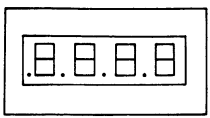
example, .8.8.8.8 is displayed each time the power switch is pushed on. It means that power is applied, and that all elements of the display are operative, it changes to --- 1.5 seconds later, indicating that the VTM is ready to be used for testing. The status readout displays are described in table 2-1.
(b) Prompting Message. A prompting message is a technician action message. It is a signal for you to

do something such as crank the engine. For example, UEH tells you to enter the vehicle type identification number into the VTM. After the technical action is performed, the test will automatically continue.
Prompting messages are listed in table 2-2.
(c) Numerical Readout. A numerical readout is the measured value in units of the measurement

being made. For example, if you are measuring 0-45 volts dc, 12.7 is volts dc. If you are measuring 0-25 psig pressure, 12.7 is psig. The units for each test are listed on the flip card. The numbers displayed in the VTM are always positive unless there is a minus shown to make them negative.
(d) Error Readout. E0001 is a typical error readout. There are 15 different readouts. All error readouts

start with E. An error readout is a warning that you forgot to connect the transducer, selected a wrong test number, failed to start the engine, etc. All of the error messages mean you must correct the problem before continuing testing. Error readouts are listed in table 2-3. If the error message does not go away after corrective action, refer to TM 9-4910-571-12&P.
(e) Confidence Error Readouts. C004 is a typical error readout resulting from the detection of a
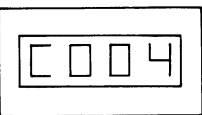
faulty VTM during confidence test. For detailed information concerning confidence error readouts refer to TM 9-4910-571-12&P.
| 1. Connect RED clip to the indicated test point, | BLACK clip to negative or ground. |
|---|---|
| 2. Start Test 89, DC volts. | |
| 3. Displayed reading is in volts. |
| if the engine is at operating temperature from a previous run. | |
|---|---|
| If LED 6 is "OFF" and the parking brake lever is engaged the parking brake | |
| If LED 8 is "OFF", replace the PCB. | switch is defective or the wires in the body harness are defective |
| If LED 11 is "OFF", check the glow plug controller. If the glow plug | |
| controller is functioning properly, replace the PCB. | |
| RUN - LED's 1, 2, 3, 4, 5, 6, 7, 8,13 "ON"; remaining LED's "OFF" | |
| (Distribution Box) LED 13 "OFF" after a few seconds (glow plug warm up time). | |
| LED 13 "OFF" if engine is at operating temperature. (ENGINE NOT | |
| RUNNING LED 6 "OFF if parking brake lever is released. | |
| LED 6 "ON" if parking brake lever is engaged Distribution Box) WARNING If LED 2, 3, 4, or 8 is "OFF", replace distribution box. | |
| If LED 7 is "OFF", body harness wire 57B is not grounded | |
| If LED 5 is "OFF", replace distribution box if LED 13 is "ON". | |
| Disconnect negative battery cable before and 29C are defective. | If LED's 5 and 13 are "OFF", the ignition switch and/or harness wires 29A |
| disconnecting and reconnecting | If LED 13 is "OFF" and LED 5 is "ON", and engine is not at operating |
| protective control box/distribution box | temperature from a previous run, replace distribution box. Distribution |
| harness. Failure to do so may result in | box is operation if engine is at operating temperature from a previous run. If LED 6 is "OFF"and the parking brake lever is engaged the parking brake |
| switch and/or the wires in the body harness are defective. injury to personnel or damage to | |
| equipment. START | LED 10 momentarily "ON" and then remains "OFF" (starter motor |
| (ENGINE frequency lockout). | |
| CRANKING Replace protective control box, refer to voltage; charge is low. | If LED 11 and 13 remain "ON" or engine does not crank; check battery |
| PCB) | If LED 10 does not momentarily come "ON" and then stays "OFF", replace |
| (para. 4-5). PCB. | |
| Replace distribution box, refer to (para. | |
| START LED 10 momentarily "ON". 4-5.1). | If LED 13 is "ON or engine does not crank; check battery voltage; charge is |
| (ENGINE low. | |
| CRANKING | |
| Distribution ignition | If LED 10 does not momentarily come "ON" and then stays "OFF'', and |
| Box) switch is operating properly, replace distribution box. | |
| RUN LED's 1,2,3,4,5,6,7,8,9,12 "ON" | |
| (ENGINE | LED 11 cycling "ON" and "OFF" (glow plug controller operation): "OFF" |
| time interval increases as engine warms up. RUNNING | |
| LED 11 "OFF" (when engine is at operating temperature). PCB) | |
| prevlous run). | LED 11 may remain "OFF" (when engine is at operating temperature from |
| LED 13 "OFF" | |
| Release parking brake lever. LED 6 "OFF". | |
| Engage parking brake lever. LED 6 "ON". | |
| PCB. | If LED 2, 3, 4, 5, or 8 is "OFF" and all glow plugs are serviceable replace the |
| Repair lead connectors, refer to (para. If LED 7 is "OFF", the body harness wire 57B is not grounded. | |
| If LED 9 is "OFF" and LED 12 is "ON", replace the PCB. 4-85). | |
| Repair lead, refer to (para. 4-85). | If LED's 9 and 12 are "OFF", there is no alternator output (alternating current tap) available and/or the engine harness wire 2A is defective. |
| If LED 11 is "OFF" and the engine is not at operating temperature, check | |
| the glow plug controller. If the glow plug controller is functioning properly, | |
| replace the PCB. | |
| RUN LED's 1, 2, 3, 4, 5, 6, 7, 8, 12 "ON", remaining LED's "OFF" | |
| LED 6 "OFF" if parking brake lever is released. | |
| (ENGINE LED 6 "ON" if parking brake lever is released | |
| RUNNING | If LED's 2, 3, 4, 5 or 8 is "OFF" replace distribution box. |
| Distribution | If LED 7 is "OFF", body harness wire 57B is not grounded |
| Box) | If LED 12 is "OFF", there is no alternator output (alternating current tap) |
| REFERENCE INFORMATION | PROTECTIVE CONTROL BOX/DISTRIBUTION BOX | |
|---|---|---|
| IGNITION | DIAGNOSTIC CHECKS | |
| SWITCH | (GO TASKS) | |
| POSITION | (For vehicles with protective control box/distribution box) | |
| NOTE | ||
| This analyzer requires all glow plugs | OFF | LED's 1, 3, 4, 6, 7, "ON''; Remaining LED's "OFF" |
| be serviceable and the batteries fully | If all LED's are "OFF", battery power is not available. | |
| charged in order to operate properly. | If LED 3 or 4 is "OFF", replace the PCB/distribution box. If LED 7 is "OFF", body harness wire 57B is not grounded. | |
| Prior to performing diagnostic checks | RUN - (PCB) | LED's 1,2,3,4,5,6,7,8,11,13 "ON". |
| ensure these two items are checked. | LED 13 "OFF" after a few seconds (glow plug warm up time). | |
| If either of these two items are found | (ENGINE | LED 13 "OFF if engine is at operating temperature. |
| to be faulty, repair/replace prior to | NOT | LED 11 cycling "ON" and "OFF" (glow plug controller operatlon) |
| RUNNING | LED's 9, 10, 12 "OFF". | |
| beginning checks. Failure to do so will | PCB) | Release parking brake lever. LED 6 "OFF". |
| cause the analyzer to give false | Engage parking brake lever. LED 6 "ON". If all LED's are "OFF", no battery power is available. | |
| If LED 3 or 4 is "OFF", replace the PCB. |
D. Cable Assemblies.
- General. The cable assemblies are shown below and are referred to by the cable number and by a name which describes how the cable is used. If necessary, the two transducer cables (W4) can be joined with the adapter supplied in the transducer kit to make one long cable.

CABLE ASSEMBLIES
- Installation. When cables are connected, large key on the cable connector mates with a keyway on the transducer connector or the VTM connector for proper installation, If you experience any difficulty during testing and suspect that a cable is bad, refer to TM 9-4910-571-12&P for checking cable continuty.
e. Transducer Kit.
| Tuble 2-4. ITunsulucer Kit Components | ||||
|---|---|---|---|---|
| IIIEM NO. | TK NO. | PART NO. | QTY | ITEM |
| 10 | 11669227 | 1 | Hose and fitting assy (spark plug adapter) | |
| 2 | II | 12258878 | 1 | Current probe |
| 12 | 12258853-1 | 1 | Pipe thread reducer, 3/4 MPT to 1/4 FPT | |
| 01 + 10 | 18 | 12258853-3 | 1 | Pipe thread reducer, 1/2 MPT to 1/4 FPT |
| 14 | 12258853-2 | 2 | Pipe thread reducer, 3/8 MPT to 1/4 FPT | |
| 6 | IR | 444620 | 1 | Hex head plug, 1/4 MPT |
| 7 | 18 | 5327970 | I | Hex head plug, 1/8 MPT |
| 8 | 17 | 12258876 | 1 | Pressure transducer, 0-1000 psig |
| 9 | 21 | 12258881 | 1 | Snubber |
| 10 | 20 | 3204X2 | 2 | Adapter, 1/8 MPT to 1/4 FPT |
| D | 19 | 3304X2 | 1 | Coupling reducer. 1/8 FPT to 1/4 FPT |
| 12 | 18 | 234X5 | 1 | Male connector, 5/16 tube to 1/4 MPT |
| 18 | 22 | 12258877 | 1 | Pressure transducer, -30 in. Hg to 25 psig |
| 14 | 23 | 444152 | l | Street tee, 1/2 pipe thread |
| 15 | ನಿಕ | 3750X4 | 1 | Street tee, 1/4 pipe thread |
| 16 | 25 | 547002 | 1 | Street tee, 1/8 pipe thread |
| 17 | 26 | 12258879-2 | 1 | Street elbow, 1/4 pipe thread |
| 18 | 27 | 12258879-1 | 1 | Street elbow, 1/8 pipe thread |
| 19 | 34 | 12258875 | 1 | Pulse tachometer |
| 20 | 32 | 12258880 | 1 | Fuel line adapter |
| 21 | 81 | MS53099-2 | 1 | Tachometer drive adapter |
| 22 | 30 | 7540877 | 1 | Ignition adapter |
| 23 | 29 | MS3119E14-19 | 1 | Adapter (connector-to-connector) |
| 24 | રુક | 12258762 | 1 | Tee, inverted flare |
| 25 | 33 | 8840543 | 1 | Air chuck |
| 25 | ર્સર | 11669236 | 1 | Hose assembly, 1/8 MPT |
| 24 | 36 | 12258852 | 1 | Pipe nipple, 1/8 MPT |
Table 2-4. Transducer Kit Components
-
General. The transducer kit contains a pulse tachometer transducer, a pressure and a vacuum transducer and the necessary adapters (bushing, plugs, tees, etc.). Also included in the kit is a current probe for measuring current and a test probe cable for measuring voltage and resistance. Not all fittings have part number markings. The legend will help to identify the items. Before installing any transducer kit item on the vehicle, be sure to clean the mounting surfaces. This is particularly important if you are going to open fuel lines or tap into manifolds. Dirt particles entering the engine can cause damage to both the engine and the transducer kit item. The transducers should kept clean, free of dirt and grease, and handled with reasonable care.
-
Pressure Transducer. The pressure transducers have a small breather hole on the side of the housing which should be kept unplugged. Do not use high pressure.
-
Pulse Tachometer. Make sure that the slotted hole in the engine tachometer drive shaft is clear and not hard packed before installing the pulse tachometer.
-
Threaded Adapters. Observe threaded fittings carefully to avoid engaging straight threads with

pipe threads. Each measurement device (transducer) in the transducer kit has its own identification resistor. The VTM uses this identification resistor to check that the correct transducer is connected for the measurement being made. If the correct transducer is not connected, error code E002 will be displayed.
2-44. Vehicle Testing
a. General. To troubleshoot a vehicle problem, the technician can use the STE/ICE-R (vehicle test meter and transducers) and the vehicle test card.
b. Data Entry Tests. For information regarding Data Entry, Cylinder Entry, Vehicle ID Entry, and Data Display Tests, refer to TM 9-4910-571-12&P.
c . Offset Tests. The STE/ICE-R VTM performs a test by setting the TEST Select switches to the test number and pressing the TEST button. For some tests, an offset test is required before the test itself can be performed. This is done by selecting the number of the desired test and holding the TEST button down for several seconds. The offset test nulls out characteristic differences in the VTM, test leads, and transducers. It zeros the meter. Once the offset is performed, the VTM automatically corrects for the offset before displaying measured values. The displayed offset value should be checked against limits on the vehicle test card. If the displayed value is outside these limits, either the transducer or the test cable is faulty and must be replaced. This is another form of self-test. The offset is performed when each transducer is connected. All tests requiring offset are identified by a star (*) on the flip cards and by OFFSET LIMITS on the vehicle test cards. The offset test is performed with the test probe cable or transducer connected to the VTM. Care should be taken to see that no stimulus is applied to the transducer. Test probe cable leads should be shorted together. To perform an offset test, dial the test number into the TEST SELECT switches. Press and hold the TEST button until the prompting message CAL appears on the display. A few seconds after release of the TEST button, a number will appear. This is the measured offset value associated with the test probe cable or transducer and cable.
d. Control Tests. These tests are used to change (or control) the way a vehicle test is displayed or the way it is run. There are five control tests: 01 Interleave (displays RPM with next test). 02 Display minimum value for next test. 03 Display maximum value for next test. 04 Display peak-to-peak value for next test. 06 Interleave. Control tests 01, 02, 03, 04, and 06 specify the action to be taken by the next test only. A subsequent test will reset the control.
-
Interleave (Test 01). This test alternately measures engine speed and a second parameter such as fuel pressure or alternator voltage. To initiate interleave, dial 01 into the TEST SELECT switches and press and release the TEST button. The prompting message CON will signal the technician to dial into the second test number and again press and release the TEST button.
-
Minimum Value (Test 02). This test displays the minimum value measured during a test. To initiate a minimum value display, dial 02 into the TEST SELECT switches and press and release the TEST button. The prompting message PASS will signal the technician to dial in the desired test number and again press and release the TEST button. The minimum value is displayed and updated whenever a lower minimum value is measured. Entering 02 and the test number again will reset the process and a new minimum value will be displayed.
-
Maximum Value (Test 03). This test displays the maximum value measured during a test. To initiate a maximum value display, dial 03 into the TEST SELECT switches and press and release the TEST button. The prompting message PASS will signal the technician to dial in the desired test number and again press and release the TEST button. The maximum value is displayed and updated whenever a higher maximum value is measured. Entering 03 and the test number again will reset the process and a new maximum value will be displayed.
-
Peak-to-Peak Value (Test 04). This test displays the peak-to-peak value of 0-45 volts DC (89), 0-1500 amps DC (90), and battery volts (67). To start a peak-to-peak measurement, dial 04 into the TEST SELECT switches and press the TEST button. The prompting message PASS will signal the operator to dial in one of the three numbers (89, 90, 67) and again press the TEST button.
CONNECTOR KEY LOCATION
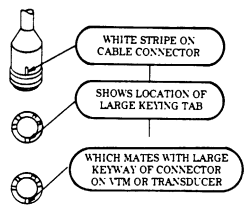


Table 2-1. STE/ICE-R GO-Chain Tests.
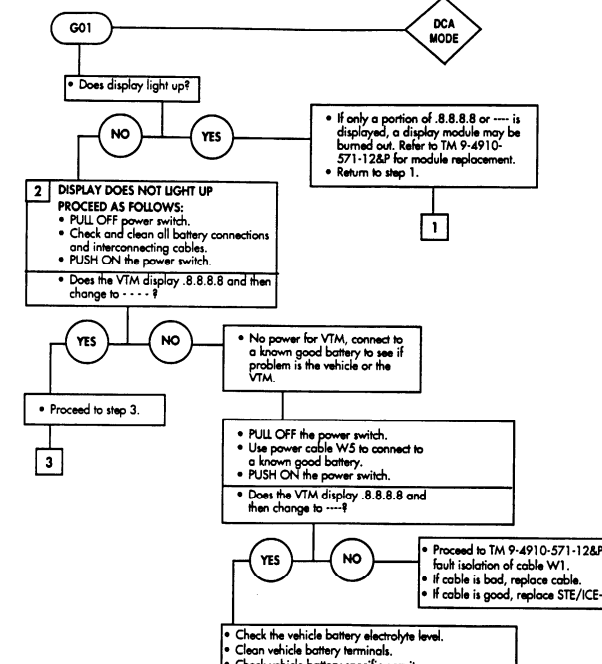
· Check vehicle battery specific gravity Table 2-1. STE/ICE-R GO-Chain Tests. (Cont'd) (para. 4-79).
Charge vehicle battery (TM 9-61 40-200-14).
· Return to step 1 .
· If problem repeats, look for broken or loose connections in DCA wiring from battery or in cable W1.
l

Table 2-1. STE/ICE-R GO-Chain Tests. (Cont'd) · Proceed to following page.

Table 2-1. STE/ICE-R GO-Chain Tests. (Cont'd)
| REFERENCE INFORMATION | PROTECTIVE CONTROL BOX/DISTRIBUTION BOX | |
|---|---|---|
| DIAGNOSTIC CHECKS | ||
| (GO TASKS) | ||
| (For Vehicles with protective control box/distribution box) | ||
| NOTE | OFF | LED's 1, 3, 4, 6, 7, "ON''; Remaining LED's "OFF" |
| This analyzer requires all glow plugs | If all LED's are "OFF", battery power is not available. If LED 3 or 4 is "OFF", replace the PCB/distribution box. | |
| be serviceable and the batteries fully | If LED 7 is "OFF", body harness wire 57B is not grounded. | |
| charged in order to operate properly. | RUN - (PCB) | LED's 1,2,3,4,5,6,7,8,11,13 "ON". LED 13 "OFF" after a few seconds (glow plug warm up time). |
| Prior to performing diagnostic checks | ||
| ensure these two items are checked. | (ENGINE | LED 13 "OFF if engine is at operating temperature. |
| If either of these two items are found | NOT RUNNING | LED 11 cycling "ON" and "OFF" (glow plug controller operatlon) LED's 9, 10, 12 "OFF". |
| PCB) | Release parking brake lever. LED 6 "OFF". | |
| to be faulty, repair/replace prior to | Engage parking brake lever. LED 6 "ON". | |
| beginning checks. Failure to do so will | If all LED's are "OFF", no battery power is available. If LED 3 or 4 is "OFF", replace the PCB. | |
| cause the analyzer to give false | If LED 7 is "OFF", harness wire 57B is not grounded | |
| readings, therefore causing the | If LED 2 is "OFF", and all glow plugs are serviceable, replace the PCB. | |
| needless replacement of serviceable | If LED 5 is "OFF", replace the PCB is LED 13 is "ON". If LED's 5 and 13 are "OFF", the ignition switch is defective and/or harness | |
| components. | wires 29A and 29C are defective. | |
| If LED 13 is "OFF" aud LED 5 is "ON" and the engine is not at operating | ||
| temperature from a previous run, replace the PCB. The PCB is operational if the engine is at operating temperature from a previous run. | ||
| If LED 6 is "OFF" and the parking brake lever is engaged the parking brake | ||
| switch is defective or the wires in the body harness are defective If LED 8 is "OFF", replace the PCB. | ||
| If LED 11 is "OFF", check the glow plug controller. If the glow plug | ||
| controller is functioning properly, replace the PCB. | ||
| RUN - | LED's 1, 2, 3, 4, 5, 6, 7, 8,13 "ON"; remaining LED's "OFF" | |
| (Distribution Box) | LED 13 "OFF" after a few seconds (glow plug warm up time). | |
| (ENGINE NOT | LED 13 "OFF" if engine is at operating temperature. | |
| RUNNING | LED 6 "OFF if parking brake lever is released. LED 6 "ON" if parking brake lever is engaged | |
| Distribution Box) | If LED 2, 3, 4, or 8 is "OFF", replace distribution box. | |
| If LED 7 is "OFF", body harness wire 57B is not grounded | ||
| If LED 5 is "OFF", replace distribution box if LED 13 is "ON". If LED's 5 and 13 are "OFF", the ignition switch and/or harness wires 29A | ||
| and 29C are defective. | ||
| If LED 13 is "OFF" and LED 5 is "ON", and engine is not at operating | ||
| temperature from a previous run, replace distribution box. Distribution box | ||
| Repair lead connectors, refer to | is operation if engine is at operating temperature from a previous run. | |
| If LED 6 is "OFF"and the parking brake lever is engaged the parking brake | ||
| (para. 4-85). | switch and/or the wires in the body harness are defective. | |
| Repair lead, refer to (para. 4-85). | ||
| START | LED 10 momentarily "ON" and then remains "OFF" (starter motor | |
| (ENGINE | frequency lockout). If LED 11 and 13 remain "ON" or engine does not crank; check battery | |
| CRANKING PCB) | voltage; charge is low. | |
| If LED 10 does not momentarily come "ON" and then stays "OFF", replace | ||
| PCB. | ||
| START | LED 10 momentarily "ON". | |
| (ENGINE | If LED 13 is "ON or engine does not crank; check battery voltage; charge is | |
| CRANKING | low. If LED 10 does not momentarily come "ON" and then stays "OFF'', and | |
| Distribution | ignition | |
| Box) | switch is operating properly, replace distribution box. | |
| RUN | LED's 1,2,3,4,5,6,7,8,9,12 "ON" | |
| (ENGINE | LED 11 cycling "ON" and "OFF" (glow plug controller operation): "OFF" | |
| RUNNING | time interval increases as engine warms up. | |
| PCB) | LED 11 "OFF" (when engine is at operating temperature). LED 11 may remain "OFF" (when engine is at operating temperature from | |
| prevlous run). | ||
| LED 13 "OFF" | ||
| Release parking brake lever. LED 6 "OFF". | ||
| Engage parking brake lever. LED 6 "ON". If LED 2, 3, 4, 5, or 8 is "OFF" and all glow plugs are serviceable replace the | ||
| PCB. | ||
| WARNING | If LED 7 is "OFF", the body harness wire 57B is not grounded. If LED 9 is "OFF" and LED 12 is "ON", replace the PCB. | |
| If LED's 9 and 12 are "OFF", there is no alternator output (alternating | ||
| Disconnect negative battery cable | current tap) available and/or the engine harness wire 2A is defective. If LED 11 is "OFF" and the engine is not at operating temperature, check | |
| before disconnecting and | the glow plug controller. If the glow plug controller is functioning properly, | |
| reconnecting protective control | replace the PCB. | |
| box/distribution box harness. Failure | RUN | LED's 1, 2, 3, 4, 5, 6, 7, 8, 12 "ON", remaining LED's "OFF" |
| (ENGINE | LED 6 "OFF" if parking brake lever is released. | |
| to do so may result in injury to | RUNNING | LED 6 "ON" if parking brake lever is released |
| personnel or damage to equipment. | Distribution | If LED's 2, 3, 4, 5 or 8 is "OFF" replace distribution box. |
| Box) | If LED 7 is "OFF", body harness wire 57B is not grounded | |
| If LED 12 is "OFF", there is no alternator output (alternating current tap) | ||
| Replace protective control box, refer | available and/or engine harness wire 2A is defective. | |
| to (para. 4-5). | ||
| Replace distribution box, refer to (para. 4-5.1). |
Index (Cont'D)
| STARTER CIRCUIT | REFERENCE INFORMATION |
|---|---|
| BAD CONNECTIONS ARE THE MOST COMMON | |
| PROBLEM ! | |
| Sometimes, just disconnecting, cleaning and | |
| reconnecting will solve a problem. BE THOROUGH! | |
| The time you save may be your own. | |
| Refer to the functional flow schematic and check the following: | |
| 1. BATTERY - make sure all connections are clean | |
| and tight, including the shunt and power stud. | |
| 2. STARTER - check the high current (heavy gauge | |
| wire 6A) wire at the starter. Don't just check for | |
| voltage; a loose connection will have voltage but | |
| can't carry much current. | |
| WARNING | |
| Disconnect negative battery cable before dis | |
| connecting and reconnecting protective control | |
| BATTERY VOLTAGE box/distribution box harness. | |
| STE/ICE TEST 67 STE/ICE-R TEST 67 There is battery voltage at the PCB/distribution box | |
| at all times. Failure to disconnect battery cable will | |
| 1. Start Test 67, battery voltage. | |
| result in damage to equipment or injury to | |
| personnel. 2 2. Displayed reading is in volts. Batteries should | |
| 3. PROTECTIVE CONTROL BOX/ be 23-25.5 volts. Batteries voltage will drop when | |
| DISTRIBUTION BOX - Unscrew BOTH connectors glowplugs turn on. | |
| and look for bent or broken pins, pins pushed out of | |
| their socket, or dirt and corrosion in the connections. | |
| 4. ROTARY SWITCH - Check the wires at the switch. | |
| Don't just look. Feel the connections to make sure | |
| they're snug. Many problems can be solved by | |
| seeing with your fingers, not just your eyes. | |
| BATTERY VOLTAGE | |
| MULTIMETER A cold engine should crank at least 100 RPM. | |
| A warm engine should crank at least 180 RPM. | |
| 1. Set the voltmeter to a DC volts scale of at least | |
| 40 volts. | |
| GREEN YELLOW 2. Connect the RED lead to positive and the | |
| BLACK lead to negative. | |
| RED RED | |
| 3. Be sure to read the correct scale. | |
| - + | |
| VOLTS | |
| VOLTS | |
| GAUGE |
INDEX (Cont'd)
| GLOWPLUGS | REFERENCE INFORMATION |
|---|---|
| WARNING | Disconnect negative battery cable before |
| disconnecting and reconnecting protective | control box harness. |
| There is battery voltage at the PCB at all times. | Failure to disconnect battery cable will result in |
| damage to equipment or injury to personnel. | |
| NOTE | You will not be able to check the solid-state controller |
| using the pin-to-pin resistance check. The solid-state | controller is identified by a green finish and a larger |
| case. | |
| Replace glowplug controller, refer to (para 4-29). |
By Order of the Secretary of the Army: ERIC K. SHINSEKI General, United States Army Chief of Staff O f f i c i a l : JOEL B. HUDSON Administrative Assistant to the Secretary of the Army 05692 By Order of the Secretary of the Air Force: RONALD R. FOGLEMAN General, United States Air Force Chief of Staff O f f i c i a l : H E N RY VICCELLIO, JR.
General, United States Air Force C o m m a n d e r, Air Force Materiel Command By Order of the Marine Corps: D.R. BLOOMER Colonel, USMC Director, Program Support Marine Corps Systems Command Distribution: To be distributed in accordance with the initial distribution number (IDN) 380900, requirements for TM 9-2320-280-20-1.

DA FORM 2028, FEB 74 TO: (Forward direct to addressee listed in publication)
| FROM: (Activity and location) |
|---|
| (include ZIP code) |
DATE: AMSTA-LC-CI Tech Pubs, TACOM-RI 1 Rock Island Arsenal
Rock Island, IL 61299-7630

TYPED NAME, GRADE, OR TITLE TELEPHONE EXCHANGE/AUTOVON,
| SIGNATURE |
|---|
PLUS EXTENSION

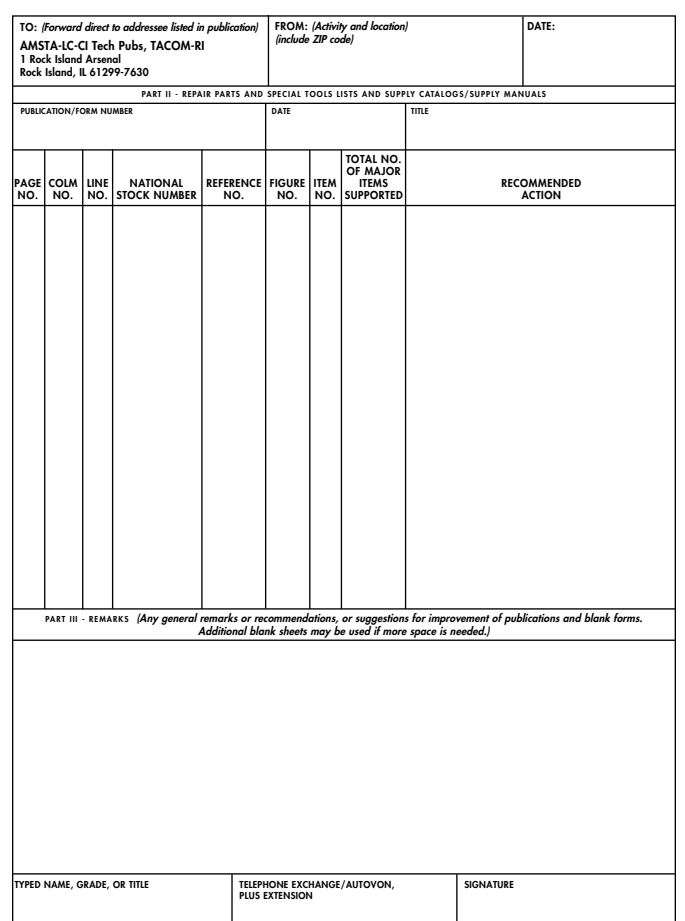
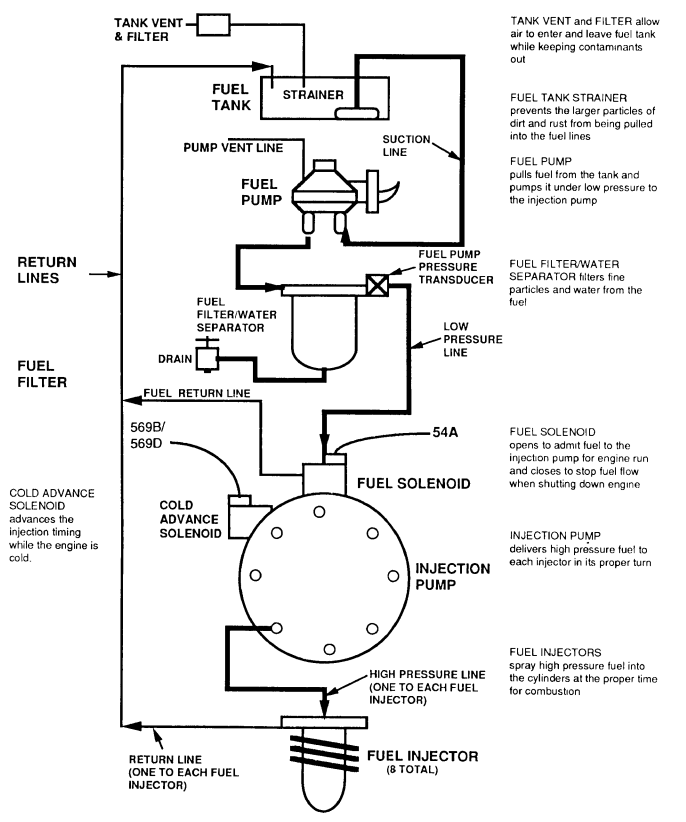


INJECTOR NOZZLES IT IS MOUNTED ON TOP OF THE ENGINE UNDER THE INTAKE MANIFOLD FO-1 Fuel System Functional Flow and Locations of Parts Diagrams FP-1/(FP-2 Blank)
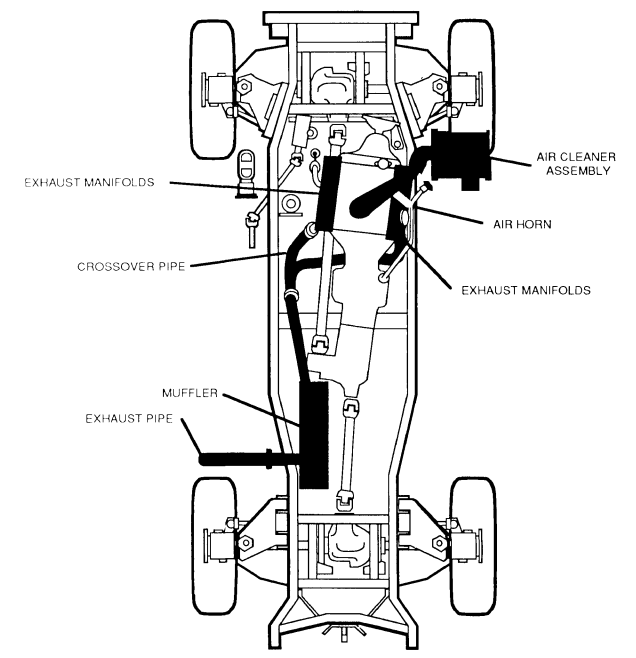
NOT APPLICABLE TO THIS SYSTEM FO-2 Intake Air/Exhaust Functional Flow and Location of Parts Diagrams FP-3/(FP-4 Blank)

NOT APPLICABLE TO THIS SYSTEM FO-3 Compression/Mechanical Function Flow and Location of Parts Diagrams FP-5/(FP-6 Blank)
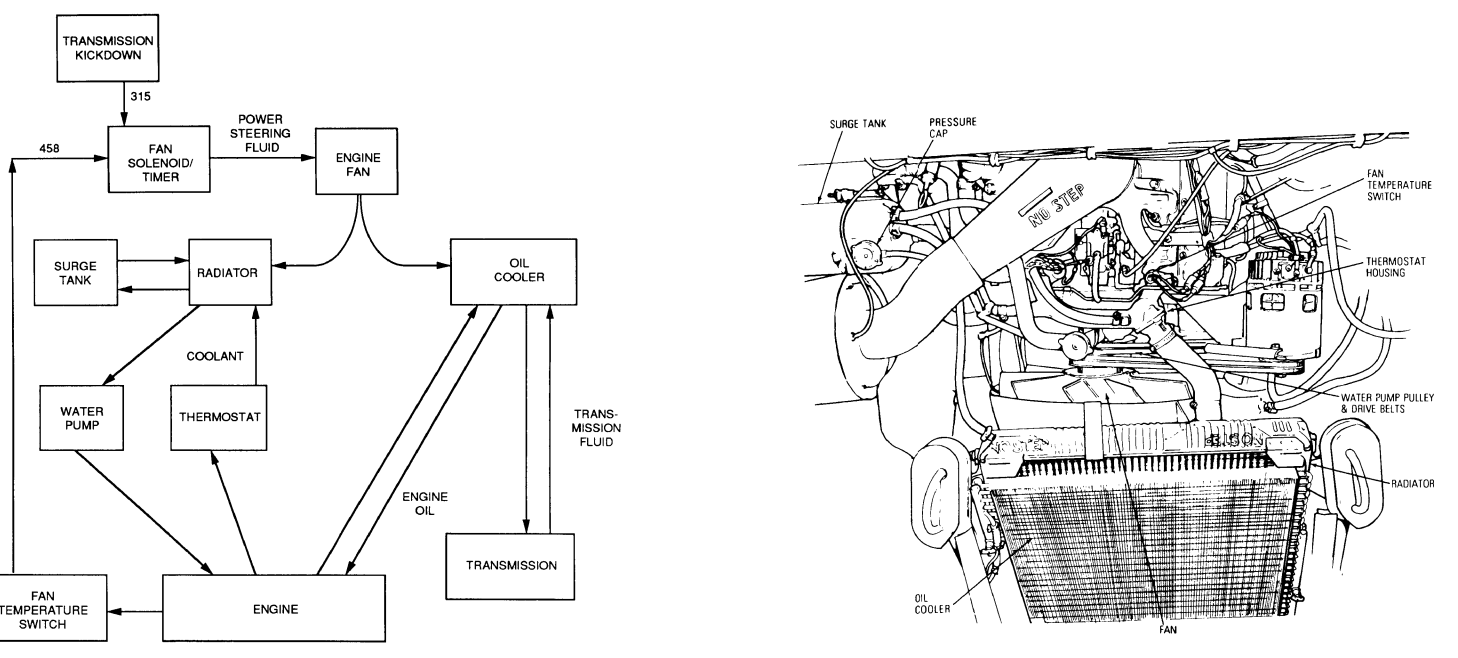
FO-4 Cooling Functional Flow and LOcation of Parts Diagrams FP-7/(FP-8 Blank)

FP-9/(FP-10 Blank)


FO-6 Alternator Functional Flow and Location of Parts Diagrams FP-11/(FP-12 Blank)


ALL CIRCUITS MUST RETURN THROUGH VEHICLE GROUND FO-7 Battery Functional Flow and Location of Parts Diagrams FP-13/(FP-14 Blank)

and Location of Parts Diagrams FP-15/(FP-16 Blank) Ground O ー
. - 1
- .
I .

' B-D

FO-9 Glowplugs Functional Flow and Location of Parts Diagrams FP-17/(FP-18 Blank) Glowplugs

FO-10 Instruments Functional Flow and Location of Parts Diagrams FP-19/(FP-20 Blank)

FO-11 Lights Functional Flow and Location of Parts Diagrams FP-21/(FP-22 Blank)
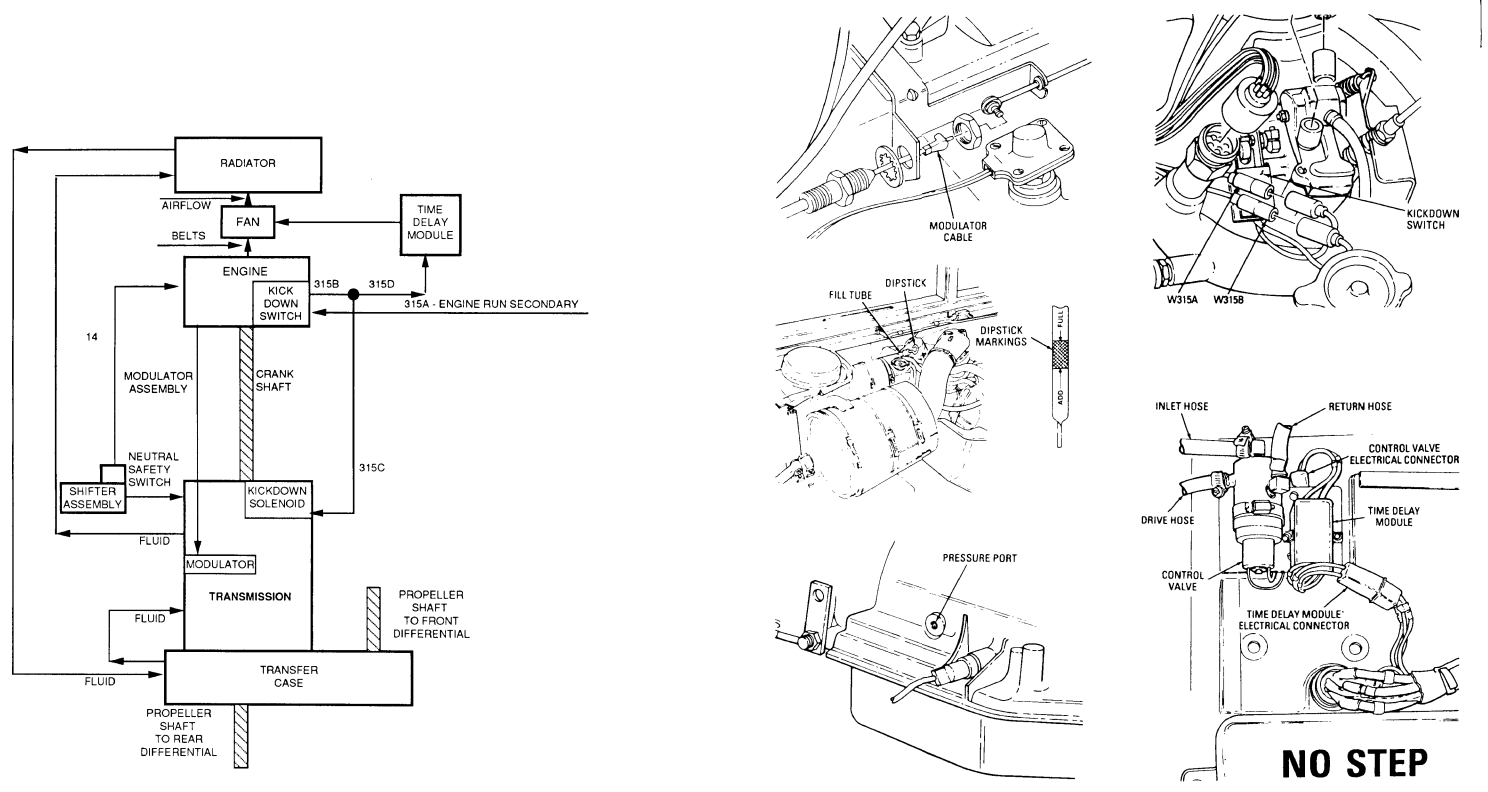
FO-12 Transmission Functional Flow and Location of Parts Diagrams FP-23/(FP-24 Blank)

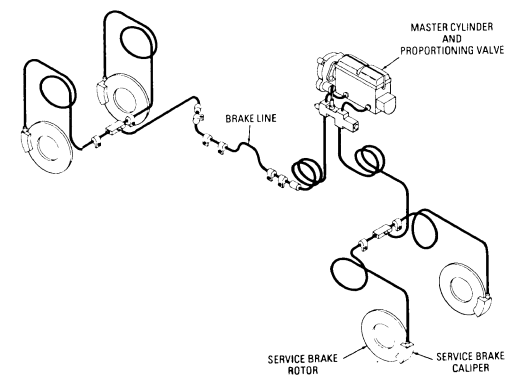
FO-13 Brakes Functional Flow
FP-25/(FP-26 Blank)

FO-14 Steering Functional Flow and Location of Parts Diagrams


MECHANICAL SYSTEM FP-27/(FP-28 Blank)

NOT APPLICABLE TO THIS SYSTEM FO-15 Drive Train Functional Flow and Location of Parts Diagrams FP-29/(FP-30 Blank)
Dca To Tk Cross Reference

This table assumes that the VTM is powered by the W5 cable. For additional information on any of these tests, see Chapter 23 or TM 9-4910-571-12&P. Tests 72,73,74, and 75 are known as a first peak series, and data for all four of these tests is taken simultaneously.
| DCA | TEST | MEASUREMENT | ||
|---|---|---|---|---|
| TESTI | PARAMETER | USE TK ITEM | NO. | POINTS |
| 10 | RPM | 34-PULSE TACH. WITH A W4 CABLE | 10 | PUT IN PLACE OF VEHICLE TACH. |
| 12 | POWER | 34-PULSE TACH. | 12 | PUT IN PLACE OF VEHICLE TACH. |
| (RPM/SEC) | WITH A W4 CABLE | |||
| 13 | POWER | 34-PULSE TACH. | 13 | PUT IN PLACE OF VEHICLE TACH. |
| (PERCENT) | WITH A W4 CABLE | |||
| 14 | COMPRESSION | NONE | 14 | VTM TAKES DATA THROUGH W5 (POWER) CABLE |
| UNBALANCE | REQUIRED | |||
| FUEL | 22-RED PRESSURE | 49 | INSTALL IN PLACE OF VEHICLE FUEL PRESSURE | |
| 24 | PRESSURE | TRANSDUCER | TRANSDUCER. | |
| 67 | BATTERY | NONE | 67 | VTM TAKES DATA THROUGH W5 (POWER) CABLE |
| VOLTAGE | REQUIRED | |||
| 68 | STARTER | W2 CABLE | 80 | ATTACH RED CLIP TO STARTER POSITIVE TERMINAL |
| MOTOR VOLTS | (WIRE 6A),BLACK TO BATTERY SIDE OF SHUNT | |||
| દવ | STARTER NEG. | W2 CABLE | 89 | ATTACH RED CLIP TO STARTER GROUND TERMINAL |
| CABLE DROP | (WIRE 7A),BLACK TO BATTERY SIDE OF SHUNT | |||
| 70 | STARTER | W2 CABLE | 80 | ATTACH RED CLIP TO STARTER SOLENOID TERMINAL |
| SOL. VOLTS | (WIRE 74A),BLACK T0 STARTER GROUND TERMINAL | |||
| 71 | STARTER | 11- CURRENT | 90 | PUT PROBE AROUND NEGATIVE BATTERY CABLE |
| CURRENT | PROBE | BETWEEN THE SHUNT AND THE BATTERY PACK. | ||
| 72 | CURRENT | 11- CURRENT | 72 | PUT PROBE AROUND NEGATIVE BATTERY CABLE |
| FIRST PEAK | PROBE | BETWEEN THE SHUNT AND THE BATTERY PACK. | ||
| 73 | BATTERY | 11- CURRENT | 73 | PUT PROBE AROUND NEGATIVE BATTERY CABLE |
| RESISTANCE | PROBE | BETWEEN THE SHUNT AND THE BATTERY PACK. | ||
| STARTER | 11- CURRENT | 74 | ||
| 74 | CIRCUIT RESISTANCE | PROBE | PUT PROBE AROUND NEGATIVE BATTERY CABLE BETWEEN THE SHUNT AND THE BATTERY PACK. | |
| 75 | BATTERY | 11- CURRENT | 75 | PUT PROBE AROUND NEGATIVE BATTERY CABLE |
| RESISTANCE | PROBE | BETWEEN THE SHUNT AND THE BATTERY PACK. | ||
| CHANGE | ||||
| 80 | BATTERY | 11- CURRENT | 90 | PUT PROBE AROUND NEGATIVE BATTERY CABLE |
| CURRENT | PROBE | BETWEEN THE SHUNT AND THE BATTERY PACK. |
FO-16 DCA Functional Flow and Location of Parts Diagrams FP-31/(FP-32 Blank)
The Metric System And Equivalents
Linear Measure
1 Centimeter = 10 Millimeters = 0.01 Meters = 0.3937 Inches 1 Meter = 100 Centimeters = 1,000 Millimeters = 39.37 Inches 1 Kilometer = 1,000 Meters = 0.621 Miles SQUARE MEASURE 1 Sq Centimeter = 100 Sq Millimeters = 0.155 Sq Inches 1 Sq Meter = 10,000 Sq Centimeters = 10.76 Sq Feet 1 Sq Kilometer = 1,000,000 Sq Meters = 0.386 Sq Miles
Cubic Measure
1 Cu Centimeter = 1,000 Cu Millimeters = 0.06 Cu Inches 1 Cu Meter = 1,000,000 Cu Centimeters = 35.31 Cu Feet LIQUID MEASURE 1 Milliliter = 0.001 Liters = 0.0338 Fluid Ounces 1 Liter = 1,000 Milliliters = 33.82 Fluid Ounces TEMPERATURE Degrees Fahrenheit (F) = °C - 9 ÷ 5 + 32 Degrees Celsius (C) = F° - 32 - 5 ÷ 9 212° Fahrenheit is equivalent to 100° Celsius 90° Fahrenheit is equivalent to 32.2° Celsius 32° Fahrenheit is equivalent to 0° Celsius WEIGHTS 1 Gram = 0.001 Kilograms = 1,000 Milligrams = 0.035 Ounces 1 Kilogram = 1,000 Grams = 2.2 Lb 1 Metric Ton = 1,000 Kilograms = 1 Megagram = 1.1 Short Tons
| TO CHANGE | TO | MULTIPLY BY |
|---|---|---|
| Inches | Millimeters | 25.4 |
| Inches | Centimeters | 2.540 |
| Feet . | Meters . . . | 0.305 |
| Yards . | ・・・・・・・・・・・・・・・・・・・・ Meters | 0.914 |
| Miles ・・・・・・・・・・・・・・・・・・・・・・・・ | Kilometers . | 1.609 |
| Square Inches . | Square Centimeters | 6.451 |
| Square Feet . | Square Meters | 0.093 |
| Square Yards | Square Meters | 0.836 |
| Square Miles | Square Kilometers | 2.590 |
| Acres . . . | Square Hectometers | 0.405 |
| Cubic Feet | Cubic Meters | 0.028 |
| Cubic Yards . | Cubic Meters | 0.765 |
| Fluid Ounces . | Milliliters | 29.573 |
| Pints | Liters | 0.473 |
| Quarts | Liters | 0.946 |
| Gallons | Liters . | 3.785 |
| Ounces | Grams | 28.349 |
| Pounds . | Kilograms | 0.4536 |
| Short Tons | Metric Tons . | 0.907 |
| Pound-Feet | Newton-Meters | 1.356 |
| Pounds Per Square Inch | Kilopascals . | 6.895 |
| Miles Per Gallon | Kilometers Per Liter | 0.425 |
| Miles Per Hour | Kilometers Per Hour | 1.609 |
| TO CHANGE | TO | MULTIPLY BY |
| Millimeters | Inches . | 0.03937 |
| Centimeters | Inches | 0.3937 |
| Meters . | Feet ・・・・・・・・・・・・・・・・・・・・・・・・ | 3.280 |
| Meters . | Yards | 1.094 |
| Kilometers | Miles . | 0.621 |
| Square Centimeters | Square Inches | 0.155 |
| Square Meters . | Square Feet . | 10.764 |
| Square Meters . | Square Yards . | 1.196 |
| Square Kilometers | Square Miles | 0.386 |
| Square Hectometers | Acres | 2.471 |
| Cubic Meters . | Cubic Feet | 35.315 |
| Cubic Meters . | Cubic Yards . | 1.308 |
| Milliliters | Fluid Ounces | 0.034 |
| Liters | Pints | 2.113 |
| Liters | Quarts . . . | 1.057 |
| Liters | Gallons . | 0.264 |
| Grams . . | Ounces | 0.035 |
| Kilograms | Pounds . | 2.2046 |
| Metric Tons | Short Tons . | 1.102 |
| Newton-Meters | Pound-Feet . | 0.738 |
| Kilopascals | Pounds Per Square Inch | 0.145 |
| Kilometers Per Liter | Miles Per Gallon | 2.354 |
| Kilometers Per Hour | Miles Per Hour | 0.621 |



